Visiting the Roman Forum: all you need to know + best things to see and tips
All you need to know to plan a visit to the Roman Forum. Where to get the best tickets, the best things to see in the Roman Forum and the Palatine Hill, practical tips. Updated June 2021.
The Roman Forum is the heart of Ancient Rome and, nowadays, one of the most important archaeological sites in Rome and in the world.
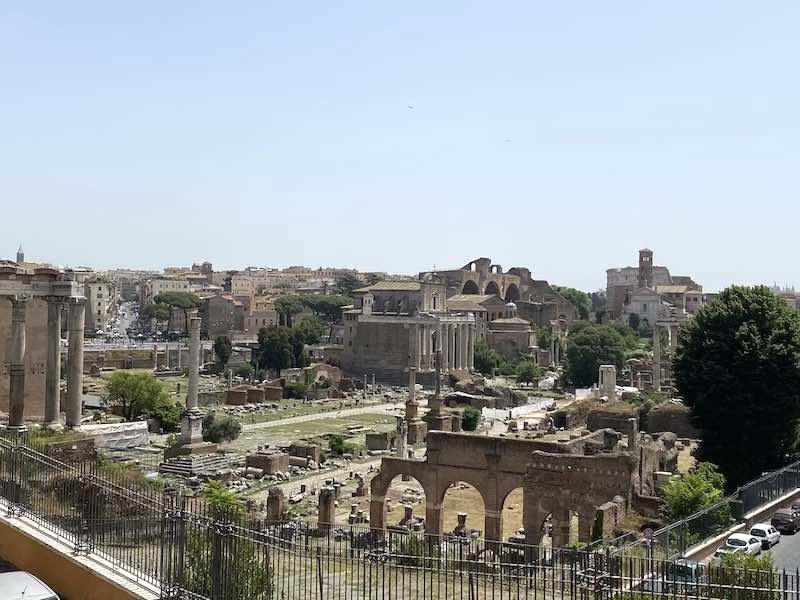
The ancient Rome Forum sits inside what is now the modern city and it is nestled between the Colosseum on one side, the Campidoglio Hill on the other, and the Palatine Hill, where the Palaces of the Emperors lie.
It is one of the most beautiful places in Rome however, it is also a place that attracts less attention than the nearby Colosseum.
While the Colosseum is on the bucket list of pretty much any Rome visitor, it is not unusual to find people wondering if the Roman Forum is worth visiting at all and I think the question is worth a proper answer.
While I believe the Roman Forum is stunning and a must-see for everybody I also believe that it is important to go there being prepared to what the forum is, what it isn’t, what to expect and how to tackle it at best.
This is my guide to visiting the Roman Forum.
Good to know . As well as being born and raised in Rome, I am a classics graduate and my dissertation was on Ancient Rome. So you can say I am biased when it comes to the Forum: I do love it! For the longest time, the Forum didn’t have good explanation panels and my recommendation was to get a guide to make the most of your visit. While I believe a guide is still worth it, the free app ‘Parco Colosseo’ now exists and operated almost as an audio guide. A good, budget-friendly option to see the Roman Forum!
Table of Contents

All you need to know to plan a visit to the Roman Forum
The Roman Forum is the area of Ancient Rome where public and religious life used to take place.
The Forum is now an archaeological site and, in a way, you can say that the Roman Forum is Ancient Rome.
Unlike the Colosseum or the Baths of Caracalla, that are two ancient stand-alone buildings, the Roman Forum is a large area where you literally walk along ancient Roman streets.
The area is large and mostly outdoors. Being prepared for the weather and for the uneven terrain is a must: I share all my tips on how to dress and what to bring to the Roman forum later in this guide.
The best things to see in the Roman Forum
The Roman Forum is a rather large area with plenty of things to see.
The Forum Proper is a flat area comprised between the Capitoline Hill and the Palatine Hill, the two most significant of the seven hills of Rome.
The Palatine Hill is immediately above the Forum and it is accessible though it. The Hill is where Romulus, Rome’s founder, set his hut and where the Emperors then built their palaces.
The best things to see in the Roman Forum are both on the Forum Proper and on the Palatine Hill. Let’s have a look at them.
Via Sacra is the Main Street crossing the Roman Forum.
Nowadays, you see is as connecting the Colosseum to the Capitoline Hill but it predates the Colosseum by many centuries.
The tradition reports that the Via Sacra was were Romulus won over Titus Tatius King of Sabina (VIII century BC) and while at the time the road was a little more than a muddy trail, this tells us some form of street here must have been in use from very early on.
The paving of the street as we see it now is made of slabs of basalt and seems to date from Augustan times (I century AD).
In historical times, the road was used for thriumphal procession after successful military campaigns.
The military parade would walk along this road with the prisoners and the flags of the enemy, bringing the victorious general in triumph all the way to the top of the Capitoline Hill, where the temple of Iuppiter Optimum Maximus (Jovis) used to be.
The Via Sacra is now one of the most scenic areas of the Roman Forum, especially close to the Colosseum, where tall columns are still standing, giving a sense of what this road must have looked like at its best.
The triumphal Arch of Titus
The first impressive monument you find on Via Sacra is the fantastic Arch of Titus.
The arch is one of the three triumphal arches in Rome and dates from the I century AD.
This is a celebratory monument build by order of Emperor Domitian, to honour his precedessot Titus.
As the inscription and carvings on the arch show, the arch commemorated Rome’s victory over Jerusalem and the taking to the temple, an event historians describe as happened in 70 AD.
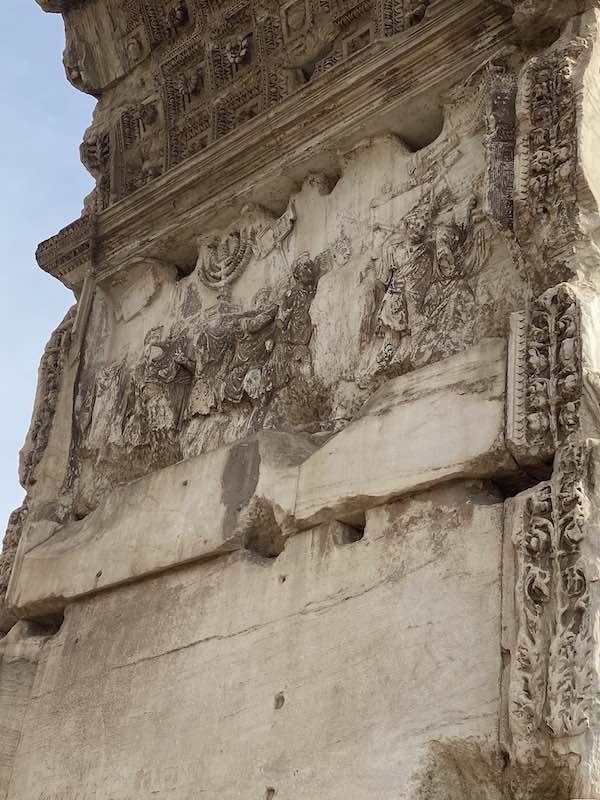
The Temple of Antoninus and Faustina
One of the most beautiful and best preserved buildings in the Roman Forum is the Temple of Antonino and Faustina.
The Temple sits on the spot where the Via Sacra meets the Forum and it was built in 141AD for Emperor Antoninus Pius and his wife: Faustina.
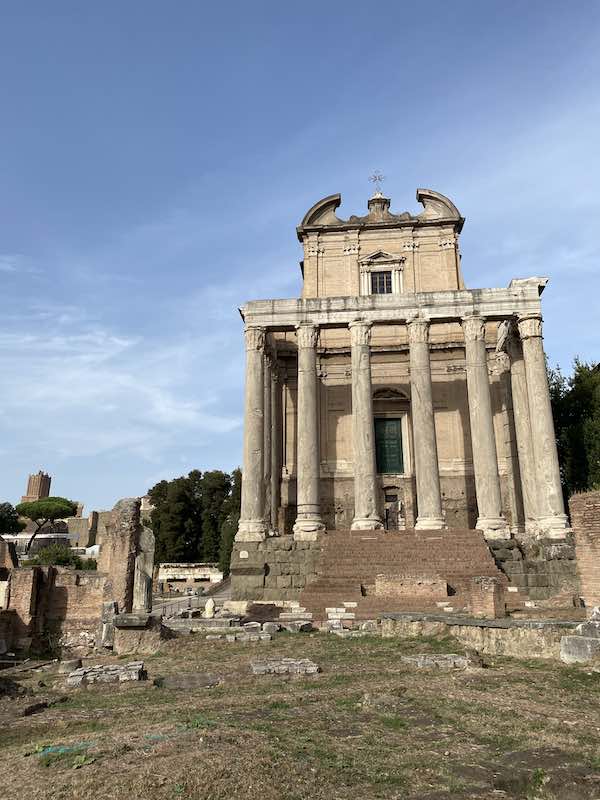
Like many ancient religious buildings, the temple became a a church in the Middle Ages and acquired the name of San Lorenzo in Miranda: this fate changed its appearance but it also ensures its preservation and allows us to enjoy it today.
An inscription at the top of the temple says ‘Divo Antonino et Divae Faustinae Ex. S.C.’ which means that the Senate dedicates this temple to the Emperor and his wife.
The temple stands on a podium with a height of 5 meters and is accessible by a recent staircase. This is one of the tallest buildings in the Roman Forum and one of the most eye-catching.
The Temple of Divus Romulus
The so called Temple of Divus Romulus is a round structure opening onto Via Sacra, inside the Forum.
It is not sure what the use of the temple originally was but we know it was built by Emperor Maxentius at the beginning of the IV century and was later incorporated into the church of Saint Cosma and Damiano, built here in the VI century by order of Pope Felix IV.
This temple is stunning and holds unique worth seeing. Please note that this temple is only accessible with the ‘Full Experience’ ticket.
The Roman Forum Square
The main square of the Roman Forum is a large area at the center of the Forum where all the most important business transactions and public events in the city would take place.
The area was an open unbuilt area for a long time but acquired an increasing number of public buildings and monuments, the latest of which is the column of Phocas, one of the most significant columns in Rome , dedicated in 608AD to the Eastern Roman Emperor Phocas.
Along the short sides of the square, there stood the platforms from where the orators would speak, the Imperial Rostra, the Rostra Vandalica and the Rostra ad Divi Iuli, dedicated by Augustus to Julius Caesar.
On the northern side of the square used to lay the Basilica Emilia: this was a civic area that used to serve as bankers’ headquarters and seems to date to the I century BC, yet the restored and modified many times in subsequent centuries.
On the southern side of the Roman Forum square there used to be another basilica, the basilica Iulia. This basilica seems to have been used for political, judiciary and economic activities and it takes its name from the person who commissioned its built: Julius Caesar.
Fun fact : here is where you can see remains of tabulae lusoriae , the ancient Roman equivalent to our board games! This is one of the best things to show children if you are visiting the Roman Forum with kids.
The Curia was the ancient seat of the Roman Senate. It is a large brick building wanted by Julius Caesar and inaugurated by Augustus, modified by Diocletian and finally turned into a church in 630 AD, fate that allowed the preservation of its beautiful Byzantine Frescoes and its stunning bronze door.
The Arch of Septimius Severus
The Arch of Septimius Severus is a large triumphal arch dating to the III century AD.
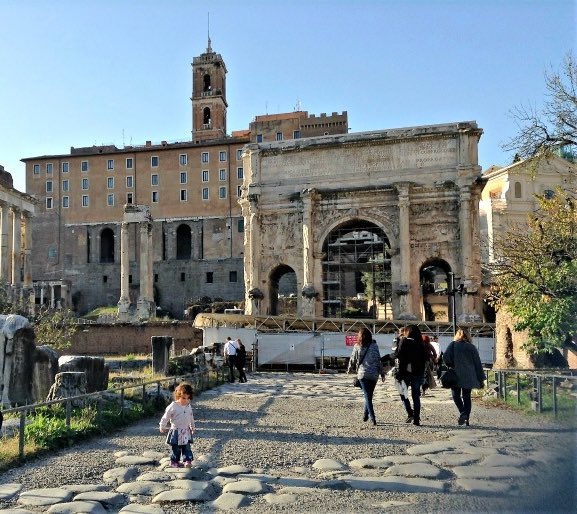
It sits at the end of Via Sacra, just below the slopes of the Capitoline Hill and it made of travertine, brickwork and marble.
The arch has the impressive size of 25×11.20×11 mt.
An inscription tells us that the arch was built to honour the Emperor and his son for ‘restoring the State and extending the empire of the Roman people’ and it used to have a bronze sculpture on top that would overlook the Forum.
Fun fact: in the Middle Ages, the arch became a fortress tower! It was restored only in the 1980s.
The House of the Vestals
The house of the Vestals is one of the prettiest areas in the Roman Forum.
It is one of the most ancient buildings in the city and it is usually associate with King Numa Pompilius, who established the Vestal Virgins as an institution.
The house got destroyed during the large fire of 64AD but was then rebuilt so we see now a later version of it. Still well visible are the rooms, the stairs to the upper floors and the portico, one of the most beautiful spots I the whole of the Forum.
The Temple of Vesta
The Temple of vesta is on the Eastern side of the Roman Forum and it easy to recognize thanks to its distinctive round shape.
The temple used to be part of the same complex as the house of Vestals, nearby. The temple was badly damaged however, ancient coins tell us the shape it would have had and restoration work from the 1930s patched up some of the fragments found in the area.
The Regia is said to be the place where King Numa Pompilius used to reside. This is one of the oldest sites in the Forum, with remains archaeologists were able to date back to the Iron Age.
The ancient necropolis
Between the temple of Antoninus and Faustina and the Temple of Romulus, archaeological excavations in the early 20th century brought to life and ancient necropolis (cemetery).
These graves date from the Latin Age (X century BC) and therefore predate almost anything else in the Forum. These are an important find for historians and archaeologist as they shed a light on a much more ancient use of this area that our ancient Roman sources do not cover.
The Farnese Gardens
If, from the Forum, you look up towards the Palatine Hill, you will see a structure that is clearly not ancient but rather from Renaissance Times, the ‘Farnese Gardens’.
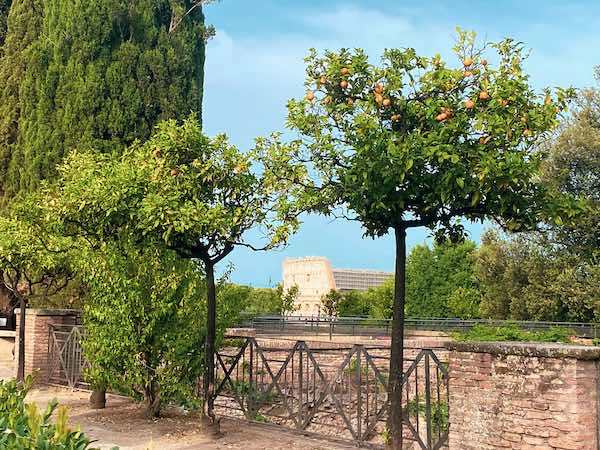
The Gardens were built in the early 1500s by Pope Paul III Farnese and quickly became among the most extraordinary gardens in the city for variety of plants and views.
The construction of the gardens took many years and their appearance changed in the XVII century, when two large aviaries where added, and then again up until the early 1930s.
What to see on the Palatine Hill
This is a quick overview of what you can see on the Palatine Hill as you climb up from the Roman Forum.
You can find here >>> our complete guide to the Palatine Hill for first time visitors .
The Palatine Hill is one of the ancient seven hills of Rome and the place Romulus fonder of Rome chose as the location for its new city.
The Palatine Hill is one of the most beautiful places in Ancient Rome and can be accessed from the Roman Forum, which it overlooks.
Things to see on the Palatine Hill are:
The huts of Romulus
The huts of Romulus are in the area of the Palatine called the Germalus, on the hill’s southwestern corner.
This is a group of dwellings that that seems to have been inhabited since the IX century BC and one of them is usually referred to as the ‘House of Romulus’, a full replica of which can be seen in the Palatine Museum.
This is a fantastic place to get acquainted with the very early days of the city of Rome.
The Palace of Emperors
In terms of visual effect, the most impressive sight on the Palatine Hill is the Palace of Emperor.
The Domus was built at the end of the I century AD by Emperor Domitian and it is divided into three parts: the Domus Flavia, with the rooms for business and entertaining guests, the Domus Augustana, the actual house of the Emperors, and the Stadium or Hippodrome, the palace garden.
The Palace is stunning to see: if you have time, I highly recommend you go to the Circus Maximus after your visit. It is just below the Palace, outside the archaeological park, but it offers outstanding views of the palace for the outside, the perfect complement to the sight you get from the Palatine.
The Palatine Museum
The Palatine Museum stands at the top of the Palatine Hill and hosts a collection of artefacts that spans over fifteen centuries of history of Rome, from its foundation to the highest successes of the Roman Empire. A must-see for history lovers.
The Roman Forum: frequently asked questions and need to know
What was the roman forum.
The Roman Forum was the administrative area of Ancient Rome.
It was the heart of the city, the place where religious, legal and political affairs took place and, as such, the beating heart of the political life in Rome.
Here, you would have had temples, some still visible, basilicas (a sort of meeting hall, at the time), religious buildings and of course streets and celebratory buildings such as the arches still standing at the two sides of the forum.
What is the Palatine Hill?
The Palatine Hill is one of the 7 hill of Rome and is usually mentioned with the Roman Forum is is just beside it and is accessible from the Forum itself.
The hill is historically significant and beautiful: here, you have the ruins of the palaces of Emperors, a museum, ongoing excavations and stunning views over Rome .
Is the Roman Forum beautiful? Is it worth seeing?
There is no doubt that the Roman Forum is a must-see place for anyone with an interest in Ancient Rome, but I believe the forum it is worth seeing also if you just want to see a beautiful place.
The area of the forum is simply stunning!
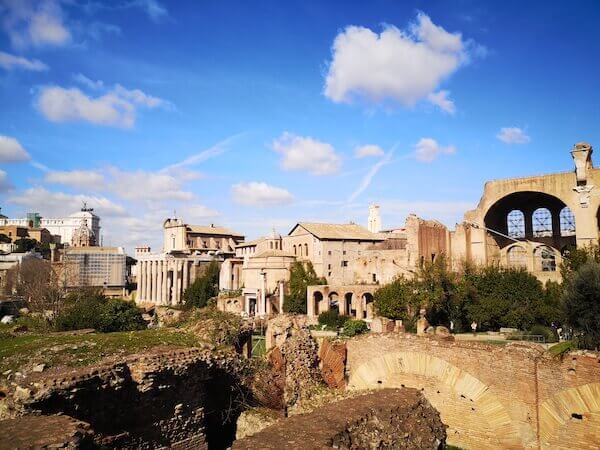
The Forum is now an open-air archaeological park and you can easily enjoy it even just as a place for a leisurely stroll.
If you go on a bright day, especially in the spring or the fall, the forum is simply breathtaking: you can easily walk to one side to the other in a matter of minutes and you can simply follow your curiosity picking and choosing the areas that attract you the most.
The most beautiful part of the Roman Forum is, for me, the walk up the Horti and the Palatine Hill. You will feel the steps in your legs but, once on top, you have the ruins of the palaces of emperors and views over Rome that are simply breathtaking!
The pine trees that are typical of the Rome landscape frame the Colosseum and the Forum below and give you a photo op like no other!
Is there a dress code for the Roman Forum?
There is no dress code for visiting the Roman Forum. Clothing rules such as no shorts or no strappy tops only apply to religious buildings and main basilicas such as St Peter but not to archaeological sites.
The only thing to keep in mind when visiting the Forum is practicality: good shoes are a must and weather appropriate clothing for the season of your visit will also be important.
You can find our tips on what to wear for the Roman Forum below.
How to visit the Roman forum: guided tour or self guided? 2021 Update
The Roman Forum is a place so full of history and thing to see it is best enjoyed with a guide.
The area has almost non existent info panels so without some form of guidance, you can enjoy its beauty but you won’t understand much.
The cheapest way to visit the Roman Forum is by getting standard tickets and downloading the Parco Colosseo app.
The app is free and has explanations in several languages about the main sights in the Roman Forum and on the Palatine Hill.
If you have a smart phone, this is an excellent option and it also has a recommended itinerary for kids and another one for the visually impaired.
If your budget allows, then I recommend you take one of the may Roman Forum tours available (see below)
How to get the best Roman forum tickets
You can buy tickets to the Roman Forum on the day or you can book them online here. If you do so, make sure you pick a solution that works for you: there are several combinations, offering access to different things.
The tickets include a visit to the Colosseum (all areas or just some parts depending on the ticket), the Roman Forum and the Palatine Hill, with the exception of some ‘super sites’ that you may need to book separatly.
Best Roman forum tours
Tours of the Roman Forum are bundled up with a visit to the Colosseum.
The best we have tried are:
- Priority Entrance to Colosseum, Forum and Palatine Hill with guide
- Colosseum (includes underground tier) and Roman Forum guided tour
- Walking tour of the Colosseum, Roman Forum and Palatine Hill (3 hours)
- Colosseum and Roman forum tour for kids (suitable for primary school kids too)
Need to know: the tours tend to give priority to a visit to the Colosseum, which usually takes up to 2/3 of the tour. If you are interested in a more specialized tour, then I recommend you get a private guide instead .
How long to visit the Roman Forum
It usually takes me between 2 and 3 hours to visit the Roman Forum and I would recommend to plan half a day if this is your first visit.
Technically, you can spend as little or as long as you wish here, however, I think within this time frame you can see some of the forum most impressive area, such as the temple of Antonino and Faustina, the House of the Vestals and the Horti and also the Palatine Hill.
What is the best time of day to visit the Roman Forum?
The best time of day to visit the Roman Forum depends on the season.
In spring and autumn, the best seasons to visit Rome, you can go pretty much any time of the day, with only one caveat: the late morning and lunch hours can get busy!
Aside from that, you don’t have particular constraints when it comes to weather and time of visit, in mid season. The situation changes if you are visiting in winter or summer.
In winter, the best time of the day to visit the Forum and the Palatine hill is the late morning / lunchtime.
The Forum and even more the Palatine can get really cold in winter and being there in the warmest hours of the day will go a long way to make you enjoy your visit.

Also, consider that in winter the Forum closes pretty early (about 4 pm) and darkness comes early too, so an earlier start is recommended.
In summer, it is the opposite!
The Roman Forum in summer gets scorching hot and must be avoided at lunchtime and in the hottest hours of the day at all costs.
The best time of day to visit the Roman Forum in summer is the early morning or the late afternoon (check the time of the last admission though, you want to make sure you have enough time).
What to wear to visit the Roman Forum
You do not need particular equipment to visit the Roman Forum, but it is worth knowing a couple of things:
The terrain in the Forum is uneven, so you are recommended to wear good walking shoes or sneakers: no heels. Find my recommended shoes for Rome sightseeing here.
There is very little shade in the forum so especially in the warmer season, it is important to wear a hat.
In winter, the Forum can get surprisingly cold and the Palatine Hill gets even colder: wrap up well and do go during the warmest hours of the day for the best experience or humidity may get to you and make your visit seriously unpleasant.
Is there food and facilities inside the Roman Forum?
The Roman Forum has some restrooms and drinking fountains but it is overall hardly equipped with food.
I highly recommend you take care of breakfast and lunch before you come: picnics are now allowed.
Is the Roman Forum accessible?
The Roman Forum is not entirely accessible but does have some defined paths for wheelchair users. You can find all the pupated information on the paths and lifts here
Visiting the Roman Forum with kids
We have brought the kids to the Roman Forum several times and it is always a good day out.
It is, however, a day that can pose some challenges, so it is good to be prepared.

These are the important things to know before visiting the Roman Forum with kids:
You can enter the Roman Forum with a stroller however, only part of the Forum is paved. If you can, I highly recommend you leave the stroller at home, especially if also visiting the Colosseum (find my tips for visiting the Colosseum with kids here).
Kids will be tempted to climb on top of the ruins but this is not allowed. There is however a good playground close to the Colosseum , which you can easily reach after your visit and works well as a bribe!
There is no food inside the Forum and picnics are not allowed. However, it is ok to hand out a snack to a child so if you have small food for them, that’s ok.
If you ate visiting Rome with kids, do not forget to also check out our favorite things to do in Rome with kids here .
Top tip: the free app ‘Parco Colosseo’ includes a kid-friendly itinerary!
Should you visit the Roman Forum and the Colosseum on the same day?
The Roman Forum and Palatine hill are just beside the Colosseum and you can visit both in the same day.
A short visit to the Colosseum can take as little as 45 minutes and the Forum is only a minute across the road. Here, you can spend an hour, four or even a day.
I recommend you schedule at least three hours for a quick Forum visit, a full afternoon for a proper one.
How to get to the Roman Forum
You can get to the Roman Forum by metro, bus, tram or one foot.
- The closest metro station is ‘Colosseo’
- All buses serving the Colosseum serve the forum too, as well as those serving Piazza Venezia.
- Tram number 3 stops nearby
- The Roman Forum is walking distance from Piazza Venezia, Colosseum and the Pantheon
Where to get the best Roman Forum views?
The Roman Forum is a powerful site and there are some amazing photo locations to capture its might, some inside the Forum itself, and some outside!
One of the best views is from the Horti, inside the Forum, on the way up to the Palatine Hill. From here, you see the Forum and also the Colosseum.

Another stunning view over the Roman Forum is from the back of the Campidoglio Hill. This view is free and easily accessible walking up the Campidoglio and going to the back of the main budding. The Roman Forum will be at your feet!
So, is a visit to the Forum worth it?
Yes, I believe a visit to the Roman Forum is worth it and not just for history lovers. The beauty of the place itself a reason for visiting, especially in spring and autumn.
I hope you enjoyed this practical guide to visiting the Roman Forum. Happy travel planning!
My name is Marta, I am a travel-loving mama born and bred in that messy, wonderful, infuriating, awe-inspiring unbelievably beautiful city that is Rome. A classics graduate and professional travel blogger, on this site I share my insider tips to help you plan your dream trip to Rome, Italy.
What to wear in Rome in October: packing list and tips from a local
Movies set in rome that will make you feel like you are in rome right now, you may also like, fun and interesting facts about the colosseum for..., christmas markets in rome you will love this..., how to see the best of rome in..., free things to do in rome you’ll love..., how to buy tickets for the pantheon +..., how to visit the spanish steps in rome:..., largo di torre argentina: all you need to..., 40+ rome hidden gems you’ll love, outdoor swimming pools in rome you’ll love this..., 22 fantastic things to do in rome when..., privacy overview.

Guide To The Monuments Of The Roman Forum
Visiting the Roman Forum is a highlight for anyone traveling to Rome.
The 2,000 year old site, now a sprawling expanse of romantic ruins, was once the beating heart of the Roman Empire. Walking through it, you’re treading the same ground where ancient Rome’s most important events unfolded.
Exploring the Roman Forum can seem overwhelming at first, but don’t worry! With this guide to the Roman Forum, you’ll easily recognize and understand the significance of each monument.
What is the Roman Forum?
The forum is a rectangular valley running from Arch of Titus to the Arch of Septimus Severus near Capitoline Hill.
The forum’s main road is the Via Sacre. It’s basically the Broadway of Ancient Rome. Much of the paving of the Via Sacre is original to Ancient Rome.
The forum was dense with construction. It was the epicenter of ancient Rome, the seat of power, and its central showpiece.
It was a grandiose district consisting of gleaming white temples, grand basilicas, and vibrant public spaces — fit for an empire that ruled half of the known world.
The Forum was the scene of political upheavals, funerals, and triumphant parades. Before the Colosseum was built, it even hosted gladiatorial battles.
By the close of the imperial period, the forum was a densely stuffed with “modern” ancient buildings. Layers of churches and fortresses were built atop and amid the ancient remains.
After the 4th century, the Forum fell into disrepair and almost total obscurity. It became a quarry for building stone.
In the 18th century, the forum ignominiously lapsed into a cow pasture covered in layers of dirt and rubble.
Only in the 18th and 19th century did excavation begin, uncovering the buried treasure. Excavations continue today.
Tickets & Tours
The Roman Forum is one of Rome’s three important imperial sites, along with the Colosseum and Palatine Hill . These sites are typically visited with one trifecta ticket or ticket + tour.
Tickets are issued on the website exactly 30 days in advance. They are a hot commodity. Click here to book skip the line tickets for all three sites.
Booking a guided tour can really enhance your visit to the Roman Forum, especially since it’s such a vast and complex site.
Unless you’re a repeat visitor, without a guide, it can be tough to fully appreciate everything there is to see.
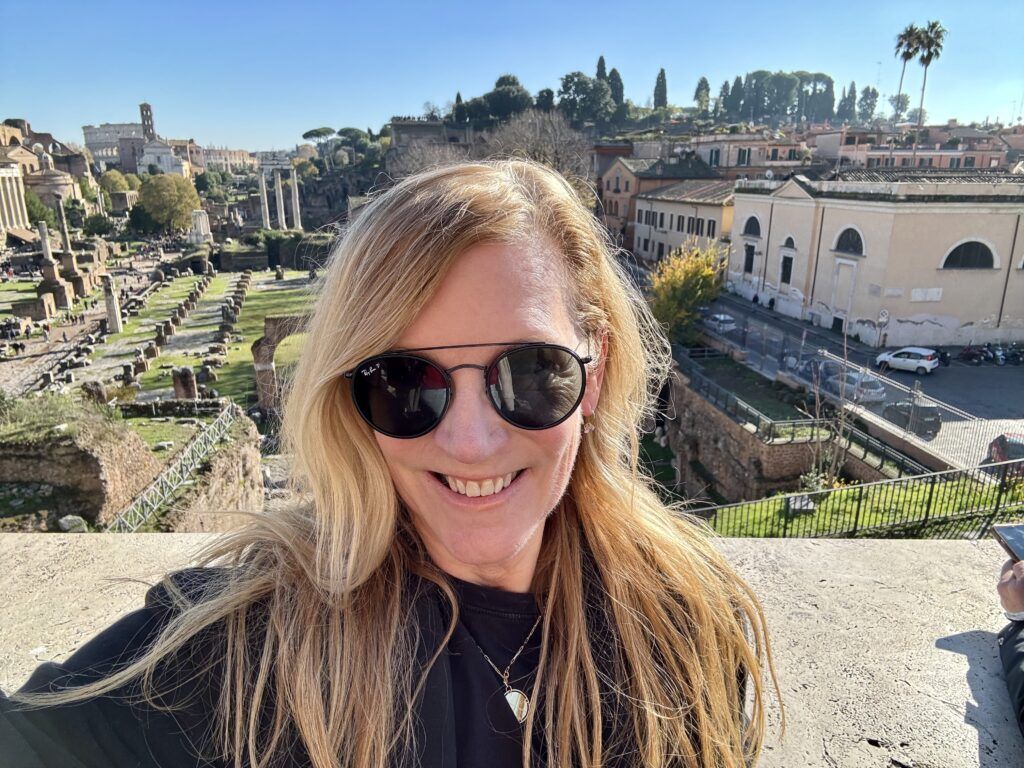
There are several tour options available, each with different durations and focuses. Choose one that aligns best with your interests and schedule.
I’ve personally taken the third and sixth tours on the list. They really helped bring the history of the place to life!
- skip the li ne entr y tickets to all 3 sites
- 3 hour gu ided tour and en try t o all 3 sites
- tickets & tour of all 3 sites + underground Colosseum access
- C oloss eum tour with e ntry tickets for Palatine Hill and the Roman Forum
- 4 ho ur priv ate d ay tour of Ancient Rome
- skip the lin e private guided tour with an art historian
Guide To The Roman Forum: What To See
1. arch of constantine.
If you’re a Christian, this arch is a symbol of your religion.
Constantine’s Arch represents a landmark in history, when a military battle made Christianity the mainstream religion in Rome and the entire Western World.
In 312, Emperor Constantine defeated his enemy and co-emperor Maxentius in the Battle of the Milvian Bridge, a turning point in their dispute. Legend holds that, the night before, Constantine dreamt of a cross in the sky.
When Constantine was victorious the following day, Maxentius fell off the bridge and drown. Constantine became sole emperor.
Straight away, he ratified the Edict of Milan, a religious tolerance act. It was the beginning of Christianity as the official state religion. One wonders what world history would be like if Constantine lost the battle …
Newly restored, the Arch of Constantine tells the story of his great victory. The arch is made entirely of carvings and decoration from other buildings with military imagery. An inscription on the top level announces that Constantine was the builder.
In the round reliefs, you see Emperor Hadrian. In the square reliefs you see Marcus Aurelius. The arch is topped with statues of Augustus and Trajan. In this manner, Constantine conflates himself with past great emperors.
READ : History of the Roman Emperors
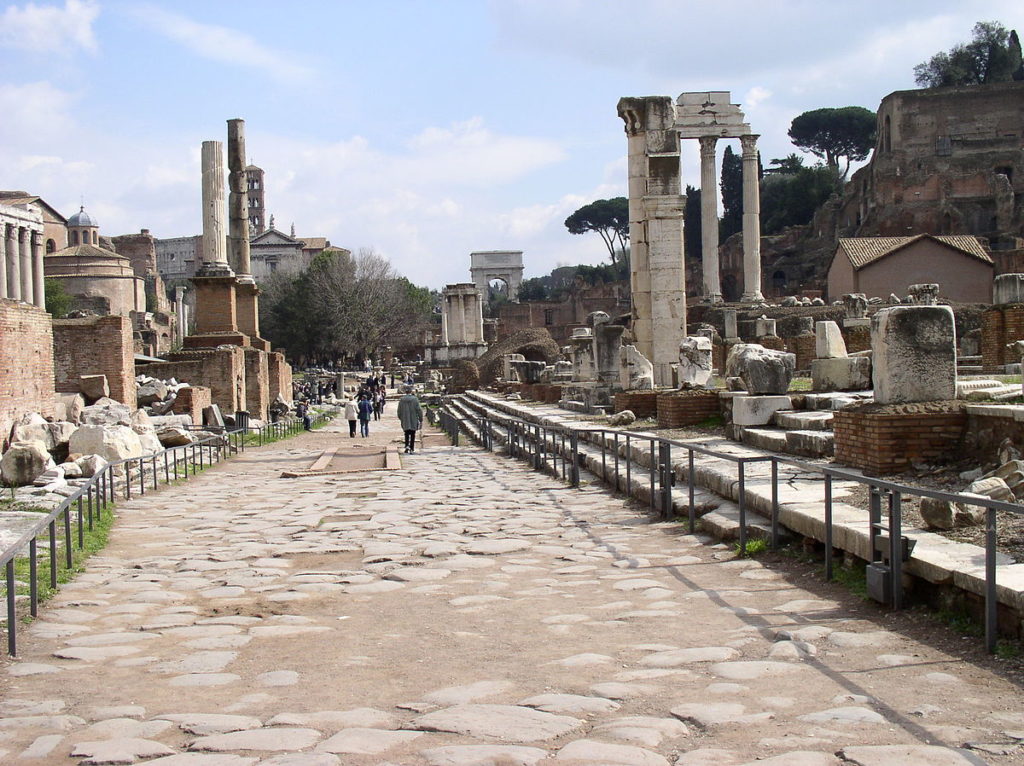
2. Via Sacra
The Via Sacra is the main street of the Roman Forum and it connects many of its monuments.
It’s a historic path where the story of Rome unfolded. This road was the center of Roman life, frequented by famous historical figures like Caesar, Cicero, Pompey, and Augustus. It was also the route Roman generals took to celebrate their victories.
Today, the Via Sacra might not look as grand as it once did. Many of its original paving stones are missing or uneven.
But as you walk down this road, remember that you’re following in the footsteps of some of Rome’s most influential people.
3. Temple of Venus and Rome
The Temple of Venus and Rome was another massive temple in the Roman Forum. Over 100 feet tall, it was once one of ancient Rome’s most impressive monuments.
The temple was designed by Emperor Hadrian. As was his preference, the temple is Greek in design. It was once surrounded by white columns, which now mark the perimeter.
The Temple of Venus and Rome is really just a shell now. The main ruin is an apse in the center.
It’s a brick arch with a cross hatched ceiling. The ceiling was installed by Maxentius in 307.
The temple once consisted of two main chambers, each preceded by a vestibule. Inside were two colossal statues of Venus and the goddess Rome Aeterna. Their Latin names, Roma and Amor, are inscribed on the walls, equating the city of Rome and the concept of love.
4. Arch of Titus
The Arch of Titus, one of three triumphal arches in the Roman Forum, stands as a monumental reminder of Rome’s military victory over Judea.
Built in honor of Emperor Titus by his brother Domitian, this structure is a mix of triumph and tragedy.
The inscription on the arch, “the Senate, the People of Rome,” harks back to the era of the Roman Republic, which ended with Augustus becoming emperor.
The arch is known for its darker narrative: it symbolizes the defeat and displacement of the Jewish people following the Fall of Jerusalem.
Titus’ siege led to the city’s destruction, the enslavement of thousands, and the desecration of the sacred temple, of which only the Wailing Wall remains today.
Inside, the arch features imagery of Roman soldiers carrying a menorah from the temple, symbolizing the exile of the Jewish population, a historical event whose repercussions are still felt today.
The arch once displayed colorful statues and showed the emperor in a victory parade.
The red color on the emperor’s face represented his vanquished enemies. The central panel in the arch depicts Titus’s apotheosis, immortalizing him as a god observing from the heavens.
5. Basilica of Maxentius and Constantine
Sited on Velia Hill, the Basilica of Maxentius and Constantine is an absolutely enormous building.
It was built with unprecedented technology and oozes Roman imperial power. The Romans used concrete, with inset bricks that were then covered in marble.
The basilica is a massive structure made up of three barrel vaults. It’s as if the city was built for giants, not humans.
But the monumental basilica is now less than one third of what it once was.
The basilica wasn’t a church as the name suggests. Rather, it was a Roman hall of justice. Litigious citizens could come here to lodge a lawsuit, bicker about inheritances, or get building permits.
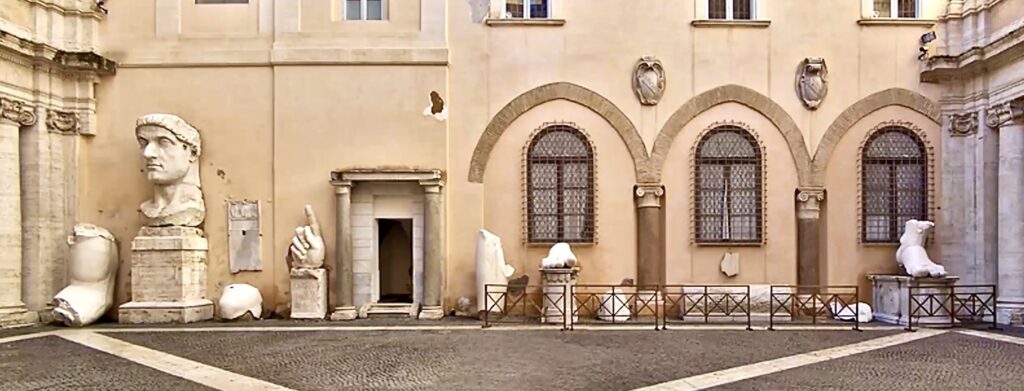
The three arches are the three bays that made up one of the two side aisles of the basilica. What’s no longer there is the central aisle or nave.
The basilica was begun by Maxentius. Constantine completed it, after he vanquished his rival and co-emperor.
There was originally a colossal statue of Constantine on a throne in the nave. Chunks of the 30 feet original statue are in a courtyard of the wonderful Capitoline Museums .
The basilica interior was elaborate, with intense color and ornamentation. The nave was lavishly furnished with gilded ceilings, inlaid marble, and sculptures.
6. Temple and House of the Vestal Virgins
The only people who lived in the Roman Forum were the members of the Cult of Vesta, led by the high priest Pontifus Maximus.
The vestal virgins were extremely famous. Their temple was one of ancient Rome’s holiest spots.
The virgins came from Rome’s noblest families, chosen at the age of 10. They took a vow of chastity for 30 years. They were sacred living creatures. Their job?
To keep alive the flame of Vesta in the circular Temple of Vesta, which symbolized the hearth of the Roman family.
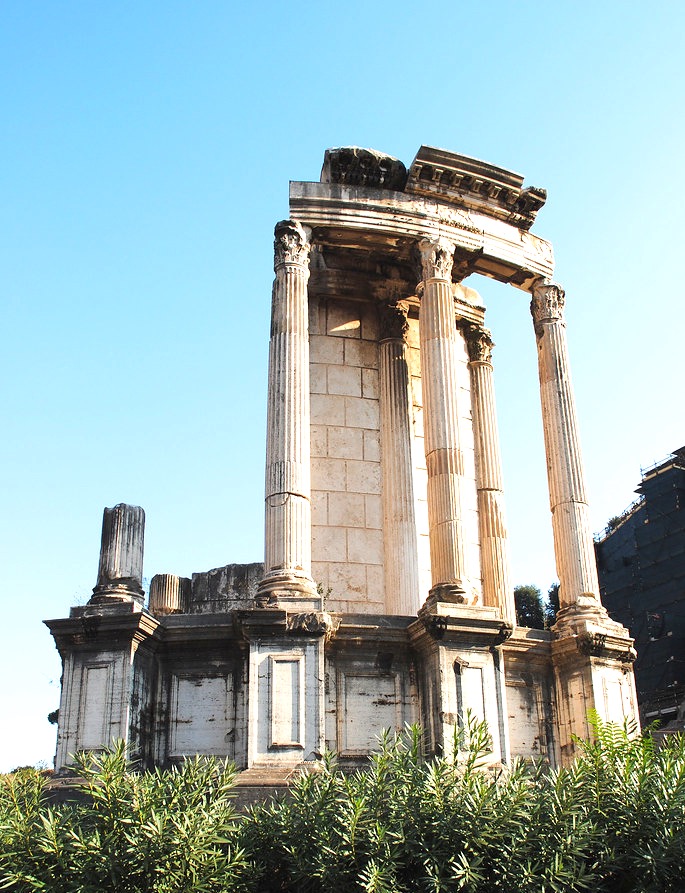
As long as the fire burned brightly, Rome was supposedly safe. The temple was once surrounded by 20 columns.
The House of the Vestal Virgins was a two story building.
The building surrounded a long courtyard with three pools and mosaic floors. The house became a model for later medieval cloisters.
There’s not much left to see, aside from a cult room and sculpures of the vestals.
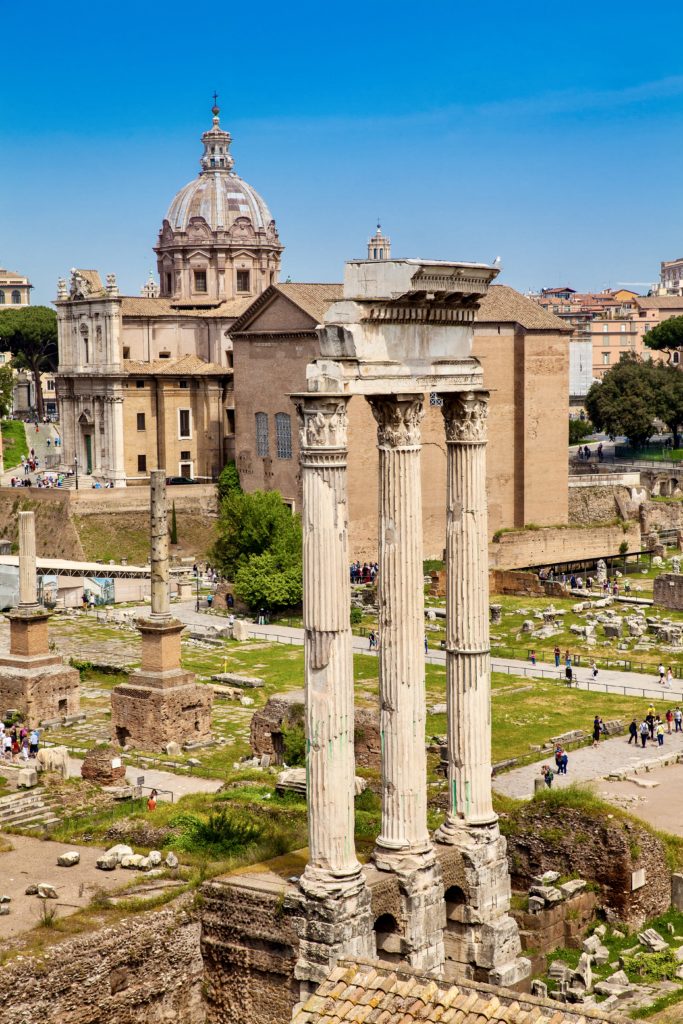
7. Temple of Castor and Pollux
Dating from the 5th century B.C., this former temple consists of just three leafy Corinthian columns. But it was once a prestigious temple in the forum.
The temple commemorated the Roman victory over the reviled Etruscan king Tarquin. After their victory, Castor and Pollux, twin sons of the god Jupiter, watered their horses on the spot.
The temple was often used as meeting place for senators. The front steps served as a podium for Rome’s orators.
8. Domus Tiberiana
Domus Tiberiana is an impressive imperial palace on the slopes of the Roman Forum. Although the entrance is on Palatine Hill, it feels like it’s part of both the hill and the forum because you can easily see it from the forum area.
This once grand estate covered nearly 10 acres, featuring luxurious residences, gardens, spaces for the Praetorian guard, and places for worship. Its standout feature is the facade, marked by large arches and barrel vaults.
The Domus Tiberiana was only discovered in 2004. After years of excavation, it opened to the public in September 2023. I visited in December and it was a truly special experience.
You’ll can only visit with a special SUPER ticket. Individual tickets are not available. For more on how that works, you can check out my guide to the SUPER ticket .
>>> Click to buy a SUPER ticket on Viator
9. Temple of the Divine Caesar
The Temple of the Divine Caesar in the Roman Forum is a famous monument dedicated to Julius Caesar, a pivotal figure in Rome’s transition from republic to empire.
The temple told the story of Caesar’s life. But it also marks the spot where Caesar, assassinated on March 15, 44 B.C., was cremated and buried.
You may get the willies standing there. This is a spot where history changed. Yet, it’s rather underwhelming to look at.
It’s a simple area with a modern canopy covering the remains of an altar. This modest mound is often covered with coins and flowers.
10. Temple of Romulus
The origin of the Temple of Romulus has been the subject of conjecture.
Most historians think that Emperor Maxentius used it as a temple for his son Valerius Romulus, who died at age 4 in 309 and was deified.
The temple’s original bronze door is decorated with two porphyry columns — a marble so rare that it’s almost extinct. Inside, the temple has several cycles of frescoes.
Inside, here are 13th century wall paintings that imitate curtains. There’s also a funerary tabernacle with a madonna and child.
They only allow a set number of people in at a time. So you should expect to wait in line.
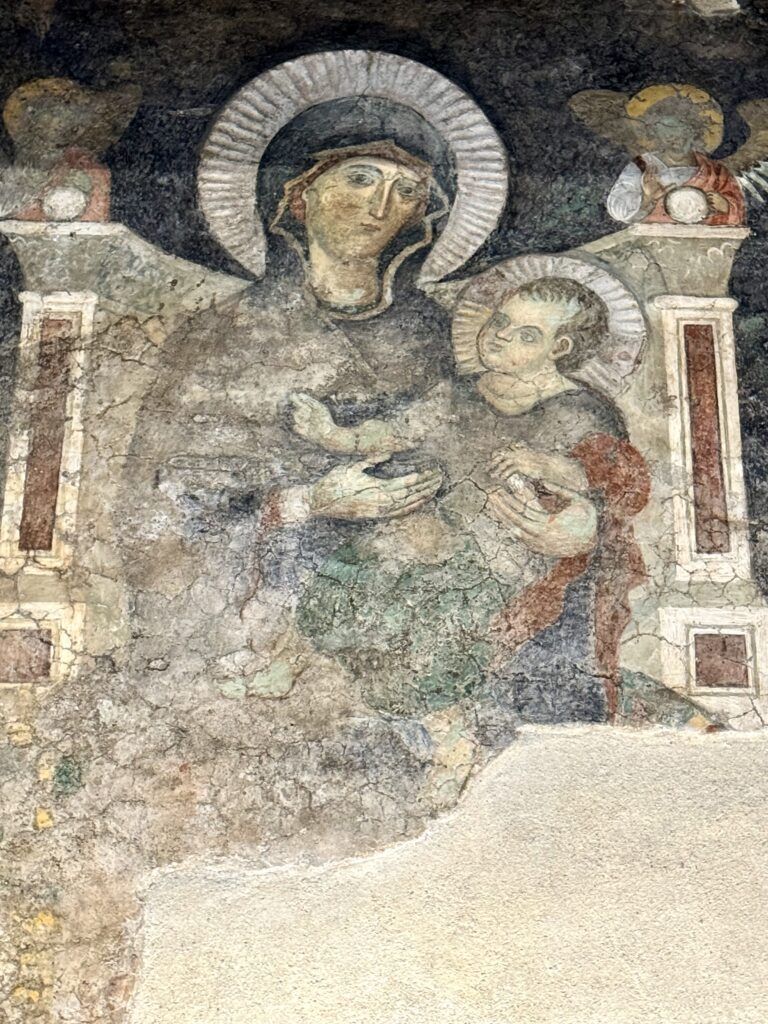
11. Temple of Antonius and Faustia
This temple was built by the Emperor Antonius for his deceased wife, the beautiful Faustina who died young. Historians consider Antoninus to be part of the five “Good Emperors.”
Antonius wasn’t long for the world either. So he decided to slap his own name on the temple as well. That meant he could walk through the forum and see people worshipping him while he was still alive.
The temple has a majestic front. The Corinthian columns are 50 feet high, with formerly gilded capitals.
A staircase led to a shaded loggia past the columns, which admitted Romans to the building. The original triangular pediment would have held vividly colored statues.
12. Santa Maria Antiqua
Santa Maria Antiqua is one of the earliest surviving Christian churches in Rome.
The Byzantine church was discovered in 1900. It was built within a 1st century Roman structure constructed by Emperor Domitian.
The church has a wealth of rare Byzantine style frescos from the 6th to 9th centuries. They depict the lives of Jesus and the Virgin Mary.
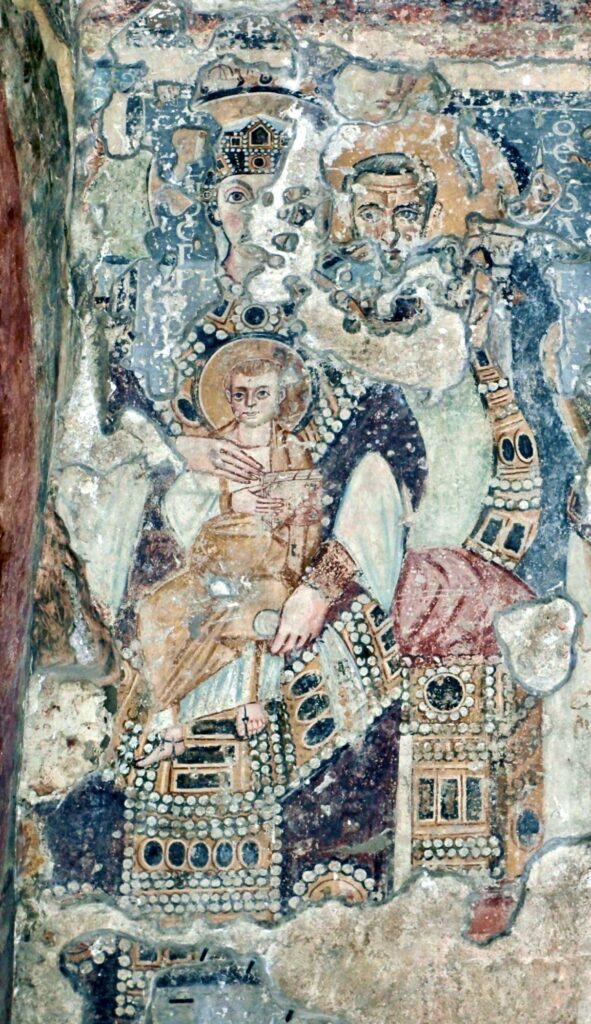
You’ll find one of the world’s oldest depictions of Jesus’ crucifixion. Christ is shown in a sleeveless blue robe.
The best preserved fresco is the cycle of the martyrdom of St. Cyricus and St. Julitta, which covers the Chapel of Theodotus. It’s considered the Sistine Chapel of the medieval era.
During a 9th century earthquake, the church was buried in rubble. It was sealed from the world for over 1000 years, only discovered in 1702. This fate might have saved the precious works from a subsequent Baroque redo.
You can only visit with the SUPER ticket. There is a 3D light show that reconstructs the frescos so you can see what they once looked like in more detail.
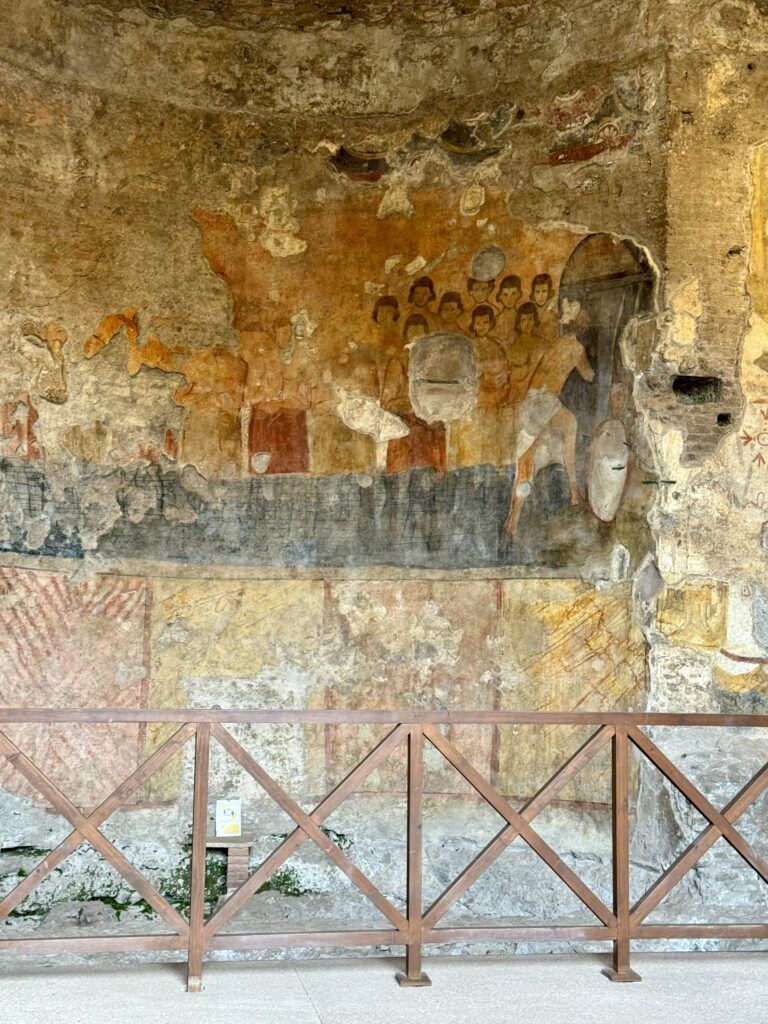
13. Oratory of the 40 Martyrs
Right next to Santa Maria Antiqua, you’ll find the Oratory of the Forty Martyrs, another SUPER site. This smaller room has some faded, but still beautiful, collection of 8th and 9th century frescoes.
The oratory gets its name from the Forty Martyrs of Sebaste, a group of Roman soldiers martyred under Emperor Diocletian for their Christian beliefs.
The frescoes on the walls vividly portray these saints and martyrs, including the Forty Martyrs themselves.
These paintings are key examples of early medieval Christian art and illustrate the martyrs’ ordeal and execution, where they were forced to endure a freezing night in an icy lake.
14. Domitian’s Ramp
In ancient Roman times, Santa Maria Antique was likely the entrance hall to the 1st century Ramp of Domitian. The ramp connected the public area of the Roman Forum to the private imperial palace complexes on Palatine Hill.
It was discovered by Giacomo Boni, an architect and archaeologist. He excavated it mostly between 1899 to 1905.
The ramp has seven levels, six hairpin turns, and is both above and under ground. It empties into a hilltop terrace with a breathtaking view over the Roman Forum.
After years of conservation, the church and ramp opened to the public in 2015. Now, with the SUPER Pass, you can walk along the 2000 year old passage, just like the emperors did.
15. Arch of Septimius Severus
The grand six story Arch of Severus celebrated Emperor Severus’ victory in Mesopotamia.
It’s adorned with reliefs showing soldiers leading captives and slaves back to Rome, reflecting a time when Rome increasingly relied on plunder, contributing to its eventual decline.
Dedicated to Severus’ sons, Caracalla and Geta, the arch became a symbol of family betrayal.
After Severus’ death, Caracalla, who would gain notoriety as an emperor, murdered Geta to rule alone and then erased all traces of his brother from history, including mentions of the arch.
The arch itself features three vaulted passageways, flanked by four detached columns on elevated bases. Below the arch is a circular base, marking the exact center of ancient Rome and symbolizing the saying, “all roads lead to Rome.”
16. Temple of Saturn
This temple, the oldest in the Roman Forum, was more than just a place of worship. It served as the treasury of Ancient Rome.
racing its origins back to the 5th century B.C., the structure you see today was actually rebuilt in the 4th century A.D.
As you look at the temple, the columns that catch your eye once framed its entrance.
Inside, there was once a simple wooden statue of the god Saturn. Interestingly, the statue had a secret: its base was a storage spot for treasures, filled with various forms of booty and plunder from Rome’s conquests.
17. Curia Julia | Sant’Adriano al Foro
The remains of the Curia Julia date from 283. The curia was completely restored in the 1930s.
This was the Supreme Court of Rome, and the most important political building in the forum. The senators gave speeches and promulgated the laws of the land. There were four chambers hearing cases.
It was common for the orator-lawyers to go outside and pay people to come in and clap during their rousing orations. They were essentially professional clappers.
If the curia is open, you can see two statues. One headless statue, made of porphyry marble was dedicated to either Hadrian or Trajan. Unfortunately, it’s usually closed.
18. Rostrum
The Rostrum was the “Speaker’s Corner.” Archaeological evidence suggests that it has existed since the 5th century B.C. But it wasn’t officially called the “rostra” until the 4th century A.D.
The Rostrum was a long stage created for Rome’s great orators to speechify to the assembled masses and try to sway public opinion.
The rostrum was likely 10 feet high and 80 feet long, ornately decorated with columns and statues.
During the republic, freedom of speech reigned free. During the empire, free speech took a hit when it was more dangerous to speak truth to power.
Great events in Roman history occurred here. Cicero railed against Rome’s corruption and decadence. Mark Anthony offered the laurel of kingship to Caesar, who dramatically refused preferring to be a private dictator.
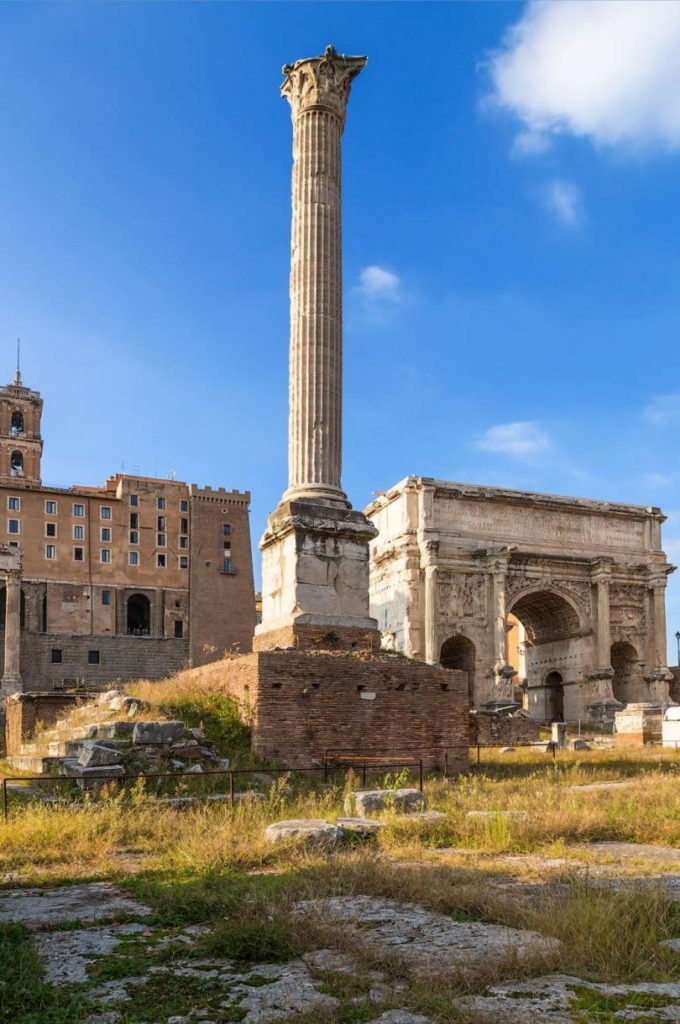
19. Column of Phocas
The Column of Phocas was the last monument to be erected in the Roman Forum. It’s a triumphal column in honor of Phocas, a 7th century Byzantine emperor who ruled Rome from the east.
The column was supposed to represent a unified Rome, a new dawn for the Roman world. But that was a delusion. Rome was on its way out.
And so was Phocas. He had murdered his predecessor to usurp the throne in 602. Two years after this column was erected, he himself was assassinated.
Phocas did succeed in one thing though. He gifted the Pantheon to the Pope Boniface IV to turn into a church, probably saving it from ruin.
The 45 foot column is a little piecemeal. The base once propped up a statue of Diocletian. The column itself was taken from an older building.
It’s recently been restored.
Practical Guide & Tips For The Roman Forum
Address : Via della Salara Vecchia between Piazza Venezia and the Colosseum
Hours : Daily 8:30 am to 7:00 pm
Ticket Price : Combined ticket to visit The Roman Forum, the Colosseum, and Palatine Hill is 16 euros. There is an online booking fee of 2 euros.
Metro : Colosseo
Pro Tips : You can also visit the Roman Forum using the Roma Pass , which is a cumulative ticket that provides free or reduced rates for more than 40 attractions plus public transportation.
I have you’ve enjoyed my guide to the monuments and ruins of the Roman Forum. You may enjoy these other Rome travel guides and resources:
- 8 ways to spend 1 day in Rome
- 3 day itinerary for Rome
- 5 day itinerary for Rome
- 1 day itinerary for Vatican City
- Hidden gems in Rome
- Best museums in Rome
- Guide to the Borghese Gallery
- Guide to Palatine Hill
- Guide to the Colosseum
- Walking tour of central Rome
Pin it for later.
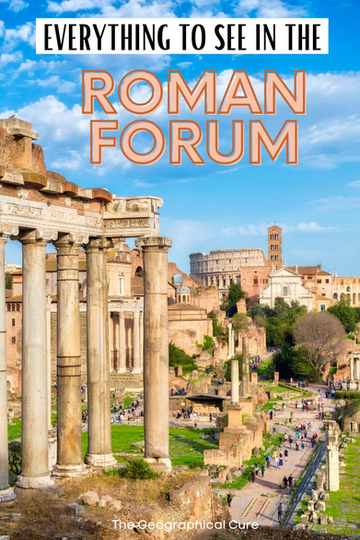
Leave a Comment Cancel reply
Save my name, email, and website in this browser for the next time I comment.
Last Updated on January 21, 2024 by Leslie Livingston
Ultimate Roman Forum Map, Palatine Hill & Roman Forum Self Guided Tour
Complete guide to 37 attractions on palatine hill and the roman forum, self guided tour of palatine hill and forum romanum attractions, palatine hill and the roman forum.
Walking through the roman forum buildings and palatine hill ruins takes us back to a time when this small piece of land was the center of the Greatest Empire known to man namely the Roman Empire that spanned over 1,200 years . The nobility lived on palatine hill and displayed the power of the Roman Empire in the Roman Forum. For over 12 centuries, the roman soldiers and their leaders controlled vast lands from 700 BC to 500AD. For centuries the roman forum was the center of their day to day life, the site of religious ceremonies, triumphant processions, gladiator games and their commercial and economic center. You may have heard the term “all roads lead to Rome” meaning all roads led to this area of land that started as a marshy burial ground in the 7 th century BC and ended up after the fall of Rome as a cow pasture “Campo Vaccino” during the renaissance
In the 1,200 years since the start of the forum, the roman forum buildings have had name changes and function changes. The roman buildings have been destroyed in fires and riots, rebuilt, repurposed, dedicated and rededicated depending on who was out of favor at the time. Each roman forum building and site has its own colorful history which I will explain as simply as I can as roman history can be very complex
General Information
On a macro scale, the Forum and hills surrounding it were divided along functional lines. The Capitoline Hill was the administrative office. The Palatine Hill had the residences of nobility while the Forum at the base of the Capitoline hill was the place of political functions and commerce. The Forum square was also divided along functional lines. On one side you see the dedications to deities via temples, monuments, statues, triumphal arches as well as meeting places for governing and justice. On the other side of the forum you see roman buildings used for commerce; buying, selling and trade including market stalls
After purchasing our roman forum tickets which included two day passes to the colosseum , palatine hill and the roman forum, we started our roman forum tour from the colosseum and headed down the “via sacra” to the Arch of Titus entrance to the Roman Forum. This was the processional route of many religious and military triumphal marches/ceremonies
As you walk down this route, the historic significance is overwhelming when you think about the number of roman soldiers, golden chariots, kings, senators, emperors and other roman citizens who walked these very same streets for over a millennium
Self Guide Tour Map Palatine Hill and Roman Forum
Use the Palatine Hill & Roman Forum map & this self guided tour to visit the ruins. There are over 25 popular attractions; you can also download the google map of the ruins and use it offline as your self guided tour. It’s a good idea to do some planning before visiting the ruins because if you put yourself at the mercy of the tour guide, you may miss the fun of wandering around at your own pace and discovering the various attractions. We used an official tour guide and afterwards realized how much he didn’t cover. It would have been far better to have our own agenda in advance with a map (below) and attractions guide to visit the ruins
Download Interactive Palatine Hill a nd
Roman forum map to use online or offline.
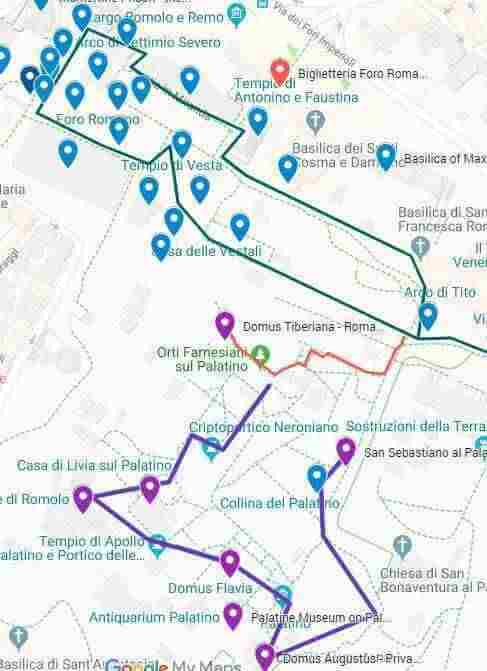
Download the Palatine Hill
Sacred road (via sacra).
Via Sacra is the main street in Rome from the colosseum to the top of Capitoline Hill (Temple of Jupiter Capitolinus). It is also the triumphal processional street from the colosseum to the Roman forum ‘
Many triumphal parades and religious festivals had passed along this route for many centuries. After the Great Fire of Rome in 64AD (attributed to Nero), Emperor Nero paved and lined this route with grand columns and replaced the butcher shops with high end stores at the forum romanum. He also straightened the road, removing the fork that led from the entrance of the forum to the north. Interestingly enough Via Sacra was also used by the prostitutes who lined the street. They mixed in with the Romans who went about their daily lives on the via sacra whether to attend to business at the basilica Aemelia or to visit one of the many shops that lined the street
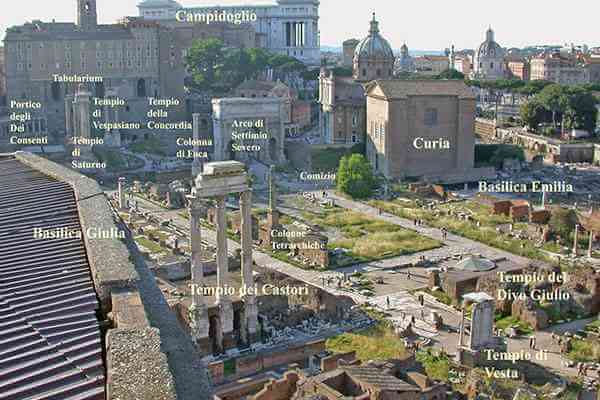
Arch of Titus (Arc de Titus)
The arch was built in 82AD by Emperor Dometian, to honor the Flavius family line , and to commemorate his older brother Titus and father Vespasian. Dometian was too young to take part in the military campaign, specifically referring to the victory related to the Siege of Jerusalem. One of the reliefs on the arch refer to this event and can be seen on the map that is associated with this self guided tour. Click on the Arch of Titus google map pin above to see the image of the relief.
The relief shows two key events from the battle: In one scene Romans are carrying the spoils of war including a menorah (a candelabrum used in Jewish worship) from Judea to Rome. In another scene you see the four horse chariot with the Emperor accompanied by deities and mystical figures in a triumphal march to Rome
Vespasian and his eldest son Titus were victorious over a revolt in the Roman province of Judea (Jerusalem). Many victories were celebrated with the building of a monument whether an arch or a column to remind the population of the triumphs of the Emperor
The arch is located at the base of Palatine Hill at a key location on the main triumphal processional route from the colosseum to the Forum Fomanum on the via Sacra
The inscription on the Arch refers to Titus and Vesparian as Divo Titus and Divo Vesparian. Divo meaning divine as they were deified after death. Whenever you see “Divo” on an inscription it means it was erected after death. The inscription is as follows:
“SENATUS POPOLUS QUE ROMANUS DIVO TITO DIVI VESPASIANI F VISPASIANO AUGUSTO”
Translated as “The Senate and People of Rome dedicate this to Divus Titus, son of Divus Vespasian, Vespasian Augustus”
Who built the Roman Colosseum
It was Emperor Vespasian who commissioned the Colosseum where Emperor Nero’s new place in the roman forum stood. His sons completed the Colosseum construction after Emperor Vespasian’s death. As a result the coliseum is also referred to as the Flavian Amphitheater, after the Flavian Dynasty to which Vespasian and his sons were part of
Octavian – First Emperor to be called Augustus – Emperor Augustus
Emperor Augustus (27 BCE – 14 BCE) was known as the greatest Roman Emperor. His birth name was Gaius Octavian and he was adopted by his great uncle Julius Caesar. The powerful Roman Senate bestowed the title of Augustus meaning “the illustrious one” and he was known as Gaius Julius Caesar Augustus. This did carry some resentment as Mark Anthony was recorded by Cicero as having said “You owe everything to your name”. Augustus was well liked and respected. He restored peace to the Roman empire and the economy, arts, and agriculture flourished under his rule.
Temple of Venus and Rome ( Temple de Venus et de Rome )
What I am about to describe are the many changes that have occurred to the Temple of Venus and Rome and the many name changes it has had over the centuries
The Temple of Venus and Rome is located on the Velian Hill, one of the original of the seven hill settlements that eventually became part of ancient Rome. Refer to image on the interactive map; the interactive map is found by clicking on the map image above. During the time when Roman worshiped idols, the Temple was designed by Emperor Hadrianin in 121 AD and finished by his successor the very popular and well liked Emperor Antoninus Pius in 141AD. (of the Antoninus and Faustina Temple in the Roman forum). Given the slope of the hill, the temple platform faced the colosseum and was 30 feet higher at the top of the hill
The Temple of Venus and Rome was ancient Rome’s biggest temple at 350 feet long and 150 feet wide, comprising of two main chambers where each chamber was dedicated to the goddess of Love and the Goddess of Rome. The temple was damaged in the first of many fires that ravaged Rome. After the fire in 307 AD, the temple was restored by the then Emperor Maxentrius
Emperor Constantine (ruled from 306 – 337AD) converted to Christianity and following his conversion signed the Edict of Milan in 313AD legalizing Christianity and allowing the freedom of worship. It also allowed Christians to build places of worship including St Peters Basilica . Christianity became the official religion of the Roman Empire in 380 AD under Emperor Theodosius I. Many temples and pagan ritual sites were abandoned, including the Temple of Venus and Rome. Emperor Theodosius I also suppressed pagan worship in 390AD, which started the movement to either convert the pagan worshiping temples to churches or to have them stripped to build other churches and monuments throughout Italy
In 625 AD, under Pope Honorius, and with consent of Emperor Heraclius, the abandoned Temple of Venus and Rome was stripped of its bronze and marble to repair Old St Peters Basilica. The next major event to take place to the temple (temple site) was the earthquake in the 9 th century (847AD). It damaged many buildings in the roman forum and virtually destroyed what was left of the temple
Santa Maria Nova (“New” Church)
The earthquake severely damaged the oldest church in the roman forum, the Santa Maria Antiqua. It was built in the 5 th century on the north-west slope of Palatine Hill which was an ancient hill known as Velien. Pope Leo IV ordered the building of the Santa Maria Nova Church (nova meaning new) on the site of the Temple of Venus and Rome
Santa Maria Nova Church, the “new” church was built to replace the Santa Maria Antiqua, as the place of worship. Once the Santa Maria Nova was built, the obligations and rights of the Santa Maria Antiqua was transferred to the Santa Maria Nova
In 1612, Santa Maria Nova Church underwent major restoration and was renamed Basilica di Santa Francesca Roman. It was rededicated to St Frances (1384-1440) who was born a noble woman. She dedicated her life to to helping the poor and was canonized in 1608. Her remans are still in the crypt in the church
Basilica of Maxentius (Basilique de Maxence et Constantin)
The site was the location of the Horrea Pipertataria warehouse which burned down in the fire of 283 AD. Horrea Pipertataria was built in the 2 nd century to store grain, clothing, marble, olive oil and other food items. When Emperor Septimius Severus (Same person who built the Septimius arch in the Roman Forum), died in 211 AD he had stockpiled enough food in the warehouse to feed the 1 million citizens of Rome for 7 years
The construction of the Basilica on the site of the warehouse began in 308AD under Emperor Maxentius and was completed under Emperor Constantine in 313AD. Constantine completed the basilica after he defeated Maxentius at the Battle of the Milvian Bridge in 312AD. A painting by Raphael showing this moment in history is on dispaly in Raphael Room 1 Hall Of Constantine titled The Battle of Milvian Bridge on the south wall. The basilica was nearly complete when Constantine took over the building and design thereby making minor changes. The changes included re-positioning the entrance from facing the Temple of Venus and Rome to facing Palatine hill to the South. He also added another apse, and replace the colossal statue of Maxentius located in the western apse with his own head
The Basilica’s originally functioned as a courthouse, administration building, meeting hall and a place of business, in essence a roofed extension of the forum. Over time the design of the basilica was used in the building of churches and basilicas and became synonymous with places of worship. Emperor Constantine felt that the design of the basilica, shaped like a crucifix, would be the perfect design for Christian worship. Many churches all over the world today are designed in the same way ie: in the shape of a crucifix
The Basilica of Maxentius and Constantine speaks to the engineering ingenuity of the Romans taking aspects of designs from the roman baths and of typical roman basilicas. Engineers today marvel at the technology that allowed the massive 130 feet high barrel and cross vaults to stand unsupported using unenforced concrete. It is a colossal structure of 6500 square feet and 66ft high. Of the Corinthian columns of marble that were built only one of the eighth has survived
Temple Of Divus Romulus (Temple de Romulus)
Originally it was the site of the temple of Jupitor Stator or Temple of Penates, identified by its rotunda. After the great fire in 306AD, Emperor Maxentius began a great rebuilding program in the roman forum. Maxentius and the Pagans were losing ground to the Christians which were estimated at 25% of the population. Maxentius who was trying to revive the old original pagan gods and temples, was killed by Constantine who eventually led in the era of Christianity.
Maxentius rebuilt this temple and dedicated it to his young son Valerius Romulus who died in 307AD. Romans believed that by building a temple dedicated to themselves, they became a deity (God). Emperor Constantine, after defeating Maxentius, renamed it back to its original name of Temple of Jupiter Stator
The temple was Christianized in 527 AD and the rectangular hall attached to the temple became the Basilica of Santi Cosma e Damiano (Basilica of Saints Cosmas and Damian). It was dedicated to twin brothers from Greece; Cosmas and Damian. They were both physicians, who were martyred and became saints. It is a functioning church today with an entrance from via dei Fori Imperiali
The most striking feature is the circular dome, with red porphyry columns surrounding the massive 4 th century bronze door. Legend has it that if a person is sick and sleeps in the Church, they would be cured by receiving a dream that would lead to a cure
In 1632, Pope Urban VII had the basilica restored. They raised the floor seven meters to match the current main level of the roman forum which had risen due to the pile-up of debris. It was further restored in 1947 adding a main entrance from the street and closing the one from the forum. Along with the Pantheon, it is one of the best preserved pagan temples in Rome
There is an additional charge to view the Temple of Romulus and is included as part of the SUPER ticket
Antoninus and Faustina Temple
By historical accounts, Emperor Antoninus and his wife Faustina had a happy marriage. They had two sons and two daughters. Faustina died at the age of 35. Antoninus was devastated by her death and sought to deify her. As a well-liked emperor he received the support of the senate and the temple was built in 141 AD dedicated to his deified wife Faustina the Elder. Emperor Antoninus established a charity dedicated to her called the Girls of Faustina whose goals were to assist orphan girls. Antoninus was the adoptive son of Emperor Hadrian and one of five “good” emperors of Rome. He reigned for 23 years, longer than any other Emperors other than Augustus. Like his father Hadrian, he disliked war and did not feel the need to expand Rome’s borders any further. His reign concentrated on making life better for those who lived within the empire. This resulted in the longest period of peace Rome had experienced. Historical accounts show him to be well spoken, a good orator, kind hearted, calm and not easily tempted by money and power. He exemplified what the romans wanted in an emperor. He died at the age of 74 in 161AD with such a high level of popularity that he was unanimously deified by the usually squabbling senate. The temple of Faustina was rededicated jointly to Antoninus and Faustina at the request of his successor Marcus Aurelius.
The temple was converted to a roman catholic church in the early seventh century and renamed Chiesa de San Lorenzo in Miranda. It is believed that this was the location of the sentencing of the St Lawrence by the Prefect of Rome. Over time its porch was enclosed with chapels. The notches in the upper part of the columns indicated the mark where the sloping tile roof of this structure was fitted into another ancient structure (they are not rope marks in an attempt to bring down the pillars as stated by various tour guides). The height of the door represents the ground level at the time the temple was built
House of the Vestals
Located behind the circular Temple of Vesta . It was the home of the Vestal Virgins, a female priesthood in Ancient Rome. There were six Vestals between 6 to 10 years old from noble roman families. They were in charge of carrying our numerous rites and rituals including keeping the eternal fire lit in the Temple of Vesta . The served for thirty years where the first 10 years they learnt the sacred rights, the next 10 years they performed these rights and the next 10 years they taught the next set of girls. The sacred rights included fetching holy water, keeping the eternal flame lit, guarding sacred objects, preparing sacrificial items, and other complicated ritualistic acts and ceremonies. During the thirty years served as vestal virgins they were forbidden from having any carnal relationships. At the end of their service, they were free to marry. No one was to harm them as they would be punishable by death and they were allowed to own property
They were watched over carefully by the Pontifex Maximus who had an adjoining house. If they failed to follow the chastity rules they were buried alive in a chamber below ground and their lovers were flogged to death. If they failed to perform their duties, like letting the lit fire go out, they were severely punished including being beaten with rods by the Pontifex Maximus. The rules became so stringent (no joking allowed) and the punishments so harsh that many parents were unwilling to offer their children to the task
The vestals lived together in the House of Vestas which was completely self-contained with a kitchen, a grain mill, an oven, baths, dining room, pools, a portico and courtyard complete with statues of featuring previous Vestals. After the great fire of 64AD, it was rebuilt by Nero. It underwent another restoration by Trajan and then again under Emperor Septimius Seversus. It shows the dedication to the cult over the years
After the suppression of pagan rituals by Theodosius in 390AD, the Vestals left in 394AD and the complex was used as imperial offices
Temple of Vesta (Tiempo di Vesta or Temple de Vesta)
It is located in the roman Forum near the House of Vestal Virgins. It is easily recognizable by its circular shape (refer to interactive map for image). Vesta temples were round and had east facing entrances to make a connection between the eternal fire and the Sun. The cult was started in 7 th century BC by Numa Pompilius, the legendary second King of Rome. The eternal fire represented the symbol of eternity of Rome and the romans believed that their fortunes were tied to the flame of the fire. As long the fire burned, Rome would dominate and extinguishing of the fire was viewed as a disaster for Rome
Like other buildings in Rome, the temple was built and rebuilt many times due to fires and earthquakes. The first destruction was in 390BC then again in 241BC, in 210 BC and during the time of Nero and Septimius Severus. It shows the romans dedication to the cult over the many centuries
The Temple remained mostly intact until the Renaissance when it was stripped of its marble and other assets. In 1549 AD it was stripped of the remaining marble to build palaces, monuments and churches throughout Italy. It was completely demolished at that time and only a few pillars and a partial base remain.
The debris from demolishing of the many buildings as well as earthquakes caused the roman forum to be buried over time
Temple of Caesar (Temple dei Divo Guilio, Temple de Caesar)
Julius Caesar was killed in 44BC on March 15 , commonly refer to as the “Ides of March”. He was stabbed 23 times by each of the 23 senators. The last stab wound was by his good friend and advisor Brutus. As the knife went into Caesar, he whispered “et tu Brute” translated as “you too, Brutus”. This is now a famous modern day phrase referring to betrayal
In Caesar’s will he had left 75 drachmas (1/3 of a soldiers annual pay) to every roman citizen living in the city. He left his private gardens to the citizens of Rome and named his successor as his adopted son and nephew Octavius. At his funeral, his general and loyal supporter Marcus Antonius (Mark Anthony) gave a speech at the Rostra. His eulogy inflamed the already heightened emotions of the roman people who now viewed Caesar as a deity
Julius Caesar’s Funeral
At Julius Caesars funeral, on the podium at the Rostra in the Roman Forum, Mark Anthony made his famous speech starting with “ Fr iends, Romans, countrymen, lend me your ear… “. In a dramatic fashion, Mark Anthony uncovered Caesars toga and lifting it at the end of his sword and waving it towards the crowds so they could see the gashes made by the 23 knife wounds. The crowds rioted, grabbed Caesar’s body and wanting to deify him, took the body to be buried with the other gods in the Temple of Jupiter on Capitoline Hill. They were turned away by the priest as people were not buried in temples. They returned to the forum with his body and cremated him in front of the Regia (palace of the Kings)
In 42 BC the construction of the Temple of Caesar began after the senate defied him and at that time Mark Anthony was named as the first priest of the temple. The construction took a long time and remained undedicated until 29BC. The site of the temple was the location of Julius Caesar’s cremation. In the years that ensued, there was a power struggle between Octavian (Julius Caesars named heir), and Brutus. Mark Anthony and Octavius combined forces to defeat Brutus’s army
Following Brutus’s defeat, there was a power struggle between Octavius and Mark Anthony, who had taken up with Cleopatra in Egypt. He was hoping to use Egypt’s wealth to launch an assault on Octavius. Their failed attempt led to the suicide of Mark Anthony and Cleopatra’s in 31BC. Octavian became one of Rome’s most beloved rulers and also its first emperor under the name Caesar Augustus
Augustus created a new roman tradition which was that dead roman rulers could be deified and as a god, they would have a temple dedicated to them. Julius Caesar was the first roman to be deified and honored with a temple named after him. The Temple of Caesar was dedicated to him on August 18, 29BC
Today the site of the Temple of Julius Caesar contains a mound of dirt that many leave flowers on. This was the altar of the temple and the actual site of his cremation
Shrine of Venus Cloacina (Sacrum Cloacina, Cloaca Maxima)
The roman forum started its life as a marshy burial ground for the settlements of the seven hilltops that surrounded this valley. Eventfully the settlements started to meet and trade. The marshy valley was seen as a perfects spot for a market to trade. They developed an ingenious sewage system called the Cloaca Maxima . It is one of the world’s earliest sewage systems. The shrine marks the entry to the system that drains the forum and it is marked by a shrine on unknown height and 8 meters in diameter thought to have been constructed in 33BC
Basilica Emilia
In 5 th century BC, the site was that of butcher shops called tabernae lanienae. In the 4 th century BC they were replaced by tabernae argentarie that is the city bankers or the center of banking. The building has undergone either damage or destructions due to fires, natural disasters and has been rebuilt in 210 BC, 191BC, 179BC, 14AD and 22AD. The 22AD restoration resulted in a basilica that catered to the courts, markets, shops and a place for public speaking. The latest rebuild resulted in a portico that overlooked the forum and was dedicated to the grandsons of Emperor Augustus; Gaius and Lucius (Porticus Gai et Luci). The basilica was almost completely destroyed by King Alaric and his Visigoth army in the Sack of Rome in 410 AD. It was rebuilt in 420 AD and finally collapsed in the 847 AD earthquake. The remains were used as building materials for monuments and churches elsewhere
Column of Phocas
The 44ft fluted column was dedicated to the Byzantine Emperor Phocas, Who had murdered his predecessor along with his five sons to seize the crown in 608 BC. The column of Phocas, located close to the Arch of Septimius is a rededicated column and the last addition to the roman forum. Originally dedicated to Emperor Diocletian, it was rededicated to Emperor Phocas in 608 BC. The original inscription at the base has been chiseled off and a new inscription praising lord Phocas as the perpetual emperor, crowned by God is still visible. The precise reason of this honor is unknown however it may have to do with Phocas’s donation of the Pantheon to the Church in the time of Pope Boniface IV. Most columns had a statue on top and this one was no different. The top of the column had a gilded statue of Phocas
Two years after the column was erected, Phocas suffered a heinous death in 610BC. His private parts were cutoff, he was skinned, beheaded and his body burned because he had raped a noble woman, identified as the wife of Photius, who was in service to God. Statues and monuments to him were then destroyed across the empire
Curia Julia
Curia was used to denote a place of meeting where an assembly or council discussed religious, official and public issues. Curia became synonymous with the meeting place of the senators. The powerful original House of the Senate was originally built by Emperor Tullus Hostilius, known as a warrior king. He was the third King of the 7 kings of Rome whose grandfather fought alongside the Romulus, the founder and first King of Rome
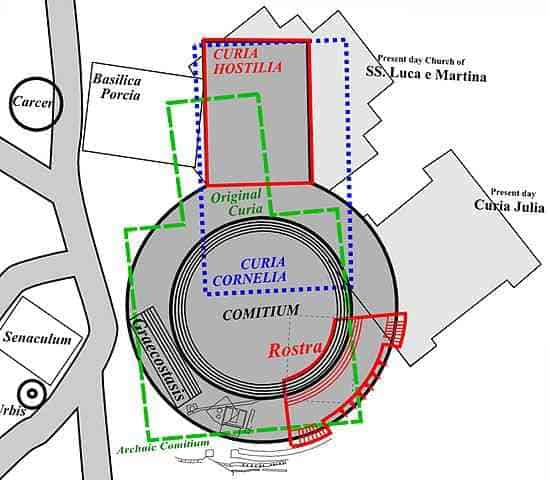
The Curia Hostilia began as a temple just next door to the current Curia Julia. The temple was the location were the warring tribes laid down their weapons during the reign of Romulus. The temple was used by senators as an indoor meeting place and a space was reserved outside for outdoor assembly. This space was called the comitium. The role of the senators was to act as council to the King. The temple was destroyed by fire and the Curia Hostilla was built next door to the original temple site. The site where the temple was, is the location of the present day Chiesa dei Santi Luca e Marti Church
In 80 BC, the dictator Lucius Cornelius Sulla enlarged the Curia Hostilius into the comitium space to accommodate additional senators. This new House of Senators was called Curia Cornius. Curia Cornius was burned down in the riots of 52BC. Curia Julia is the third name for the House of Senate. It was built in 44BC by Julius Caesar. During the construction phase the meeting place for the senate was relocated to Teatro di Pompeo (the theater), a temporary curia. He overhauled the curia design of both the House and the Comitium reducing the size of house and the number of senators (from 600 to 300). Caesar was assassinated by some of the senators before the curia was completed. His assassination was carried out by 23 senators (hence 23 stab wounds) who were worried about his thirst for power as he had also named himself dictator for life
Curia Julia was completed by his successor and nephew Octavius (Emperor Augustus Caesar) in 29BC. The structure has remained intact as it was converted into the Sant’Adriano al Foro in the 7 th century and further renovations were completed in the 1930’s
Lapis Niger
The Tomb of Romulus who was the founder and first King of Rome . The tomb is located in a prominent position in front of the Senate (Curia). It is covered with a black marble. The area is blocked off with a rope or railings. The oldest Latin inscriptions can be found on the column next to the tomb that suggests that a curse will befall anyone who walks on the site. You can see the Lapis Niger (large black marble slab) on one of the recreations of the roman forum self guided tour and map that accompanies this guide
The speakers’ platform, known as the Rostra was built directly at the base of the Constantine arch and next to the Lapis Niger
Chiesa dei Santi Luca e Martina (Eglise Saint Luc et Martine)
This was built on the site of the comitium, the meeting place of the roman senators. A portion of the comitium was replaced by the Curia Hostilia, the first house built specifically for the senators. This was replaced by the much larger Curia Cornelia in 80 BC which was demolished by Julius Caesar to build a much smaller Curia Julia in 44BC
Martina of Rome was from a noble family and was orphaned at an early age. She turned to Christianity and was persecuted by Emporer Alexander Severus as she defied his command to return to idol worshipping. She was subject to various forms of torture and was finally beheaded. She was martyred in 228AD. Pope Honorius I commissioned the construction of the church dedicated to St Martina in 625AD. It was restored in 1256 AD under Pope Alexander IV. It underwent another renovation in the 17 th century
Mamertine Prison – the Tullianum
It was built around 640 BC as a cistern (to hold water) for a spring. Sometime in the 4 th century BC, it became a prison. Above the spring were two floors; the lower level dome shaped dungeon called tullianum used for executions and the upper level used to hold prisoners awaiting trial. Prisoners were lowered into the dungeon (lower room) through a small round opening to die slowly. These were prisoners who were not executed publicly. Roman law did not have imprisonment as a sentence, therefore incarceration was a temporary measure for the sentence that was passed down at trial ie: hard labor, death, etc. The tullianium or jail was used as a holding cell for short periods
The apostles St Peter and St Paul are said to have been held prisoners here before their execution. An altar dedicated to them is located in the lower level of the building. It is said that the spring miraculously stated to flow when St Peter was held here and he was able to baptize his prison guards. The cross on the altar is upside down as Peter was crucified upside down. An Altar showing the event of St Peter baptizing his prison guards is located in St Peters Basilica , the site of St Peters Crucifixion . A painting by Raphael titled “Deliverance of St Peter” is in Raphael Room 2 Hall Of Heliodorus, north wall of the Vatican Museum. He was crucified in the Circus of Nero, Old St Peters Basilica was built on the Crucifixion site, his tomb is HERE in St Peters basilica
The site was converted into a Christian place of worship in the medieval times and today has a chapel on each level
- The Lower level – Capella San Peitro in Carcre (Chapel of St Peter in Prison)
- The Upper level – San Giusppe Dei Falegname
There is an additional fee to enter if you purchased the regular entrance to the forum, coliseum and palatine hill. You may need to book a time slot to enter
Septimius Severus Arch (Arc de Septime Severe, Arco di Settimio Severo)
The 23 m high and 25 meter wide arch was built in 203 AD to honor the Emperor Septimuis Seveus and his sons Geta and Caracalla. The reliefs in the arch portray the victories against the Parthians and other reliefs show romans capturing barbarians. The arch was topped with a gilded statue of Septimuis and his two sons riding in a chariot pulled by six horses. Unsurprisingly, given roman history, after Septimius’s death, Caracalla took over the throne and had his younger brother Geta killed in 212AD. He even had his name chiseled out from the dedication inscription of the arch and replaced with additional titles and dedications to Septimius and Caracalla
The Rostra (I Rostri, Rostra vetera)
The rostra is a platform measuring 24mx12m at the base of the Arch of Septimuis. It was built as a speaker’s platform where any citizen could address the crowds. It was from this platform that Mark Anthony address the Romans after Julius Caesar’s assassination in his famous speech starting with “Friends, Romans, countrymen, lend me your ears…”
Umbilicus Urbis
The Umbilicus Urbis is located close to the Arch of Septimuis. A small plaque on a circular brick structure with latin inscription is used to denote the location. It is the symbolic center of roma
Below this location is the Mundus, the gateway to the underworld of the dead. The pit was ritually opened three times a year. According to legend, when Romulus founded rome, he had a circular pit dug and the first fruit of harvest along with a handful of dirt from the citizens place of origin was thrown into this pit every year and the city of Rome was built around it
Milliarium Aureum
Translated as the “golden milestone” it was built in the time of Emperor Augustus Caesar (birth name is Octavian – the nephew of Julius Caesar) in 20BC. Used to measure distance, all locations in Rome Empire were measured relative to their distance from the golden milestone. “All roads lead to Rome” refers to this central spot of Rome’s road network
Temple of Vespasian and Titus
Upon the death of his father Vespasian, Emperor Titus started this temple to deify his father. He died before the temple was completed and his younger brother, Emperor Domitian completed the structure and dedicated it to both his father and his brother. The dual dedication raised the status of the Flavian family to which Domitian belonged. Domitian was also responsible for the construction of the colosseum or Flavain amphitheater
A central repository of official city documents from 78BC, the project was commissioned by the roman dictator Lucius Cornelius Sulla (from the Curia Cornelius era). The tabularium is a 74m long building located at the base of Capitoline Hill. It was the location of Rome’s official documents and offices of many city officials, the city hall and records office. The building housed the public state archives including important public acts of ancient Rome, the decrees of the Senate and peace treaties. Its laws and treaties were kept here on tablets. The tablets were engraved on bronze tabulae (hence the name of tabularium). You will not be able to enter as the building is closed to the public
Temple of Saturn (Templo de Saturno)
This site was the location of the Altar of Saturn. The altar was replaced by the Temple of Saturn which was dedicated to the agriculture god in 497BC. The order to build the temple was given by King Superbus, the last King of Rome before the start of the Roman Republic. At one time it held the public treasury which was beneath the stairs under the high podium. The temple underwent several restorations in 42BC and after a fire in 283AD. Very little else is known of its history. It is identified by the eight columns that are still left standing at the foot of Capitoline Hill on the western end of the roman forum
The worshipping of Saturn was celebrated on December 17 every year dating back to the 5 th century. It was a very popular celebration which included exchanging of gifts, slaves were given the same rights as other roman citizens and there was a general atmosphere of goodwill. The celebrations could last up to seven days. Over time this festival was rolled into the Christmas celebration
Basilica Julia (Basilica Giulia)
The land was part of the House Scipio Africanus, a great roman general known as the Scipio the Great. He eventually retired to the country after being disillusioned by the roman political system and led a quiet life before his death in 183BC. Tiberius Sempronius inherited this land through his wife, who was Scipio’s daughter. Sempronius was a popular roman political figure, who built the Basilica Sempronia, on this site in 169BC. In 54 BC Julius Caesar demolished the Basilica Sempronia to build the Basilica Julia at 101 meters long and 49 meters wide
The basilica Julia was completed by Augustus (Octavian) and dedicated to Julius Caesar in 46BC. It burned shortly after and was repaired and rededicated in 12 AD. It was the location of four civil courthouses in an open plan layout. Historical documents show the exasperation of senators as they pleaded their cases and were drowned out by others in the court rooms adjacent. Those with great oratory skills seemed to get the most applause and best audience, frustrating the other senators who had a hard time having their case heard above the adjacent court room applause and speeches
One of the court rooms held the Court of Hundred, which ruled over inheritance issues. One particular interesting issue is that of a woman whose 80 year old father disinherited her 11 days before his death in favor of his new wife. The daughter took the wife to court and won the lawsuit.
The Basilica was a favorite meeting place. Aside from the court rooms, it included shops, the portico showed floor etchings of checker or chess type boards. It was destroyed by fire in 283AD and rebuilt and destroyed again during the Visigoths Sack of Rome in 410AD and restore in 416AD. Part of the basilica was converted into a church in the 7 th or 8 th century
Temple of Castor and Pollux ( Il Tempio dei Dioscuri)
It is located next to the basilica Julia but only three pillars remain of the temple. Castor and Pollux were twin sons of Jupiter where Pollux was immortal and Castor was mortal. Originally built in 484 BC after the roman general and dictator Postumius defeated the Tarquin Kings who had ruled Rome. Legend has it that the twin brother Castor and Pollux helped the roman army defeat the king’s army and then were seen to have stopped at a watering hole for their horses at the Juturna Springs. The temple was built right next to the Juturna Springs fountain. Like other buildings in the Roman Forum, it underwent destruction and rebuilds over the centuries falling into decline staring in the 4 th century AD after pagan worship was discontinued
Santa Maria Antiqua (Ancient Church of St Mary)
It is located at the back of the Temple of Castor and Pollux, close to Basilica Julia at the base of Palatine Hill. The church was converted from an old guardhouse that was attached to a ramp and was most likely the entrance hall to the Ramp of Domitian. The ramp connected the imperial palace on palatine hill to the forum and allowed the emperor to move between the two in his chariot. It is still in its original form
After the 9 th century earthquake (847AD) it was buried, thereby sealing and preserving it, until it was discovered in the 20 th century. This preserved many of the original frescoes and both roman and Greek-byzantine artwork from the early middle ages. With a stunning interior brought to life by modern technology, one feels that they have gone back in time 1500 years as it’s so well preserved. A definite visit if you are in the roman forum. The church is not always open to the public due to ongoing excavation
There is an additional charge to view the Santa Maria Antiquaand is included as part of the SUPER ticket
Domitian’s imperial Ramp
It was built in the 1 st century BC connecting the roman forum to the imperial palace on palatine hill. The 200m long ramp was designed to allow the emperor to make a majestic entrance by chariot. Originally there were 7 ramps levels with six turns in between. Some ramps are above ground and others are below ground. Only 4 ramp levels have survived, the rest are thought to have been destroyed in the earthquake of 847AD. The reception hall of the ramp was converted into a church in the 6 th century ( Santa Maria Antiqua )
Lacus Juturnae ( Spring of Juturna)
The fountain is from the 2 nd century BC and is dedicated to the water nymph and goddess Juturna. It is located at the foot of Palatine Hill were Castor and Pollux stopped to water their horses before after the battle of Lake Regillus in 496BC. The spring was most likely a source of fresh water for Palatine Hill. On occasion, the spring was used by the Vestal Virgins for their religious ceremonies. The water at the Lacus Iuturnae was thought to have healing properties. The elderly and infirm would go to the spring with offerings in order to secure the assistance of Juturna in curing their illness. It was in use until the aqueduct was built in 312BC
Domus Tiberiana – Roman Forums
The official palace of Emperor’s Caligula and Nero on Palatine Hill. The ground was leveled to build a very long terrace and colossal walls. Most of it is still buried beneath Cardinal Alessandro Farnese’s Gardens of the 16 th century. Caligula linked the palace via a bridge to the Temple of Castor and Pollux. The bridge was disbanded after Caligula’s assassination. It was destroyed in Nero’s great fire of 64AD and he built another palace to replace this one, the Domus Aurea. The Domus Aurea, referred to as the Golden House, was hated by the Roman public and led to Nero’s downfall
Farnese Gardens (Orti Farnesiani sul Palatino Rome)
The first private gardens in Europe, they were the work of Cardinal Alessandro Farnese (Alessandro Farnese became Pope Paul III). He purchased a portion of the ruins of Domus Tiberiana on palatine hill in 1550 AD. He had it filled in and converted into a summer home with terraced botanical gardens that overlooked the roman forum. There are some remnants of the Farnese Gardens including ruins of fountains, pools and pavilions that attest to its beauty, however very little has survived. The Farnese family home was located in the Palazzo Farnese in Ancient Rome and the Villa Farnese in the Trastevere region, across the Tiber River.
Palace of Domitian (Flavian Palace or Domus Flavia or Domus Augustana) – Nero’s Palace on Palatine Hill
The Palace of Domitian was built on top of Neros Domus Transitoria palace located on Palatine Hill. It was Nero’s first palace . After the great fire of 64AD, he moved from this palace to the new palace in the Roman Forum. The new palace was hated by the people, it was eventually demolished to build the Roman Colosseum .
Nero is said to have caused the fire of 64AD so that he could build a new palace in the Roman Forum, which he did. However he blamed the Christians for the fire and as punishment he crucified St Peter on that lie. St Peters Basilica was built at the site of St. Peters crucifixion. Then using the ”newly created” space in the Roman Forum, Nero’s built his new palace and moved from his palace on Palatine Hill to the new palace in the Roman Forum. The Roman’s eventually realized what he had done and that led to his downfall. The new palace was demolished and/or repurposed and on that same site the colosseum was built. ( Map of Colosseum)
The Palace of Domitian, also called Domus Augustana , was built at the end of 1 st century BC overlooking Circus Maximus. The complex contained separate areas for business activities, personal life and outdoor gardens. Domus Augustana referred to the private area of the palace and Domus Flavia referred to the public area of the Flavian Palace
Flavian Palace Structure:
- The gardens or stadium was a large rectangular area with gardens and an area for performances, smaller events and foot races
- Domus Flavia is easily identified as it had three vaulted halls that faced the roman forum. Two of these halls were basilicas and one was a large reception hall. During this period basilicas were meeting places to conduct business and not as a place of worship
- Domus Augustana had a large pillar courtyard, a spacious outdoor dining room called a triclinium, and private rooms
The palace become the office residence of the subsequent emperors and remained virtually intact until the fall of the Western Roman Empire in 5 th century AD.
House of Livia on Palatine Hill
Home of Livia; she was the wife of Emperor Augustus (Octavian) and was also known as Julia Augustus. Livia and Augustus had houses side by side on Palatine hill. You could say her house of part of the Augustus palace. Livia also had a Villa in Pompeii, Villa dei Misteri , that was destroyed during the eruption. There is an additional charge to view the House of Livia and is included as part of the SUPER ticket; you will need to book a time slot to enter
Domus Augustus on Palatine Hill (House of Augustus)
Octavian (Emperor Augustus Caesar) bought the house from a famous orator Quintus Hortensius and moved his residence from the roman forum to palatine hill. He expanded the house in 36BC. His house should not be confused with the 92AD 8,600sqm palatial complex of Emperor Domitian on palatine hill called Domus Augustana and also known as Palace of Domitian. Octavian’s house was considered very modest for an emperor. It is said that he slept in the same bedroom for 40 years. He built an adjoining house for his wife Livia, called the House of Livia. On the site he built the Temple of Apollo Palatinus.
The rooms in the house are identified by the well preserved frescoes ie: the pine Festoon room (room 6) and the room of masks (room 5). The house was destroyed by a fire in 3AD. It was rebuilt and became a property of the state. A tour of the house reveals his bedroom, study, hallway and a variety of stunning frescoe. The house has additional significance as it is located close to the hut of Romulus, and on the site of the Lupercal. The lupercal is said to be the cave where the she-wolf nursed Romulus and his twin brother Remus until they were discovered by the shepherd Faustulus who then raised them
Hut of Romulus (Casa Romuli)
A single room mud and straw hut on palatine hill, this is said to have been the residence of King Romulus, the founder of Rome . It was used by the pagan priests to offer sacrifices. The hut has suffered the same fate as many buildings in the roman forum having been damaged by fire and storms however it was restored to its original state on these occasions
Palatine Museum on Palatine Hill
Many artifacts from the excavation of palatine hill are located here, these include statues, mosaics, frescoes, pottery and an informative video. There are washrooms located just outside the museum as well. Entry was included in the regular roman forum ticket and may now be part of the new SUPER ticket, which is an additional purchase
San Sebastiano al Palatino
A small 110×150 meters church on Palatine Hill dedicated to the 3 rd century Christian martyr Saint Sebastian. It is built on a previous pagan temple site, using the foundations of the temple to build the church. Saint Sebastian was killed during Emperor Diocletian’s persecution of Christians. He was tied to a post and shot with arrows, which did not kill him. Saint Sebastian was rescued and eventually bludgeoned to death in 288AD. He was known as the saint who protected people from the plague
Circus Maximus (Circo Massimo)
A largest entertainment venue of ancient Rome accommodating 150,000 spectators at one time. It was built in the Valley of Murcia between Palatine Hill and Aventine hill, the earliest seven hill settlements of Rome. The venue measured 621mx118m and was used for chariot races, religious festivals, celebratory feasts, public games, recitals, hunts and gladiator games. Eventually the gladiator games moved to the colosseum
Around the 6 th century AD, the circus fell into disrepair and its materials were used to build churches and palaces elsewhere; its monuments such as the two obelisks were moved to other sites in Rome. One of the obelisks is located at Pizza del Popolo and if you get a chance to visit the piazza when you are in Rome, you will see the obelisk. The area was prone to flooding, and without flood management it was buried under 6m of debris. Minimum excavations have been carried out and today the area is a park but you can still make out the outline of the area
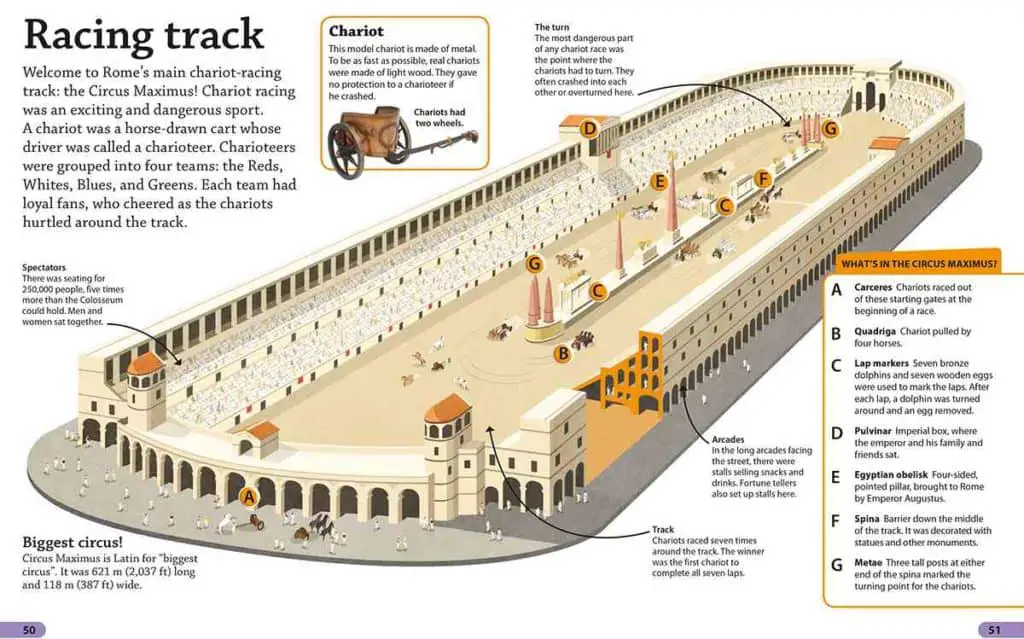
Other Attractions in Italy
- Visit the Roman Colosseum. Click on the Roman Colosseum attractions map HERE and accompanying Colosseum attractions guide HERE
- Take the Rome attractions map and self guided tour: It includes the Vatican City attractions map HERE and the Vatican attractions guide HERE
- Self Guided Walking tour to explore the neighborhood of Trastevere with map of attractions HERE and guide of attractions HERE
- Visit St Peters Basilica . Explore all the attractions in St Peter’s Basilica with the attractions guide HERE
- One of my favorite places is the Roman Forum and Palatine Hill . The map of attractions is HERE and the self guided walking tour is HERE
- Visit Pompeii with a complete self guided tour map HERE and the attractions guide to the 49 points of interest HERE
- Spend the day in Florence , this was by far one of my best day trips. The self guided walking tour map is HERE and the attractions guide is HERE
Related Posts

Flight delay compensation, claim up to €600 in cash
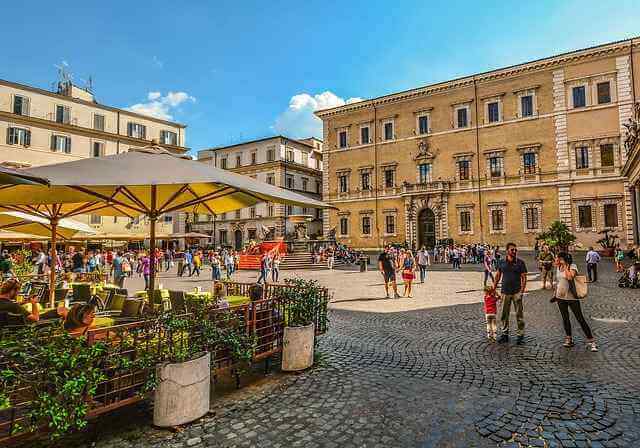
Delightful Trastevere, Self Guided Walking Tour of Trastevere Rome
- Skip to main content
- Skip to primary sidebar
- Skip to footer

Italy Travel Experts Tours and Vacations
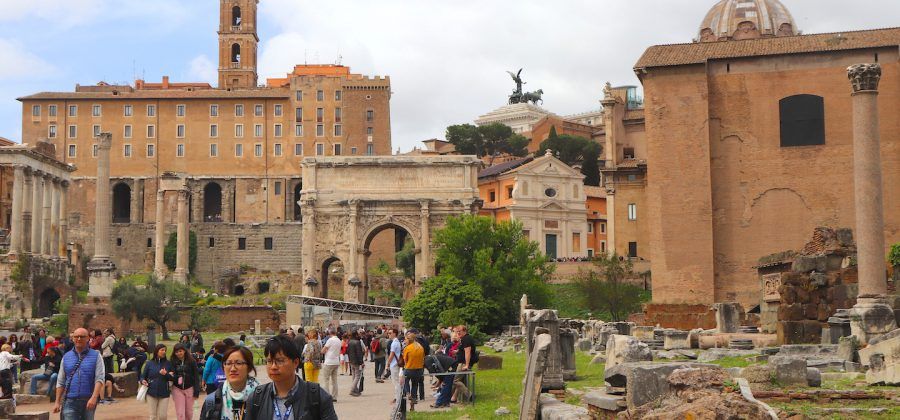
Top 13 Things To See in the Roman Forum
Mickey Iacono-Walsh Last Updated: November 17, 2022
Are you planning to explore the ancient city of Rome but not sure what to see in the Roman Forum? Written by a licensed guide of Rome, this series of articles covers all the things you should see in the Colosseum, Roman Forum, and Palatine Hill with explanations. Here’s what to look for as you explore the Roman Forum.
Pro Tip: Doing some research ahead of your trip to Rome? Bookmark this post on your internet browser. This way you can circle back to it when you’re exploring the Roman Forum. See our guide to Rome for more resources to help you plan your trip. Also, Check out our top-rated Colosseum tours , which include admission for the entire area, including Palatine Hill.
Things and Places To See in the Roman Forum
At this point, you’ll probably already have seen the Colosseum and Palatine Hill . We’ve created this list of must-see things at the Roman Forum to help guide you around this incredible archeological site. To start your journey through the Roman Forum, walk down toward the Arch of Titus.
13. Via Sacra
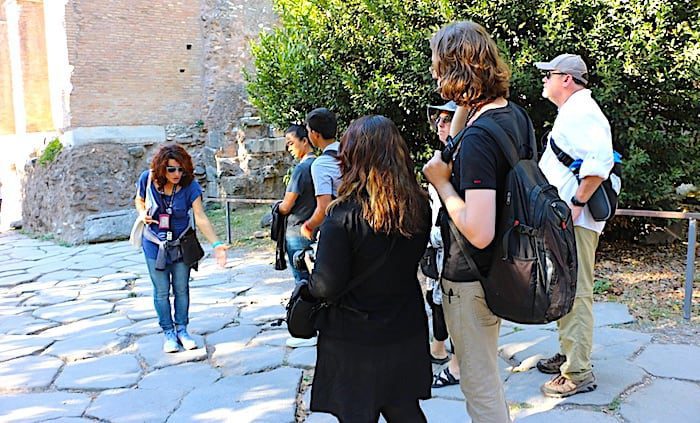
The road running through the arch is the Via Sacra or sacred way. It was an important road as you can guess by its name. In ancient Roman times, triumphant marches were held after big victories, which happened often. These marches would travel down the Via Sacra and into the city.
The road saw considerable improvements over time. The rows of colonnades, for example, and other effects to highlight its importance. The Arch of Titus, the next destination, is one of those improvements.
One of the coolest details of the Via Sacra is that you can still see the wear and tear from Roman times on the pavers. You’ll see everything from its smoothness to the crevices that wagon wheels created over time. This is definitely one of the top things to see at the Roman Forum.
Address : Via Sacra
12. Arch of Titus
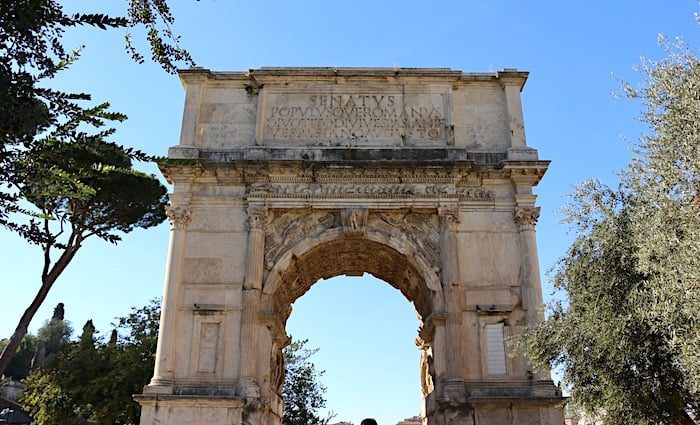
The Via Sacra extends into the Forum but not before passing through the Arch of Titus. Domitian built this arch to commemorate Titus’ famed victory that quelled the revolt in Jerusalem in which he brought 60,000 slaves and endless wealth back to Rome. As a result, they had the means to build the Colosseum.
The Arch of Titus is a considerable point of interest for many reasons. First is its position near the Colosseum on top of a hill. It is also one of only three arches that remain of the 36 original arches.
The arch gains significant interest from many people from Jerusalem or of Jewish descent because it details a major event in Jewish history. Rome controlled Judea at the time and they rebelled against the control. It had worked out pretty well for them a few hundred years earlier under the Maccabees so they gave it another shot.
Historians often refer to this war as the Great Revolt and it was exactly that. Eventually, the Romans succeeded in re-conquering Judea after breaking through three walls, which took seven months. It’s important to mention how the Romans treat war at this point.
If you tried to defend yourself but gave in fairly quickly and joined the Romans, then they treated you pretty well. It was a really good deal. They’d have wanted to take some spoils and possibly some wives, but losing would have been far worse. Victory against the Romans was also rare and often not long-lasting.
If you fought back too hard, on the other hand, you could expect far worse treatment. They’d sack your city, take everything you have, rape most of your population, and enslave as many people as they could transport back to Rome. That’s what happened in Judea. Over 60,000 slaves came back to Rome with Titus and, ultimately, built the Colosseum.
Beyond the horror story of the Roman war, the arch helps connect some historical dots. It verifies that Titus’ campaign happened and that he returned victoriously. Paper doesn’t hold up well over time, but stone does. Historians detailed most of this in writing as well as in detailed reliefs depicting the events.
Interior Decoration
On top of historical verification, the reliefs inside the arch show a huge leap forward in Roman artwork. You have to understand that at this point in history, A.D. 81, most people in Europe were living in cold wet huts fending for their lives. It was the Middle East that was prospering. The Gauls were trying to stay dry while the Romans were creating the illusion of space in travertine.
The illusion of space is when an artist uses your perspective against you to make an area look bigger and possibly even give the illusion of motion. Basically, it was baroque artwork 1,500 years before baroque artwork entered the scene. On the arch, you can see the procession of the Jews holding the menorah (seven candelabra) as they return to Rome as slaves.
On the other side, you see Titus on horseback triumphant over his enemies. In the center, look up and you’ll see the symbol of Rome, the Eagle, with wings spread. The arch is a must-see in the Roman Forum and Rome, in general.
Address : Arch of Titus
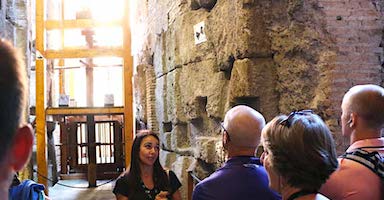
Best Seller
Colosseum Underground Tour with Roman Forum and Palatine Hill
This is our most popular Colosseum tour due to the incredible access to non-public areas like the underground chambers. All admissions are included and it is lead by an English speaking licensed guided and Colosseum expert.
Local Rome Food Tour in Trastevere Neighborhood
Are you looking for the best food tour in Rome? Embark on a Trastevere food tour that offers an excellent introduction to some of the best food in Rome. Led by a local foodie guide, visit some of our favorite restaurants and trattorie in Rome
Not ready to book a tour? Check out our Rome Guide for more info.
11. Temple of Venus
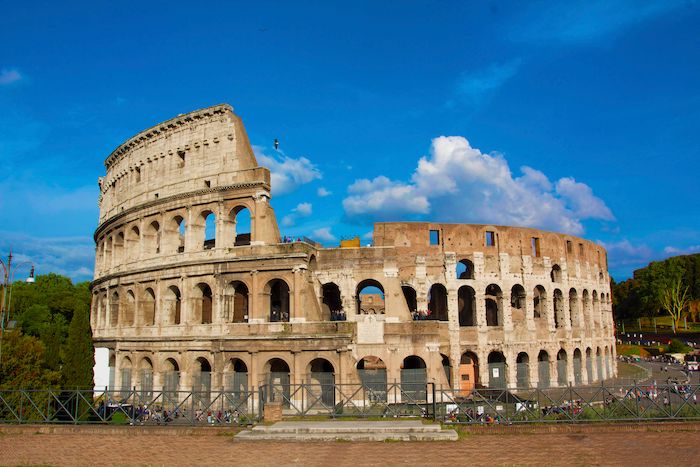
With the Arch of Titus at your back and the Colosseum to your front, you’ll see a structure to your left. Head to that building and work your way towards the Colosseum. There is a great balcony where you can take a picture like the one above. This is the Temple of Venus, a massive temple that Emperor Hadrian built.
Address : Temple of Venus
10. Basilica of Constantine (Temple of Maxentius)
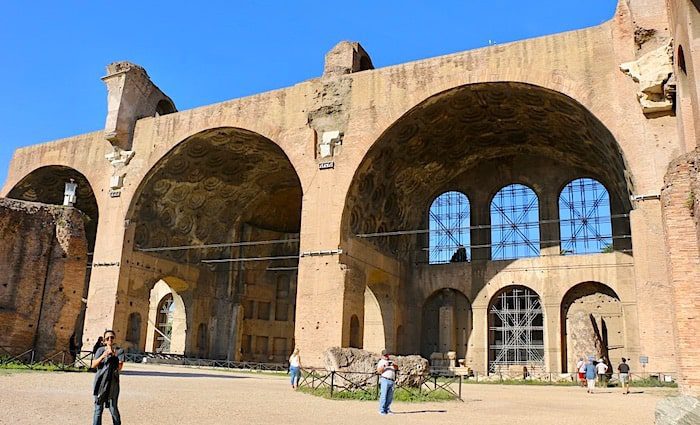
Originally the Basilica of Maxentius, this building was named for the emperor who ruled Rome before Constantine. The two of them fought a historic battle at the Milvian bridge, which is still standing today in the northern part of the city.
As the legend goes, Constantine saw a symbol burning across the sky on the eve of the battle. The next day, his soldiers drew the cross on their shields and they were successful. This victory was attributed the title of the first Christian victory ever.
The central nave of the building was an impressive 265 feet (80 meters) long and 83 feet (25 meters) wide. Today, only three arches can be seen. Originally, you can imagine there was a vaulted ceiling and another three arches symmetrically placed in front of the remaining three, creating an imposing, closed building. The entrance would have been at the southern end. At the northern end, there would have been a gigantic statue of Constantine himself.
In ancient Roman times, the word “basilica” signified a courthouse or a place to conduct business matters when the weather wasn’t permitting outside. The standard architecture consisted of a long nave, with apses on both sides, supported by huge columns. When Christianity became the main religion, they incorporated this architectural style into their churches and that’s where we get the modern meaning of the term “basilica” today.
Address : Basilica of Constantine
9. Temple of Romulus
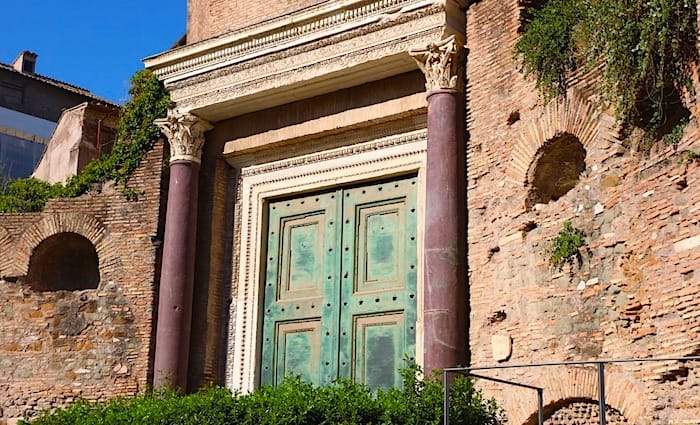
Don’t mistake this with the Romulus who founded Rome. The emperor Maxentius dedicated this temple to his son Valerius Romulus and deified him. Eventually, the emperors prohibited paganism and converted this temple into the Basilica of Santi Cosma e Damiano.
The bronze doors are original from the A.D. 309 structure. Such an old building still in such good shape deserves to be one of the top things to see at the Roman Forum.
Address : Temple of Romulus
8. Temple of Antoninus and Faustina
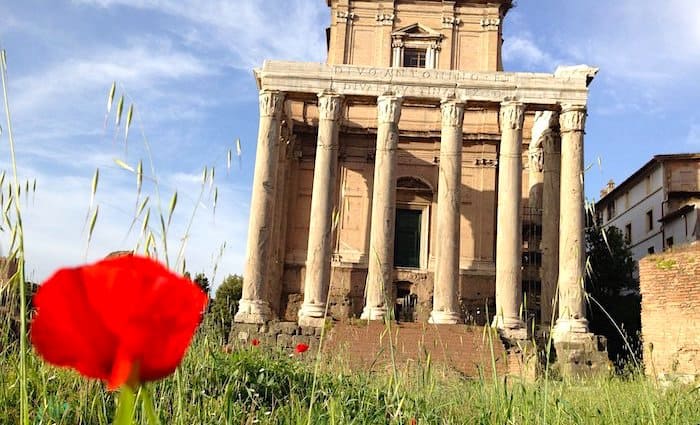
Known today as the Church of San Lorenzo in Miranda, this functioning church is adapted from the ancient Temple of Antoninus and Faustina. Though much of the structure is updated and rebuilt, the original portico encased by marble columns still stands.
Like many churches around Rome, they remodeled this church and built it upon its original structure. As with much of Rome, the various levels of the church reflect modern and ancient Rome. Another great example of this is the Basilica of San Clemente located on the other side of the Colosseum and just a 10-minute walk from the Forum.
Historians consider Antoninus Pius to be one of the five “Good Emperors”. This means that he died of natural causes and didn’t fill the tabloids of the time with crazy deeds. He was quite old already when he became emperor and lived a decent life out of the spotlight. His extremely beautiful wife, Faustina, died quite young. The emperor was so stricken with grief that he made her a goddess and built her a temple. This is a must-see at the Roman Forum for romantics.
Address : Temple of Antoninus and Faustina
7. Temple of Vesta and Eternal Flame of Rome
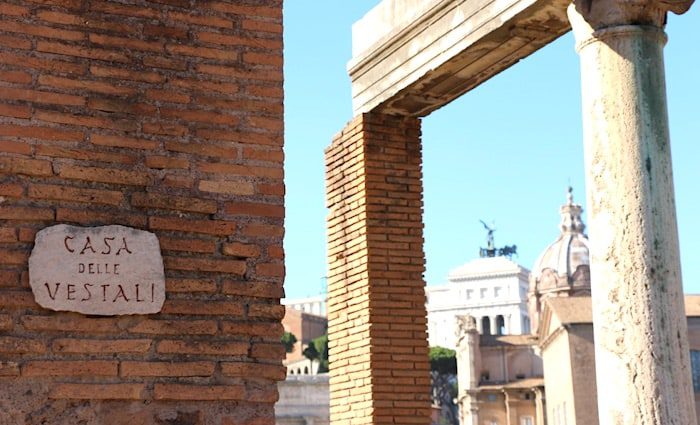
Facing the Temple of Antoninus and Faustina, turn around and you’ll see a circular altar in a shaded area on a slight hill. This is where the vestal virgins cared for the famed Eternal Flame of Rome. Originally surrounded by 20 Corinthian columns, the ruins are a good indication of what the temple may once have looked like.
Today, what remains of the temple is what Mussolini reconstructed in the 1930s after the Forum was excavated. Behind the temple, the House of the Vestal Virgins stands and leads its way up the Palatine hill. Vital to the faith of pre-Christianity Rome, the vestal virgins were priestesses who took a vow of virginity and served for 30 years, beginning in childhood.
Powerful women indeed, the vestal virgins had the power to free slaves and prisoners. Additionally, injuring one of them was punishable by death. The vestals also protected the eternal fire to Vesta, the Roman Goddess of Hearth.
As sacred as the temple was, Roman residents used Vesta’s eternal fire to kindle their own household fires. And that is why this is one of the top things to see at the Roman Forum.
Address : Temple of Vesta
6. Mamertine Prison
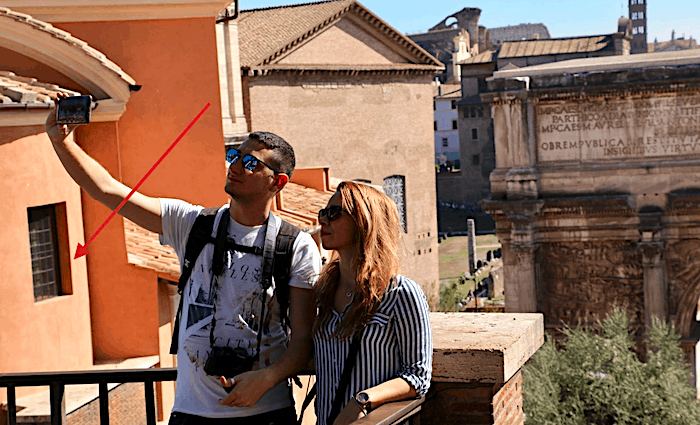
Just outside the northern-facing exit of the Forum, you’ll find the Mamertine Prison. It’s not actually inside the structure, so make sure you’re ready to leave as you won’t be allowed reentry. The prison is said to have been built as early as the 7th century B.C. and was originally referred to as the Tullianum .
According to Christian dogma, St. Peter was imprisoned here prior to his execution on the cross upside down. The prison was not intended for long-term incarceration. It was merely a place to be held prior to a trial and, eventually, execution. Its proximity to the Forum and Capitoline Hill made it accessible.
Peter was not the only prisoner of note to be held here. Jugurtha, king of Numidia, was held in the Mamertine Prison for a short stay and possibly died inside. Vercingetorix, the Gaul chieftain and nemesis of Julius Caesar who attempted unsuccessfully to unite Gaul against the Romans, also died here.
Most generals and high-profile leaders were pardoned after war with the Romans. This was part of their process of getting nations to capitulate. There were some cases of extreme hatred where Romans would be more demeaning to high-ranking opponents. The Mamertine Prison was a foul enough place to seek that revenge. Also, if you wanted to display your human spoils of war, the Palatine Hill was just a short walk away.
Address : Mamertine Prison
5. Temple of Castor and Pollux
Today, the three columns left on this temple are not much to look at, but the remains are spread around the city. The statues of these two dioscuri or demigods sit on either side of the steps leading up to the Capitoline Hill in all their glory.
They are the twin sons of Jupiter (Zeus) by a mortal mother. Hence making them demigods. They are known for their curly blond hair and white horses. Since they are strong young warriors, they were the perfect pair to be patrons to the equites or Roman knights.
Witnesses saw them aiding the Romans against the Latins at the Battle of Lake Regillus in 484 B.C. Later, they were seen in the city of Rome watering their horses at the Juturna Spring. The origin of their temple is where that spring once was but it has been enhanced and renovated multiple times.
The twins represented much of what it meant to be Roman. They were loyal to one another and fought bravely. Romans, like Christians, often chose figures that mirrored their morals and virtues.
Address : Temple of Castor and Pollux
4. Arch of Septimius Severus
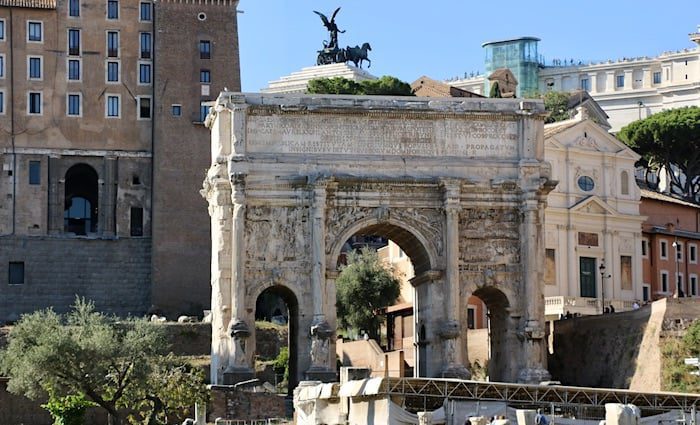
Built in A.D. 203, the Arch of Septimius Severus is one of the biggest arches in Rome. It stands as a testament to Roman hegemony in the ancient world. At this time, the Roman Empire had come to the end of its golden years and would begin to slowly deteriorate from here. Although, they didn’t know it then. For the majority of the Roman world, the Eternal City would last forever.
Emperor Septimius Severus had this arch constructed to commemorate his victory over the Parthians (modern-day Iran). The victory was bittersweet since that region had defeated a Roman army almost 300 years earlier under the leadership of Marcus Crassus. During that defeat, Crassus paid dearly with his life. He was captured and molten gold was poured down his throat to show his greed.
The richly decorated arch was also dedicated to Severus’ two sons Caracalla (who later became emperor himself) and Geta. When Septimius died, Caracalla killed his brother Geta to become the sole ruler. All monuments to Geta and any mentions of him were erased from the history books, including on the arch itself.
Address : Arch of Septimius Severus
3. Temple of Saturn
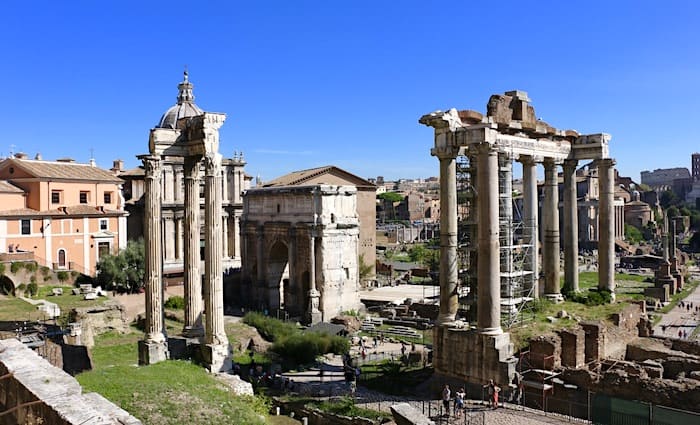
The current temple dates from the 4th century A.D. We know this because of the inscription on the architrave, which states that the Senate had rebuilt this statue after a big fire. The original temple on this same spot was built in 497 B.C.
Today, all that remains is the podium on which the temple stood and eight huge columns of granite and marble. You’ll have to use your imagination, but you can see this temple was once a great and revered place of worship.
The Roman god Saturn supposedly has his roots in the ancient Greek pantheon as the god Kronos. There’s some mystery surrounding what he was actually worshipped for, however, he was represented veiled with a sickle or pruning knife. The practical function of the temple was as the public treasury, which lasted all throughout the Republican period and, on a more limited basis, during the Empire.
The most famous event associated with the god Saturn is the major festival that took place on December 17th, the Saturnalia. This was a huge party lasting for a few days and where roles were switched. Masters waited on the slaves, gifts were exchanged, and more informal clothes were worn instead of the rigid toga. Over time, this festival is how Christmas was transformed into what it is today.
Address : Temple of Saturn
2. Temple of Julius Caesar
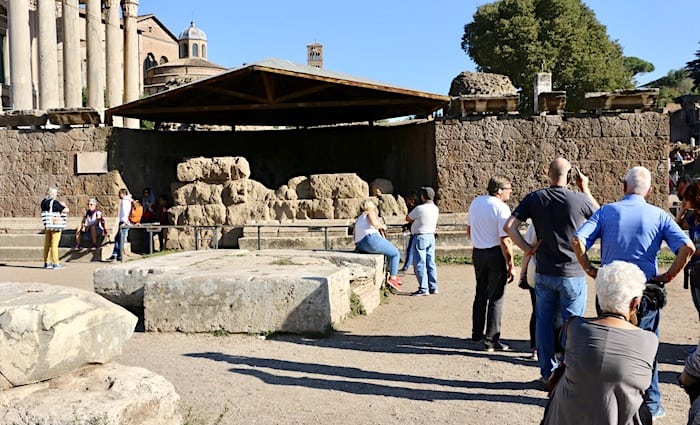
Across from the Temple of Vesta is the Temple of Caesar. In its heyday, this was the centerpiece of the Roman Forum. Dedicated to Julius Caesar and constructed by his adopted son Augustus, Julius Caesar was the first Roman deified after his death and the first to be buried in the Forum itself. For hygienic reasons, nobody could be buried within the city limits at the time, so this was a great honor.
Julius Caesar wasn’t actually considered an emperor. That honor is bestowed on Augustus. What all historians agree on, however, is that his actions led to the downfall of the Republic, which had seriously deteriorated by this point anyway. Once he was declared dictator for life, many aristocratic noblemen feared that he would try and become king. So, he was assassinated. The upheaval that followed led to the creation of the Empire.
A symbol of the Roman Empire’s power, the Temple represented the potency of the new Roman Empire and the grandeur of both Julius and Augustus. The temple is considered to be a political move by many people who were allegedly involved in the murder of Caesar. They supported the project to posture themselves as Caesar-supporters to the masses.
Address : Temple of Julius Caesar
1. The Curia (Senate House)
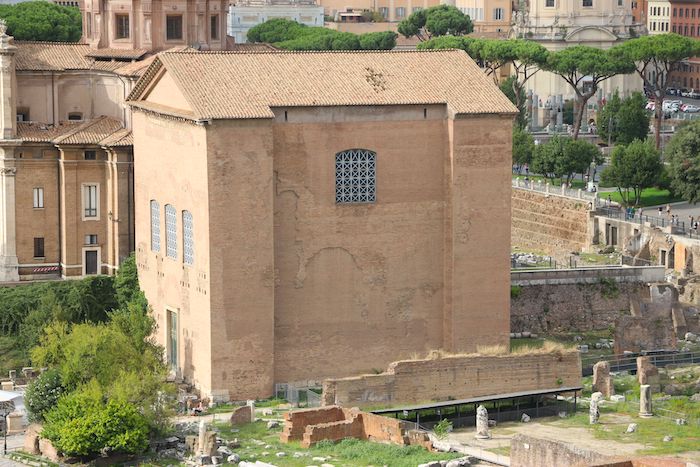
The Curia Julia or Julian Senate House is one of the most intact buildings in the Roman Forum. Unlike most others, the Curia Julia is visible in its restored state. This is due to its conversion into a church centuries later. Still, this large building was the home of the Roman Senate throughout the time of the Empire.
Many people visit thinking this was the spot where Julius Caesar was killed, but don’t be fooled! This Curia was under construction when Julius Caesar was assassinated in 44 B.C. at the Theatre of Pompey (near Largo Argentina in today’s Rome). The roof of this building collapsed in August of 2018 and luckily no one was harmed. Such a historic building is definitely one of the top things to see at the Roman Forum.
Address : The Curia

Where To Stay in Rome
Rome has a rich cultural history and many iconic landmarks to explore. Plan where to stay in the magnificent Eternal City in the best neighborhoods.
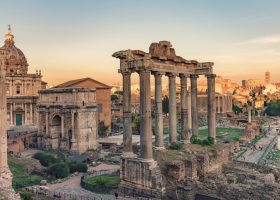
Reader Interactions
Leave a comment cancel reply.
Your email address will not be published. Required fields are marked *
- In The Press
POLICY & TERMS
- Cancellation Policy
- Terms & Conditions
- Privacy Policy
Italy Trip Planning
Italy Travel Tips
North Italy Guides
South Italy Guides
Your complete guide to visiting the Roman Forum + FAQ

Last Updated on December 11, 2023 by Ingrid & Alex
No matter how long you are spending in Rome, if you are here for the first time, visiting the Roman Forum should definitely be on your bucket list . Set right next to the famous Colosseum , the Forum used to be the heart of the city and can tell you the whole story of Ancient Rome.
In today’s post, you will not only find lots of practical information, but we will also cover a short history for each and every one of the buildings you will get to see on your tour.
Because at the end of the day, they all tell a story waiting to be heard.
This post contains affiliate links. This means if you click on the link and purchase the item, I will receive an affiliate commission at no additional cost to you. Read more about it on our disclosure page here .

Table of Contents
Your complete guide to visiting the Roman Forum
What is the roman forum.
As a modern-day visitor of Rome, you’ll soon realize that many places are called a “forum.” So the first thing you might ask yourself is, which exactly is the “ Roman Forum “? Why is this place so special? The short answer: because it is the most glorious meeting place in human history.
Political elections, public speeches, criminal trials, triumphal processions, gladiatorial matches, business negotiations…everything happened in the Forum! The Roman Forum was the heart of Rome, while Rome became the capital of the Mediterranean world (or THE WORLD, as they called it)!
To use a modern U.S. analogy, it was as if the White House, the Congress, the Supreme Court, Wall Street, Hollywood, and Silicon Valley would all set up shop in a tiny square in the center of Washington, D.C, in view of all the citizens gathered there.
Think of this when you visit the place: you are following in the footsteps of some of the most iconic people in the history of mankind. Mass murderers and Christian saints, famous orators and infamous demagogues, great philosophers and delirious madmen, business magnates and unscrupulous charlatans, all of them operated in the Forum Romanum during their days.
But how did this piece of land become the center of human civilization?
A short history of the Roman Forum : Roman Forum Facts
When was the roman forum built.
Picture a landscape of wooded hills skirted by the river Tiber some seven hundred and fifty years before Christ was born. The twins Romulus and Remus just founded a small settlement on one of the hills. But the inhabitants of the new “city” of Rome had a rather important problem: there were no women among them.
Long story short, using deception, the Romans kidnapped the sisters, daughters, mothers, and wives of a neighboring tribe called the Sabines. Understandably, the Sabine men were not happy, so they stormed Romulus’ settlement. It fell on the Sabine woman to find a solution and stop the bloodshed; they came out imploring their men to make peace with their captors and live in harmony within one kingdom. Thus, the Roman Kingdom was born, co-ruled by Romulus of the Romans and the Sabine leader, Titus Tatius.
It was not much of a kingdom, to begin with. Basically, it was a pair of hilltop villages separated by grassy wetland: one on the Palatine hill and the other on the Capitoline.
To encourage friendly relations, the two people decided to drain the marsh separating them. They built the Cloaca Maxima, a covered sewage system, clearing away the water. The newly reclaimed land was used as a meeting place for trade, political debate, trials, and mass entertainment. Ecce Forum Romanum! Behold the Roman Forum!

Who built the Roman Forum?
No single person or group of people built it. Instead, the place developed organically during its one thousand and two hundred years of active existence. New buildings were erected, while some of the older ones were periodically renovated and rebuilt. Just take a break and contemplate this for a moment: the place was continuously used for 1200 years while the oldest structure still in use in North America was built less than 400 years ago.
The Forum’s travertine paving, still visible today, dates from the reign of the first Roman Emperor, Octavian Augustus (27 B.C – 14 A.D.). However, some of the buildings are much older, dating from the early days of Rome (VII. century B.C.); others were erected as late as the IV. century A.D.
So what exactly can a modern visitor see today?
Roman Forum Buildings – what to see inside the Roman Forum
Most tourists approach the Forum after they visit the Colosseum, so I will follow this route in our virtual tour; we will travel along the Via Sacra , or Sacred Avenue, leading from the Colosseum to the east up to the Capitoline hill to the west.
It was customary to build triumphal arches celebrating major military victories – the triumphant general and his soldiers were permitted to march through the arch in the ovation of the gathered citizens. There are no fewer than three of these monuments in the area of the Forum; the first one you’ll encounter is the one bearing the name of Constantine the Great.

The Arch of Constantine is the largest triumphal arch built in Rome, and it’s symbolic of probably one of the most consequential events in human history, one that shapes the world to this day.
It was erected by order of the Senate on the Via Triumphalis , the Avenue of Victory, to celebrate Constantine’s triumph over Maxentius in 312 A.D. and the ascent of Rome’s first Christian Emperor. If Constantine had lost that key battle, probably Christianity would never have become the dominant religion of the Western World.
Interestingly, although the structure was finalized in 315 A.D., most of the statues decorating it were “re-used” from much earlier monuments dedicated to Emperors Trajan, Hadrian, and Marcus Aurelius.
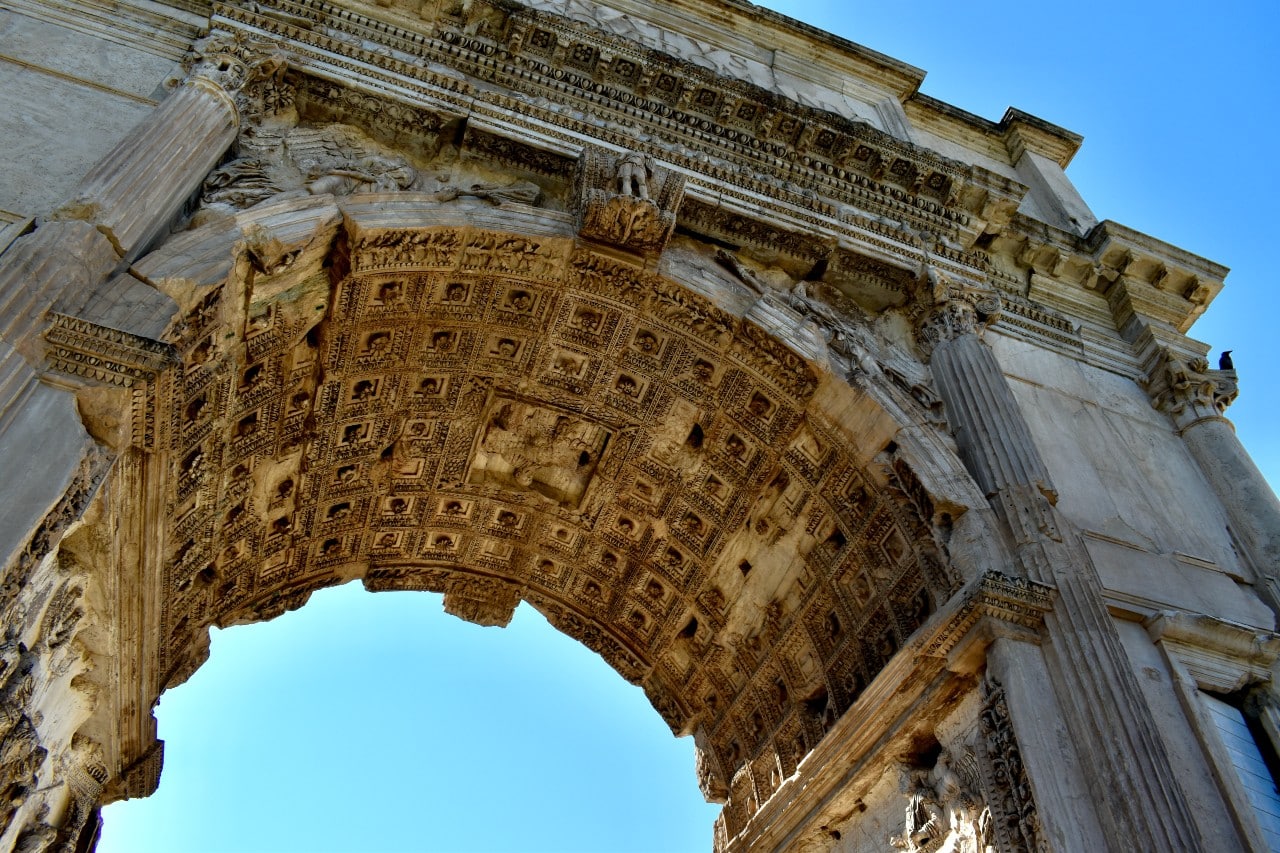
The next monument you will encounter is the Arch of Titus; it has a powerful religious symbolism for the Jewish community, the same as the Arch of Constantine has for the Christians.
Emperor Domitian erected the building to celebrate his father’s (Emperor Vespasian) and his brother’s (Emperor Titus) victory over the Jews in 70 A.D. The Jewish revolt ended in a massacre, Titus’ legions sacking Jerusalem and destroying the Second Temple, the holiest place of Judaism. The arch depicts several artifacts looted from the Temple, including the Menorah; its representation on the arch served as a model for the menorah used on the emblem of the State of Israel.
Let’s pause here for a moment to “look around.”
On your left, while facing the Arch of Titus, you’ll see the Palatine hill, the place of the original settlement founded by Romulus and Remus. The area was a wealthy neighborhood during Republican times, and later it became the residence of Emperors, several palaces being built by them. The very word “palace” has its roots in the name of the Palatine hill.
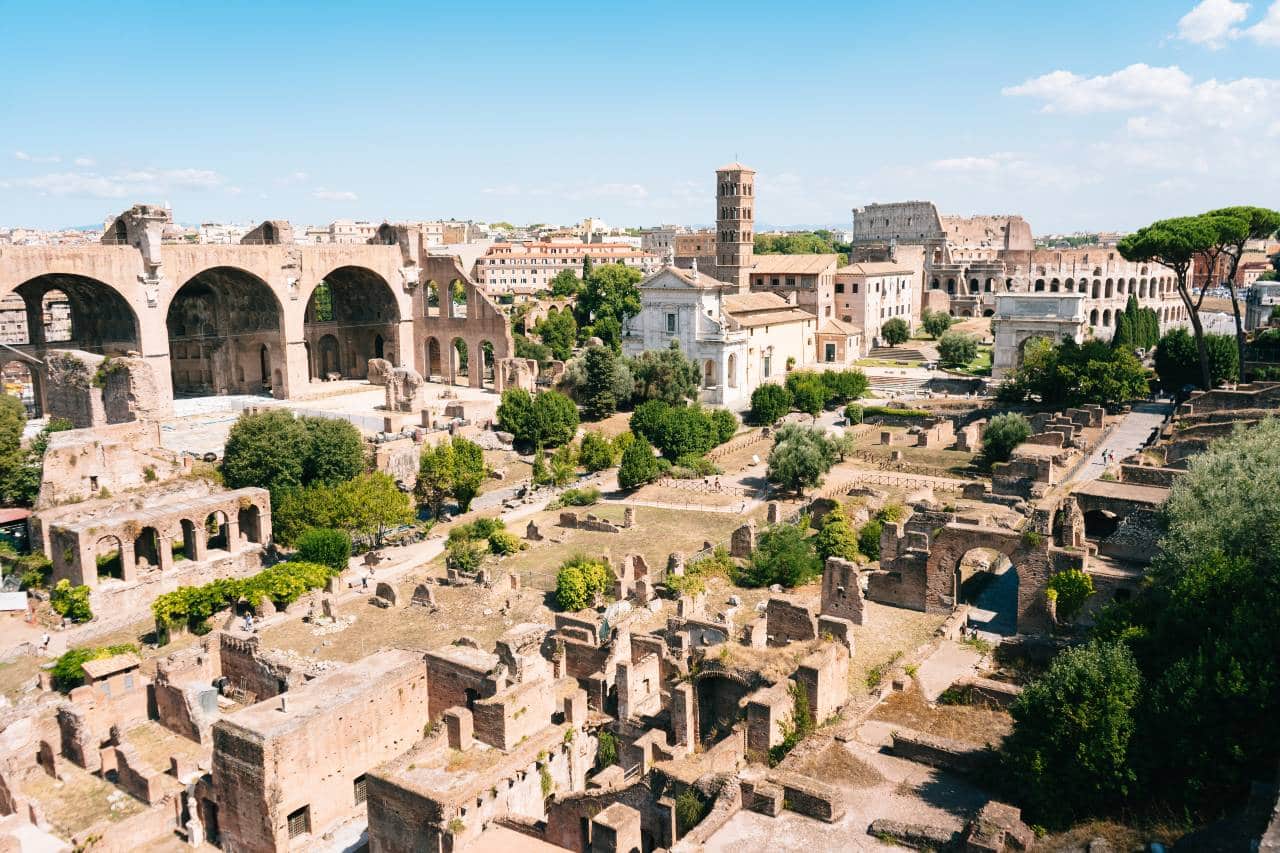
On your immediate right, you’ll see the Temple of Venus and Roma , one of the largest temples of the Classical World. It was built on the orders of Emperor Hadrian (117 A.D. – 138 A.D.), the finishing touches done by his successor, Emperor Antoninus Pius (138 A.D. – 161 A.D.).
The temple was restored by Emperor Maxentius (306 A.D. – 312 A.D.) after a fire destroyed it. Although he is remembered as Saint Constantine’s arch-enemy (see above), to Maxentius goes the honor of erecting the last major building in the millennium-long history of the Roman Forum: the Basilica bearing his name.
Built next to the Temple of Venus and Roma in 312 A.D., the Basilica of Maxentius is the largest building in the Forum. Roman basilicas had various functions; they acted as council chambers, courtrooms, and meeting halls for official gatherings. They also served as models for the future Christian places of worship, Saint Peter’s Basilica from the Vatican being just one example.

Let’s continue our journey down Sacred Avenue and approach the Temple of Vesta and the House of the Vestal Virgins. It is probably the oldest building complex in the Forum, its history going back seven hundred years before the birth of Christ to the days of the early Roman Kingdom.
The Vestals were a group of virgin priestesses serving the goddess of the hearth called Vesta. The number of Vestal Virgins grew from two during the time of King Numa Pompilius to six. The future Vestals were selected by lots from prepubescent girls volunteered by their free-born Roman citizen parents. It was a great honor to be chosen as Vestal Virgin; however, it came with a steep price.
The priestesses committed to thirty years of celibacy under the pain of death. As soon as they were selected, they had to leave their parents’ house and move to the House of the Vestals, where they would reside for the period of their service. The main duty of the Vestals was to tend the sacred fire in the Temple; the Romans believed that the city’s fortunes were linked to the fire – if it would ever go out, disaster would befall Rome.
Can you imagine tending the same fire for thirty years while living in isolation without any romantic involvement? And I haven’t even mentioned the punishment for breaking your vows: to be buried alive and left to rot. Yet, here you were, thinking your job sucks.

Just north of the ruins of the Temple of Vesta, you’ll see the Temple of Romulus. The building symbolizes how the new Christian world overtook the ancient Classical one.
Initially dedicated by Emperor Maxentius as a Temple to his deceased son, Valerius Romulus, it was transformed into a Christian church in 527 A.D. by orders of the “barbarian” king, Theodoric the Great of the Ostrogoths. To this day, the basilica of Santi Cosmo e Damiano functions in this building.

Further down the Via Sacra, you’ll encounter the Temple of Antoninus and Faustina, which guards the entrance of the actual Forum. It was erected by “the Fourth Good Emperor,” Antoninus Pius, in memory of his deceased wife Faustina – as such, it is the first monument in the Forum dedicated to an Empress.
Later, the building was transformed into a Christian church dedicated to Saint Lawrence as he was sentenced to martyrdom in this place.
Next, you’ll encounter the Temple of Divus Julius, also called the Temple of Caesar. I personally find this building extremely intriguing, not only for its architecture but for what it stands for.
Even by Roman standards, Julius Caesar was a genocidal mass murderer, a populist demagogue turned into a power-hungry tyrant and an unashamed adulterer. Still, after his adopted son Octavian consolidated his power as the First Roman Emperor, he deified his adoptive father and erected a temple in his honor in the middle of the Forum.
So, this temple is a monument to propaganda, if you will; a reminder that history was always “written” (and re-written) by the victors.

Immediately to the south, one can see the ruins of the Temple of Castor and Pollux. The original building was raised to celebrate a major victory of the early Republic.
In 509 B.C., two hundred and forty-four years after the founding of the city, a popular revolt led by Lucius Junius Brutus overthrew the last king of Rome, one Tarquinius Superbus (the Proud). Unwilling to accept defeat, Tarquinius plotted his return, gathering allies in the process. Eventually, his Latin League declared war on the fledgling Roman Republic, confident in an easy victory.
However, the Romans organized themselves under their temporary dictator, Postumius Albus, and defeated Tarquinius at the Battle of Lake Regius in 496 B.C. According to the legend, the twin sons of Jupiter (Zeus in Greek), Castor and Pollux, fought beside the Romans; in their honor, Albus’ son built the Temple bearing their names in 484 B.C.
To the north of the Temple of Caesar, you’ll see the ruins of Basilica Aemilia . The initial building served as the butchers’ shop, but it was replaced by the bankers’ offices in the IV. century B.C.; in a way, it was the Wall Street of Ancient Rome. Since then, it was repeatedly redesigned and rebuilt under different names: Fulvia, Aemilia, Paulii.
The building survived the Empire by four hundred years but was eventually destroyed in 847 A.D. by an earthquake. Its remains were later excavated, and the stones and marble was used to build medieval edifices, the Pallazo Giraud Torlonia among them.
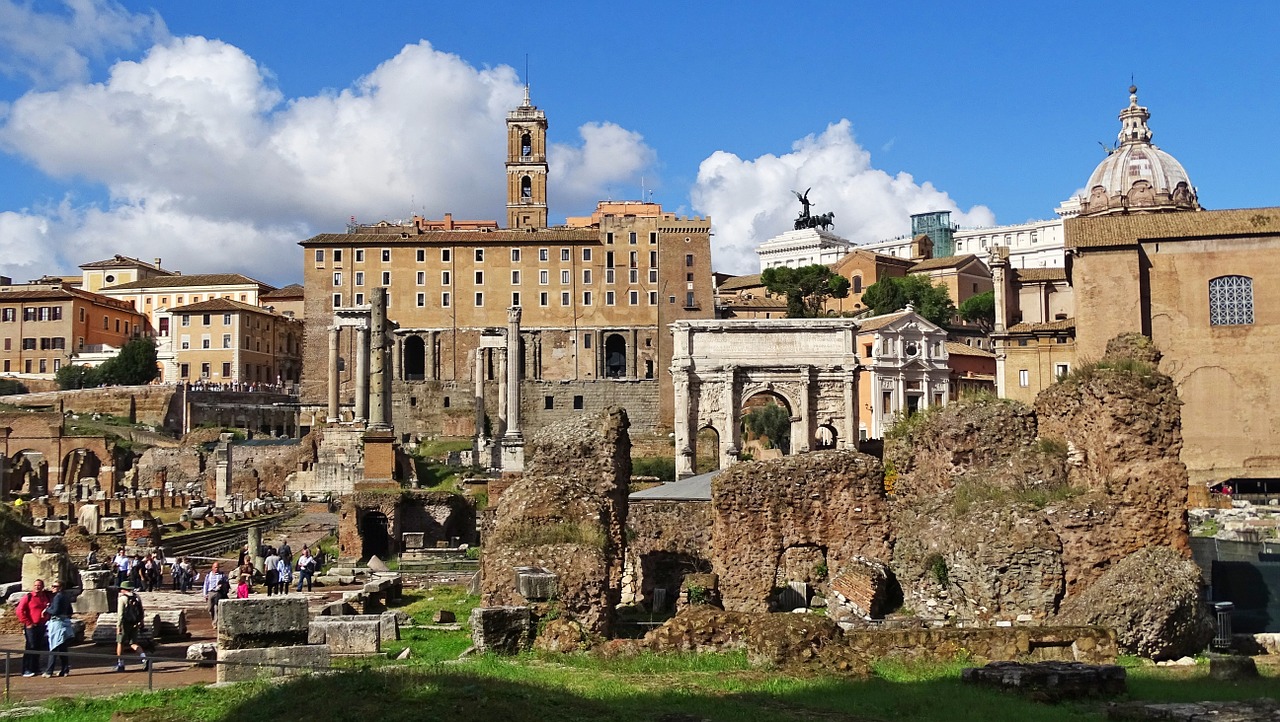
Finally, you have arrived at the actual Piazza of the Forum , the place where everything began. As explained above, the Forum was initially designed as a marketplace and meeting place. The piazza retained this function over the centuries.
On the western side of it was the Rostra , the stage from which politicians and generals, demagogues and orators, addressed the citizens. Its name comes from the warship rams (rostra) captured during the epic battle of the Latin War, the Battle of Antium (338 B.C.).
The Roman victory was extremely important for it extended Rome’s overlordship over its neighbors, the Latins, and brought it closer to the unification of the Italian peninsula. To celebrate the triumph at Antium, the Romans mounted the captured rams of the enemy warships as trophies on the speaker’s platform in the Forum, hence the name Rostra.

In front of the Rostra, Emperor Septimius Severus erected the Arch of Septimius in 203 A.D., celebrating his victories over the Parthians. The rise and reign of Emperor Septimius Severus provide the backdrop of my book series, Agent Strabo’s Ancient Mysteries , as my well-informed readers surely remember.
Behind the Rostra, the modern visitor can see the well-preserved building of the Tabularium. Erected in 98 B.C. by the dictator Sulla, the Tabularium stands on the front slope of the Capitoline hill and below what was the Temple of Jupiter Optimus Maximus (Jupiter the Best and Greatest – father of the gods, the Roman iteration of the Greek Zeus).
Although there is an ongoing debate in academic circles regarding its function, it is believed that the Tabularium housed the Roman records office. Alas, we have the Romans to thank for the government keeping records of everything we do: contracts, inheritance, tax receipts….

Next to the Rostra, one can see one of the most iconic buildings of the modern archeological site: the Temple of Saturn . It stands at the foot of the Capitoline hill, and although its construction began under the last king, the building was finalized in 497 B.C., making it the first Temple of the Republican era. The currently visible ruins date from a later reconstruction of the temple in 360 A.D.
On the northern side of the Piazza, you can see the Curia Julia, the meeting place of the Senate of Rome since the times of Julius Caesar. He built it in 44 B.C. to replace the previous Curia Cornelia, which in turn replaced the initial Curia Hostilia. It was the equivalent of the U.S. Congress building at Capitol Hill, Washington D.C., with the mention that the Consuls (i.e., the President) were presiding the Senate, hence the Curia Julia was Congress and White House combined. The decisions taken in this building shook the world more than once.
To avoid any confusion: although the Capitol Hill of the U.S. is called after the Capitoline Hill, beginning on the western side of the Roman Forum just behind the Temple of Saturn, the Roman Capitoline hosted the religious center of Rome, not the political one. The Senate met in the Forum while the later Emperors resided on the Palatine hill, just south of the Forum complex (see above).
On the southern side of the Piazza, opposite the Curia Julia, you can see the remains of the Julia Basilica. As its names hints, the latest redesign was done by Julius Caesar in 54 B.C. and later reconstructed by Emperors Octavian August (in 12 A.D.), Septimius Severus (in 199 A.D.), and Diocletianus (in 283 A.D.). However, before Caesar demolished it to make room for his own basilica, the Basilica Sempronia stood in its place (built 169 B.C), which in turn was built over the house of the Roman hero and legendary general Scipio Africanus.
The main function of the Julia Basilica was to house the civil law courts; in a way, it was the Supreme Court of Rome. The impressive building also housed several governmental offices and even some taberanae (a kind of ancient fast food store); even judges and civil servants needed to eat.
I haven’t mentioned other ruins and monuments in and around the Forum Romanum, but I wouldn’t like to overwhelm you with even more information.
During your visit, I would like you to remember that the place is more than just a hodge-podge of old rocks. Put yourself in the shoes of a visitor from the future walking down the ruins of Washington D.C. or New York because this is exactly what you are from a Roman perspective: a visitor from the distant future walking down the epicenter of the Roman civilization.
You are stepping on the same stones as millions of Romans did, from humble plebs to all-powerful Emperors.
In and around a tiny rectangle of 420 by 160 feet, you can absorb the very essence of the Roman world: you are standing at its political, religious, cultural, entertainment, and economic center. If the Greeks initiated the Western Civilization, the Romans carried it to term. In many ways, the Roman Forum is the birthplace of the Euro – American civilization of today.
And you are standing right in the middle of it.
Where is the Roman Forum located and how to get there?
Located in the heart of Rome, steps away from the Colosseum, you can find the Roman Forum at Via della Salara Vecchia, 5/6, 00186 Roma RM, Italy.
The easiest way to get there is by subway or bus – get off at the Colosseo stop.
A hop on hop off bus will also leave you in front of the Colosseum and is worth taking when you want to see as much as possible in a short time, without having to worry about means of transportation, tickets, and other similar things. Get your ticket here!
Distance from other main attractions in Rome :
2 minutes away from the Colosseum
30 minutes away from the Vatican City by public transportation (Cipro or Valle Aurelia on the orange subway line)
20 minutes walk from Fontana di Trevi, the Pantheon or Piazza Navona
35 minutes walk from Piazza del Popolo
Opening Hours for visiting the Roman Forum
The Roman Forum is open daily from 8:30 AM to 7 PM.
However, you won’t be able to visit on the 25th of December and the 1st of January.
Ticket prices for visiting the Roman Forum
The prices for a ticket are as follows:
12 EUR for adults
7,50 EUR for EU-citizens aged 18 to 25 years
free entrance for teenagers under 18 and disabled persons, as well as their assistants
A great option that could include the ticket for visiting the Roman Forum is the Roma Pass . It includes unlimited public transportation and on top of that, the pass offers free access to two venues of your choice (one when you choose the 48-hour option), making it a cost-efficient option to look at. Get your pass here!
The Vatican & Rome City Pass is another option for when you are spending more time in Rome and wish to see as much as possible. This one has a higher price tag but you will get unlimited public transportation, along with skip the line with free admission to the Colosseum AND the Roman Forum, the Vatican Museums, and Michelangelo’s miraculous ceiling at the Sistine Chapel. Get the pass here!
Tours of the Roman Forum
If you don’t know what tour to choose, but you want to have a guide tell you all you need to know about the Roman Forum, here are 2 great options:
3-hour Guided Tour to the Colosseum and the Roman Forum
Colosseum, Roman Forum, Palatine Hill & Mamertine Prison Guided Tour
Where to stay close to the Roman Forum
Staying anywhere close to the Colosseum will place you in close vicinity to the Roman Forum as well. So why not choose a room with a view if you can?
Here are 3 options to consider:
Palm Suites – Small Luxury Hotels of the World – stunning interior design, city views, walking distance from both the Colosseum and the Roman Forum, the hotel has also a charming interior garden where you can enjoy your breakfast. See availability here!
47Luxury Suites – Colosseo is a deluxe apartment perfect for larger groups since it can accommodate up to 8 people. The view you get from here is incredible and you will want to book it today! Check it out here!
B&B First Floor – you couldn’t ask for a better location than this, directly next to the Colosseum. Rooms have a coffee machine and a great modern design. See more here!
Other Rome travel resources
One day in Rome itinerary
Visiting the Colosseum – a complete and easy guide: tips, tricks + FAQ
Rome and Amalfi Coast itinerary – a perfect 10 day itinerary
Your perfect 2 days in Rome itinerary
PIN FOR LATER!
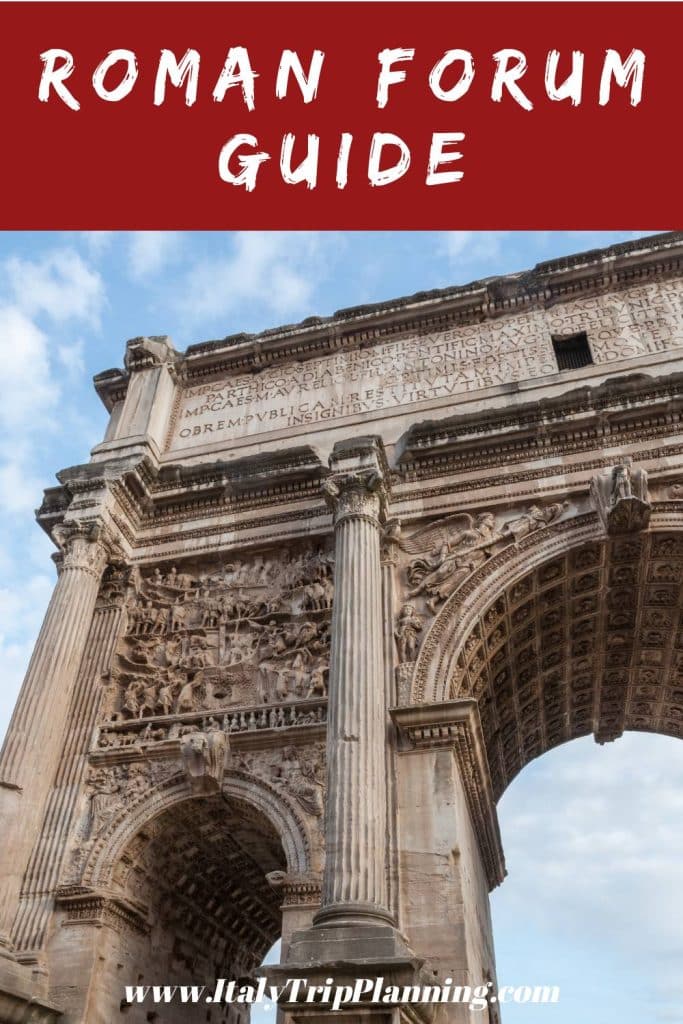
4 responses to “Your complete guide to visiting the Roman Forum + FAQ”
[…] Link together the Colosseum with the Roman Forum. […]
[…] is complete without seeing its famous attractions, from the Colosseum to the Spanish Steps and the Roman Forum. Stop by the Vatican City and treat yourself to a generous serving of […]
[…] my comprehensive guide for visiting the Roman Forum or the […]
[…] Read also: Your complete guide to visiting the Roman Forum + FAQ […]
Leave a Reply Cancel reply
You must be logged in to post a comment.

- Nov 15, 2023
- 12 min read
A Guide to the Roman Forum: Everything You Need to Know
Updated: Feb 25
Table of Contents:
Introduction, what is the roman forum, history of the roman forum.
Facts about the Roman Forum
Visiting the Roman Forum
Roman forum & colosseum tickets, what to see at the roman forum, insider tips for visiting the roman forum, in conclusion, rome city tours.

Once the center of public and political life in Ancient Rome, the Roman Forum remains the most impressive archaeological site in the Eternal City, captivating over 4.5 million visitors annually. Nestled near the Colosseum and Palatine Hill in Rome's historic heart, the Forum presents a vast expanse of ancient ruins, a testament to its illustrious past.
Key highlights include the Temple of Saturn, renowned for its eight imposing columns and rich history dating back to the late 5th century BC. The Arch of Titus, another monumental structure, stands as a symbol of Roman triumph and victory, particularly over the Jews in the Siege of Jerusalem.
Adjacent to these relics is the House of the Vestals, home to the Vestal Virgins, priestesses of the goddess Vesta, vital to Roman religion and culture. Their role in maintaining the sacred fire and performing various rituals underscored their importance in Roman society.

Both the Palatine and Capitoline Hills offer breathtaking vistas of the Roman Forum. However, to fully grasp its historical and cultural significance, one must traverse the archaeological site, wandering amidst the ruins. Walking along the Via Sacra, the main street of ancient Rome, evokes a profound connection to the past. Here, one stands at the epicenter of ancient Rome, encircled by remnants of temples and political edifices that have witnessed pivotal historical events. The Forum was the backdrop for Julius Caesar's funeral and Cicero's execution, along with numerous triumphal processions.
Visiting the Roman Forum is an immersive journey into the daily life, governance, and spiritual beliefs of the Ancient Romans. Following a tour of the Colosseum, a stroll through this magnificent archaeological park, shadowed by imperial ruins, is indispensable. This experience not only provides a tangible link to ancient history but also offers invaluable insights into the architectural and societal advancements of Roman civilization.
The Roman Forum, the nucleus of ancient Roman civilization, stood as a large rectangular plaza surrounded by many of the city's most significant buildings. More than a mere gathering place, it was the epicenter of political, legal, and social life in Ancient Rome. This forum outshone others in the city, establishing itself as the primary public space where momentous events unfolded—triumphal processions celebrating military victories, dramatic gladiatorial battles, pivotal trials, and influential public speeches.
Its significance extended beyond mere events; the Forum was home to the Senate, the governing body of the Roman Republic, and later the Roman Empire. This placed it at the heart of Rome's political life until the empire's decline. Notable structures within the Forum included courthouses, temples, and monuments, each playing a vital role in the city's daily functions and its citizens' spiritual lives.
In its present state, the Roman Forum invites visitors into a world of historical grandeur and architectural marvels. Accessible with the same ticket that permits entry to the Colosseum and Palatine Hill, this archaeological treasure trove offers a glimpse into Rome's glorious past. Prominent structures like the Temple of Saturn, which served as both a temple and the treasury, and the Basilica of Maxentius, an architectural marvel of its time, still stand as testaments to Rome's grandeur. While some buildings are well-preserved, others exist as poignant fragments, inspiring awe and contemplation.
Visiting the Forum today is like stepping back in time, especially when accompanied by a knowledgeable guide. As you wander through this historical landscape, you are enveloped by antiquity from every angle. This immersive experience allows you to envision Ancient Rome through the eyes of its inhabitants, making the Roman Forum arguably the best place in the modern city to truly connect with its ancient roots.
The Roman Forum's journey from a marshy land to the epicenter of ancient Rome's public and political life is a story of remarkable transformation. Initially, this site was a swampy area, unsuitable for any significant construction. The turning point came with the construction of the Cloaca Maxima, an engineering marvel and one of the world's earliest sewage systems. This ingenious system drained the marshes, paving the way for the area's evolution into a vibrant public space.
Initially, this reclaimed land served as a marketplace and public meeting area, known as the Comitium. However, from around the 5th century BC, the area underwent a significant transformation. The construction of vital temples like the Temple of Saturn marked the beginning of this transformation. Over time, the Forum became the focal point of Roman life – hosting critical ceremonies, trials, and public discourses. It also became the setting for some of Rome's most iconic structures and monuments, including the Senate House and the Arch of Titus, each symbolizing the power and grandeur of Rome.
However, following the fall of the Roman Empire, the Forum entered a period of decline. Throughout the medieval era, it was largely neglected, with debris gradually burying significant portions of it. The once-celebrated center of Roman life was reduced to Campo Vaccino, a “cattle field,” with the ruins serving as a quarry for building materials for feudal towers and castles.

The Renaissance sparked a renewed interest in the classical past, but it wasn't until the 19th century that the Roman Forum began to reveal its ancient splendor. In 1803, archaeologist Carlo Fea initiated the first systematic excavations, uncovering layers of history buried for centuries. Since then, continuous excavation and restoration efforts have been bringing to light the grandeur of the Roman Forum, allowing us to appreciate its historical and cultural significance once again.
Facts About the Roman Forum
The Roman Forum, a tapestry of history, is a treasure trove of fascinating facts:
The Comitium and Lapis Niger:
Before the Roman Forum's establishment, the Comitium served as the primary public meeting space. A notable remnant of this ancient site is the 5th-century BC shrine known as Lapis Niger, or “black stone.” This altar, inscribed with a sacred warning, is steeped in legend. It's believed to mark a significant site related to Romulus, Rome's mythical founder, possibly his death site or even his tomb.
Julius Caesar's Funeral:
The Roman Forum was the stage for the dramatic funeral of Julius Caesar. His cremation here drew enormous crowds, igniting a frenzied search for his assassins through Rome's streets. Caesar's ashes were interred in the Forum, near the Temple of Caesar. While the exact location of his tomb remains a mystery, an altar at the site continues to draw visitors, who often leave flowers in his memory.
The Spring of Juturna:
This sacred fountain, believed to possess healing properties, is linked to the divine twins Castor and Pollux. According to legend, they stopped here to water their horses. The shrine built at this spot, still visible today, adds a mystical dimension to the Forum's history.
Lacus Curtius - A Gateway to Hell?:
Among the Forum's more intriguing tales is the Lacus Curtius, a seemingly ordinary pile of stones believed by the Ancient Romans to be an entrance to the underworld. Legend holds that a young soldier, Marcus Curtius, sacrificed himself here, riding into the pit to save Rome, hence the site's name.
Cloaca Maxima:
Below the Forum lies the Cloaca Maxima, an ancient marvel of engineering. This large-scale sewage system, crucial in draining the marshland to create the Forum, was also used as a grim disposal site for bodies, including those of Emperor Elagabalus and Saint Sebastian. Impressively, it's still part of Rome's modern sewage system. Visitors can glimpse the entrance near the Basilica Julia.
Santa Maria Antiqua:
Amidst the ruins, the medieval church of Santa Maria Antiqua, recently opened to the public, stands as the Forum's oldest surviving Christian monument. It houses exquisite frescoes and lies near the Imperial Ramp, leading to the Palatine Hill, adding another layer to the Forum's rich historical tapestry.
How to Get to the Roman Forum
Strategically positioned between the Colosseum and Palatine Hill, the Roman Forum is easily accessible and is a must-visit landmark in the historic center of Rome. For a convenient journey, consider these options:
The most straightforward route is by metro. Take Line B to the Colosseo station. Upon exiting the station, the Forum greets you, just a short walk to the right.
Several bus routes, including the 75, 87, 51, 81, and 85, have stops near the Colosseum, which is in close proximity to the Forum.
Embrace the charm of Rome by exploring on foot. Walking to the Roman Forum from the city center not only offers a scenic route but also allows you to immerse yourself in the city's vibrant atmosphere. The journey on foot is a journey through time, where every corner turned brings a new discovery, from ancient relics to modern-day Roman life.
Via dei Fori Imperiali:
This historic road, connecting Piazza Venezia and the Colosseum, is often pedestrian-only on weekends, making it an ideal walking route. However, do consider that metro or bus might be more practical options during these times.
Best Entrance Point:
The optimal entry to the Roman Forum is at the intersection of Via dei Fori Imperiali and Via Cavour. However, if you're part of an Ancient Rome tour, your group may have a designated meeting point.
Visiting the Roman Forum is more than just a trip to an archaeological site; it's a journey into the heart of ancient Rome. The paths you take to get there and the entry point you choose can significantly enhance your experience, setting the stage for a memorable and enlightening visit.
Securing Your Visit to the Roman Forum
To fully experience the historical wonders of the Roman Forum, along with the Colosseum and Palatine Hill, understanding the ticketing process is crucial. Here are the best ways to secure your tickets:
A - Book Online (Highly Recommended)
Purchasing tickets online in advance is the most efficient way to plan your visit. This strategy not only saves time but also helps you bypass the long queues often found at ticket counters. Tickets are priced at €12, covering admission to the Roman Forum, Colosseum, and Palatine Hill. Remember to print your tickets and carry them with you. Some tickets may require a quick visit to the ticket desk to scan your order code, so it's essential to read the fine print.
B - Ticket Office
Alternatively, tickets can be bought directly at the Palatine ticket office (Via di San Gregorio) or at the Roman Forum (Largo Salaria Vecchia). While purchasing at the Colosseum is an option, it's less recommended due to typically longer queues.
C - Book a Tour with Roma Experience (Highly Recommended)
For an unparalleled and insightful journey through Rome's ancient history, consider booking one of the exclusive tours offered by Roma Experience. These tours, led by expert guides, are private and tailored to provide an educational and in-depth exploration of the Colosseum, Roman Forum, and Palatine Hill. Here are the two exceptional tours you can choose from:

Colosseum Underground, with Roman Forum and Palatine Hill: This tour invites you to dive deep into the heart of Roman history. It features exclusive access to the Colosseum's dungeon and the iconic arena floor, areas typically off-limits to the general public. This unique Roman adventure allows you to stand where gladiators once stood and explore the hidden corners of one of the world's most famous ancient structures. Along with this, the tour includes a comprehensive exploration of the Roman Forum and Palatine Hill, adding layers of understanding to the ancient city's life.

Private Colosseum Tour, with Roman Forum and Palatine Hill: This tour offers a private, skip-the-line experience at the Colosseum, ensuring you make the most of your time without the hassle of waiting in long queues. As you wander the ancient streets and take in the unmatched views from Palatine Hill, your guide will bring the history of these monumental sites to life. The tour is tailored to those who wish to delve deeply into Rome's past, offering a personal and immersive experience that connects you with the marvels of antiquity in a way few other tours can.
Both tours are meticulously designed to cater to those seeking a deeper understanding of Rome's ancient wonders. With Roma Experience, you'll not only visit these iconic landmarks but also gain a profound appreciation of their historical and cultural significance.
Exploring the Roman Forum is like walking through a live museum of ancient history. While there are countless relics and sites to admire, here are some of the most renowned and unmissable landmarks:
Temple of Saturn:
Towering over the Forum with its imposing columns, the Temple of Saturn is a striking symbol of Roman architecture. In ancient times, it housed a massive hollow statue of Saturn and served as the city's treasury, playing a vital role in Rome's financial and religious life.
House of the Vestals:
The residence of the Vestal Virgins, these priestesses were tasked with maintaining the sacred flame of Vesta and took vows of chastity to serve their role. Exploring the remnants of their house and gardens, visitors can admire ancient statues and the serene atmosphere of their once-sacred space.
Basilica of Maxentius and Constantine:
Constructed in 312 AD, this immense structure was the largest building in Rome during its time. Serving as a courthouse and meeting hall, its architectural form influenced the design of early Christian churches.
Curia Julia (Senate House):
Commissioned by Julius Caesar, the construction of the Curia Julia was a project halted by his assassination. This building, central to the political life of Rome, was where the Senate convened. Its preservation is largely due to its conversion into a church in the 7th century.
This ancient road, still marked with carriage wheel ruts, was the main thoroughfare of the Forum. It witnessed everything from triumphal processions to the daily hustle of Roman life. Walking on its cobbles is a direct connection to Rome's past.
Arch of Titus and Arch of Septimius Severus:
Standing at opposite ends of the Forum, these arches are monuments to military triumphs. The Arch of Titus, dating back to the 1st century AD, commemorates Titus's victories in the Siege of Jerusalem, with detailed battle scenes etched into its structure.

The Arch of Septimius Severus, built over a century later, honors the victories of Emperor Septimius Severus and his sons. Notably, after Caracalla's assassination of his brother Geta, he had all depictions of Geta removed from the arch.
Each of these sites offers a unique glimpse into different aspects of Roman history, culture, and architecture. They stand not only as monuments to Rome's past glory but also as enduring symbols of the city's rich historical tapestry.
To enhance your visit to the Roman Forum and ensure a memorable experience, consider these insider tips:
Guidance is Key:
The Roman Forum, rich in history and ruins, can be overwhelming without context. While on-site information is limited, a guided tour can significantly enrich your understanding of what you're seeing. If a tour isn't your preference, carrying a detailed guidebook is highly recommended. It will help you identify and appreciate the significance of the various ruins and structures.
Beat the Heat:
Rome's summer heat can be intense, especially in the open spaces of the Forum with limited shade. To avoid the midday sun, plan to visit early in the morning when temperatures are cooler. This also helps you beat the crowds for a more peaceful experience.
Stay Hydrated and Protected:
Don't forget to bring a bottle of water and sunscreen. Staying hydrated and protected from the sun is crucial while exploring the expansive outdoor site.
Footwear for Ancient Grounds:
The Roman Forum's terrain includes uneven cobblestones and pathways. Wearing comfortable, sturdy shoes will make your exploration more enjoyable and less tiring.
Seek the Best Views:

For breathtaking views of the Forum, head to the top of the Palatine Hill or the Capitoline Hill. The Capitoline Museums offer an exceptional vantage point from the Tabularium. For a truly magical experience, visit the Capitoline Hill after midnight. Overlooking the illuminated ruins of the Forum in the quiet of the night is an experience that captures the essence of Rome's eternal beauty.
Remember, the Roman Forum is not just a tourist destination; it's a journey through time. These insider tips will help you navigate this historic site with ease and make the most of your visit.
As we conclude our exploration of the Roman Forum, we hope this guide has enriched your understanding and piqued your interest in the historical wonders that Rome has to offer. The Forum, a testament to ancient Rome's architectural and cultural might, provides an unrivaled glimpse into the past that has shaped our present.
At Roma Experience, we are dedicated to making history come alive for our visitors. Our tours, led by knowledgeable guides, are crafted to deepen your appreciation for the Roman Forum, the Colosseum, and Palatine Hill. Each journey with us is designed to leave you with enduring memories and a profound connection to the historical narratives of Rome.
We look forward to the opportunity to welcome you on one of our Roma Experience tours. Whether it's the awe-inspiring ruins of the Colosseum, the historic pathways of the Forum, or the panoramic views from Palatine Hill, we are committed to making your visit both educational and memorable. May your travels bring you to Rome soon, and when they do, let us guide you through the timeless wonders of the Eternal City.

Embark on a journey through the eternal city with Roma Experience's array of captivating tours. Delve into a world where every corner tells a story, and every tour is an opportunity to uncover the rich tapestry of Rome's history. From the bustling markets to the silent whispers of ancient ruins, our tours promise a deeply informative and engaging adventure, crafted to bring the past to vivid life. Explore our tours and find your gateway to a Rome reimagined.
- Places to See
- Archaeology & Nature
Recent Posts
Your Ultimate Guide To the Colosseum: Everything You Need to Know
A Guide to the Palatine Hill: Everything You Need to Know
A Guide to Rome Catacombs: Everything you Need to Know
It's All About Italy
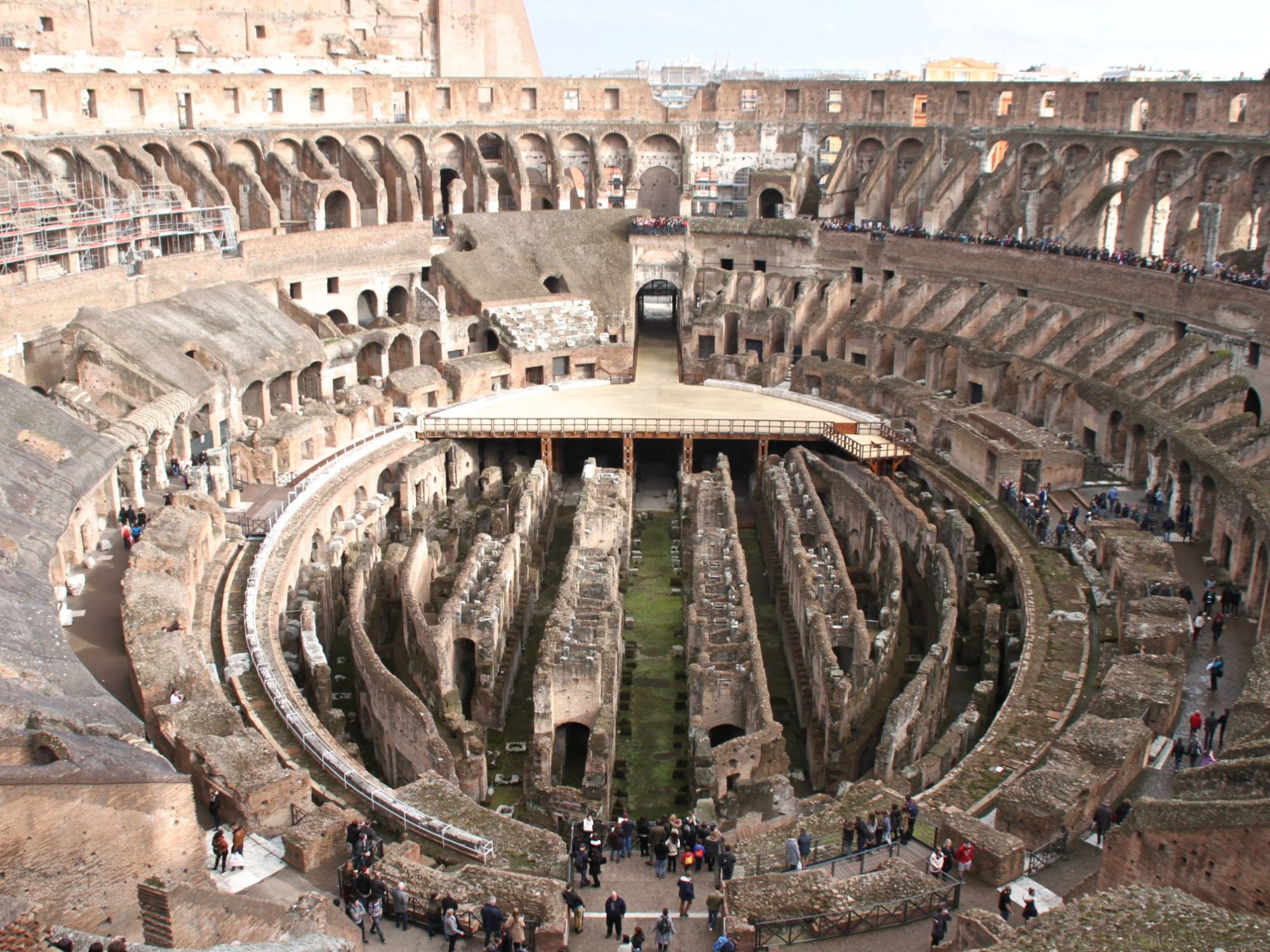
The Roman Forum: A Practical Visitor’s Guide
There are few cities in the world that are as jam-packed with history as Rome . Walking through the city’s cobbled streets is an unforgettable experience, as each turn reveals yet another iconic setting from history. But few spots are more impressive than the triumphal arches, towering temples and fallen columns of the Roman Forum or Foro Romano where, for centuries, the fate of the ancient Roman Empire and its people was decided. So its no wonder that millions of visitors want to see where Rome was founded, making this one of the most popular tourist attractions in Italy. If you’re planning a trip to Rome, here are our essential tips and tricks to guarantee a stress-free visit with our 3-in-1 pass to the Roman Forum, Palatine Hill and Colosseum .

Book ahead to skip the Roman Forum and Colosseum lines
When you’re on vacation, time is precious. Much too precious to waste hours standing in a long dusty line in the heat of the summer sun, fumbling with your cash. Especially if you only have one or two days in Rome.
That’s why these days the smartest travelers book online in advance to skip the long lines and ensure a relaxing, stress free vacation. It’s secure, as easy as 1-2-3 and can be done from the comfort of your armchair, or with the help of our travel experts in just a few minutes! Perfetto!
Start at the very beginning
As the largest and most imposing building in the three sites, it’s tempting head straight to the Colosseum for the gladiatorial glamour and gore. But to understand how Rome started and grew to dominate the known world, plan your visit in chronological order.
Many of the oldest and most important religious and legislative structures of the ancient city are located in the Forum. From the legendary 7 th century BC Temple of the Vestal Virgins, to the Curia Julia Senate House built by Julius Caesar, to the enormous Temple of Antoninus and Faustina, all have fascinating tales to tell. So aim for the Roman Forum first, climb up to the Palatine Hill for the royal palaces and then drop down to the arena for the finale.
Don’t forget the Palatine Hill
The Palatine Hill is one of the seven hills upon which Rome was established and, along with the Roman Forum, is one of the most ancient parts of the city. Legend has it that founding twins Romulus and Remus were discovered in a cave here, being looked after by a she-wolf. And although little remains of the twins today, the hill is still home to Emperor Augustus’s centrally-heated royal palace, built in the 1 st century AD and described by some as the first “White House,” as it had a west wing for public life and an east wing for the emperor’s private life.
The Palatine Hill also gave us the words palace (English), palazzo (Italian) and palais (French), all derived from the old Etruscan or ancient Italian word for sky or heaven.
And the hill is one of the highest points in the city with a great view over the Roman Forum, the modern city skyline towards St Peter’s and your next destination, the Colosseum. It was once the center of the Roman Empire and offers great insight into royal life on your whistle stop tour through 3,000 years of history.
Note : Entrance to the Roman Forum and Palatine Hill is combined on your ticket so make sure to visit both together as you won’t be allowed re-entry once you exit.
Read the signs
Deciphering what’s in front of you can be tricky: even though the ancient Romans brought us the first grid system cities, the Forum is a little more higgledy-piggledy in its layout.
There are a few small signs dotted around the site to explain the background of key spots so make sure to check them out to help you steer through the ruins and get the most out of your self-guided visit.
Take a closer look at the Roman Forum
The Forum is a huge site but don’t be overwhelmed as some of the most fascinating history can actually be seen in the tiny details that are often overlooked.
Up on the Palatine Hill, you can find large internal pipes built into the thick palace walls that once provided hot air central heating. Or keep your eyes peeled for early lead piping that carried water from the countryside to supply the ornate fountains and baths. The Latin for lead – plumbum – is also where we get the word “plumber.”
And if you look very closely at the steps of the Basilica Julia near the Curia Julia in the Forum, you might even spot the grooves, grids and circles of board games carved into the marble where ancient Romans used to sit and play games. These are the intricacies that breath life back into the ancient Romans. Fascinating, eh?
Plan enough time for your visit
At a practical level, the time you spend at the Roman Forum and Palatine Hill depends on you. Your pass has a designated entry time for the Colosseum but you are free to enter the Forum at your leisure, either before or afterwards.
So if you like a bit of a history, have read about ancient Rome or have a guidebook to hand, you can easily spend half-a-day exploring the sprawling ruins and the small museum on the Palatine Hill before you even get to the Colosseum.
If, on the other hand, time is tight and you’re looking for a quick glimpse of ancient Rome to set the scene, it’s worth putting aside at least an hour to soak up the ancient Roman atmosphere and architecture before entering the Colosseum. The choice is yours.
Choose the right footwear
On a practical note, Rome’s smooth stone cobbles can be slippery when wet or dusty and the same goes for the ancient Roman Forum. Add in the uneven paving stones of the ancient Roman streets, worn silky smooth over the centuries, or the climb up to the Palatine Hill on hard gravel paths, and thin-soled flipflops might not be the best footwear!
Not that you need walking or hiking boots; that would be overkill. But non-slip tennis shoes might just make your little piggies more comfortable, whatever the weather.
And bring an umbrella and a water bottle
Rome enjoys a temperate climate all year-round with moderate, wet winters and scorching, sunny summers. The Roman Forum, however, offers very little in the way of shade so pack an umbrella to guard against rain or provide shade from the sun. And bring a bottle of water in summer since the Forum is a real heat trap for the thirsty traveler.
Ready to skip the line and explore the Roman Forum?
So what are you waiting for? If you’re planning a trip to Rome, a visit to the Roman Forum, Palatine Hill and Colosseum is essential. And now it’s even easier to explore the temples, palaces and amphitheater without wasting time waiting in line. Just go online or give our travel experts a call to book your stress-free pass and save yourself a hot, dusty delay. And make sure to check out our blog for other top tips on discovering Rome since once you’ve skipped the line with us, you’ll never want to queue again! Buon viaggio!
Why book with Select Italy
We have over 23 years of experience providing luxury vacation destinations throughout Italy.
Our industry expertise, exclusive access to accommodations, handpicked tour guides, and unique vacation destinations differentiates Select Italy and allows us to create the best guest experience for you.
Expert Service | Price Match Guarantee | 100% Peace of Mind
Read more about Why you should book with us.
Roman Forum
Tickets sell out fast in Rome: check availability now »
Journey into the heart of Ancient Rome at the Roman Forum.
Discover the center of Roman society at the Forum, where laws were decreed, politics discussed, and goods bartered.
This is the beating heart of Ancient Rome : an unmatched social, economic, religious, and political powerhouse.
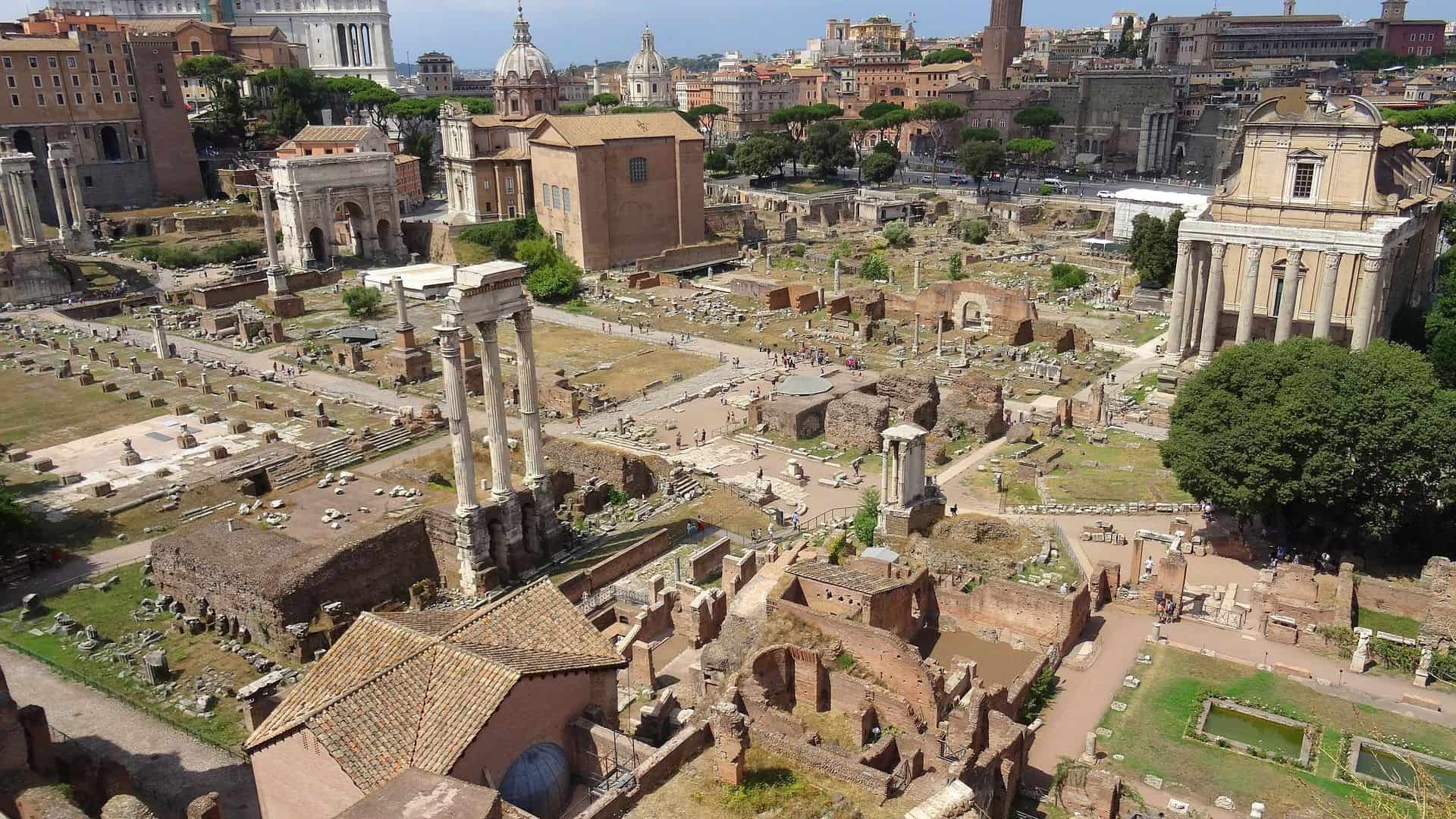
- Wander down the Via Sacra, the Main Street of Ancient Rome.
- Visit the temple and home of the Vestal Virgins – and discover where they would tend to the sacred eternal flame of Rome.
- Weave between the ruins of temples, meeting halls, and monuments in the Forum, and see the gravesite of the infamous Julius Caesar.
Everything You Need to Know About Visiting the Forum
Your entry to the Roman Forums and the Palatine Hill is usually included with your Colosseum ticket since the Forum is part of the same archeological park ( Parco Archeologico del Colosseo ).
The great thing is that it’s valid for 24 hours before or after your entry to the Colosseum. This means you are not obliged to see both on the same day. In fact, for reasons I’ll go through with you below, I would wholeheartedly recommend you see the Roman Forum first (ideally the afternoon before) and then see the Colosseum the following morning.
To get there, you have two options. Either you take the main entrance via Via Sacra (opposite the Colosseum) whereby you enter through the Arch of Titus OR enter from Via di Gregorio (just after the Arch of Constantine) for a more relaxed way in.
I’ll show you the Via Sacra entrance way as, while the busiest, is also the most evocative. But it’s your call.
This guide assumes you have a prebooked ticket with no guide.
Tickets & Prices
Explore the Roman Forum with ease by purchasing a ticket beforehand. You won’t have to waste extra time in the purchasing queues and can breeze through the ancient site.
Find out which of these Roman Forum tickets is best suited to you.
- Colosseum, Roman Forum & Palatine Hill (Priority Entrance) – Skip the line with this priority entrance ticket.
- Colosseum, Roman Forum & Palatine Hill (Last Minute Priority Entrance) – Last minute ticket for Colosseum entry.
- Rome Tourist Card (Bestseller) – See the best of Rome with this popular combi-ticket. Includes access to The Colosseum, Roman Forum and Palatine Hill, Vatican Museums & Sistine Chapel, St. Peter’s Basilica (official guided tour), and more…
- Rome Super Pass with Public Transport – Skip-the-line entrance to some of Rome’s best attractions with this combi-ticket. Includes unlimited public transport PASS (metro, bus, tram).
Tickets for Colosseum, Roman Forum & Palatine Hill
Entrance to the neighboring ancient sites of the Colosseum and Palatine Hill is also included with these tickets. You get to skip the queues and also download a digital guide to teach you the history of your surroundings.
Important Ticket Information:
- The tickets are valid for two days (including the day of activation).
- Re-entry is not possible once you leave the site.
- Palatine Hill is open from 10:00 – 19:15. While both the Colosseum and the Roman Forum are open 09:00 – 16:30. The last admission is an hour before closing.
- You should head to the Via dei Fori Imperiali entrance to enter the Roman Forum.
- You can choose between 5 visit routes, which vary from 30 minutes to 2.5 hours.
Rome Tourist Card
The Rome Tourist Card is the ultimate pass for new visitors to Rome. It grants you access to the city’s most iconic sights, from Palatine Hill and the Colosseum to the Sistine Chapel .
It’s perfect for people hoping to tick off all the main tourist spots during their visit.
- Includes skip-the-line access.
- The Colosseum, Roman Forum and Palatine Hill, St. Peter’s Basilica, Vatican, and Sistine Chapel are the attractions included.
- It is a digital pass.
- There isn’t a time limit on the Rome Tourist Card – it can be used and remain valid throughout your stay.
- You can book time slots online.
Getting There
Take the Metro to Colosseo – on the B (blue) line, two stops after Termini.
Exit the station, and the Colosseum will be right in front of you.
You will be tempted to start taking photos immediately but trust me, there are way better spots from where to snap a selfie.
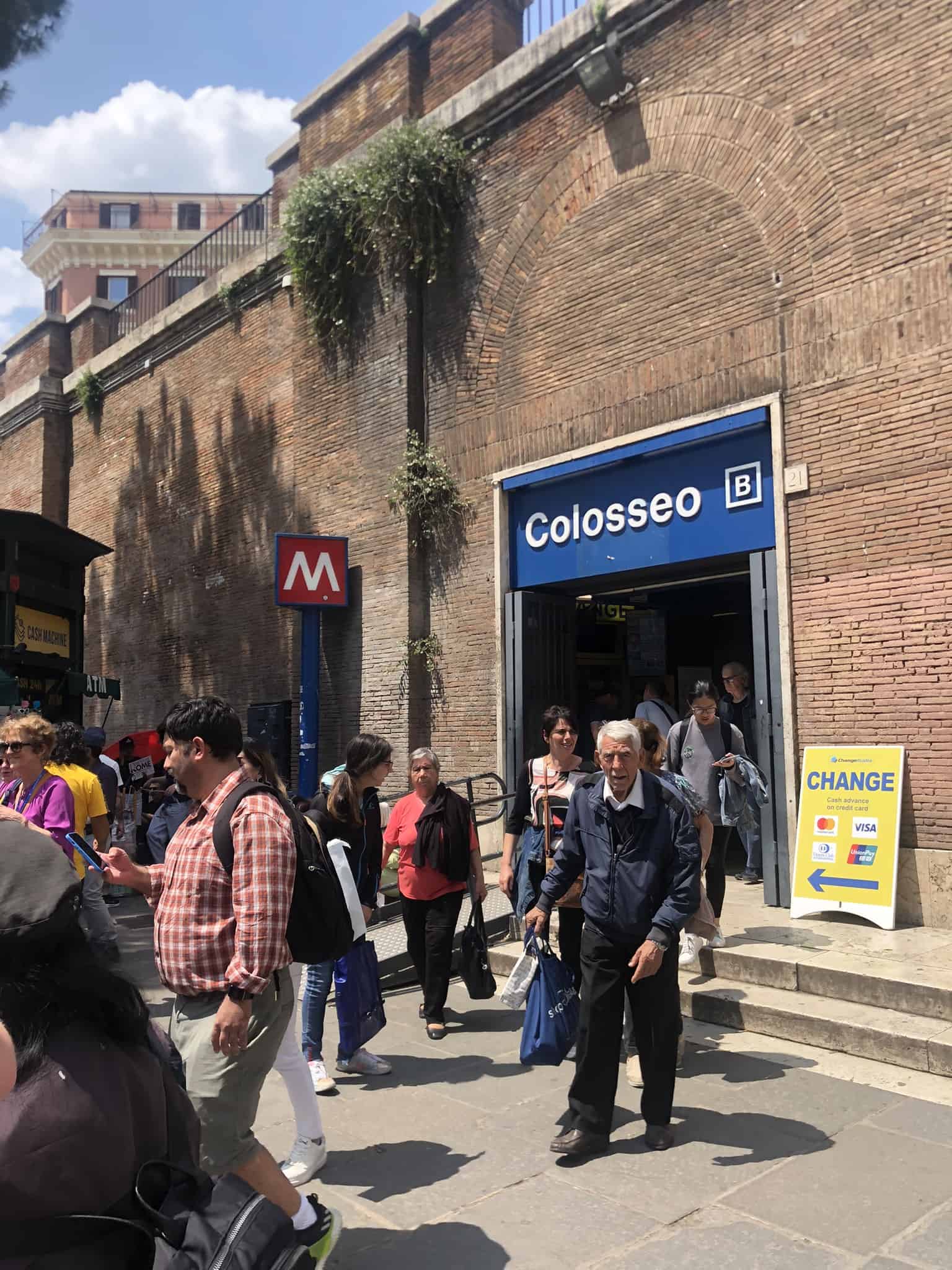
Neverending stream of people exiting the Metro statio
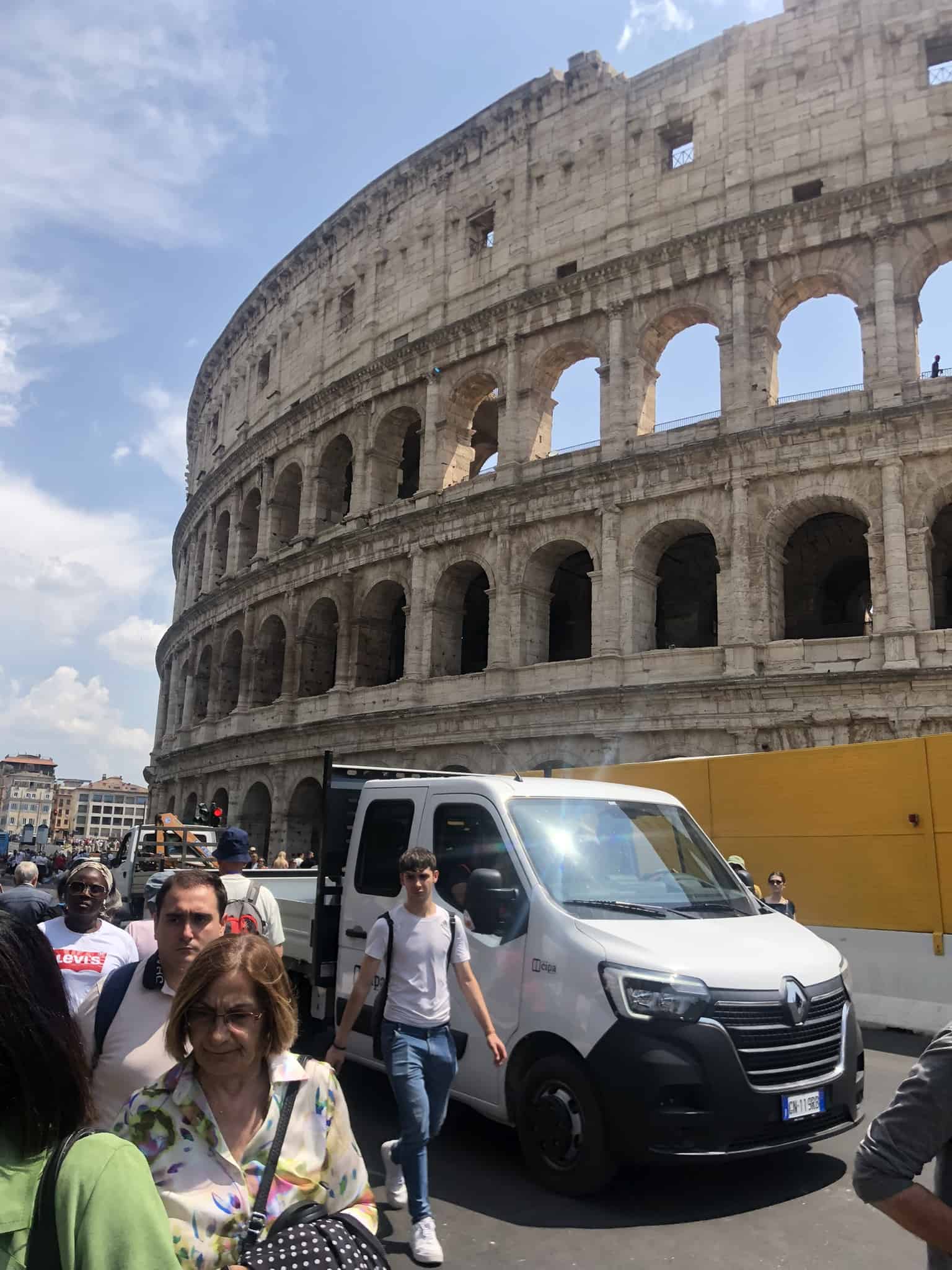
The Colosseum is directly opposite the Metro station.
The white and yellow panel obscures a construction site for a new Metro stop for the C Line.
It’s been a work in progress for over 20 years now, so something of a running joke among Romans.
- Top tip: Warning – there are two exits: lower level and upper level. After you come up the stairs and go through the ticket barriers, you’ll be on the lower level. Go straight out. You’ll be within sniffing distance of the Colosseum. You can’t go wrong. (Lots of guided tours have their meeting point at this exit of the Colosseum Metro.)
If, on the other hand, you walked or took a taxi , you’ll most likely be taken to the upper level exit (either by your phone’s GPS or the taxi driver).
Enter the Metro station and take the stairs down. You’ll arrive at the lower floor level of the station, opposite the Colosseum.
There are a lot of illegal ticket touts still operating in this area. Think of them like the sun. Make no direct eye contact. Ever. No need to be rude or get angry with them if they pester you. Just keep walking.
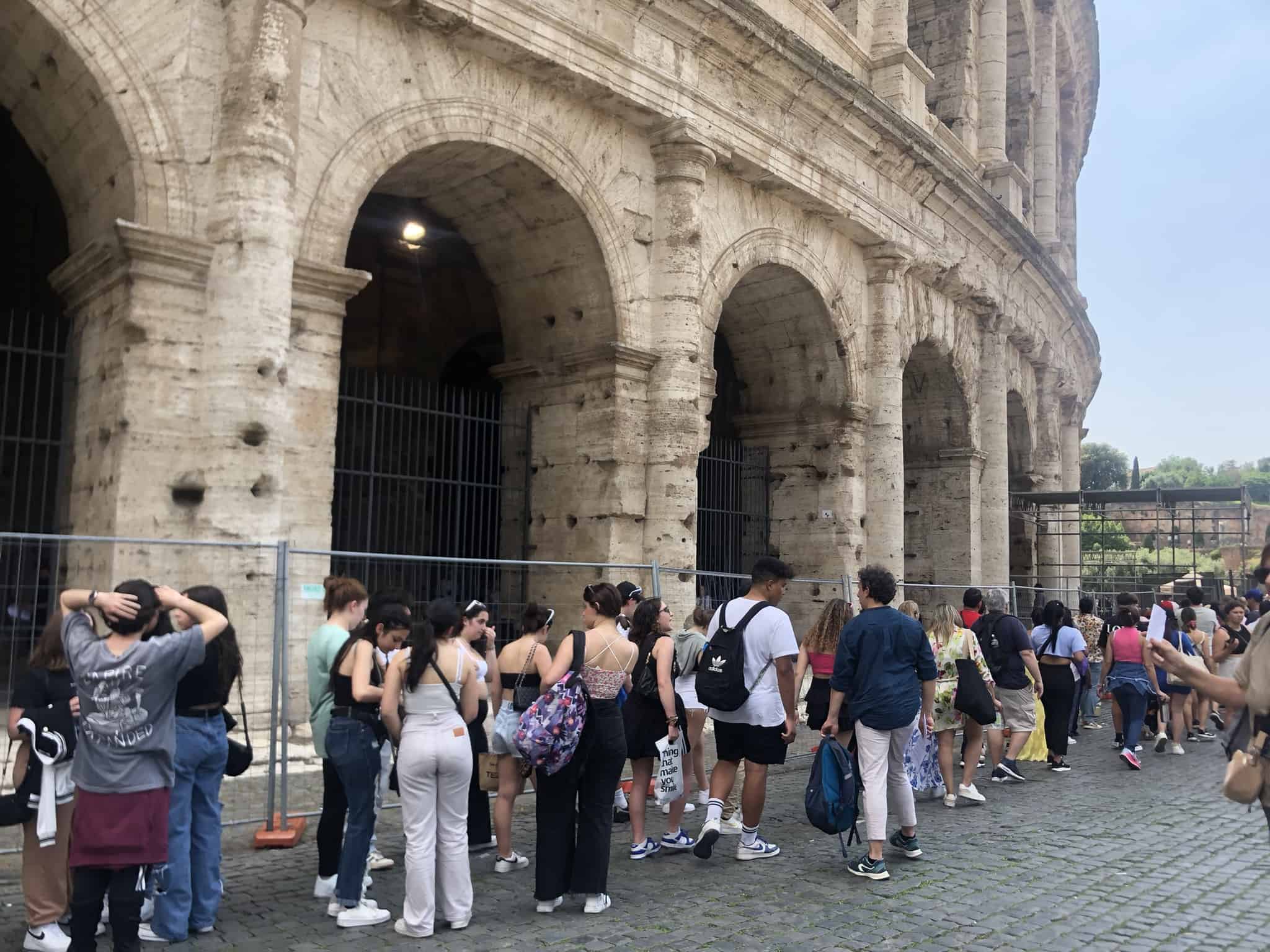
Group ticket holders’ line.
From the station, cross the road and as you pass the construction panel, you will probably see a very long line like this.
This line is for group ticket holders. They will be with their tour guide.
Follow the line for another 20 metres or so until you get to a sort of tree lined square, the other side of which will be another long line of people queuing up at the ticket office (see below).
Line for the ticket office opposite the Colosseum.
Cross over, walk past the ticket office and the line of people, and go straight until you come to Via Sacra and a sign indicating the way in that looks like this:
Entrance to Roman Forum on Via Sacra
- Top tip : Via Sacra is made up of huge shiny ancient cobblestones (much larger than the ones in central Rome known as San Pietrini). You’ll want to wear shoes with good grip.
Not sure how much of a flex this really is – there are literally hundreds of free potable water fountains in Rome. But it is the only water fountain at the Forum and with no cafes or restaurants, you will need it. You’ll find it just after the Arch of Titus.
- Top tip: Bring a refillable water bottle. There’s quite a lot of walking involved on Palatine Hill, and there are no restaurants. (Which is a shame because it would be very nice if there were).
Walk up the Via Sacra and you will be greeted by staff who will scan your ticket. You’ll go through a turnstile and then just like that, the epic Arch of Titus welcomes you in.
(I went in May 2023 which was ridden with days that started out with perfect blue sky and then ended with a thunderstorm. I liked it though; the sky, while ominous, just made everything a lot more dramatic.
- Top tip: Download the Parco Archeologico App . You can find it on the official Colosseum website or by scanning the QR code on the ticket information panels located next to the ticket office. It’s invaluable for helping you get your bearings around the deceptively large Roman Forums and Palatine Hill.
Above: Arch of Titus, and the start of most Roman Forum itineraries. Remember that scene in Ghostbusters 2 when dark clouds gather over the museum right before it gets covered in ghost slime?
What You Can Expect To See
basilica of maxentius and constantine – (313 c.e).
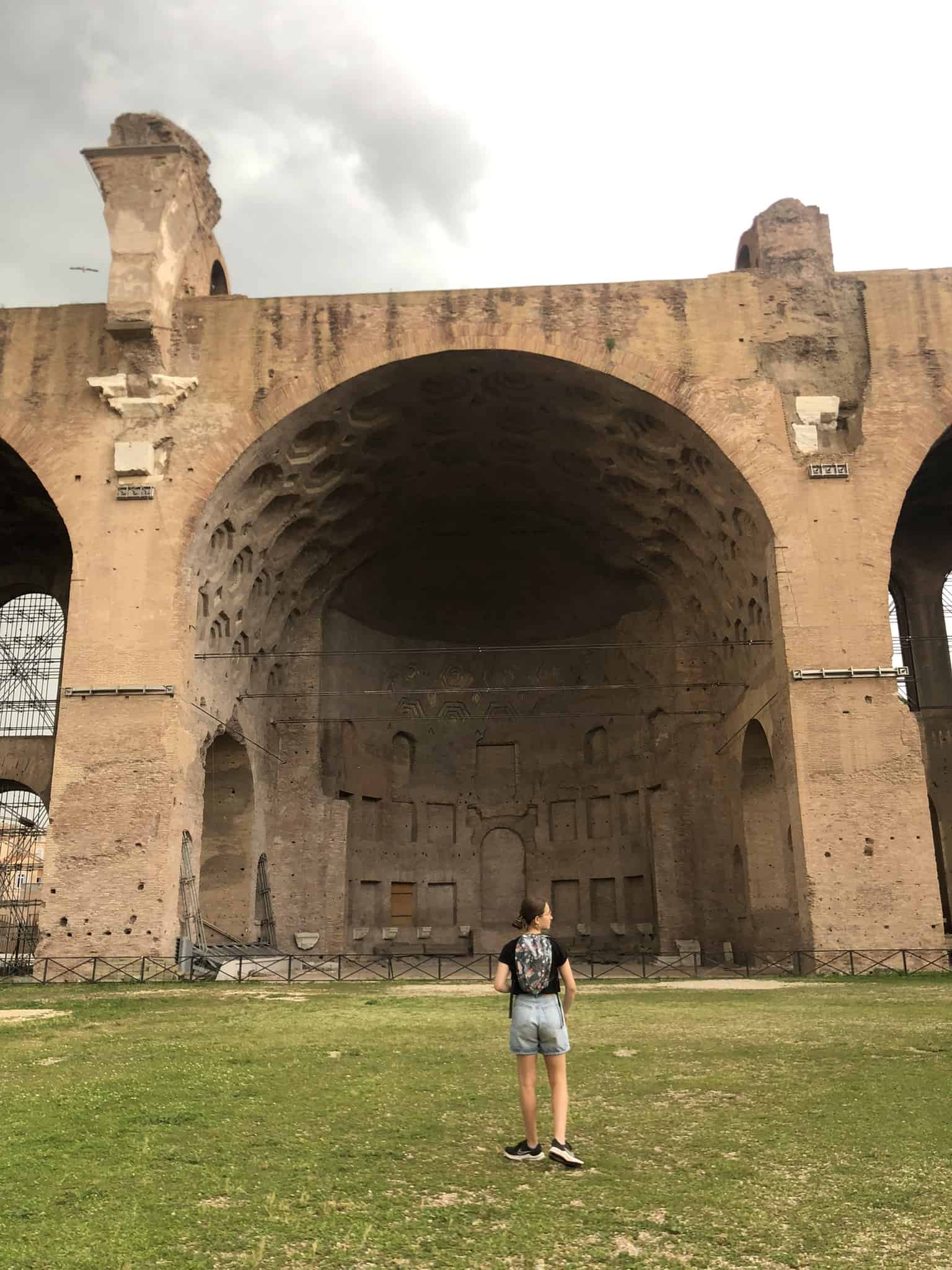
It’s really the scale that is the most impressive here.
The largest structure in the Forum, and of vast architectural importance; its design is said to have influenced the design of the St. Peter’s Basilica .
Artists’ renditions make it come alive, take a look before you go.
The Temple of Romulus – (300 C.E)
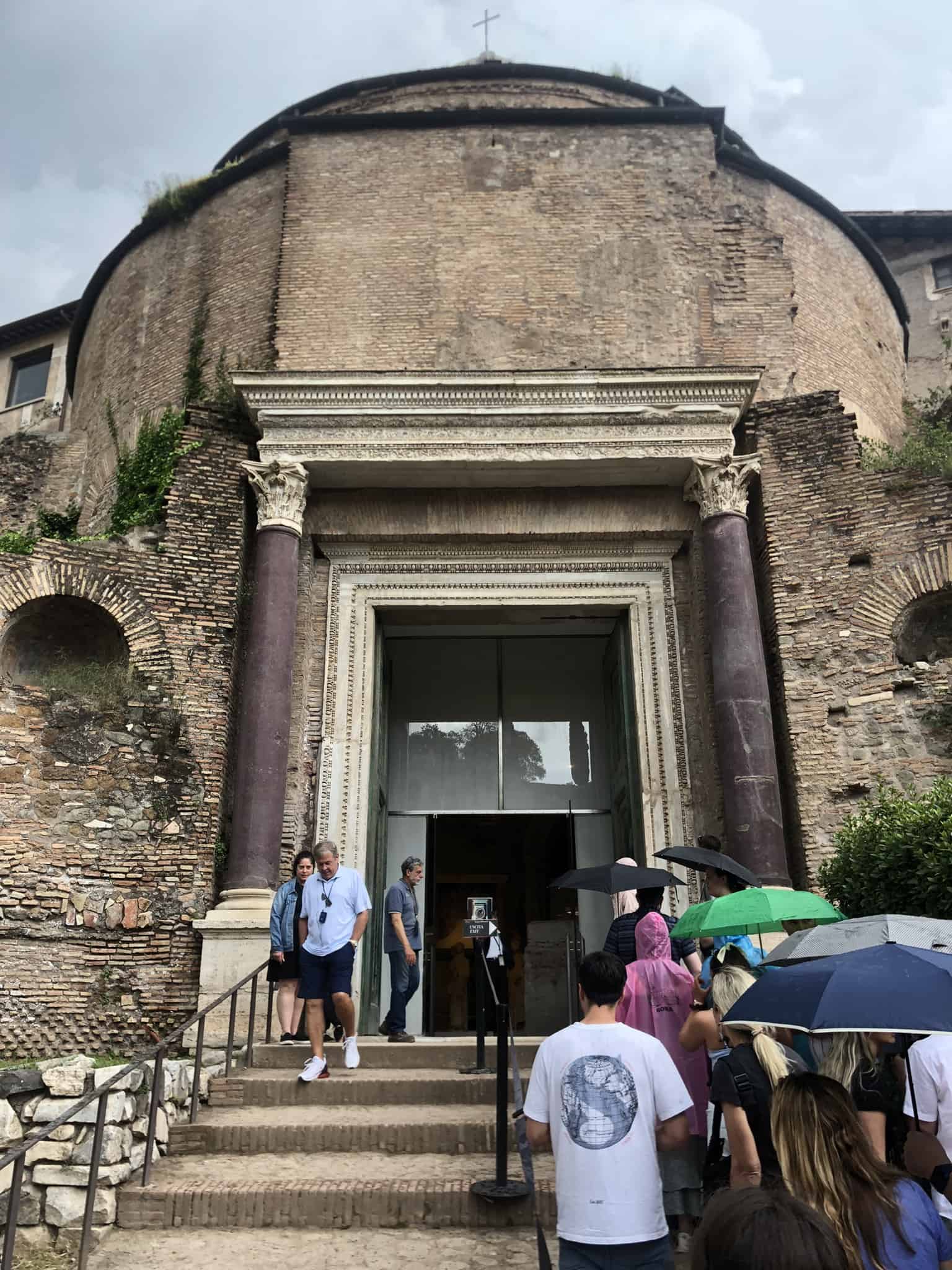
It’s unclear what the Temple of Divus Romulus was really used for other than an antechamber for the temple behind.
However, the bronze door, still used today, is 100% original. It was converted into a church in the 6th century.
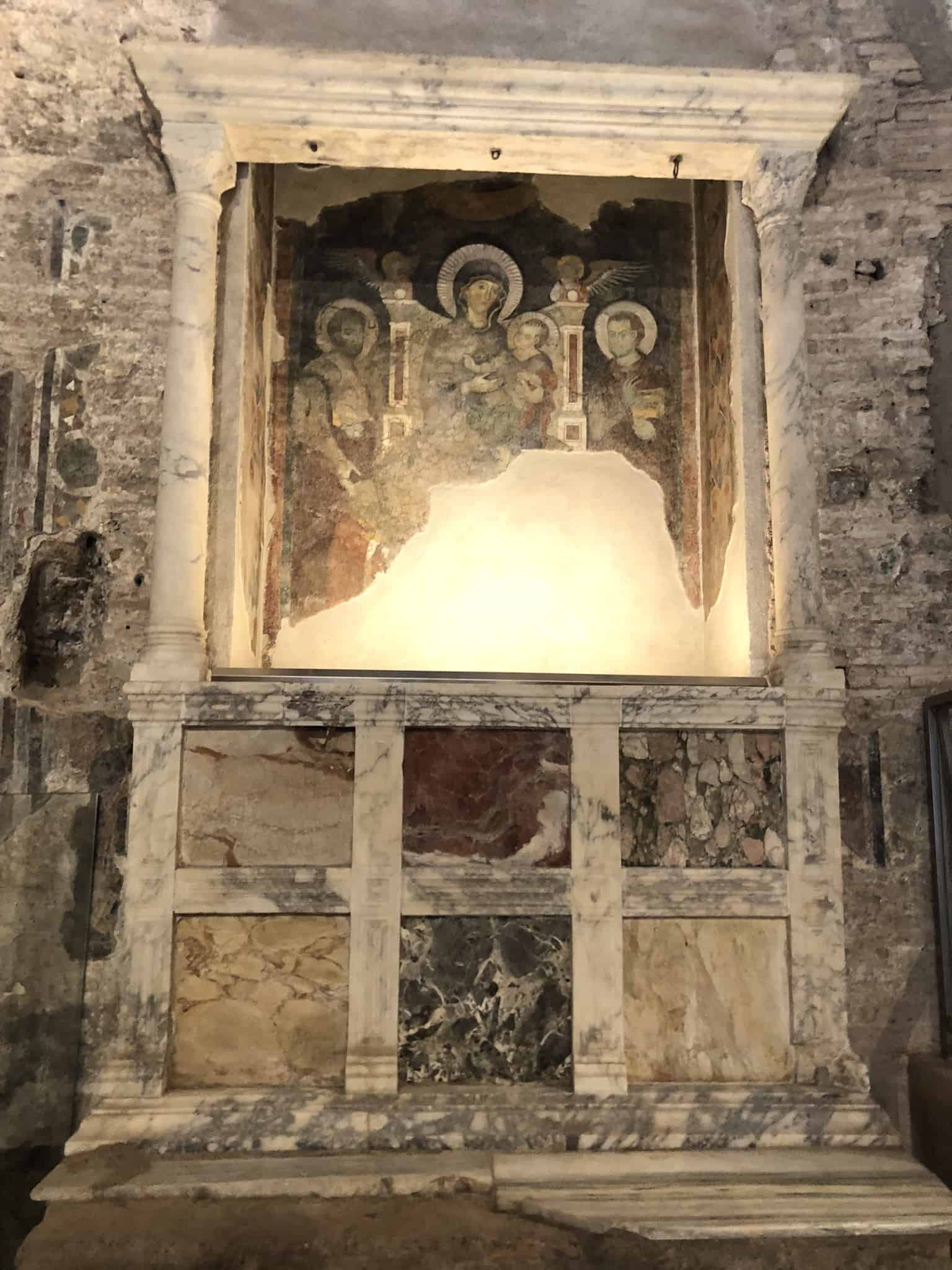
Detail of a fresco behind an altar from inside the Temple of Romulus.
The Temple of Antoninus and Faustina (141 C.E)
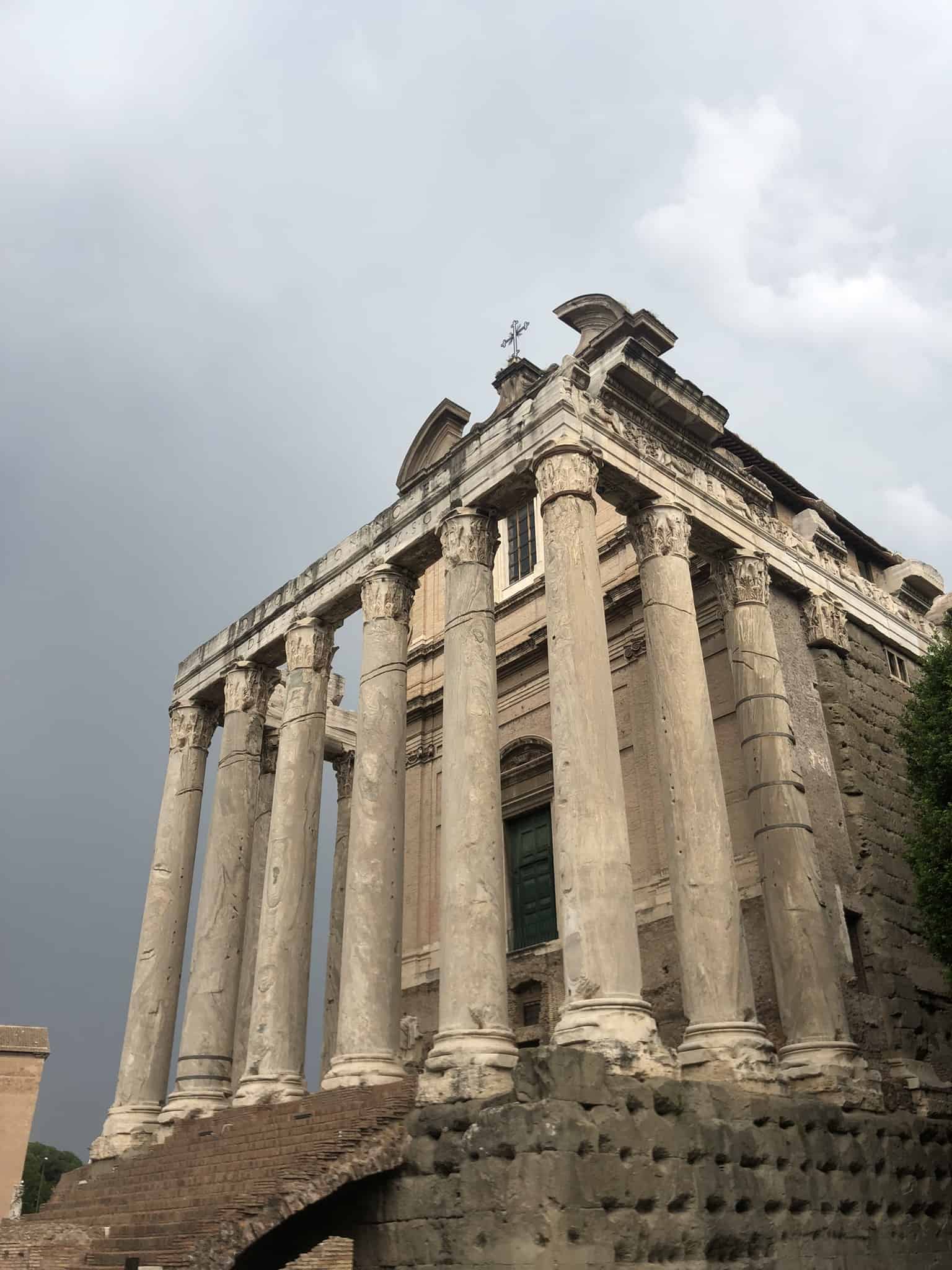
This one takes a second to figure out.
What’s that door doing up there?
19th-century excavations revealed the difference in street levels between Roman times and the 17th century. Contrast the threshold of the green door with the base of the steps leading up to the columns.
The Church, dedicated to San Lorenzo in Miranda is known as ‘the church in a temple’ for obvious reasons.
The Temple of Vesta
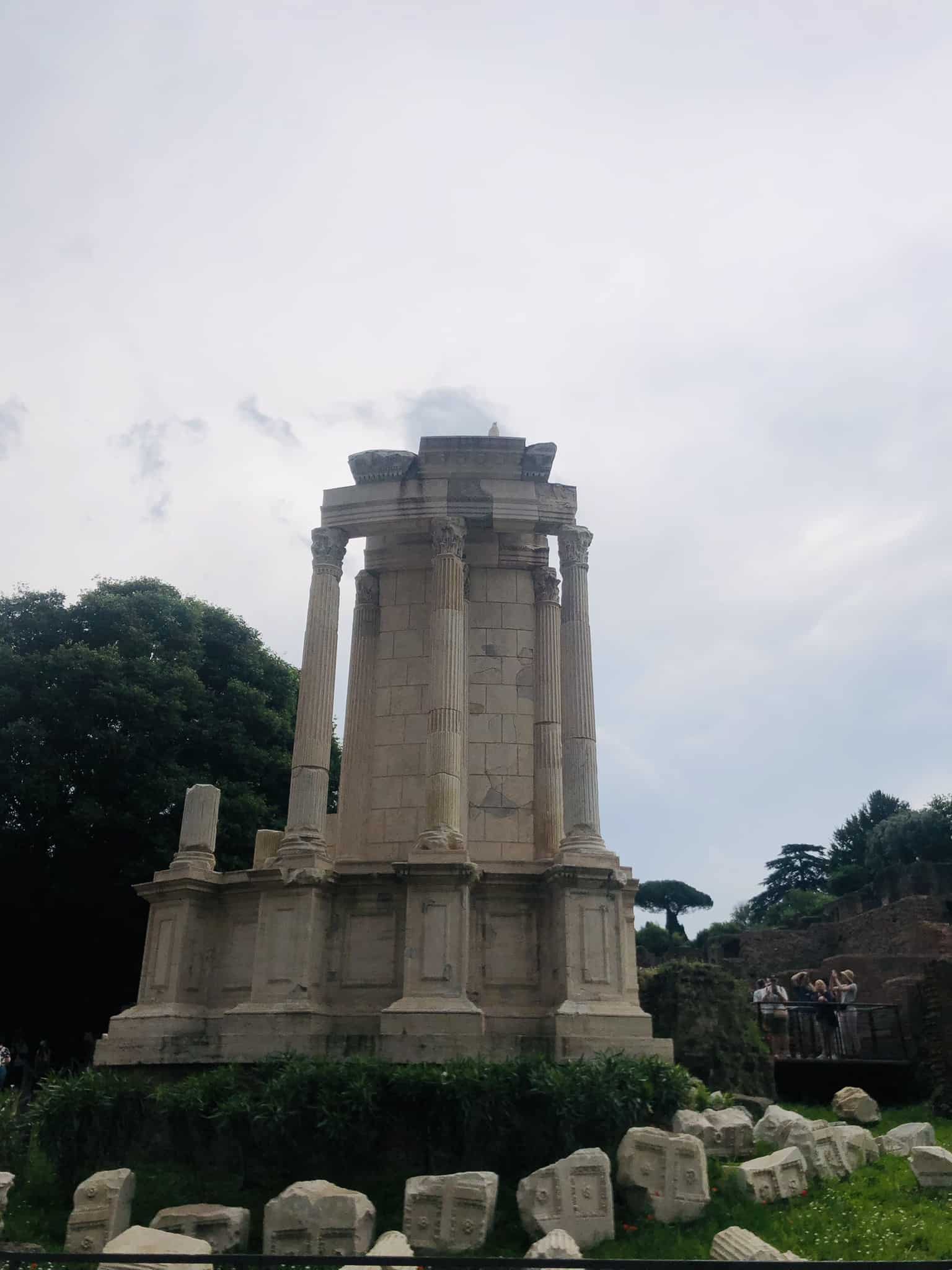
The oldest and most important shrine, it was home to the hearth which held the sacred fire of the state.
Religious activity on this site is estimated by historians to go as far back as 7th-century B.C.E.
Tempio dei Dioscuri
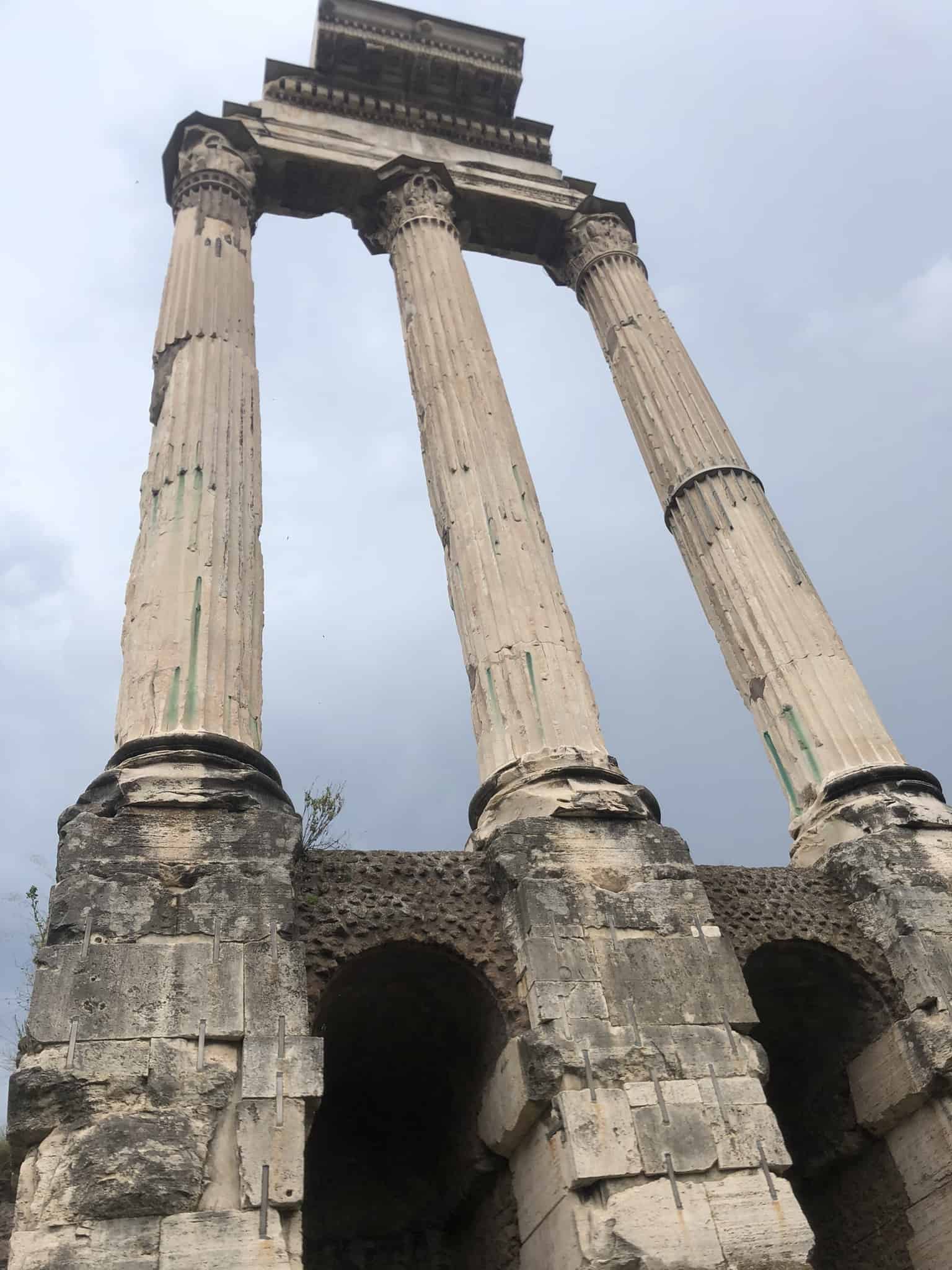
Temple of Castor and Pollux (Tempio dei Dioscuri).
Legend has it that the sons of Jupiter and Leda appeared on this spot to assist the soldiers of the Roman Republic overcome the last king of Rome.
Just these three columns remain, but they are iconic.
The Atrium Vestae
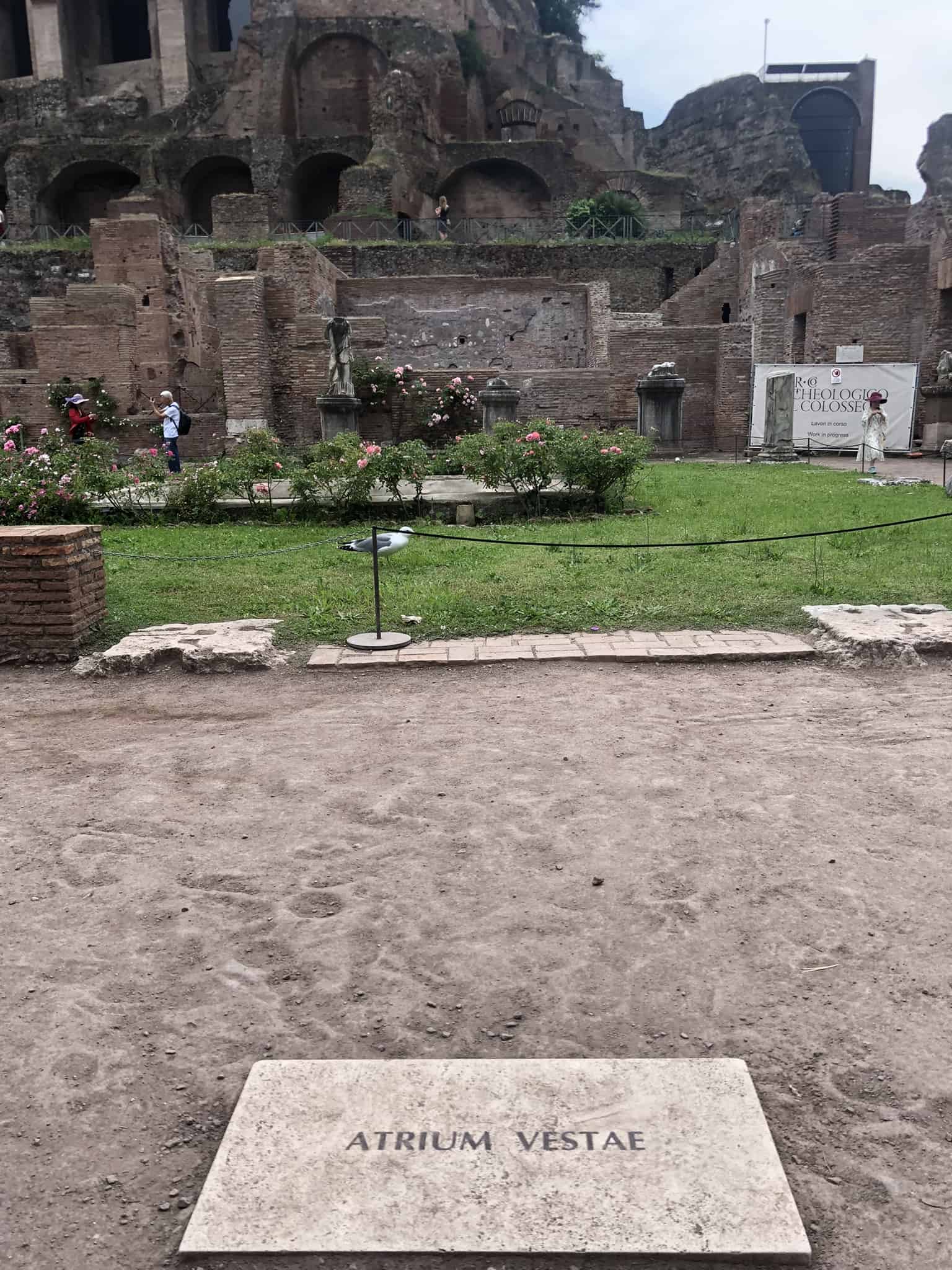
One of my favourite areas had to be the Atrium Vestae or the House of the Vestal Virgins.
(Vestal Virgins were women who would tend to the Temple of Vesta for a tenure of thirty years. As their title would suggest, they were virgins and were expected to remain celibate).
There are benches and it’s a great place to sit down, soak up the atmosphere, get your bearings, and prepare yourself for the Palatine Hill.
(See below for a super quick history lesson and why this is extra relevant).
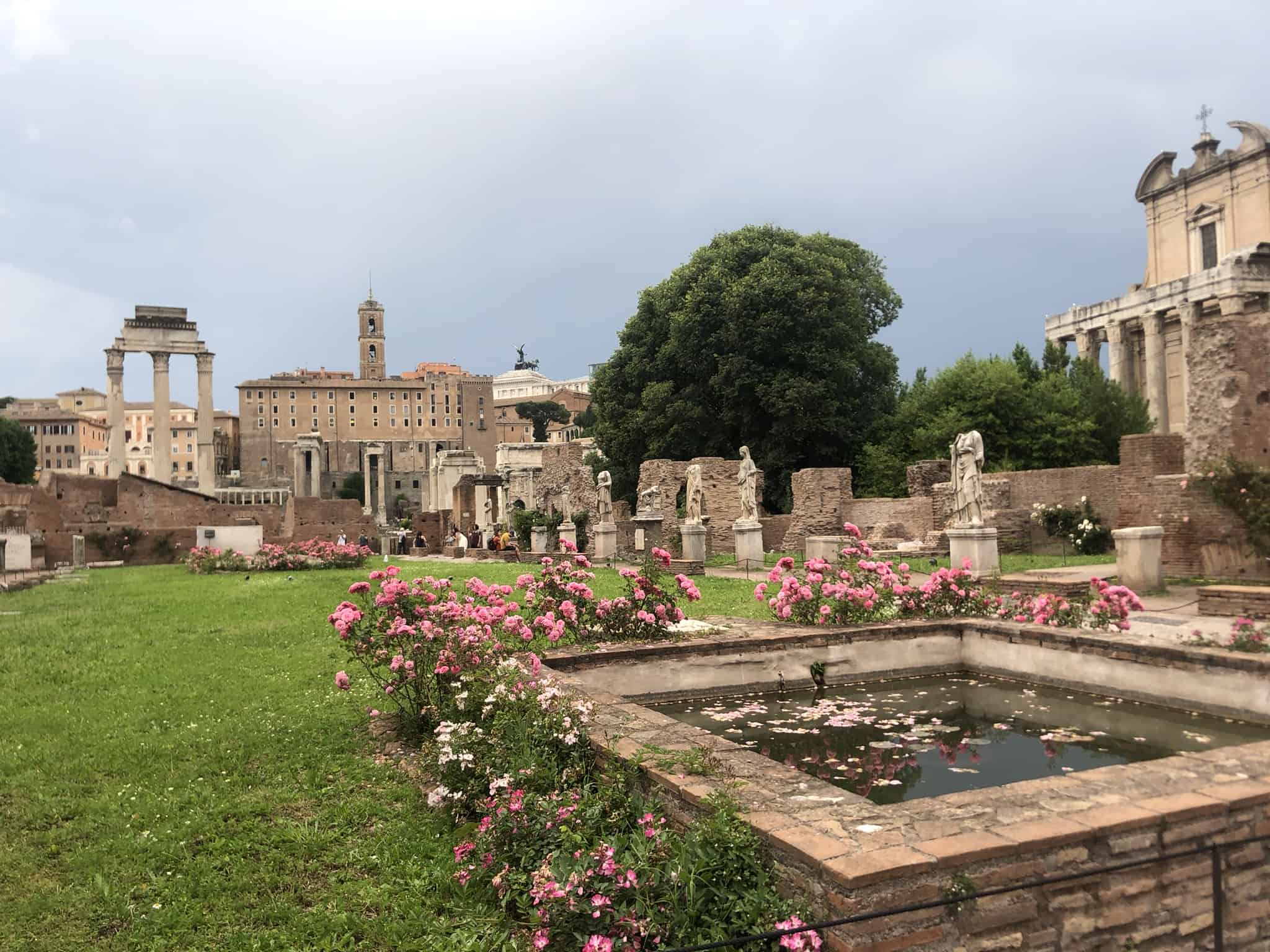
View of Tempio dei Dioscuri and Temple of Antoninus and Faustina from House of the Vestal Virgins, now a very serene rose garden.
Vestal Virgins
According to Roman mythology, a vestal virgin called Rhea Silvia was impregnated by the god Mars. She gave birth to twins and called them Romulus and Remus.
The King perceived the sons of Mars to be a direct threat and so ordered them to be killed. They were abandoned by the river but saved by the god Tiberinus, Father of the River.
As infants, they were suckled by a she-wolf (Lupa), and the cave ( the Lupercal ) in which she cared for them was believed to be up on Palatine Hill.
(If you ever wondered why the symbol of Rome was a wolf).
Years later, Romulus and Remus entered into a bitter dispute over where to build the city. Romulus favoured the Palatine Hill. Remus did not, so his brother had him killed. Romulus founded the city, called it Rome and the rest is history.
Palatine Hill Overview
The Palatine Hill has so many layers to it; both historically and mythologically.
It was home to the ruling classes of Rome for literally millennia. It’s dominated by the ruins of a network of imperial palaces from the first century called the Domus Augustana.
After a brief period of decline during the Middle Ages, things picked up again in the 16th century, when Palatine Hill became home to the first-ever botanical gardens in Europe thanks to the Farnese family.
Just a couple of pavilions and a fountain from what were once the most highly rated pleasure gardens in Europe.
The Palatine Museum at the top of the hill will help fill in the gaps showcasing the wealth and splendour of its previous inhabitants and their respective residences.
Cap it off with stunning views over the Circo Massimo from the Domus Augustana, before exiting via the Barberini Vineyard back down to Via di San Gregorio towards Circo Massimo.
Exploring the Palatine Hill
I started by exploring the vast imperial complex Domus Augustana. To add to the regal feel, classical music is played across the Domus area from discreetly placed speakers, which for me, went perfectly with the surroundings. It instilled a wonderful sense of calm:
The Nymphaeum of Mirrors
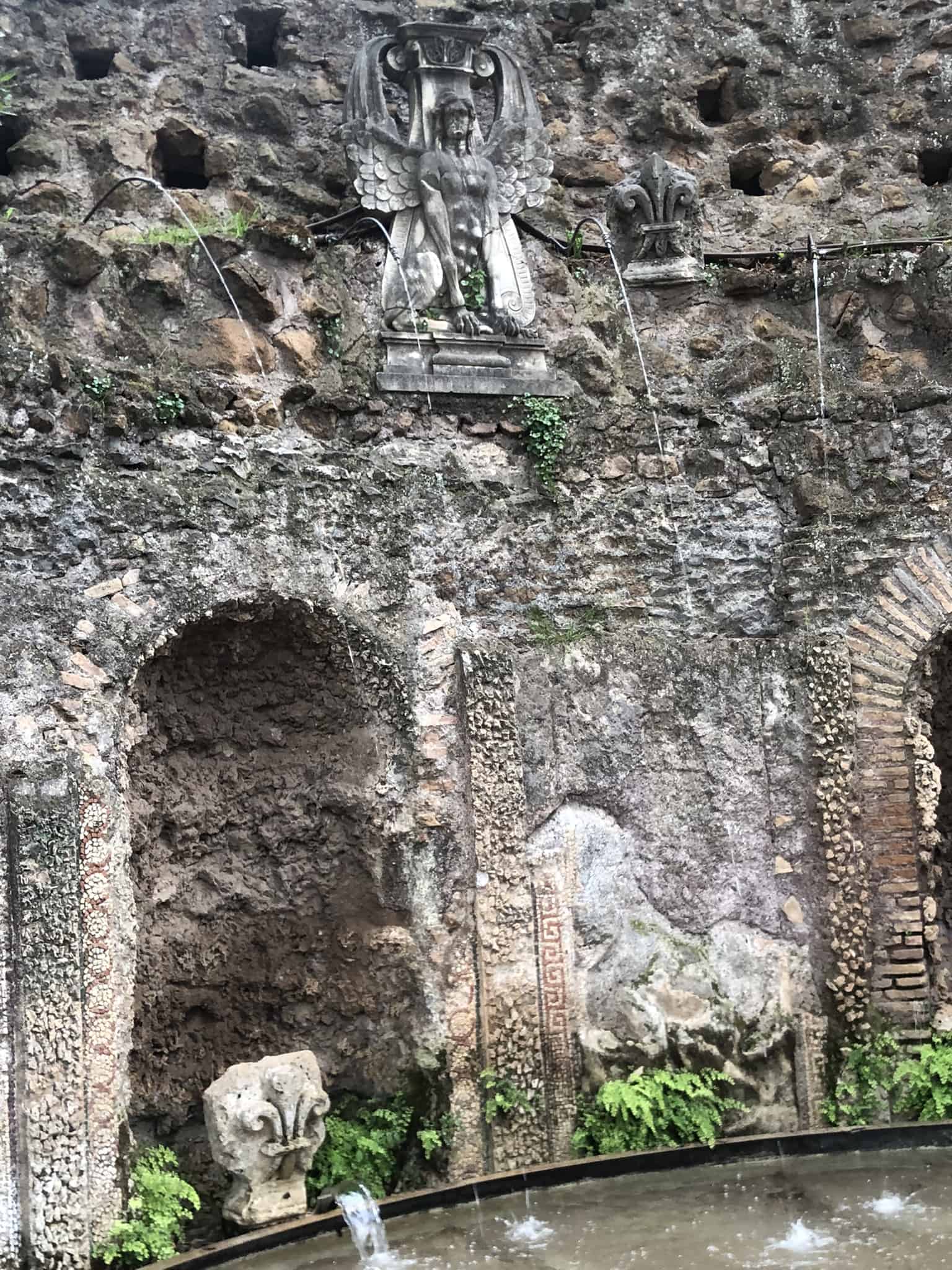
From here, I could still hear the classical music being played up the hill. I sat on a bench opposite the Nymphaeum of Mirrors – or what remains of these fantastic 16th-century water jets and fountains.
I still couldn’t quite get over how still and peaceful it was.
- Top tip : aim your visit towards the end of the day. Not only might you be lucky enough to enjoy romantic twilight views over the Circo Massimo from up on high, but it will be much quieter. Plus, you’ll wind everything up just in time for an aperitivo (between 6 pm and 7 pm), and I’ve got just the place in mind.
Making Your Way Out
Rather than going back the way you came and taking the Metro at Colosseo, exit here through Vigna Barberini. This lovely, almost rural walk downhill past random bits of Roman aqueduct will take you to the entrance/exit on Via di Gregorio, close to Circo Massimo.
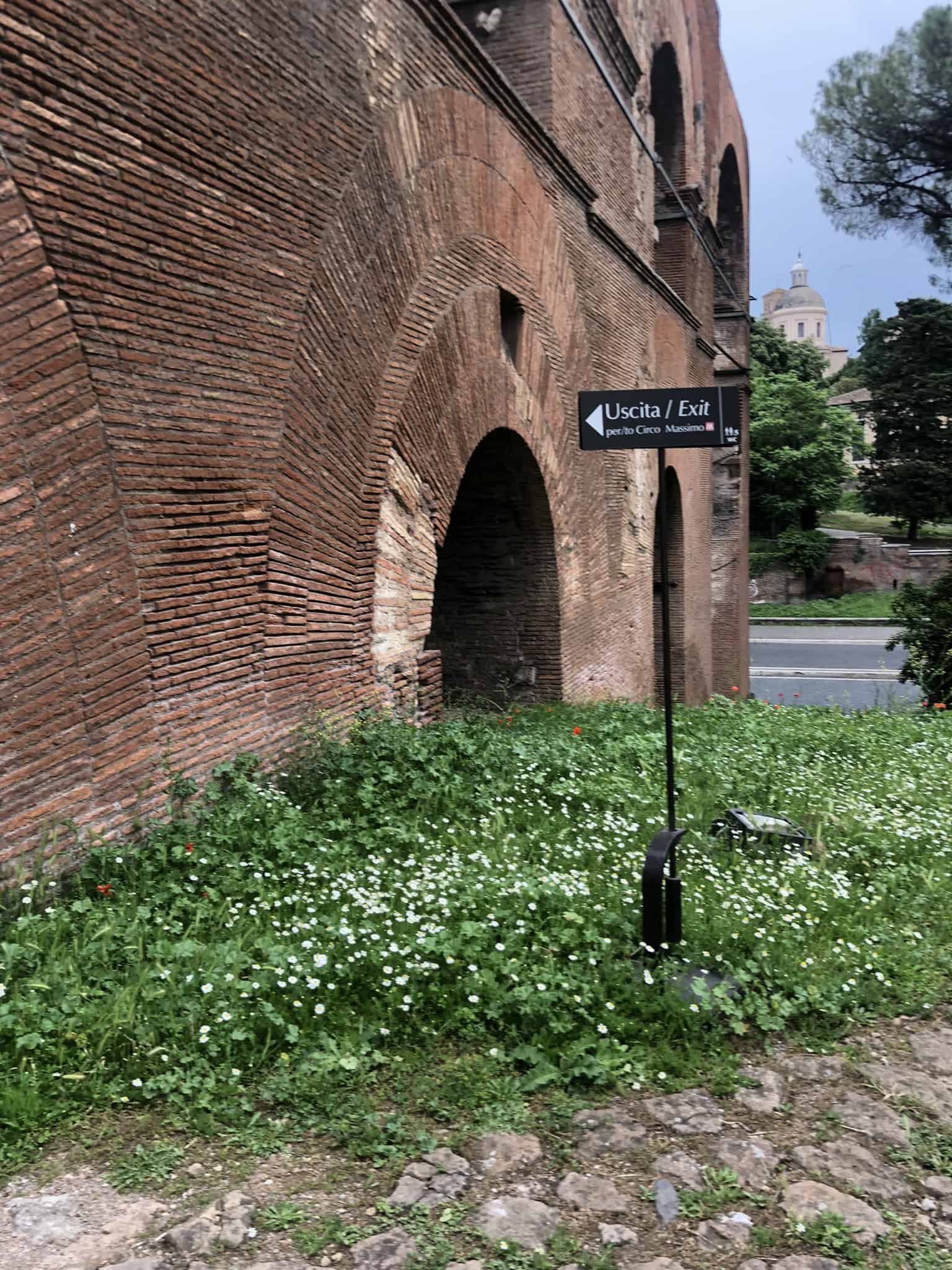
The Barberini Family Vineyard
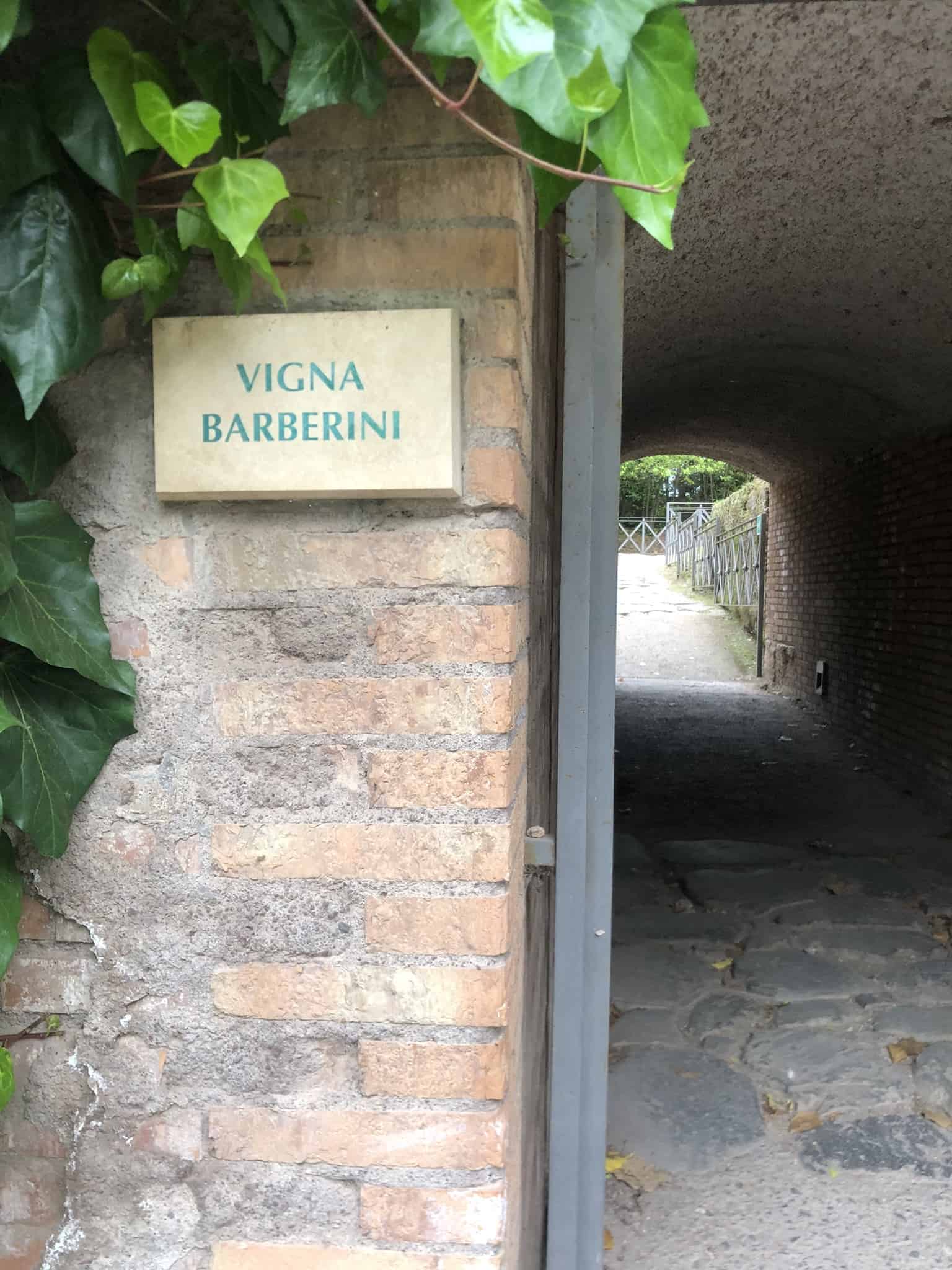
Now here’s a family that got around. This was a noble family from the 17th century that had their fingers in a lot of pies. (You’ll see their family crest at St Peter’s and they even have a Metro station named after them)
They owned property on this site in the 17th century, but the vineyard we see today was carefully planted in 2020 and viticulturalists are proud to be cultivating a very ancient vine called Bellone, known to have been used in Pliny the Elder’s time.
I visited towards the end of the afternoon and had the place to myself.
A very rural feel to the way out via the Vigna Barberini.
The path above will take you all the way down to Via di Gregorio and the splendid arch below.
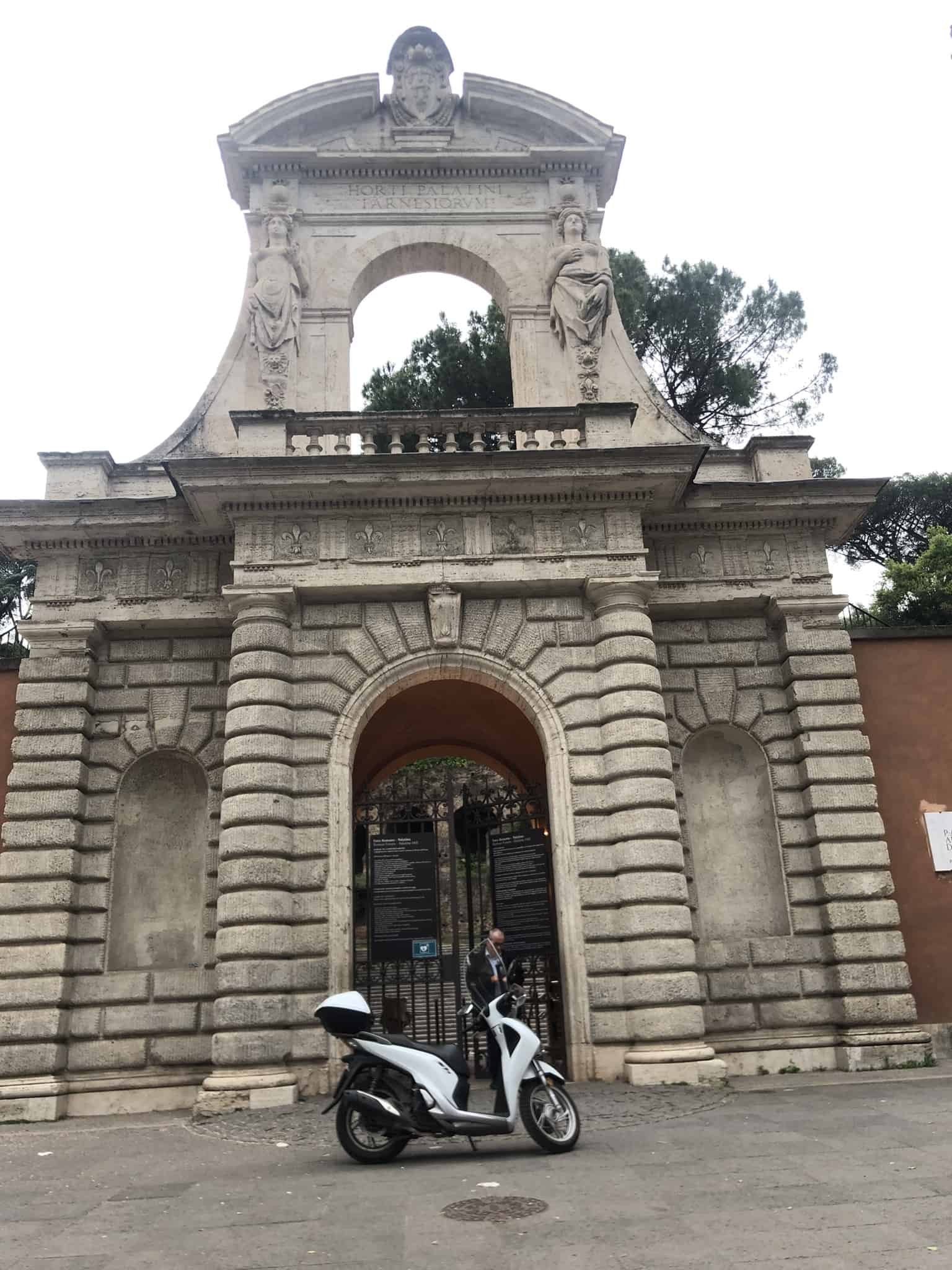
The entrance on Via San Gregorio, or the exit if you choose the Circo Massimo exit. The original entrance to the Farnese Gardens, when they were still a thing.
As you exit this splendid arch, the Arch of Constantine and the Colosseum will be on your left, and the Circo Massimo on your right hand side.
You could also choose to do the reverse and start your visit from here instead.
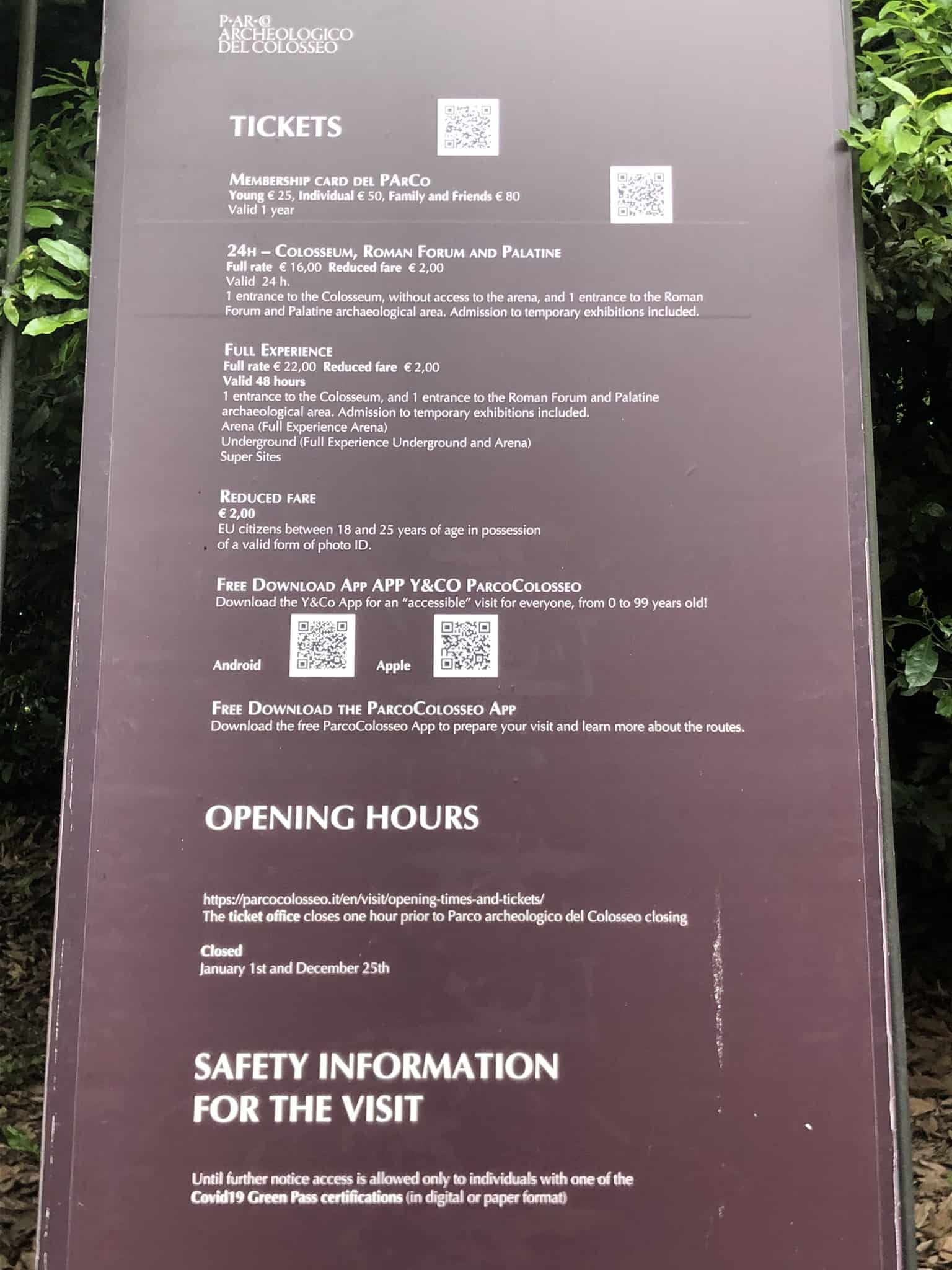
Italy has an absolute love affair with QR codes. They have them for everything.
This ticket information sign also has the QR code you need to download the Parco Colosseo App which includes a detailed itinerary for the Forum as well. Highly recommended.
You’ll find another sign like this by the ticket office opposite the Colosseum, next to Via Sacra.
Be aware that there are no gift shops, cafes, or restaurants at the Roman Forum or Palatine Hill. So bring snacks. The only official gift shops are located within the Colosseum.
Nearby Attractions
Circo maximo experience – viale aventino, 00186.
Through the use of Virtual Reality headsets, you’ll be transported back to the 1st century C.E and witness chariot races and a slice of Ancient Roman life at the Circo Massimo. A 40-minute walking tour; it’s a mere five-minute walk from the Arch of Constantine.
Panoramic view of the Circus Maximus as seen from the Palatine Hill.
Basilica San Clemente – Piazza di S. Clemente, 00184.
A five minute walk away is a stunning 12th century church.
Beneath lie archaeological excavations that take you on a voyage through time. You’ll go down to the remains of a 4th century church, and then descend once again to a 1st century pagan temple.
You’ll need to book ahead. The basilica itself doesn’t provide guided tours (local tour providers take care of that), and you will need to make sure you dress appropriately. No bare shoulders or short shorts.
Food and Drink
Bars and restaurants directly opposite the Colosseum are, not surprisingly, tourist traps. It had to be said. Instead, head to Viale Aventino; the long and cosmopolitan avenue (thanks to all the expat UN staff who frequent its bars) which connects Circo Massimo to Ostiense. It’s lined with a variety of bars and restaurants including:
So Good – Viale Aventino, 87, 00153.
Craft ale on tap and pastrami bagels. The bagels aren’t exactly NYC authentic, but portion sizes are good, and you get the option of pickles and mustard (not a given in Italy).
14 minute walk from the Arch of Constantine.
Gusto Massimo Bar – Via del Circo Massimo, 5a, 00153.
Aperitivo, pizza and good hot lunch food. A UN staff local, (working at the impressive UN Food and Agriculture building across the road), and five seconds from Circo Massimo Metro station.
8 minute walk from the Arch of Constantine.
Elleniko – Viale Aventino, 83, 00153.
Cheap Greek street food. If you want a break from Italian carbs, try Greek instead.
Elleniko offers authentic Greek street food at affordable prices.
Next door to So Good. 14 minute walk from the Arch of Constantine.
Did You Know That: 5 Interesting Facts
- At its lowest point, the Forum was used as a pasture for cattle. It was known as the ‘Cow Field’ during the Middle Ages.
- Much of the Forum was in good condition until the 16th century, though parts had been damaged by earthquakes and neglect. Pope Paul III ordered the plunder and repurposing of the Forum’s materials to build St. Peter’s Basilica, causing untold damage.
- The Arc de Triomphe in Paris was modeled on the Arch of Titus.
- After the brutal assassination of Julius Caesar, his body was cremated within the Roman Forum. Following his death, the legendary general and statesman was deified, and the Temple of Caesar was constructed on the site of his cremation. Much of the temple has been destroyed, but you can still see the remains of the altar today, which would have been treated as Caesar’s grave.
- As well as being a space for social gatherings, politics, and religious ceremonies, the Roman Forum was used as a place to conduct criminal trials. The heads of enemies were often displayed in the Empire’s twilight years.
A timeline of the Roman Forum’s place in Ancient Rome:
- 753 BC. Rome was founded by twin brothers Romulus and Remus. Buildings soon spring up to form the Forum, a communal area that Romans will use as a marketplace, religious center, and political stomping ground.
- 497 BC. The original Temple of Saturn was built. It will prove to be the first of many iterations.
- 44 BC. Julius Caesar was assassinated. His body is cremated in the Forum.
- AD 203. The Arch of Septimius Severus was built to commemorate the Emperor’s military victories against the Parthians.
- AD 394. Non-Christian worship is banned. The Roman Forum slowly fell into disuse.
- AD 410. Fall of the Roman Empire. The Western Roman Empire fell, and the Forum suffered heavy damage in the process.
- AD 608. The Column of Phocas is erected. It is considered to be the final ancient monument built in the Forum.
- AD 847. A huge earthquake damaged many of the buildings in the Roman Forum.
- AD 1539. Further damage was caused on the orders of Pope Paul III. Materials from the Forum are used to construct other sites, including St. Peter’s Basilica.
- AD 1803. Archaeologist Carlo Fea began excavation work at the Roman Forum. The full extent of the project would take over 100 years.
The Roman Forum was used as the center of Roman society. People met here publicly to discuss politics, pass laws, sell goods, and hold religious ceremonies.
The Roman Forum has suffered damage over the years through natural occurrences such as earthquakes, pollution, and weathering. Many of the stones and columns have also been stolen by thieves.
Address: Roman Forum, Via della Salara Vecchia 5/6, 00186 Roma, Italy · view larger map

Visiting the Roman Forum: 10 Highlights
Written by Barbara Radcliffe Rogers Updated Dec 25, 2023 We may earn a commission from affiliate links ( )
Few sites are so filled with a sense of history as the Roman Forum (Foro Romano), where, for many centuries, the fate of Europe was decided. Although the surviving remains give only a hint of the grandeur and splendor of the Forum in ancient times, this area, with its columns still standing tall or lying tumbled on the ground, its triumphal arches, and its remains of once-important buildings, are still impressive even to 21st-century visitors.
The Forum is so vast, and often crowded, that it's difficult to make sense of it or know what happened where. That's why a tour using a headset with an expert guide is helpful, so you can listen as you snap photos and appreciate the grandeur of one of Rome's most popular and important tourist attractions .
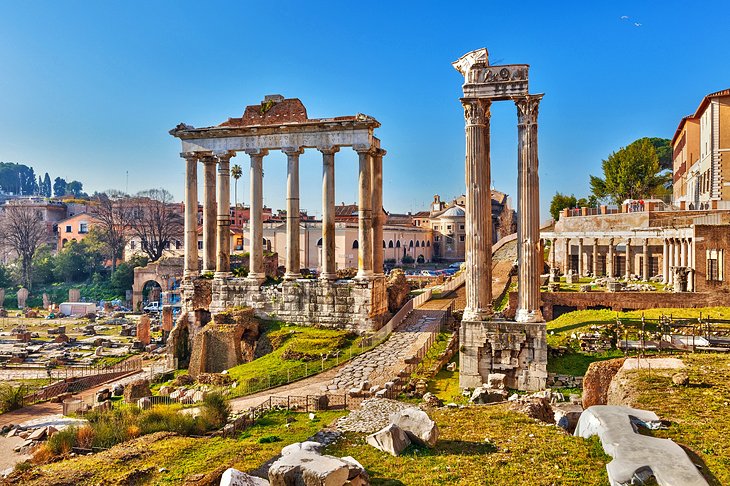
For more than a thousand years, the might of Rome, the magnificence of Roman art, and Roman law and religion found expression here and radiated throughout Europe and beyond. The first buildings here were temples, followed by public buildings.
This combination soon made the area the political center of the city–the meeting place of the courts and the assemblies that directed the affairs of the republic. Commerce soon joined religion and government, with the building of market halls that made the Forum the center of all public activity, not just for Rome, but for an increasingly large part of the continent.
By the end of the Imperial Period, the Forum was a densely built-up complex in which "modern" buildings rubbed shoulders with ancient ones, making it difficult today to identify individual buildings. This is further complicated by layers of later churches and fortresses that were built amid the ancient remains. The area served as a quarry of building stone and a cow pasture until 18th- and 19th-century excavations uncovered the Forum from a layer of dirt and rubble as deep as 15 meters.
See also: Where to Stay near the Roman Forum
1. Arch of Titus
2. basilica of constantine, 3. the curia, 4. temple of romulus, 5. temple of vesta & house of the vestals, 6. arch of septimius severus, 7. temple of saturn, 8. temple of castor and pollux, 9. temple of antoninus pius, 10. via sacra, where to stay near the roman forum, tips and tours: how to make the most of your visit to the roman forum, getting to the roman forum, nearby attractions, restaurants and cafés nearby, shopping nearby, map of the roman forum: highlights.
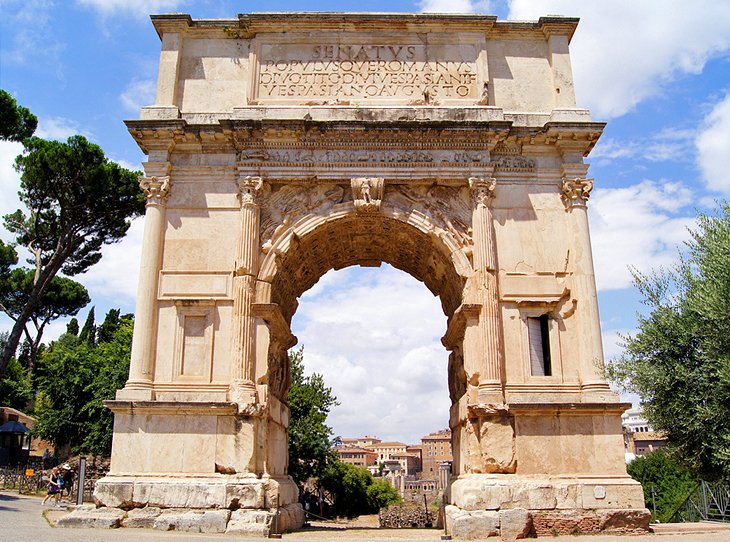
Standing at the end of the Forum farthest from the Capitol, the Arch of Titus is the oldest of the Roman triumphal arches, erected after the death of Titus by his successor Domitian. The reliefs on the arch show scenes from the victorious general's triumphal procession to the Capitol after Titus captured Jerusalem in the year 70 and thus put the final seal on the defeat of the Jewish people in Palestine.
Titus, who became Emperor in 79 AD, is shown in his chariot accompanied by the goddess of Victory holding a laurel wreath and by the booty brought back from the war - the Menorah, the table with the shewbread, and trumpets from the treasury of the Temple.
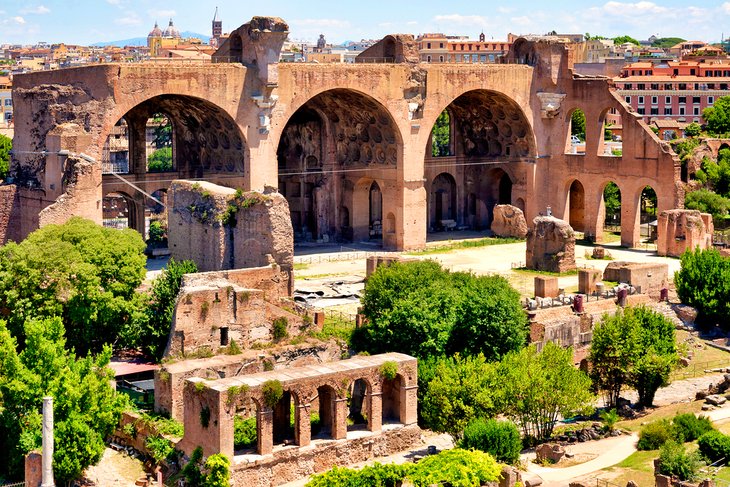
Only three soaring vaulted arches remain of what was the largest building in the Forum, but the Basilica of Constantine is still an imposing structure that towers over its surroundings. Finished by the Emperor Constantine in 303, it was begun by his predecessor, Maxentius.
The huge arched vaults still cover the remaining structure without support, an indication of the remarkable building skills of the Romans. A basilica in Ancient Rome was a courthouse and a place to make business and other transactions, with large central spaces flanked by apses, an architectural style later carried into Christian churches.
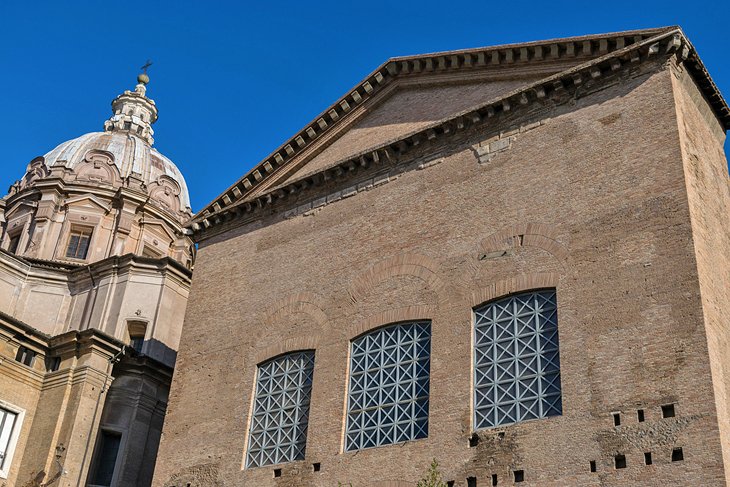
The meeting-place of the Roman Senate is one of the best preserved ancient buildings in the Forum, protected from further destruction when it was converted into a church in the seventh century. The first Curia was erected in the time of the kings and rebuilt frequently as a result of fires and other damage.
A plain and unornamented building, both inside and outside, it could seat 300 senators. Borromini adapted its bronze doors to serve as the main doorway of St. John Lateran , and the changes made to it over the centuries were stripped off between 1931 and 1937. It is now sometimes used for special exhibitions and preserves its inlaid marble floor from the third century, along with fragments of friezes.
The Anaglyphs of Trajan , two travertine slabs with reliefs depicting the emperor and the people of Rome, are displayed here. Outside the Curia and protected by a low roof is a block of black marble under which, according to legend, is the tomb of Romulus, founder of Rome. Opposite the Curia is the "newest" remnant from ancient times, the Column of Phocas , erected in 608.
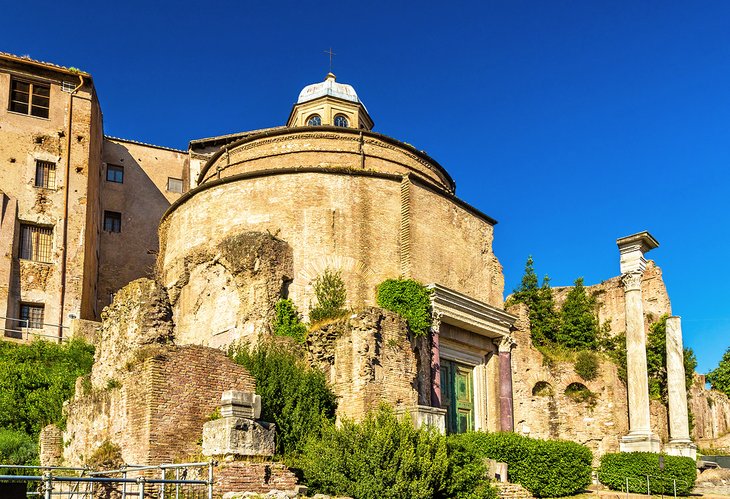
Among the best-preserved buildings in the Forum, the temple was dedicated by the emperor Maxentius to his son Valerius Romulus in 309 CE. The temple was later converted into a church, the Basilica of Santi Cosma e Damiano, which accounts for its state of preservation.
The bronze doors are the originals, and some of the 13 th -century wall paintings inside imitate the draperies that covered the walls when it was a temple. Other wall paintings are religious in nature and also date to the 1300s.
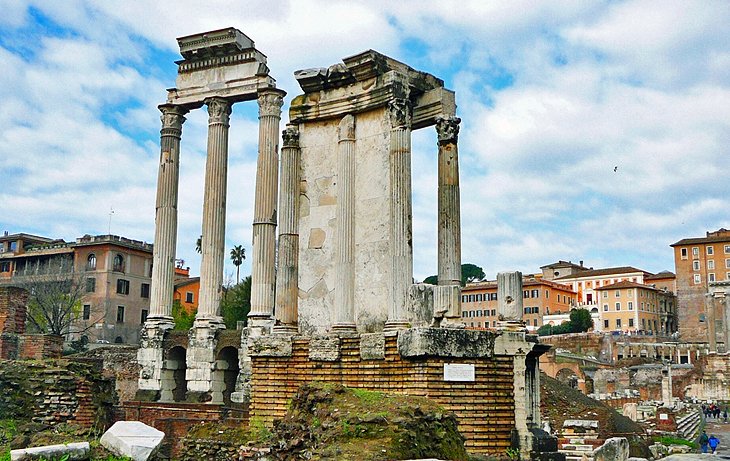
One of the most holy and important buildings in ancient Rome, the Temple of Vesta contained the Sacred Fire. The flame was guarded by the Vestals, six priestesses selected as children from the best families in Rome. This eternal fire was of great importance in Rome. On the first day of the new year, they put out the fires in their houses and lit new ones from the flame in the temple of Vesta.
The present remains, dating from the time of Septimius Severus, between AD 193 and 211, indicate that the temple was circular with 20 slender columns supporting the roof. An opening in the center of the roof let out the smoke from the sacred flame. The temple was mostly intact until the mid-16th century, when it was torn down and its marble used to build papal palaces and churches. What you see today was reconstructed in the 1930s during Mussolini's drive to reclaim Italy's ancient grandeur.
Adjoining the Temple of Vesta was the house of the Vestal Virgins, also built by Septimius Severus. You can still easily make out the plan of the building from the remains of its foundations. In the courtyard are the statues of the head vestals with inscriptions of their virtues on the pedestals. The sacred Palladium, an image of Pallas Athene brought by Aeneas from Troy, was kept in the House of the Vestals.
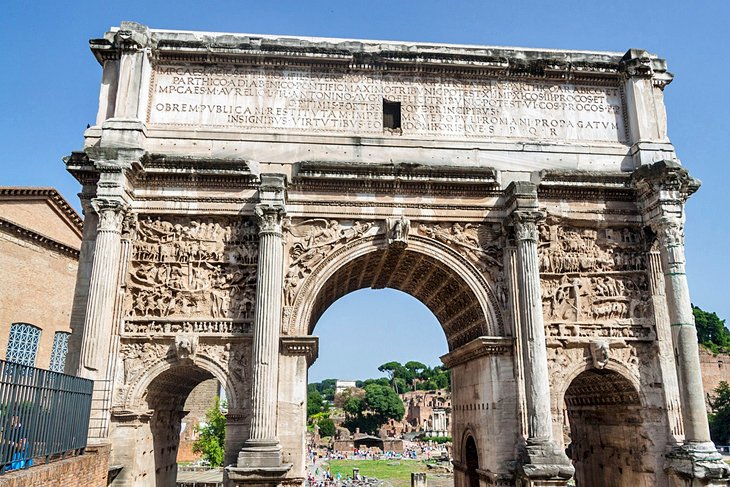
The Roman Senate and populace traditionally constructed triumphal arches honoring victorious emperors and generals, and in AD 203, this 23-meter arch was erected opposite the church of Santi Martina e Luca, to Septimius Severus and his sons Caracalla and Geta after their victories over the Parthians. On the arch, four deep marble reliefs represent episodes from these wars. Goddesses of victory hold trophies, and a large inscription proclaims the glory of the emperor and his sons (though the name of Geta was later removed).
The arch also features the base of a column commemorating the 10th anniversary of Diocletian's accession and the remains of the Rostra, the ancient orators' platform originally decorated with the prows of captured enemy ships. The arch was considered the spot of the Umbilicus Urbis, the navel or symbolic center of Rome.
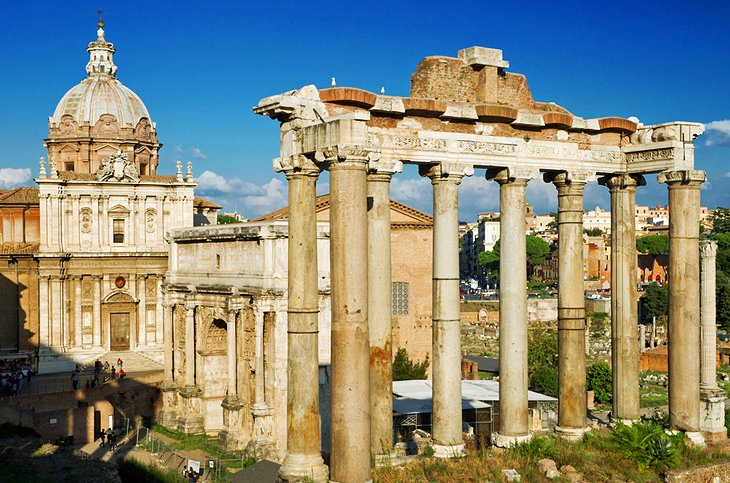
Built about 497 BC, the Temple of Saturn was one of the most important and venerated of the Republic. The first temple in the Forum, it was dedicated to the god that was probably of Etruscan origin but adopted by the Romans as the supreme god. It was destroyed by fire several times, the last in the fourth century AD, but was repeatedly rebuilt.
Under the Republic, the state treasury was kept in this temple, and annual celebrations of the Saturnalia started from here. You can recognize the Temple of Saturn by its eight weathered Ionic columns.
Adjoining the temple is a fragment of the Miliarium Aureum , the Golden Milestone, which was the starting point of the Via Sacra and all the Roman consular roads. On the stone, in golden figures, were inscribed the distance from Rome to the various provinces of the Empire.
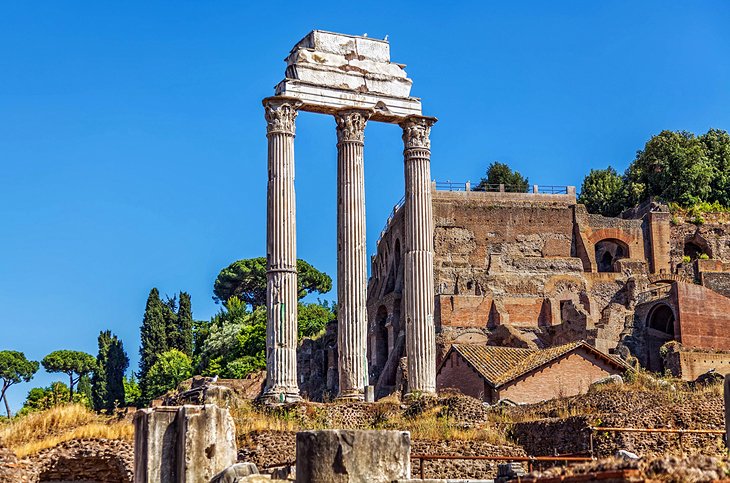
Three 12-meter Corinthian columns are all that survive from the Temple of Castor and Pollux , rebuilt in the reign of Tiberius in the first century AD to replace the original, built in 484 BC by the son of the dictator Aulus Postumius in thanks for the defeat of the Tarquins.
This victory was attributed to the help of the Dioscuri - Castor and Pollux, who were the subject of numerous myths, partly of Greek and partly of Etruscan origin. A legend held that after the victory, Castor and Pollux rode to Rome and watered their horses at a spring in the Forum. The three remaining columns are known popularly as The Three Sisters.
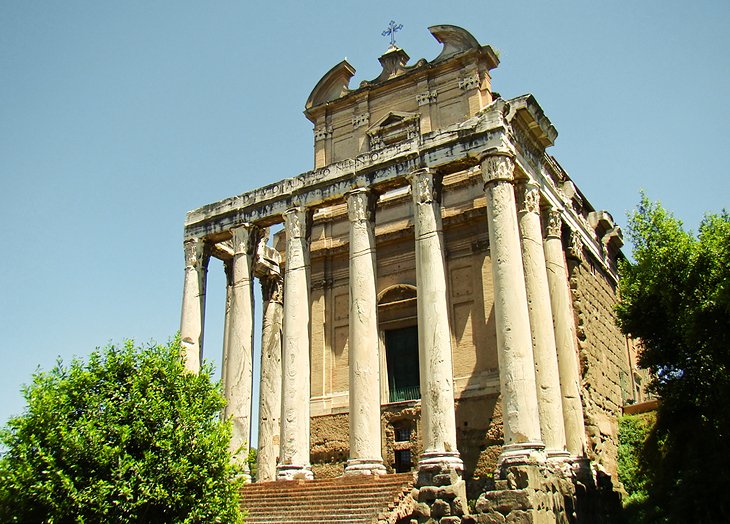
From the Via Sacra, steps leads up to the Temple of Antoninus Pius and his wife Faustina, built in AD 141 to honor the deified empress, and after his death, co-dedicated to him. Six columns with Corinthian capitals survive from the front, along with a number of columns along the side.
In the 12th century, the temple was converted into the church of San Lorenzo in Miranda, but when the Emperor Charles V visited Rome in 1536, the columns were disengaged from the medieval masonry.
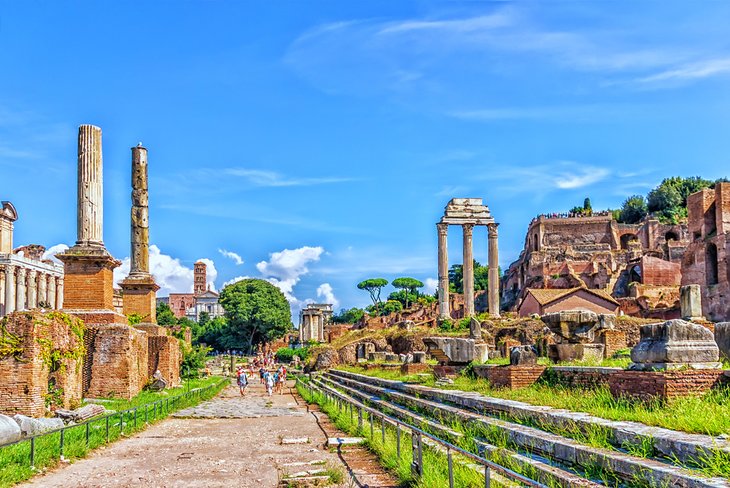
Passing under the Arch of Titus and through the Forum, the Via Sacra was ancient Rome's main street, along which triumphal processions marched between Capitoline Hill and the Colosseum . Some of the most important religious sites lay along it, and it was used daily by Romans engaging in business or socializing at the basilicas.
The Via Sacra was paved and lined by columns, and in places, you can still see the grooves made by wheels that passed over it centuries ago.

The lively, hip Monti neighborhood , north of the Forum, is a good place to look for a hotel, close to the ancient sights and within easy reach of Termini rail station. We recommend these hotels:
- The highly rated Nerva Boutique Hotel has attractive contemporary rooms, only a five-minute walk from the Forum, and serves complimentary afternoon tea and cakes to revive you after a day's touring.
- Equally close and in the upper-moderate price range , Monti Palace Hotel includes free breakfast with its modern rooms, and guests enjoy a rooftop terrace with views over the city.
- A bit farther into the Monti neighborhood, on busy Via Cavour, rooms at the moderately priced Hotel Centro Cavour are quiet, have small refrigerators, and are equipped for coffee and tea making.
- Only 100 meters from the Forum, the family-run Hotel Paba is a two-star boutique hotel with an elevator and nicely decorated rooms.
- In the same price range and also at the edge of Monti closest to Forum, Domus Real Cardello is in an elegant historic building and includes breakfast in the rate.
- Tours of the Forum and Ancient Rome: Half-day tours, in the morning or afternoon, include the Forum with the Colosseum and Capitoline Hill for a well-rounded introduction to ancient Rome. After visiting the highlights of these three sites, the three-hour Ancient Rome Half-Day Walking Tour continues on to the Pantheon, Trevi Fountain and Piazza Navona. The Skip the Line Ancient Rome and Colosseum Half-Day Walking Tour explores the Forum, Palatine Hill, and Circus Maximus, with priority-entrance tickets to the Colosseum. Both tours include a knowledgeable guide and headsets, so you can always hear the guide clearly. On either of these, be prepared for plenty of walking.
- Segway Tours: If you're not up to walking and prefer to get a broader overview of Rome's attractions, consider the Rome Segway Tour . You'll cruise past the Forum and other ancient sites on your own two-wheeled, self-balancing electric Segway (lessons and a helmet are included) listening to your expert local guide via an audio headset.
- Visiting the Forum on Your Own : The Forum is grouped with the Colosseum and Palatine Hill under one inclusive two-day ticket. You cannot re-enter any of these on the same ticket. The best time to avoid lines and crowds are early morning and around noon, when bus tour groups go to lunch.
- For Your Comfort: Wear good walking shoes. The Forum covers a large area with uneven stones underfoot. Much of the Forum is unshaded, so be sure to carry plenty to drink. You can picnic in the Forum, although Palatine Hill offers a better ambience–and shade.
- The Rome Metro Linea B, the Blue Line, stops at the Colosseum, two stops from Termini train station, but a better way to get to the Forum entrance is by any of the myriad bus lines from all over Rome that stop at Piazza Venezia.
- All the hop-on hop-off sightseeing buses stop here as well.
- Address: Via dei Fori Imperiali, Rome
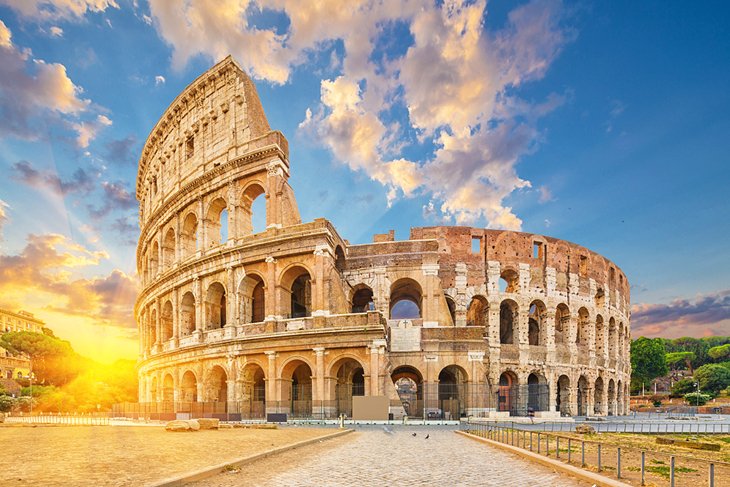
Not surprisingly, the Forum sat at the heart of ancient Rome, so many of that era's most important sights are all around it: the Colosseum , Palatine Hill , and Nero's recently excavated Domus Aurea (Golden House). It's only a short distance to the church of San Pietro in Vincoli , and the Basilica of San Clemente is not far beyond the Colosseum.
At the Colosseo Metro stop, the Oppio Caffe serves pizza and antipasto plates, and is a good stop for coffee. Right above it, on Via Nicola Salvi, is La Biga Ristoracaffe , with outdoor and indoor tables.
Or follow Via degli Annibaldi or Via Colesseo to Via Cavour, in the heart of the Monti neighborhood, where you'll find a concentration of restaurants. Trattoria Da Valentino , at #293 serves home-style Roman dishes. Even closer, opposite the Domus Aurea, Hostaria da Nerone also serves Roman comfort foods.

Via Cavour and its surrounding streets are filled with small shops and boutiques. For leather goods look for verypel , and for original designs in handmade clothing, stop at designer-owned Abito .
Momte is especially known for its vintage clothing shops. Among them are Pifebo on Via dei Serpenti, and Humana Vintage Roma on Via Cavour. For designer fashions, handcrafts, and art, don't miss the weekend Mercato Monti on Via Leonina, where young and emerging designers and artists display their works.
More Related Articles on PlanetWare.com

What to See in Rome: When you're visiting the top-rated tourist attractions in Rome be sure to see our handy guides to the top churches and the best museums and palaces . Our page on visiting Palatine Hill will help you get the most out of this less-visited attraction that's included with your Colosseum ticket.
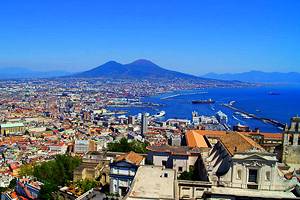
Where to Go from Rome: Many of the best places to visit in Italy are easy to reach on day trips from Rome. You can visit Pompeii and the other city destroyed by the eruption of Vesuvius in AD 79, Herculaneum , or take extra time to see the attractions of Naples .
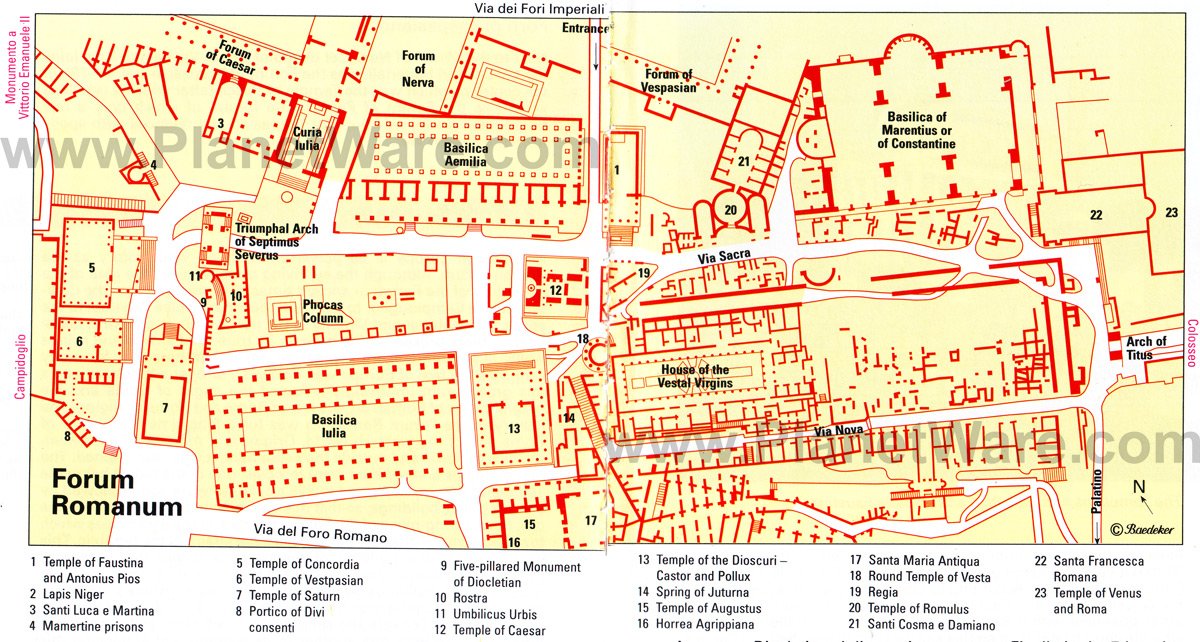
More on Italy


The Roman Forum- History, Monuments and Tips for Visiting
Purchases made through links earn us a small commission, at no extra cost to you.
Nestled in a valley between Palatine and Capitoline Hills, the Roman Forum still impresses, just as it must have centuries ago when it was the centre of Roman public life.
During my tour of the Roman Forum, I was engrossed in its rich history and fascinated by the remaining structures. Walking along the ancient streets, in the shadow of Roman monuments, the Forum quickly became one of my favourite places to visit in Rome.

About the Roman Forum- History, Purpose, Buildings
Over 900 years, buildings, temples and monuments were constructed in the forum that would serve as ancient Rome’s political, commercial and religious hub. Many of Rome’s most important structures, such as the Curia (Senate house), Temple of Saturn, and Arch of Septimius Severus were located on the Forum.
Numerous elaborate celebrations were also hosted in the Roman Forum. It was the final destination for celebratory military processions, called Triumphs, that would enter the city at the Triumphal Gate, circle around Palatine Hill and proceed into the Forum.

The Forum’s importance eventually declined after the fall of the Roman Empire. The site fell into ruin and was plundered, not by invaders, but by the Romans themselves. Precious marbles and stones were taken from the Roman Forum buildings and used to build new palaces, monuments, and churches. The site later became known as Campo Vaccino (“cow field”) after its use as pasture land during the Middle Ages.
Interest in the Roman Forum returned during the Renaissance, as architects and artists looked to classical antiquity for inspiration. Excavations began in the 18th and 19th centuries and are still ongoing.

Tour of the Roman Forum- Notable Monuments and Buildings
There are so many incredible buildings and monuments in the Roman Forum that it’s almost overwhelming. In addition to being a great place to see Roman ruins, the Roman Forum is also one of the best places to learn about Rome’s history.
These are a few highlights that stood out for me during my tour of the Roman Forum.
Arco di Settimio Severo (Arch of Septimius Severus)
Built in AD 203, this 68 foot high arch was erected in honour of Emperor Severus and his two sons Caracalla and Geta. It commemorates their two victories against the Parthians and is regarded as one of Italy’s major triumphal arches.

On both sides of the arch there is a dedication to Emperor Severus and Caracalla. The name of Septimius’ other son, Geta, was removed after he was assassinated by his own brother, Caracalla, in his quest to be sole Emperor after their father’s death.
Beside the arch is the umbilicus urbis, a stone which marks the symbolic centre of ancient Rome and to which all distances in Rome were measured.

Temple of Julius Caesar
Julius Caesar was the first Roman resident to be officially deified by the Senate. After his assassination, he was granted the title Divine Julius and in 29 BC, Augustus had a temple dedicated in his honour. The temple was built on the site where Caesar’s body was cremated and Mark Antony read his famous speech. Today, all that remains of the temple is the altar.

Basilica Aemilia
This civil basilica was a two-storey portico, 100 metres long and lined with shops. Destroyed and rebuilt several times, it was almost completely plundered for its precious marbles during the Renaissance.

Temple of Castor and Pollux
Castor and Pollux were twin brothers, the sons of Zeus and Leda. Together they are known as the Dioscuri, also the twins of Gemini. As legend holds, these Heavenly Twins astoundingly appeared to Roman troops during an important battle against the Tarquins.
The last king of Rome, Lucius Tarquinius Superbus, waged war against the young Roman Republic in an attempt to regain his throne after being exiled. Roman dictator, Aulus Postumius Albus, promised to build a temple to the Dioscuri if Rome were victorious in the battle. On the battlefield, Castor and Pollux appeared as two horseman and aided the Romans to victory. Afterwards, the twins appeared again at the Roman Forum to announce the victory.
Holding true to promise, a temple was built to honour Castor and Pollux on the site of their appearance in the Roman Forum.

Temple of Saturn
The Temple of Saturn is one of the most important ancient Roman temples. Established in 497 BC, the temple was used as the state treasury. During Caesar’s rule, large reserves of gold and silver were stored here, along with the official scale for weighing metals, and the state archives. All that remains of this grand building are eight columns and the partially preserved pediment.

Column of Phocas
This column was built to honour Eastern Roman Emperor Phocus, who had generously donated the Pantheon to the Church. The Column of Phocas was the last monument built at the Roman Forum.

Final Thoughts About My Visit to the Roman Forum
When I think about my trip to Rome, my mind always reminisces about my tour of the Roman Forum. Fascinating and beautiful, the Roman Forum had me spellbound as I imagined life in ancient Rome.
Visiting the Roman Forum not only introduced me to some of Rome’s greatest monuments, but it strengthend my love for ancient ruins and archaeological sites . The Roman Forum is definitely worth visiting and I would return here again on a future trip to Rome.

Tips for Visiting the Roman Forum
Location and Getting There: The Roman Forum is located in the historic heart of Rome, near the Colosseum and Palatine Hill. To get there, take the metro to Colosseo station.
Admission: Entrance to the Forum is included in the combined ticket for the Colosseum and Palatine Hill. Tickets must be purchased in advance online (see below for links where you can buy).
Opening Hours: The Roman Forum is open daily at 9:00 am and closing time varies throughout the year (ranging from 4:30 pm- 7:15 pm). The last entry is one hour before closing. The Roman Forum is closed on January 1 and December 25. Confirm current hours here .
Learning About the Site: When I visited, there was very little information displayed on site so be sure to bring a good guidebook, rent an audio guide, or join a tour of the Roman Forum. Without these it will be very difficult to know the significance of what you are looking at.
Information was updated April 2022, but can change without notice. Please confirm directly with service providers.
Buy Digital Tickets to the Roman Forum
For quick and convenient access to Rome’s ancient monuments, here is a trusted site where you can BUY DIGITAL TICKETS TO ROME’S ATTRACTIONS and have them immediately delivered to your smartphone (no need to print). Here are some combination tickets for the Roman Forum:
- COLOSSEUM, ROMAN FORUM & PALATINE HILL- SKIP THE LINE + ARENA FLOOR
- COLOSSEUM, ROMAN FORUM & PALATINE HILL- PRIORITY ENTRANCE
Roman Forum Tours
Here is a trusted site where you can book a tour of the Roman Forum (along with other Rome attractions). These are a few I picked out:
- COLOSSEUM TOUR WITH ARENA FLOOR AND UNDERGROUND, ROMAN FORUM, AND PALATINE HILL
- COLOSSEUM PRIVATE TOUR WITH ROMAN FORUM AND PALATINE HILL
Accommodations in Rome
For your convenience, here is a list of hotels in Rome. Please consider booking your Rome accommodations through the included link. It costs you nothing extra and helps support this website. Thank you!
More Rome Attractions and Travel Guides
- Trevi Fountain- Getting to Know Italy’s Most Famous Fountain
- Off the Beaten Path in Rome- 4 Places to Escape the Tourist Crowds
- Ostia Antica- Harbour City of Ancient Rome
- Alone in Rome- Lessons Learned From my First Solo Trip
Follow Us On Social Media
Facebook | Instagram | X | Pinterest
Join the Facebook Group
What to See in the Roman Forum
Visiting the Ancient Forum in Rome
TripSavvy / Taylor McIntyre
Top Sights at the Roman Forum
The Roman Forum is one of Rome's most important attractions . But it is a jumble of marble fragments, triumphal arches, temple ruins, and sundry other ancient architectural elements from various time periods. This run-down of some of the Forum's most important attractions runs from east to west, beginning at the Colosseum . See this map of the Roman Forum to get an idea of the layout of the ruins.
Arch of Constantine - This massive triumphal arch sits on the Piazza del Colosseo right outside of the ancient amphitheater. The arch was dedicated to Constantine in 315 A.D. to commemorate his victory over co-emperor Maxentius at the Milvian Bridge in 312 A.D.
Via Sacra - Many of the Forum's buildings are laid out along the Via Sacra, the ancient triumphal "sacred" road.
Temple of Venus and Rome - Rome's largest temple, dedicated to the goddesses of Venus and Rome, was built by Emperor Hadrian in 135 A.D. It sits on a high hill near the entrance of the Forum and is inaccessible to tourists. The best views of the temple ruins are from inside the Colosseum.
Arch of Titus - Built in 82 A.D. to commemorate Titus's victory over Jerusalem in 70 A.D., the arch contains depictions of the spoils of Rome's conquest, including a menorah and altar. The arch also was restored in 1821 by Giuseppe Valadier; Valadier included an inscription detailing this restoration as well as darker travertine marble to differentiate between the ancient and modern parts of the arch.
Basilica of Maxentius - The once-gigantic basilica is mostly a shell, of which only the northern aisle remains. Emperor Maxentius began the construction of the basilica, but it was Constantine who saw the basilica's completion. Thus, this building is also known as the Basilica of Constantine. Here is where the giant statue of Constantine, now in the Capitoline Museums , initially stood. The huge exterior of the basilica forms part of a wall running along the Via dei Fori Imperiali. On it are maps showing the expansion of the Roman Empire.
Temple of Vesta - A small shrine to the goddess Vesta, constructed in the 4th century AD and partially restored in the early 20th century. Inside the shrine was an everlasting flame to the goddess of the hearth, Vesta, and it was tended by the Vestal Virgins who lived next door.
House of the Vestal Virgins - This space contains the remains of the house of the priestesses who tended to the flame in the Temple of Vesta. Surrounding a couple of rectangular ponds are approximately one dozen statues, many of them headless, which depict some of the high priestesses of the Vestal cult.
Temple of Castor and Pollux - The twin sons of the god Jupiter were worshiped from a temple in this spot from the 5th century B.C. The ruins which remain today date from 6 A.D.
Temple of Julius Caesar - A few ruins remain of this temple, which was built by Augustus to commemorate the spot where his Great Uncle's body was cremated.
Basilica Julia - Some stairs, columns, and pedestals remain from Julius Caesar's great basilica, which was built to house law documents.
Basilica Aemiia - This building sits just inside one of the Forum entrances, at the intersection of Via dei Fori Imperiali and Largo Romolo e Remo. The Basilica was built in 179 B.C. and was used for money lending and as a meeting place for politicians and tax collectors. It was razed by the Ostrogoths during the Sack of Rome in 410 A.D.
Curia - Rome's Senators met in the Curia, one of the earliest buildings constructed in the Forum. The original Curia was destroyed and rebuilt several times, and the one standing today is a replica of one built by Domitian in the 3rd century A.D.
Rostra - Mark Antony made the speech that began "Friends, Romans, Countrymen" from this ancient dais after Julius Caesar's assassination in 44 B.C.
Arch of Septimius Severus - This striking triumphal arch at the western end of the Forum was built in 203 A.D. to commemorate Emperor Septimius Severus's 10 years in power.
Temple of Saturn - Eight columns survive from this large temple to the god Saturn, which is located near the Capitoline Hill side of the Forum. Archeologists believe that a shrine to the god existed in this space since the 5th century B.C., but these iconic ruins date from the 4th century A.D. The set of three columns that practically float next to the Temple of Saturn are from the Temple of Vespasian.
Column of Phocas - Erected in 608 A.D. in honor of the Byzantine Emperor Phocas, this single column is one of the last monuments to be placed in the Roman Forum.
Read Part 1: Roman Forum Introduction and History
Essential Ancient Sites to Visit in Rome
Where to Go in Rome to Take the Best Photos
The 25 Top Attractions in Rome, Italy
10 Top Things to Do in Rome's Monti Neighborhood
3 Days in Rome: What to See and Do
Rome's Palatine Hill: The Complete Guide
A Visit to the Forum in Rome
Rome Events Calendar
Top Roman Cities and Ancient Sites in France
The 14 Best Day Trips from Rome
Temple of Apollo at Delphi: The Complete Guide
Your Trip to Rome: The Complete Guide
Top Churches to Visit in Rome
The J. Paul Getty Museum at the Getty Villa
Top 18 Things to Do in Athens, Greece
Rome's Basilica di San Clemente
RELATED LINKS
On this page, colosseum & roman forum, major rome attractions, rome's best..., transport, tours & passes, outside rome.

- Rome hotels
- Venice hotels
- Florence hotels
- Naples hotels
- Pisa hotels
- Sorrento hotels
- Rome Fiumicino Airport
- Rome Ciampino Airport
- Venice Marco Polo Airport
- Pisa Airport
- Naples Airport
- Civitavechia (Rome) Cruise Port
- Naples Cruise Port
- Rome public transport
- Venice water bus (vaporetto)
- Florence public transport
- Naples public transport
- Sorrento local buses beyond Amalfi
Visit Roman Forum and Palatine Hill
Roman forum, palatine hill and colosseum tickets, entrance gates and tours.
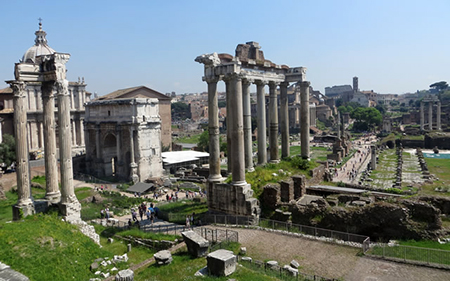
The Roman Forum (Forum Romanum) and the Palatine Hill are located in the same archaeological area and count as one admission.
The Roman Forum and the Palatine Hill are adjacent to each other and you can walk freely between the two. Both the Roman Forum and Palatine Hill have separate entrances.
The entrance ticket also gives you entrance to the Colosseum next to both and is valid for two days covering all three attractions.
About the Roman Forum Forum tickets & opening hours Buy fast track tickets Forum recommended route Roman Forum - what to expect Roman Forum & Colosseum walking tours
Roman Forum - what is it?
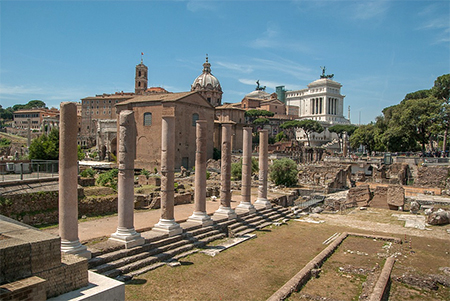
A walk around the Roman Forum is to glimpse into the founding of the ancient Roman Empire.
From what was marshland the Romans drained the area and turned it into a centre of political and social activity. The Forum was the marketplace of Rome, and later a gathering space for triumphal processions, criminal trials and gladiatorial matches.
The Roman Forum was home to some of the oldest and most important buildings in the ancient city – what you will see today is a mass of ruins, including shrines and temples, such as the House of the Vestal Virgins. The most ancient monuments at the Roman Forum are from the first kings of Rome, dating back to the sixth century BC.
The Forum was then abandoned some time in the Middle Ages, and over time, buried under layers of earth, Some temples were transformed into churches, allowing their preservation in the course of time.
During the Renaissance the area of the Forum Romanum was used as a marble and stone quarry. However, it was not until 1898 that excavations began to be carried out, revealing what we see today.
Top of the page
Roman forum - tickets, opening hours and time slots.
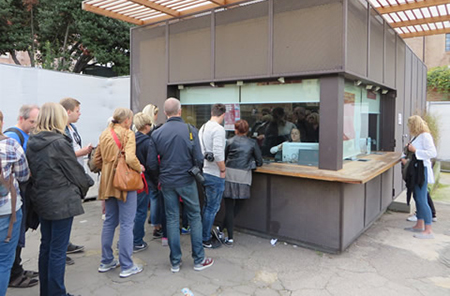
Time slot entries are now in place at the Colosseum/ Roman Forum. You are required to select your time slot in advance. You will receive a confirmation email upon booking and and on your voucher you can read how to reserve your time slot. Although you can do this at the Colosseum Ticket Office, it is sensible to do this online in advance because otherwise there is no way of securing your preferred date and time.
The standard admission ticket covers all three monuments, the Colosseum, Roman Forum and Palatine Hill.
Opening hours are from 8.30am to one hour before sunset, exact times are again on the link below:
Opening hours Colosseum + Roman Forum
You can gain Colosseum and Roman Forum entrance by:
Arriving first thing and queuing for a time slot later the same day or later that week (although still possible, this is risky because you are not guaranteed entry on the day you wish due to demand)
Buying a skip the line ticket avoiding the queues in advance for a supplement
Gaining entry using the Roma Pass
By guided tour as part of a group
Note : Within the Colosseum, there are parts you can only visit as part of a “special access” guided tour (see section below) for which the standard ticket has no validity.
Free Entrance:
Free entry on the first Sunday of the month (no reservation possible) – expect long queues
Free entry for those under 18 and discounted tickets for EU citizens aged between 18-25.
Free for EU citizens with disabilities and their companion, with valid medical documentation of the disability
Dedicated page covering all types of tickets for Colosseum and Roman Forum
Colosseum and Roman Forum - skip the line/fast track entrance tickets
Skip the Queue/ Fast Track tickets can be purchased in advance on-line with immediate delivery of tickets by e-mail.
Fast track Colosseum ticket - option 1
One fast track entry to the Colosseum and one entry to the Roman Forum/Palatine Hill
Escorted entry into Colosseum at selected time slots available throughout day
COLOSSEUM, ROMAN FORUM & PALATINE HIL VIP ACCESS 2-DAY ENTRANCE TICKETS
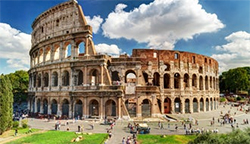
• Fast track entry Colosseum/ Roman Forum + Palatine Hill • Choice of time slots all day • Option to add Gladiator's arena • Audio guide available • Choose from independent entrance ticket or small group tour
Fast track Colosseum ticket - option 2
Entrance through fast track entrance gate with later time slots than option 1
• Fast track entry Colosseum/ Roman Forum + Palatine Hill • Later time slots than option one • Tickets are valid for 2 days after your first visit at the selected date • Free audio guide available
Visiting the Colosseum, Roman Forum & Palatine Hill - entrances and recommended route
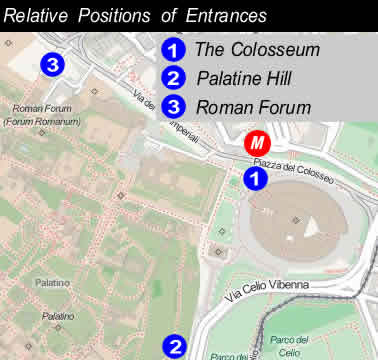
Main entrance
The main entrance gate for the Roman Forum is along the Via die Fori Imperiali between the Colosseum and Piazza Venezia, near the Piazza Venezia end. There is an exit gate from the Roman Forum close to the Colosseum. You cannot enter the Roman Forum at the gate nearest the Colosseum, this gate is just an exit.
The natural flow of a visit is to exit the Roman Forum at the Colosseum end of the site. You cannot enter or re-enter at this gate though. There are also exits at the Capitoline Hill end of the site, but again no entrance. The Palatine Hill towering above you is also linked both ways to the Roman Forum.
Where are the shortest queues?
The ticket kiosk at the Colosseum has by far the longest queues; we suggest you start and buy your ticket at the Palatine Hill entrance.
The ticket gate for the Palatine Hill often has no queues at all and is midway down the road Via di San Gregorio that runs from the Colosseum along the base of the Palatine Hill less than 5 minutes' walk from the Colosseum. Many of the hop-on hop-off sightseeing buses and tour buses board and drop between the Colosseum and the entrance to the Palatine Hill.
From the Palatine Hill entrance, walking uphill exploring the Palatine Hill is more gradual than from the Roman Forum and has more shade. After performing a circuit of the Palatine Hill you will get a great birds' eye view down onto the Roman Forum as you descend into it, getting a good initial orientation in the process.
The entrance of the Roman Forum is a long way from the Colosseum, but there is an exit only gate right next to the Colosseum.
Roman Forum - what to expect and facilities
The Roman Forum is a large area to cover with little shade, so do bring along plenty of fluids.
Another thing to bear in mind is that there are no food outlets at the Roman Forum. If you have, for example, spent the morning at the Colosseum and you go straight on to the Forum, be prepared to have a later lunch by the time you have walked round this ancient site.
Time needed to visit the Roman Forum
Most people allow a half day to visit the Roman Forum and Palatine Hill with the Colosseum. If you have a real interest in the subject matter you will need a day.
Your ticket allows you to see all three parts over two days (re-entry is not permitted) so you could take a more leisurely approach visiting the Colosseum on a separate day to the Roman Forum and Palatine Hill.
Colosseum & Roman Forum walking tours
Taking a walking tour with an expert guide with headphones and fast track entrance tickets provided is an efficient and cost effective way of covering the Colosseum, Palatine Hill & Roman Forum in around 3 hours.
Option 1 - Colosseum, Palatine Hill & Roman Forum walking tour
Skip-the-line access to the Colosseum, Roman Forum, and Palatine Hill
Groups of 25 people or fewer
Departure times available morning or afternoon
Informative, friendly and professional guide, headphones available
SKIP THE LINE: COLOSSEUM SMALL GROUP TOUR WITH ROMAN FORUM & PALATINE HILL
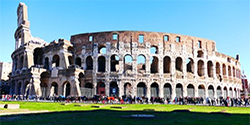
• Fast track entry Colosseum/ Roman Forum + Palatine Hill • 3-hour tour • Expert guide • Small group tour
Option 2 - Colosseum, Palatine Hill & Roman Forum walking tour with special access
With access to the Colosseum arena floor, the underground chambers and the third tier
Small groups of 12 people or fewer (select option after choosing date)
Departure times available morning or afternoon but limited availability
SKIP THE LINE: COLOSSEUM SMALL GROUP TOUR WITH ROMAN FORUM & PALATINE HILL WITH
Special access.
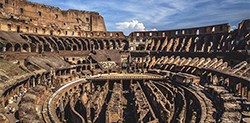
• Fast track entry Colosseum/ Roman Forum + Palatine Hill • With special access to higher levels & underground chambers • 3-hour tour
(Price shows after selecting date)
Ancient Rome walking tours including the Colosseum, Palatine Hill & Roman Forum
The Colosseum, Palatine Hill & Roman Forum are just one part of ancient Rome.
This tour also includes top icons the Pantheon and Piazza Navona (Roman circus).
On this small group tour with a maximum of 18 people you can be sure to have just the right amount of attention from your guide.
ANCIENT ROME WALKING TOUR + SKIP-THE-LINE COLOSSEUM
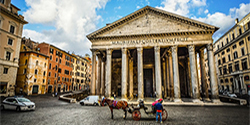
• Fast track entry Colosseum/ Roman Forum + Palatine Hill • Pantheon and Piazza Navona • Small group tour • Professional guide
MOST POPULAR ROME TOURS 2024
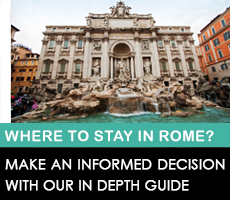

- Top Attractions
- Tourist Attractions
Roman Forum
Located between Piazza Venezia and the Colosseum, the Roman Forum was the hub of political and social activity of the Roman citizens.
The Roman Forum was where religious and public life in ancient Rome took place . The Forum is, along with the Colosseum , the greatest sign of the splendor of the Roman Empire that can be seen today.
After the fall of the Empire, the Roman Forum was forgotten and little by little it was buried under the earth. Although in the 16th century, the existence and location of the Forum were already known, it was not until the 20th century that excavations were carried out.
Interestingly, the place where the Forum was built was originally a marshy area. In the 6th century B.C., the area was drained by means of the Cloaca Maxima , one of the first sewer systems in the world.
Points of interest
Besides the great number of temples that are in the forum (Saturn, Venus, Romulus, Vesta, etc.), it's worth paying special attention to the following points of interest:
- Via Sacra : This was the main street in ancient Rome that linked the Piazza del Campidoglio with the Colosseum.
- Arch of Titus : This is a triumphal arch that commemorates Rome's victory over Jerusalem. It was built after the death of the emperor Titus.
- Arch of Septimius Severus : An arch erected in the year 203 A.D. to commemorate the third anniversary of Septimius Severus as the emperor.
- Temple of Antoninus and Faustina : Built in the second century, the Temple of Antoninus and Faustina sets itself apart as the best-preserved temple in the Roman Forum.
- Basilica of Maxentius and Constantine : Though now mostly destroyed, its size suggests that this was one of the most important buildings of the Roman Forum.
- The Curia : In this building, the Senate met to make administrative decisions about the Roman government.
- Column of Phocas : Erected in the year 608 A.D. in honor of the emperor of Byzantium, this column, which is over 13 meters high, is one of the few that have remained standing since being built.
Visiting Rome without walking around the Forum is like going to Paris without seeing the Eiffel Tower. As you travel along the Via Sacra, close your eyes and imagine it as it was more than 20 centuries ago, when Julius Caesar walked there .
The best way to skip the line and get to know the Forum in detail is to take a guided tour . We'll visit three of the main monuments in the city, the Colosseum, Roman Forum, and Palatine Hill, skipping the line, and all with an expert guide.
If you prefer to discover it on your own, we recommend that you head first thing in the morning, as this is when people head to visit the Vatican . You can also skip the lines with the Rome Pass discount card.
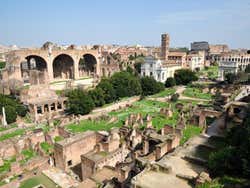
Between the Colosseum and Piazza del Campidoglio .
Every day: 8:30 am until 7 pm 25 December and 1 January: closed
Combined ticket to visit the Colosseum, the Roman Forum and the Palatine : Adults: € 16 ( US$ 17.30) European Union members (18 – 24): € 2 ( US$ 2.20) Children (ages less than 17) and seniors (over 65) members of the EU: free entrance
Colosseum, Roman Forum & Palatine Hill Tour € 50 ( US$ 54)
Metro : Colosseo , line B (blue).
Nearby places
Piazza del Campidoglio (335 m) Capitoline Museums (348 m) Arch of Constantine (407 m) Santa Maria in Aracoeli (412 m) Palatine Hill (424 m)
You may also be interested in
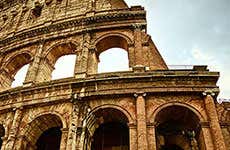
Known as the Flavian Amphitheatre, the Roman Colosseum is one of the capital's most remarkable monuments. Every year over 6 million people visit it.
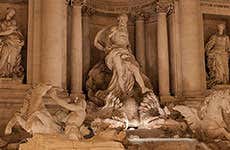
Trevi Fountain
Have you been told to throw a coin into the Fontana di Trevi? Learn the myth behind this tradition and learn about its history.
The Roman Forum
Book your individual trip , stress-free with local travel experts
- roughguides.com
- the-roman-forum
- Travel guide
- Itineraries
- Local Experts
- Travel Advice
- Accommodation
The five or so acres that make up the Roman Forum were once the heart of the Mediterranean world, and, although the glories of ancient Rome are hard to glimpse here now, there’s a symbolic allure to the place, and at certain times of day a desolate drama, that make it one of the most compelling sets of ruins anywhere in the world.
Roman Forum Visitor Information
Entrances to the roman forum.
Entrances: Largo della Salara Vecchia, halfway down Via dei Fori Imperiali; at the Arch of Titus near the Colosseum; by the Temple of Venus; and on Via di San Gregorio (via the Palatine).
Roman Forum opening hours
Daily: mid-Feb to mid-March 8.30am–5pm; mid- to end March 8.30am–5.30pm; April–Aug 8.30am–7.15pm; Sept 8.30am–7pm; Oct 8.30am–6.30pm; Nov to mid-Feb 8.30am–4.30pm; last entry 1hr before closing.
Roman Forum tickets
€12 combined ticket with Colosseum and Palatine Hill , valid for two days; free first Sun of the month.
Via Sacra to the Curia
You need some imagination and a little history to really appreciate the place but the public spaces are easy enough to discern, especially the spinal Via Sacra, the best-known street of ancient Rome, along which victorious emperors and generals would ride in procession to give thanks at the Capitoline’s Temple of Juno. Towards the Capitoline Hill end of the Via Sacra, the large cube-shaped building is the Curia, meeting place of the Senate, which was built on the orders of Julius Caesar as part of his programme for expanding the Forum, although what you see now is a third-century-AD reconstruction. Inside (under restoration at the time of writing), three wide stairs rise left and right, on which about three hundred senators could be accommodated with their folding chairs.
Arch of Septimius Severus and around
Near the Curia, the Arch of Septimius Severus was constructed in the early third century AD by his sons Caracalla and Galba to mark their father’s victories in what is now Iran. Next to the arch, the low brown wall is the Rostra, from which important speeches were made (it was from here that Mark Anthony most likely spoke about Caesar after his death), to the left of which are the long stairs of the Basilica Julia, built by Julius Caesar in the 50s BC after he returned from the Gallic wars. A bit further along, on the right, rails mark the site of the Lacus Curtius, the spot where, according to legend, a chasm opened during the earliest days of the city and the soothsayers determined that it would only be closed once Rome had sacrificed its most valuable possession into it. Marcus Curtius, a Roman soldier who declared that Rome’s most valuable possession was a loyal citizen, hurled himself and his horse into the void and it duly closed.
Temple of Castor and Pollux and House of the Vestal Virgins
Next to the Basilica Julia, the enormous pile of rubble topped by three graceful Corinthian columns is the Temple of Castor and Pollux, dedicated in 484 BC to the divine twins or Dioscuri, who appeared miraculously to ensure victory for the Romans in a key battle. Beyond here, the House of the Vestal Virgins is a second-century-AD reconstruction of a building originally built by Nero: four storeys of rooms set around a central courtyard, fringed by the statues or inscribed pedestals of the women themselves, with the round Temple of Vesta at the near end.
The Basilica of Maxentius and the Arch of Titus
Almost opposite the House of the Vestal Virgins, a shady walkway to the left leads to the Basilica of Maxentius, in terms of size and ingenuity probably the Forum’s most impressive remains. Begun by Maxentius, it was continued by his co-emperor and rival, Constantine, after he had defeated him at the Battle of the Milvian Bridge in 312 AD. From here the Via Sacra climbs more steeply to the Arch of Titus, built by Titus’s brother, Domitian, after the emperor’s death in 81 AD, to commemorate his victories in Judea in 70 AD and his triumphal return from that campaign.
Top image: Roman Forum in Rome, Italy © Andrey_Popov/Shutterstock
Tailor-made travel itineraries for Italy, created by local experts

8 days / from 2646 USD
Experience the hit TV show 'The White Lotus' in Sicily
Stay in beautiful Taormina with gorgeous views of Mount Etna and discover Sicily, including famous filming locations. Go on exclusive wine tastings, discover the Greek theater in Taormina with a private guide, visit other Sicilian towns and enjoy the crystal clear water on this week-long trip.

8 days / from 3289 USD
Enchanting Italian Lakes
Experience the picturesque lakes of Northern Italy, including Lake Garda, Como, Lugano and Maggiore; explore the charming Borromean Islands – former favourites of Ernest Hemingway – and stroll the romantic streets of Verona and Milan. All of this, and much more, with this self-drive trip!

16 days / from 3289 USD
From Venice to Florence: A Grand Tour of Northern Italy
From the atmospheric canals of Venice and the picturesque coastline of Cinque Terre, to the trendy designer boutiques of Milan and the Renaissance-infused streets of Florence, Northern Italy has plenty to offer. Experience it all with this comprehensive trip.
Tailor-made trips for Italy
The Rough Guides to Italy and related travel guides
In-depth, easy-to-use travel guides filled with expert advice.
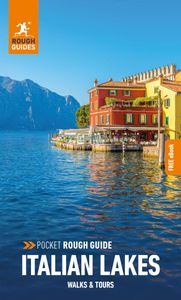
Find even more inspiration here

written by Eleanor Aldridge
updated 26.04.2021
Ready to travel and discover Italy?
Get support from our local experts for stress-free planning & worry-free travels.
- Where to stay
- Travel advice

Stories by Soumya
The Travel Blog of a Culture Addict

Visiting Roman Forum – Hours, Tickets, And All You Need To Know
Last Updated on December 23, 2021 by Soumya
Visiting the Roman Forum? Planning to add this stunning Italian landmark to your Rome itinerary? Keen to find out all about Roman Forum tickets, opening hours, and guided tours?
Well, you are in luck. Because we have just the perfect Roman Forum travel guide for you.
Rome’s historic center, a UNESCO World Heritage Site, is home to 3 iconic monuments – the Colosseum, the Palatine Hill, and the Roman Forum. Colosseum refers to the ancient amphitheater. Palatine Hill housed the palaces of Roman emperors and the Forum was the official center.
After writing an in-depth travel guide for the Colosseum, I was inspired to put together a similar one for visiting the Roman Forum. Planning a trip to these huge historical landmarks can be a little overwhelming especially with so many things to do and plan before you go. But we are here to help you.
As you take time to plan your Italy trip , make sure to have this Roman Forum guide in your Rome arsenal. Here, you will find everything you need to plan an epic trip to the Forum in Rome including details on tickets, opening hours, history and best things to do.
Table of Contents
What is the Roman Forum?

The Roman Forum, or Forum Romanum for Latin, is a rectangular-shaped plaza in the center of Rome.
Many centuries ago, the Forum was the heart of all events and gatherings in the city. It was where Romans held elections, affairs of public speaking, commercials, criminal trials, and, of course, gladiator matches. Shop and stalls lined these streets. Many of the oldest and most significant government offices were located at the Roman Forum, or at least nearby.
The historical impact of the Roman Forum is overwhelming because it was once the epicenter of Ancient Rome and was even known to be the most important and celebrated meeting place in the history of the world.
Nowadays, its ruins are open for exploring and touring. If you want to get deep into the history of Italy, particularly the capital city Rome, visiting the Forum is one of the best things to do in Rome . After the Colosseum, of course!
Also see: Ultimate guide for visiting the Roman Colosseum
Please note: This post may contain affiliate links which means I may earn a commission if you make a purchase by clicking a link on this post. This will be at no additional cost to you. Affiliate links help me keep this website up and running. Thanks for your support!
History of the Forum
According to legends surrounding the Forum, it was initially built as a sign of an alliance between the creator of Rome, Romulus (he lived on Palatine Hill), and his rival, Titus Tatius (he occupied Capitoline Hill). Since there was a valley at a convenient location between the two settlements, the rulers decided to build a forum there, where the two communities could meet due to their newly-acquired peace.
The first time people began meeting here was when the Roman Republic was founded in 500 BC. It gradually expanded over time, especially noticeably during the reign of Julius Caesar. At one point, Caesar even had to acquire additional ground to make space.
However, as time passed. more and more political and economic gatherings started happening in other areas. The Forum was used less frequently. Gradually, it fell into disuse and most of it was destroyed around the time the Roman Empire began to fall in 410 A.D.
When you are at the Forum, try and imagine all the great emperors that addressed their people right here, with looming columns and precisely carved sculptures in the background. Gives you goosebumps, right?
The Roman Forum in recent past
A famous archeologist Carlo Fea rediscovered the Forum in 1803, but it took over a hundred years to thoroughly search the site and excavate the ground.
If you explore closely, you might still see the structural damage on the concrete made by heavy rains in 2008.
In 2020, Italian archeologists discovered a sarcophagus without a clear understanding of who it was for. Many debates eventually led them to believe that it might have been built for Romulus, the founder of the city.
Now, Roman Forum is a top-rated tourist attraction. Visitors are allowed to indulge in walking tours around the Forum and experience the vast architecture of Ancient Rome firsthand.
Archeological diggings are still active to this day because historians are sure that there are still many secrets that lie beneath the grounds of this ancient plaza.
Things to do at Roman Forum
The Roman Forum is filled with incredible things to do, most of them buildings and temples from ages ago. Here are some of the unmissable ones.

Via Sacra is the main street that crosses this establishment.
According to legends, this street is where Romulus won over Titus Tatius. Not only that but Via Sacra was also used for triumphant marching of the leaders after every big win. Later on, the street was used for military parades.
Walk with your head held high, and inhale the pride and power of the Romans, still lingering in the air.
Temple of Antoninus and Faustina
After walking Via Sacra, stop at the Temple of Antoninus Pius and Faustina.
A remarkable building in the Roman Forum, this temple is hard to miss. Its ten looming columns will catch your eye in an instant.
Roman Emperor, Antoninus Pius built the temple for his wife Faustina, who died in 141, making her the first empress to be deified. After the death of Antoninus, the temple was re-dedicated to both of them.
Between 600 – 800 AD, the temple was incorporated into the church of San Lorenzo.
Temple of Saturn

The Temple of Saturn is the most iconic of all surviving buildings in the ancient plaza. After all, this is the temple that we always see in pictures of the Roman Forum, don’t we?
This is one of the oldest sacred sites in the Forum and was dedicated to the Saturn, Roman God for seed-sowing and agriculture. It was originally built in the 5th century BC, destroyed by a fire, rebuilt in 42 BC, and again restored between 3rd and 4th century AD. The eight ionic columns that we see today belong to the 1st century BC.
Since Saturn was the God of agriculture and food, this temple held great importance for the Romans. It functioned as the State Treasury and a storehouse for the Empire’s reserves of gold and silver. It was also home to bronze tablets on which the Law of the Twelve Tables was inscribed. Plus, functioned as a safehouse for state archives, standards, and official weighing scales.
The Curia Julia

What looks like a plain, unexciting building from outside once used to be the meeting place of the Roman Senate. The Curia Julia is probably the world’s oldest senate buildings in existence today.
Julius Caesar commissioned the Curia in 44 BC but Augustus Caesar completed it in 29 BC. A fire damaged the building in 2nd century after which it was restored. Today, it is one of the best-preserved buildings in the Forum which was eventually turned into a church dedicated to St. Adrian in the 7th century.
Septimius Severus Arch
You cannot miss the ruins of Septimius Severus Arch, one of the most impressive monuments in the Roman Forum.
Built in 203 AD to commemorate the victories of Emperor Septimius Severus over the Parthians, the triumphal arch stands out among the ruins of the Roman Forum today. It is almost 70 feet high, built of white marble, and has 4 reliefs (in various states of repair) that show scenes from the Parthian wars.
Practical information for v isiting Roman Forum
The Forum is located right between the Colosseum and Palatine Hill. You will find all three of these legendary places in the heart of Rome, reachable by buses and metro if you are staying a little further away!
The exact address is Via della Salara Vecchia, 5/6, 00186 Roma, according to Google. You will find the Forum’s main entrance along Via dei Fori Imperiali between the Colosseum and Piazza Venezia.
How to get to the Forum in Rome?
The simplest way to get to the Forum is by taking the metro to Colosseum, Line B. It brings you right to the place; the Forum will be on your right when you get off.
You can also take a bus or tram. Bus numbers 75, 81, 673, 175, and 204 and Tram #30 are the ones that stop next to the Colosseum.
And of course, you can always take a cab. Just be ready with some cash because some of them will not accept card payments.

Opening hours
The Forum is open every day from 8 am to 7 pm except on December 25th and January 1st.
According to latest updates on the official website , the Forum is open from 9am – 4:30pm between 1st Nov, 2021 – 28 Feb, 2022. Be sure to check before visiting.
Roman Forum tickets and prices
It is a good idea to buy a ticket that combines visits to all three supersites (as the Romans call them) – the Colosseum, the Palatine Hill, and the Roman Forum.
A 24-hour ticket to all three costs €18 (price € 16 and reservation fee € 2) and that includes one timed-entrance for the Colosseum and one open entrance each for the Forum and the Palatine Hill. Get all details here .
One important point to remember is that you will need a free ticket for kids including small ones in strollers. Be sure to reserve them online in advance.
If you are look for a fast track ticket, buy yours here .
Best tours for visiting Roman Forum
Tours of the forum and ancient rome.
They include long and thorough walks through the Colosseum, Palatine Hill, and the Roman Forum. Some tours also include other famous monuments, such as the Pantheon, Trevi Fountain, and Piazza Navona. These are the ones that are the most tiring but will leave you the most knowledgeable too!
Here are a few great Ancient Rome tours to choose from.
Segway or bicycle tours
If you are not keen to walk around and prefer not to drive, try a Segway tour like this one or an electric bike tour like this one .
If you are a DIY person, then there is always the choice to travel independently and explore Rome’s gems on your own including visiting the Roman Forum. Be sure to grab a copy of this travel guide to plan a memorable visit.
There is a lot to take in but it is better to be well prepared for seeing such an important site as the Roman Forum. My last piece of advice would be that you take your time. Soak up as much as you can and do not leave until you have learned everything you want to know. Just have fun!
All images sourced from Canva Pro.
Visiting the Roman Forum? Pin this ultimate Forum guide.
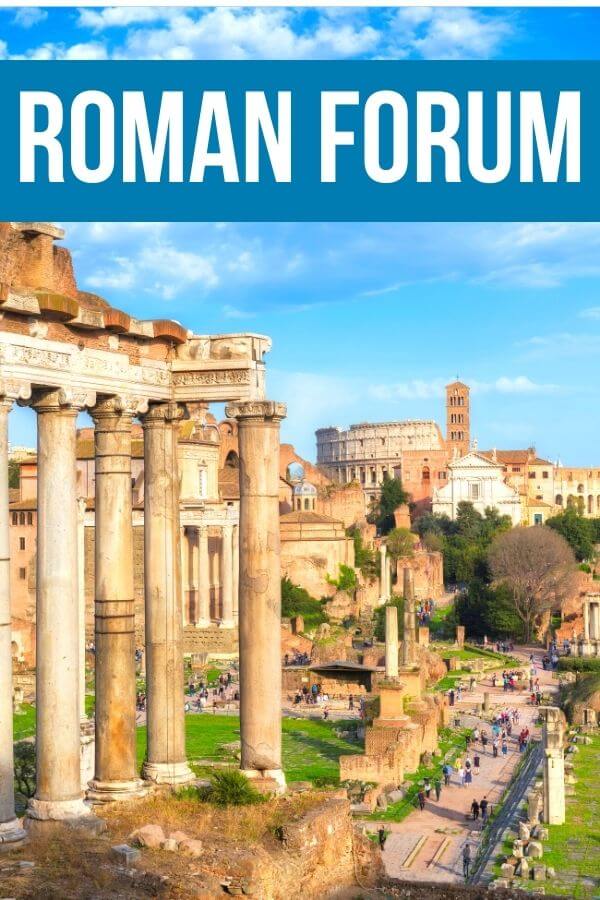
You may also like:
- 10 Must-Do Things In Rome
- A Complete Guide To Visiting The Colosseum In Rome
- Conímbriga Roman Ruins - A Fascinating Day Trip From Coimbra
Leave a Reply Cancel reply
Your email address will not be published. Required fields are marked *
Post Comment
This site uses Akismet to reduce spam. Learn how your comment data is processed .
Begin typing your search term above and press enter to search. Press ESC to cancel.
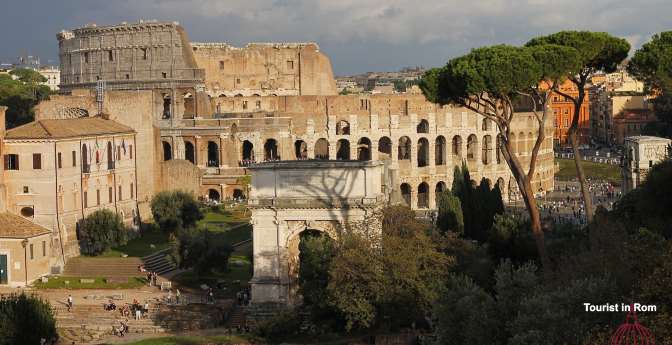
Discover the Roman Forum & Palatine – this is how to do it
With a little trick you save a lot of time when visiting the Imperial Forums, Roman Forum and Palatine and take the most beautiful route.

Partner-Links helfen uns dabei, unsere Informationen kostenlos bereitzustellen. Für abgeschlossene Buchungen erhalten wir eine Provision – ohne Mehrkosten für Sie! Mehr
Partner links help us to provide our information free of charge. For completed bookings we receive a commission – at no extra cost to you! More
I link dei partner ci aiutano a fornire gratuitamente le nostre informazioni. Riceviamo una commissione per le prenotazioni completate, senza alcun costo aggiuntivo per voi! Di più
Popular tickets and tours
GetYourGuide
How to save time
With the exception of the night tour of the Colosseum, all tickets include a visit to the archaeological park of the Forums and the Palatine. You can visit the park in the 24 hours before or after your reservation for the Colosseum. If you have the Colosseum entrance time in the early morning, you will visit the park more after, if you have the reservation for the afternoon, you better go to the park before.
The most beautiful route
The most beautiful route is also the fastest. Instead of going from Piazza Venezia to the Colosseum via Via dei Fori Imperiali, you go directly through the Imperial Forums and the Archaeological Park.
As an entrance, or an exit if you visit the park after the Colosseum, take the entrance at the Forum of Trajan. You cannot miss it. Already from Piazza Venezia you can see the column of Trajan in the middle of the Forum. The entrance is in Piazza della Madonna di Loreto. From there to the Arch of Titus, which is the closest to the entrance to the Colosseum, you need an hour. For the Palatine you will need another hour. It also takes an hour to visit the Colosseum. So in total you will need 3 hours.
The Imperial Forums
The imperial forums were built by Caesar and later emperors. They set monuments to themselves and showed their power. But new forums were also necessary, because the existing forums were no longer sufficient.
The Roman Forum
The Roman Forum is the oldest forum and is part of the National Museum of the Colosseum. It is the historical center of Rome and the oldest forum for trade, administration and court proceedings in ancient Rome. Here you will find impressive ruins and architectural masterpieces, including the Temple of Romulus, the House of the Vestal Virgins and the Ramp of Domitian. A guided tour of the Roman Forum is recommended to learn more about the history and significance of these sites.
The Palatine Hill
The Palatine is one of the seven hills of Rome and was probably inhabited 3,000 years ago. Later, dignitaries and rich citizens lived here and the emperors built their palaces here.
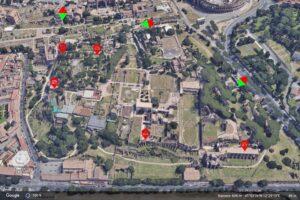
The Palatine is very large and it is easy to get lost there. There are some very nice viewpoints and you can take nice photos of the Colosseum, the Circus Maximus, the Roman Forum and the Capitol Hill. It will take you more than an hour to do this.
On the satellite photo we have marked some viewpoints in red.
You can find more details in our article Ancient Rome .
There are three entrances to the archaeological park consisting of the Roman Forum and Palatine Hill. There is also the entrance to the Imperial Forums.
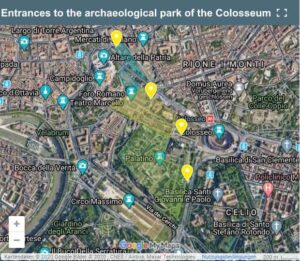
Depending on whether you visit the park before or after the Colosseum and what you want to see, you can choose different entrances. The entrances are:
- Via Sacra: Entrance at the Arch of Titus between the Roman Forum and the Palatine. This entrance is closest to the Colosseum.
- Via di San Gregorio: entrance to the Palatine.
- The entrance to the Forum of Trajan at Piazza Venezia / Piazza della Madonna di Loreto
- The entrance at Via della Salara Vecchia near the Roman Forum, serves only as an exit
- There is another exit to via Petroselli.
Full Experience
With the Full Experience ticket you can visit the arena in the Colosseum and some archaeological sites of the park and the museum on the Palatine.
The archaeological sites are part of the SUPER Ticket Seven Unique Places to Experience in Rome, currently offered only as Full Experience. Only a limited number of visitors are allowed to visit the different sites at the same time.

For Rome lovers and cultural experts, a visit to these sites is mandatory. Some sites may be closed for restoration work.
The opening times are:
House of Augustus 40 minutes max. 23 visitors
Curia Iulia
House of Livia 30 minutes max. 23 visitors
Santa Maria Antiqua with Oratory of the 40 Martyrs and Ramp of Domitian 30 minutes max. 60 visitors
Temple of Romulus 15 minutes max. 30 visitors
Palatine Museum ~ 1h
Emperor Nero’s Domus Transitoria
Criptoportico Neroniano 12 minutes max. 35 visitors
Aula Isiaca + Loggia Mattei 15 minutes max. 15 visitors
Opening hours
Roman Forum and Palatine have the same opening hours as the Colosseum:
From the beginning of winter time – end of February: 8:30 am – 4:30 pm
March – end of winter time 8:30 am – 5:30 pm
From the beginning of summer time – August 31, 9 am – 7:15 pm
September 9 am – 7:00 pm
October 1st – end of summer time 9 am – 6:30 pm
Eating around the Colosseum
There are few gastronomic highlights around the Colosseum. The top restaurant Aroma with a view of the Colosseum is located in Via Labicana on the top floor of the Hotel Palazzo Manfredi, In Via di San Giovanni in Laterano you can eat very well at Isidoro. At Isidoro you can order very tasty mixed antipasti or mixed 1st courses (Primi). Also in the side streets there are some quite nice restaurants. You will find a larger selection if you walk down Via dei Fori Imperiali and then turn right into Via Cavour. Angelino ai Fori is just on the corner. You will certainly find what you are looking for there and in the Monti Quarter beyond. You can also go down Via dei Fori Imperiali to Piazza Venezia and then left to Torre Argentina and left again to the ghetto. There you will find mainly Roman cuisine.
More about the Colosseum
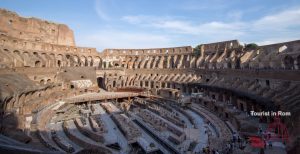
Colosseum Rome · Tickets & tours · Useful information
The Colosseum, originally called the Flavian Amphitheatre, is an iconic symbol of Rome and one of … >>>
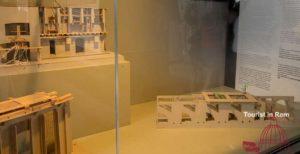
How the Colosseum Worked · Archaeological Research
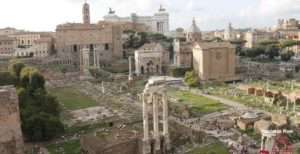
Walk through Ancient Rome · with 3D animations
Suggested combinations
After you have rested a little, you can think about how to proceed. The obvious thing to do is to visit the Caelius Hill with the beautiful churches that are located there. Or you can go up the Oppius Hill to the Basilica of San Pietro in Vincoli and continue towards Monti. Or maybe you’d like to go to the city center to see the Trevi Fountain and Spanish Steps, and to do some shopping.
If you want to see more ruins, you can also go to the Baths of Caracalla. With the bus 118 you can get to the catacombs on the Via Appia Antica.
Very relaxing is the onward journey with the hop on hop off buses . The bus stop is in Via di San Gregorio at the entrance to the Palatine. You can take buses 40 or 64 from Piazza Venezia to the Vatican.
Via San Giovanni in Laterano
Via di San Giovanni in Laterano starts from the Colosseum. Past the excavations of a gladiator school and the Basilica of the Dominican San Clemente, this small, cozy street with nice bars, restaurants and shops leads to the Basilica of San Giovanni and the Holy Stairs and on to Via Appia Nuova.
Oppius Hill
On the north side of the Colosseum rises the Oppius Hill, in which Emperor Nero’s Domus Aurea is buried. The golden palace can only be visited on weekends because excavations are carried out during the week.
There are picturesque streets on the Oppius. The Basilica of San Pietro in Vincoli is a well-known attraction.
If you continue along Viale Monte Oppio, you will come to the Basilica of Santa Maria Maggiore.
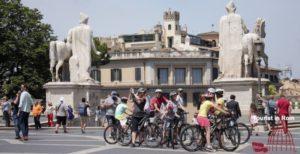
What's on in Rome
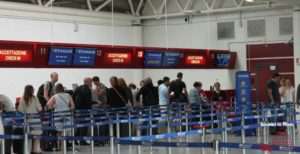

Select your language
The Roman Forum
The Roman Forum was the pulsing heart of Rome, the city’s main piazza where citizens of every social level met to exchange opinions, do business, buy in the markets and renew their strength over a tasty dish and a cup of good wine.

The Colosseum
The most famous show business building in the world

Entrance of the Roman Forum
The main entrance

The Basilica Emilia
A magnificent building for the administration of justice

The Curia Julia - Senate
The political heart of Rome as well as the rest of the known world

Via Sacra and the Arch of Septimius Severus
Discovering the fascinating rituals of the Triumphs

Rostrums, Umbilicus Urbis, Miliario Aureo
“Zero point” of the Roman world

Temple of Saturn
One of the best-known views of the Roman Forum

The backdrop of the Forum and the ancient State archives

Central Piazza
The liveliest part of the Roman Forum, filled with people and rich with symbols.

Julia Basilica
A magnificent building, center of justice and meeting point for the common people

Temple of Castor and Pollux - the Dioscuri
A Greek temple in Romeʼs heart

Temple of the Divine Iulius
Homage to the “divine” Julius Caesar that continues over the centuries

Temple of Vesta and the House of the Vestal Virgins
The fascinating story of the mysterious guardians of the sacred fire

Temple of Antoninus and Faustina
An edifice that carries the traces of centuries

Temple of Romulus
An intact temple inside a church

Basilica of Maxentius
The final and most impressive building ever built in the Forum

Temple of Venus and Rome
Homage to beauty and to the Eternal City in one magnificent temple

Arch of Titus
An Emperorʼs triumph told by an arch

From the cityʼs origins to the splendid residences of the powerful, with Rome at their feet

Arch of Constantine
The greatest and most imposing arch to celebrate the first Christian emperor
Roman Forum Map
Interactive map and pdf to download.
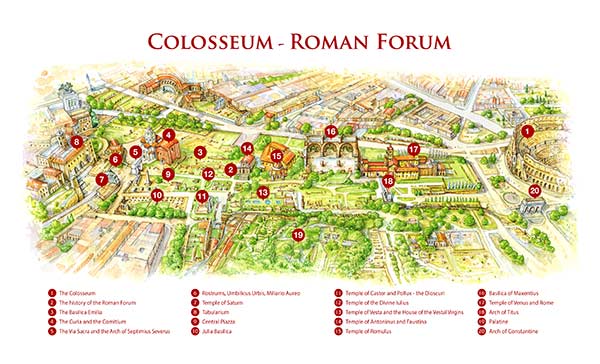
Download the Map of Roman Forum in PDF
What to see in the Roman Forum

The Roman Forum served as Rome's bustling core, a meeting place for citizens of various social classes, where business was conducted, shopping occurred, and fine food and wine were enjoyed. It was a crowded and cosmopolitan space, attracting people from around the world, including wealthy merchants , slaves , Roman nobles , and vendors .
Today, the Roman Forum , situated between Piazza Venezia and the Colosseum , stands as a crucial archaeological site. Originally, this area was marshy, but thanks to the Cloaca Maxima , an incredible engineering feat commissioned by the last two Etruscan kings , it was drained and developed into a hub of markets and social activities as early as the 7th century BC.
The term "Foro" was used to describe the central square of the urban settlement , a place for gatherings, trials, and entertainment. Surrounding the Forum were shops , markets , and taverns , including the ancient "Termopolia," precursors to modern fast food. During Julius Caesar 's time, the Forum became a place of celebrations, symbolizing the Empire during the imperial era.
The most incredible panoramic view of the Forum can be seen from the terraces of Campidoglio , featuring the ruins of Basilica Emilia and the Curia, the Senate's seat. The pathway leads through unique sites like the Basilica di Massenzio , ending near the Arch of Titus , with a view of the unmistakable Colosseum .
During the Middle Ages , the Forum fell into disrepair and was abandoned, with its monuments repurposed for medieval fortifications. Only in the 18th century did the process of recovering the ancient ruins begin, breathing new life into this long-forgotten and pillaged historical heritage.
- © ComPart Multimedia
- Privacy Policy

- * Cruises *
- Australia/ New Zealand
- * Group Travel *
- South America
- Cinque Terre
- Monte Carlo
- St. Petersburg
- North America
- Palma de Mallorca
- More…
- Many more cities!!!
- Cartagena, Columbia
- St. Maarten
- Accessible Cruise Advice
- Accessible Cruise Deals
- 6 Benefits of Booking Your Cruise with Sage Traveling
- Egypt Accessible Tours and Cruise Excursion
- French Riviera
- 7 Night Accessible London Group Trips – August 21-28, 2024
- 12-Night Escorted “Best of Scandinavia” Accessible Baltic Group Cruise. Celebrity Eclipse, July 4-16, 2025
- 10-Night Escorted “Greek Isles and Turkey” Accessible Group Cruise. October 6-16th, 2025.
- London Individual Package Deals
- FREE Newsletter
- Top 10 Disabled Travel Tips
- More Disabled Travel Tips
- 25 Things Can Go Wrong
- 50 Accessible Vacations
- Disabled Travel Insurance
- Disabled Travel FAQ’s
- More Advice…
Wheelchair Accessible Tour of the Roman Forum and Colosseum
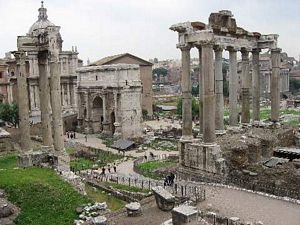
This Roman Forum and Colosseum accessible tour visits the two greatest remnants of Ancient Rome: the Colosseum towering overhead and the Roman Forum sunken below street level. The Colosseum is wheelchair friendly, and the Roman Forum, which has some obstacles, can also be visited in a wheelchair.
The views and the photo opportunities are some of the best in Rome, but to really understand what events led to their creation, their use, and their demise, you’ll need the explanation of a local expert. What are those holes in the walls of the Colosseum? Why do people leave flowers on that dirt mount in the Roman Forum? Why was that victory arch built? Learn everything you have ever wanted to know about Ancient Rome on this tour.
Tour Highlights
– Roman Forum – Coliseum – Temple of Antoninus and Faustina – Arch of Titus – Arch of Septimius Severus – Basilica of Maxentius – Roman Senate – Temple of the Vestal Virgins – Temple of Saturn – Temple of the Divine Julius – Arch of Constantine
Accessibility Description
This Rome accessible guided tour tackles some of the oldest ruins in Rome. The Colosseum has been completely modernized and has smooth flat pavement throughout it except for a small band of cobblestones shown on our Colosseum disabled access page. An elevator leads up to the second level of the Colosseum for a different viewpoint.
The Roman Forum and Colosseum accessible tour travels along the sidewalk connecting the Colosseum and Roman Forum which is flat and smooth. At the Roman Forum entrance, you will find an elevator that can take you down into the ruins. Once you get there, only about 20% of the grounds are wheelchair accessible. The other 80% have large gaps in the rocks and ancient stairs. A video of the accessibility challenges for this Roman Forum and Colosseum accessible tour is shown on our Roman Forum disabled access page.
* Important note: Wheelchair accessible transportation is not included on this tour. Private wheelchair accessible van pick-up at your hotel can be reserved in advance for 110 euro each way.
Tour Details
Tour duration: 3 hours Cost: €425 for 1-2 people. €490 for 3-4 people. €555 for 5-6 people.€650 for 7-8 people. Entrance tickets: Not included. Entrance tickets to the Colosseum are free for disabled visitors plus one companion if they have a letter from their doctor describing the disability and stating the percentage of their disability. Otherwise €35 per adult, students between 18 years old €4 (College ID required) **Price subject to change. * €20 off if booked as part of an accessible Rome travel package (Note: if your package includes more than 3 tours total, discounts will be applied to maximum 3 of the tours). Days of the week the tour is offered: Every day of the week Meeting time: 9 am or 2 pm Meeting place: The lobby of your accessible hotel in Rome or at the location provided in your itinerary Dress code: None Number of people on tour: Up to 8 people Entrance tickets: not included. Free for one disabled person and one companion.€4 for people under 18, €25 for adults. Not included: Snacks/meals, gratuities, and transportation.
Contact us to reserve your accessible tour
Rome Accessible Travel – main page Pros and Cons of Rome Disabled Access 10 Wheelchair Accessible Travel Tips for Rome Italy 10 Keys to Success for Rome Disabled Travel Getting Around Rome with a Disability Wheelchair Access Review of the Vatican Wheelchair Access Review of the Colosseum Wheelchair Access Review of the Roman Forum Civitavecchia Port Disabled Access Review Civitavecchia Accessible Shore Excursions Travel Insurance for Disabled Travelers Rome Accessible Travel Packages Accessible Walking and Driving Tours in Rome Wheelchair Accessible Vatican Tour Ancient Rome Accessible Tour Accessible Guided Tour in Rome City Center Vatican Wheelchair Accessible Guided Tour – 5 Hours Vatican Wheelchair Accessible Guided Tour – 3 Hours Roman Forum and Colosseum Accessible Tour Accessible Guided Walking Tour in Rome – 5 Hours Wheelchair Accessible Walking Tour – Rome in a Day Accessible Borghese Gallery Tour Disabled Tour of the Capitoline Museums Accessible Wine Tasting Tour in Rome Disabled Rome Golf Cart Tour Rome Wheelchair Accessible Van Tour – Full Day Rome Handicapped Driving Tour – 5 Hours Rome at Night Handicapped Driving Tour Accessible Hotels in Rome Rome Accessibility Guide by John Sage Rome Trip Planning by Sage Traveling – Travel with Ease! Accessible Cruising with Sage Traveling – Receive our Rome Accessibility Guide & Rome accessible hotel recommendations for free!

Get our 100% Free Accessible Travel Advice Newsletter
- Learn the secrets of how to travel in Europe with a disability
- Receive a €50 Accessible Travel Coupon for signing up!
- 100% free advice

"We could go on and on but this was the best trip that we could ask for. Our next trip will definitely be through you..." Read More...
"The Paris Accessibility Guide is the most valuable travel document I have ever encountered…" Read More...
"We had a splendid time in Europe, thanks to all your planning. We remarked again and again how difficult it would have been without your planning! Thanks again for the wonderful trip!" Read More...
"I wanted to let you and Mr. Sage know that we loved our accessible private tour of the Vatican…" Read More...
"Let me thank all you guys at Sage Traveling. I got my scooter in Berlin. It was a brand new Orion…" Read More...
"I am a wheelchair user and have just returned with my husband from a cruise which started in Istanbul and ended in Venice. The information you provided on both these cities was absolutely invaluable…" Read More...
"The hotel you recommended was very centrally located and within convenient walking distance to the Louvre and Notre Dame. We even walked to the Latin quarter and to the boat tour! Thank you again for making our trip a wonderful and manageable experience…" Read More...
"I just wanted to thank you for an excellent experience in Paris. The wheelchair was delivered exactly on time and we’ve been everywhere with it over the last two days…" Read More...
"We will certainly recommend your services to others and use you again in the future…" Read More...
Don't just take our word for it!
Listen to what our clients have to say about..." Read More...
Dear Danielle
Thank you once again for organising my recent trip to Edinburgh. It was very enjoyable and was helped considerably..." Read More...
Having just returned from Paris and thoroughly enjoyed our River tour and meal on Boat Dinner tour, I feel I..." Read More...
Emily's purse was stolen with our passports and credit cards in Delft so we had to rejuggle our travel plans..." Read More...
A quick note to let you know our tour guide in Barcelona was wonderful. She was there dead on the..." Read More...
We are back home - tired from the long flight but it was a wonderful trip. Weather chilly and..." Read More...
We have now returned from an absolutely amazing trip – largely due to the excellent arrangements made by Sage..." Read More...
You have truly been amazing, my mother & I thank you from the bottom of out hearts she would have..." Read More...
Dear Danielle,
You were so right about the hotel in Bruges! It's just lovely! We love it and Bruges. Thanks for..." Read More...
It was a seamless experience, wheelchair arrived exactly on time, was lightweight and comfortable. Highly recommended.
-Mark Florida, USA Read More...
Hi Danielle,
Just a note to thank you for arranging the hire of the wheelchair in Bruges. Without it we would..." Read More...
Hello Danielle :)
Well we are all home safe and sound and really missing Brugge :(
The holiday was excellent, everything that..." Read More...
Hello Donna,
I am writing to you to advise that my Parents - Alexander & Irene have just returned from Istanbul..." Read More...
I would like to comment on what an excellent 2 trips we had in Rome. The guide was very knowledgeable..." Read More...
Dear Donna,
Let me thank all you guys at Sage travels. I got my scooter in Berlin. It was a brand..." Read More...
Jennifer, I wanted to thank you! We had an amazing trip. Everything went as planned and we are so grateful..." Read More...
Dear John and Donna:
David and I would like to say a BIG, "Thank You" for all of your help in regards to..." Read More...
Jennifer, Best family vacation EVER! We certainly couldn't have done this without you and Sage Travel'. You were our best..." Read More...
Margaret from the UK describes how the Istanbul Accessibility Guide and Venice Accessibility Guide helped on her trip. The Accessibility..." Read More...
Donna and John,
I have been meaning to write to you to thank you for helping us to arrange the wonderful..." Read More...
Accessible Destinations
Disable Travel Advice
Accessible Trip Planning
Accessible Cruising
Accessible Ports
Shore Excursions
Destinations
Accessible Travel Packages
Sage Access Guides
Group Trips
More Advice...

Passing Thru Travel
Ultimate Guide to Destination Weddings 2024 – Top 15 Locations and Insider Tips
Posted: March 8, 2024 | Last updated: March 8, 2024
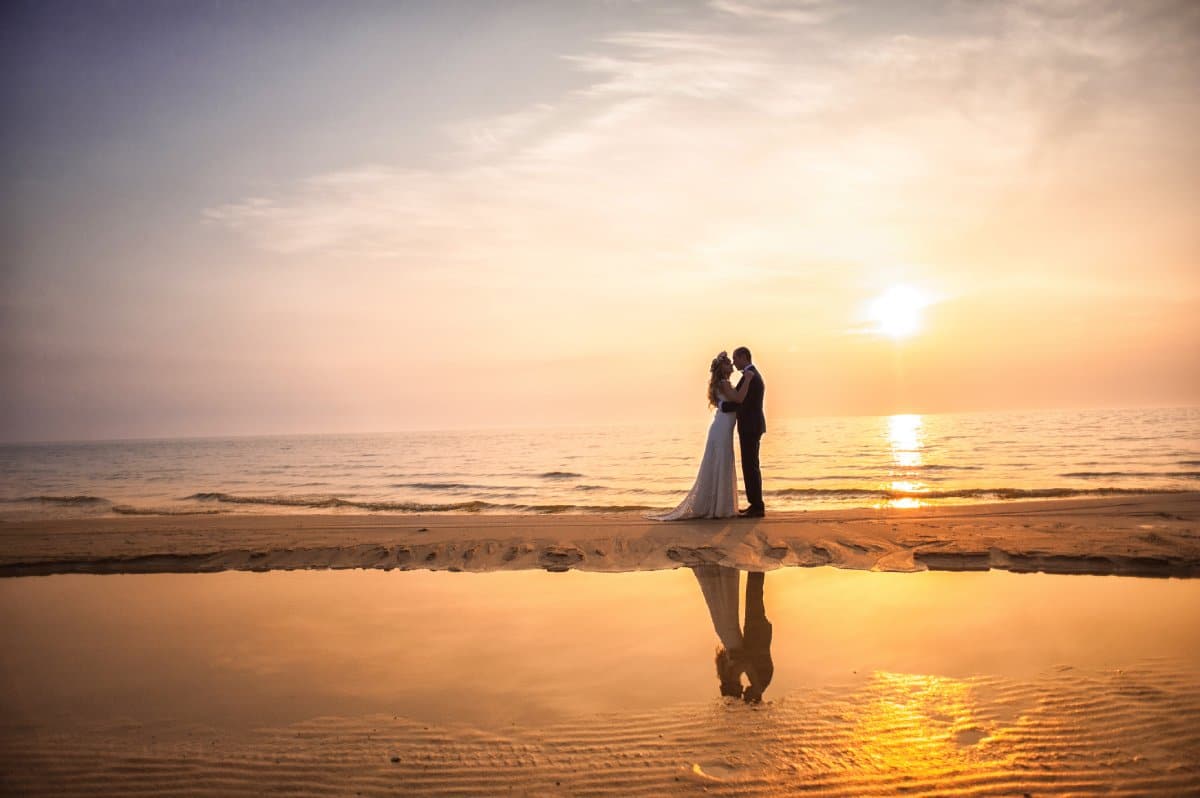
Destination weddings offer an extraordinary experience, combining the joy of a wedding with the excitement of travel. This guide explores the world’s most sought-after wedding destinations, each offering unique allure and enchanting backdrops. From pristine beaches to historic castles, these venues cater to diverse tastes and styles. Alongside each destination, insider tips, optimal travel times, and access information are provided, ensuring your special day is as seamless as it is memorable.
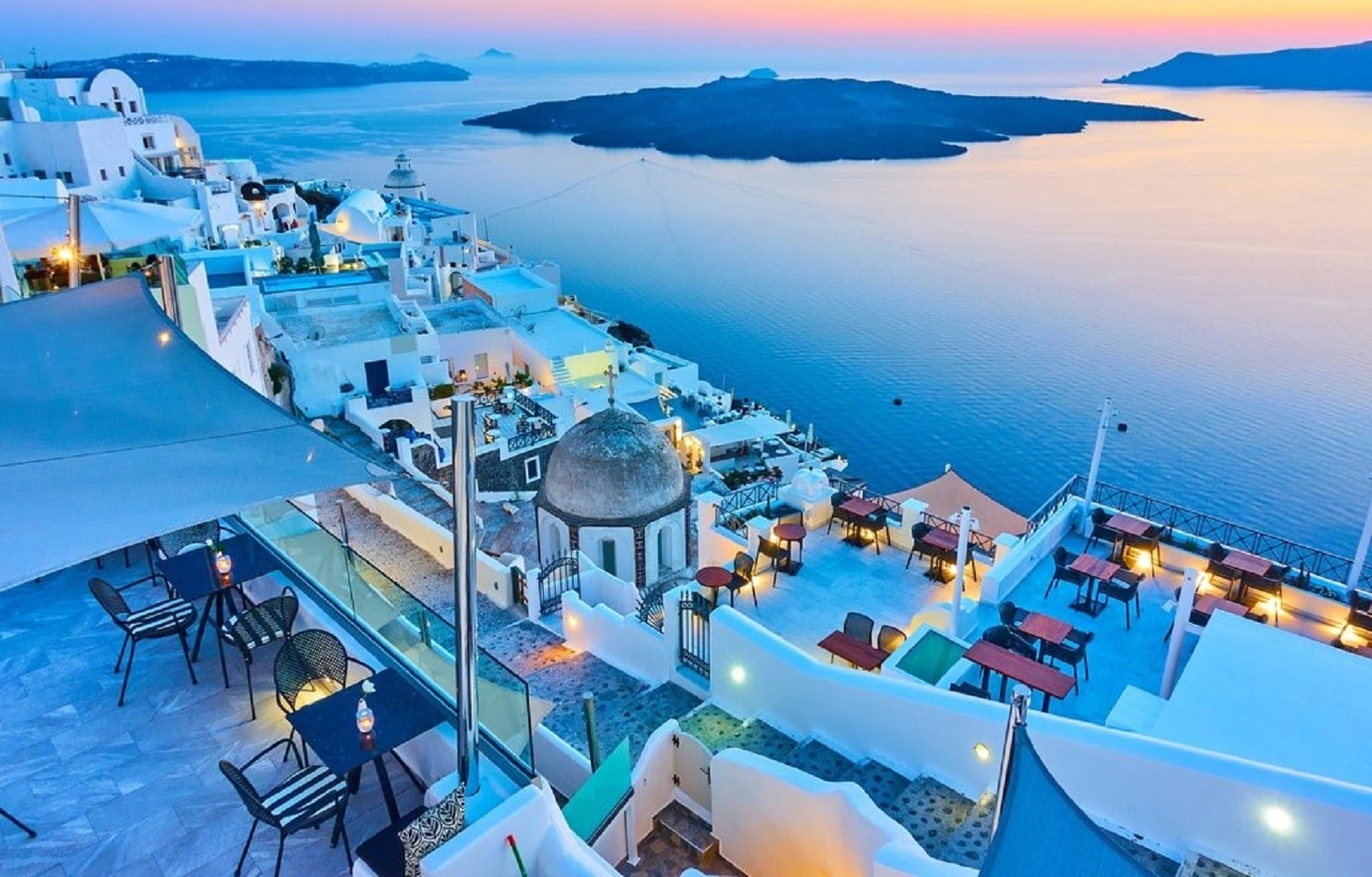
1. Santorini, Greece
Embrace the quintessential Greek island experience with a wedding in Santorini. This island, celebrated for its dramatic cliffs, classic Cycladic architecture, and panoramic views of the Aegean Sea, offers an idyllic setting for your special day. The contrast of the stark white buildings against the deep blue of the sea creates a stunning backdrop for wedding photos.
Venues here range from luxurious resorts to traditional wineries, each providing a unique angle to view the island’s famous sunsets. Santorini is not just about picturesque landscapes; its culinary offerings, especially fresh seafood and local wines, will delight your guests.
Imagine saying your vows as the sun dips below the horizon, casting a golden glow over the caldera — a moment of pure magic. The island’s charm and excellent hospitality ensure your wedding will be both romantic and memorable.
Insider’s Tip: Book a venue on the island’s western side for the best sunset views during your ceremony.
When to Travel: Late spring to early fall, for optimal weather.
How to Get There: Fly to Athens and take a domestic flight or ferry to Santorini.
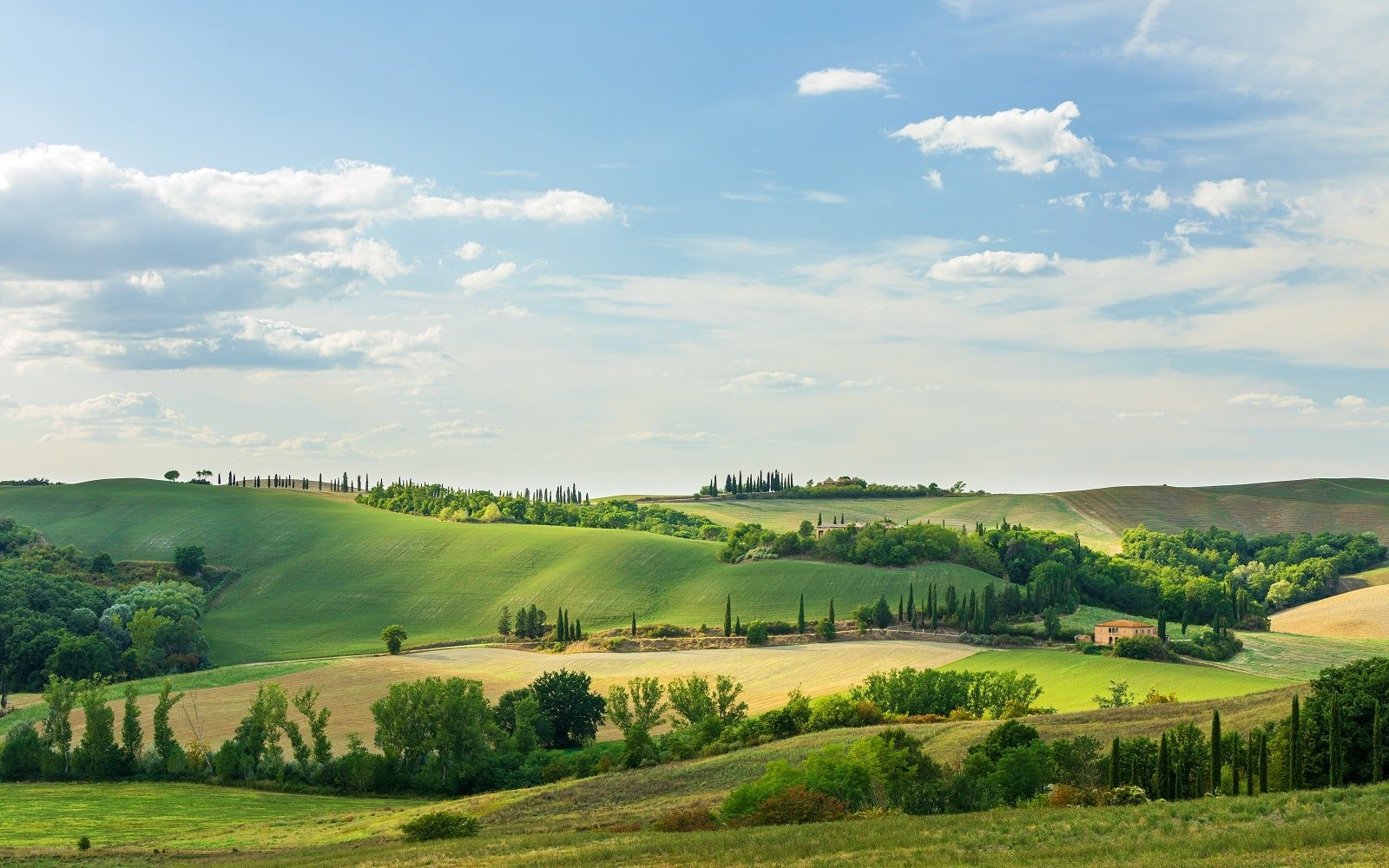
2. Tuscany, Italy
Imagine your wedding amidst the rolling hills of Tuscany, a region that epitomizes the soul of Italy. Known for its rich history, art, and gastronomy, Tuscany provides a rustic and sophisticated setting. The region is dotted with historic villas, medieval castles, and sprawling vineyards, each offering a unique backdrop for your ceremony and celebrations.
Picture yourself exchanging vows in an ancient chapel or amidst rows of grapevines, followed by a reception featuring some of Italy’s finest wines and culinary delights. The natural beauty of Tuscany, with its picturesque landscapes and golden light, adds a timeless quality to your wedding photos.
Moreover, the region’s central location allows for easy exploration of Italy’s other cultural gems, making it an ideal choice for those who wish to extend their celebration into a wider Italian journey.
Insider’s Tip: Consider a historic villa or a castle for an authentic Tuscan experience.
When to Travel: Late spring or early autumn for pleasant weather and fewer tourists.
How to Get There: Fly to Florence or Pisa, then travel by car or train to your chosen locale in Tuscany.
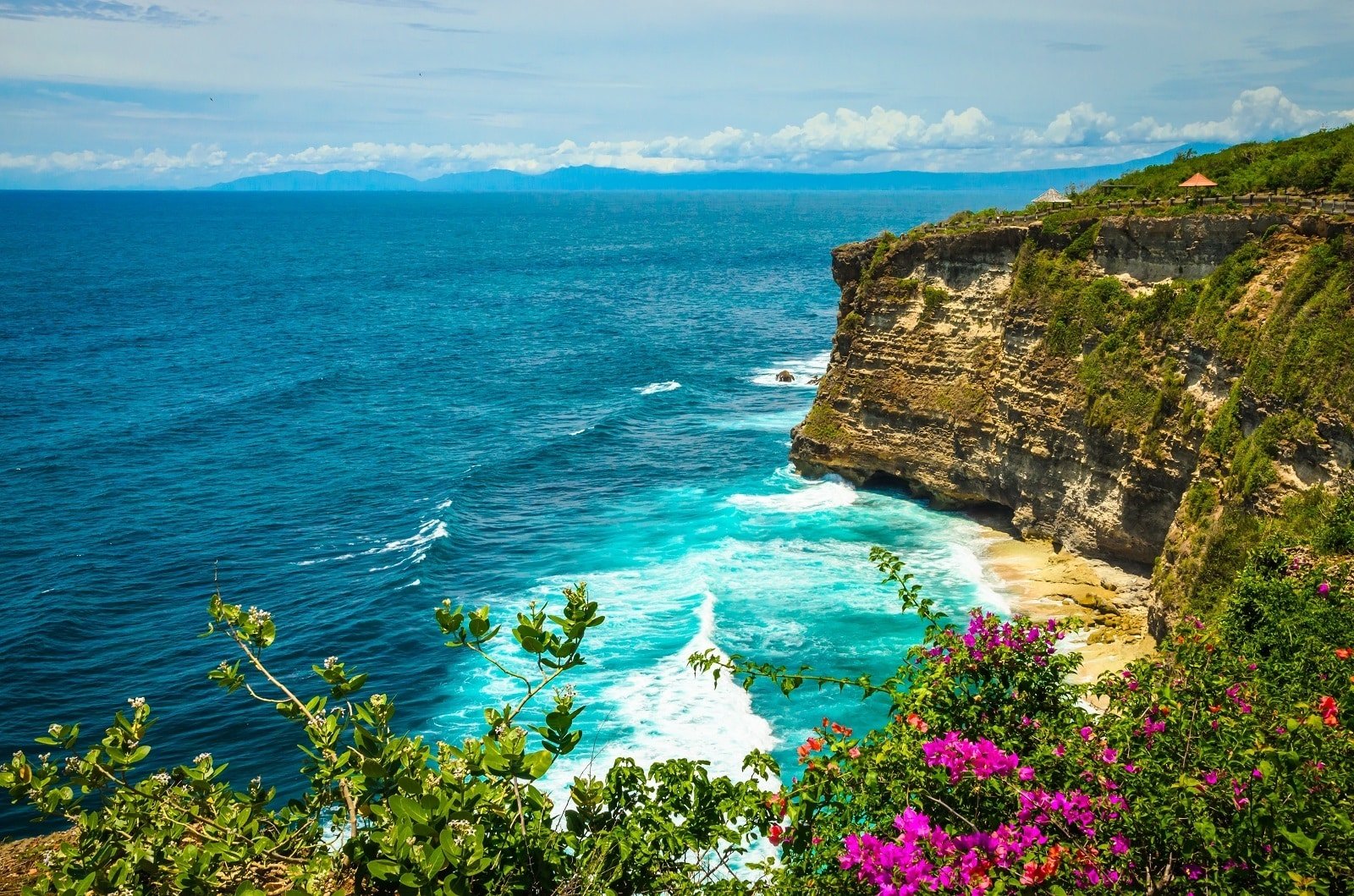
3. Bali, Indonesia
Bali, known as the Island of the Gods, offers a mystical and exotic setting for your destination wedding. This tropical paradise blends natural beauty with cultural richness, providing your ceremony with diverse options. From pristine beaches and lush jungles to ancient temples, Bali’s landscapes are as varied as they are stunning.
Luxury resorts on the island specialize in hosting weddings, offering packages that often include traditional Balinese elements, adding an authentic touch to your celebration. The island’s unique culture, known for its intricate art and spiritual practices, can also be integrated into your wedding, making the experience deeply personal and culturally immersive.
The warm hospitality of the Balinese people, coupled with the island’s natural beauty, ensures that your wedding in Bali will be both enchanting and unforgettable.
Insider’s Tip: Choose a clifftop venue in Uluwatu for dramatic ocean views.
When to Travel: April to October, during the dry season.
How to Get There: International flights are available to Ngurah Rai International Airport in Denpasar.
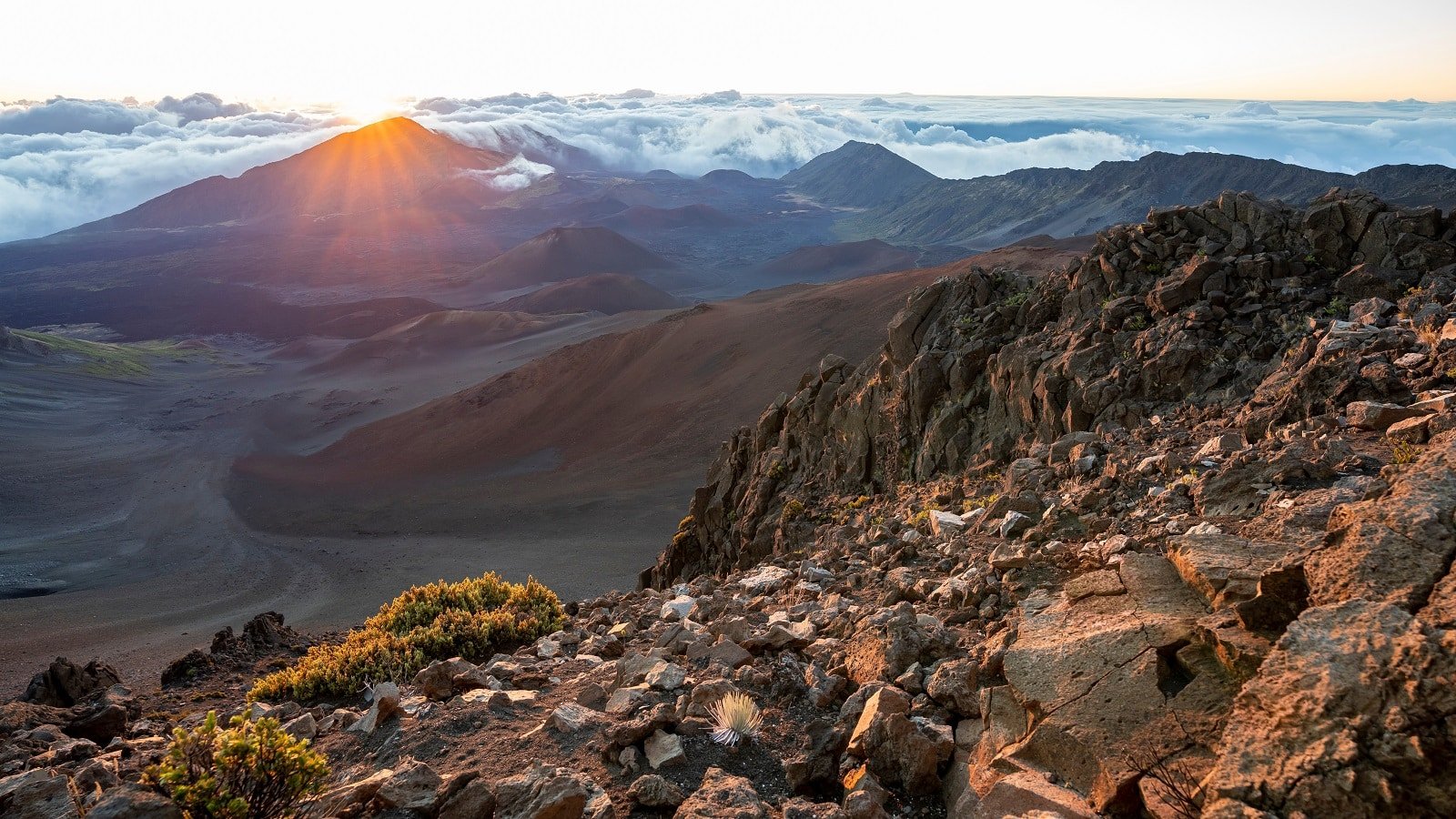
4. Maui, Hawaii, USA
Choose Maui for a wedding that combines natural splendor with laid-back luxury. This Hawaiian island is known for its diverse landscapes, ranging from pristine beaches and lush rainforests to the volcanic terrain of Haleakala National Park.
Maui’s luxurious resorts and private estates offer an array of stunning settings for your ceremony, whether you envision a beachfront sunset vow exchange or a lush garden setting. Hawaiian culture can add a unique dimension to your wedding, with opportunities to incorporate traditional elements such as a lei exchange or a hula performance.
The island’s natural beauty makes for spectacular wedding photos, capturing the essence of a tropical paradise. Maui’s welcoming spirit and aloha lifestyle ensure that your wedding experience will be relaxed yet elegant, allowing you and your guests to be fully immersed in the joy of the occasion.
Insider’s Tip: Opt for a sunset beach ceremony for a picturesque backdrop.
When to Travel: Year-round, though May to October offers drier weather.
How to Get There: Fly directly to Kahului Airport on Maui.
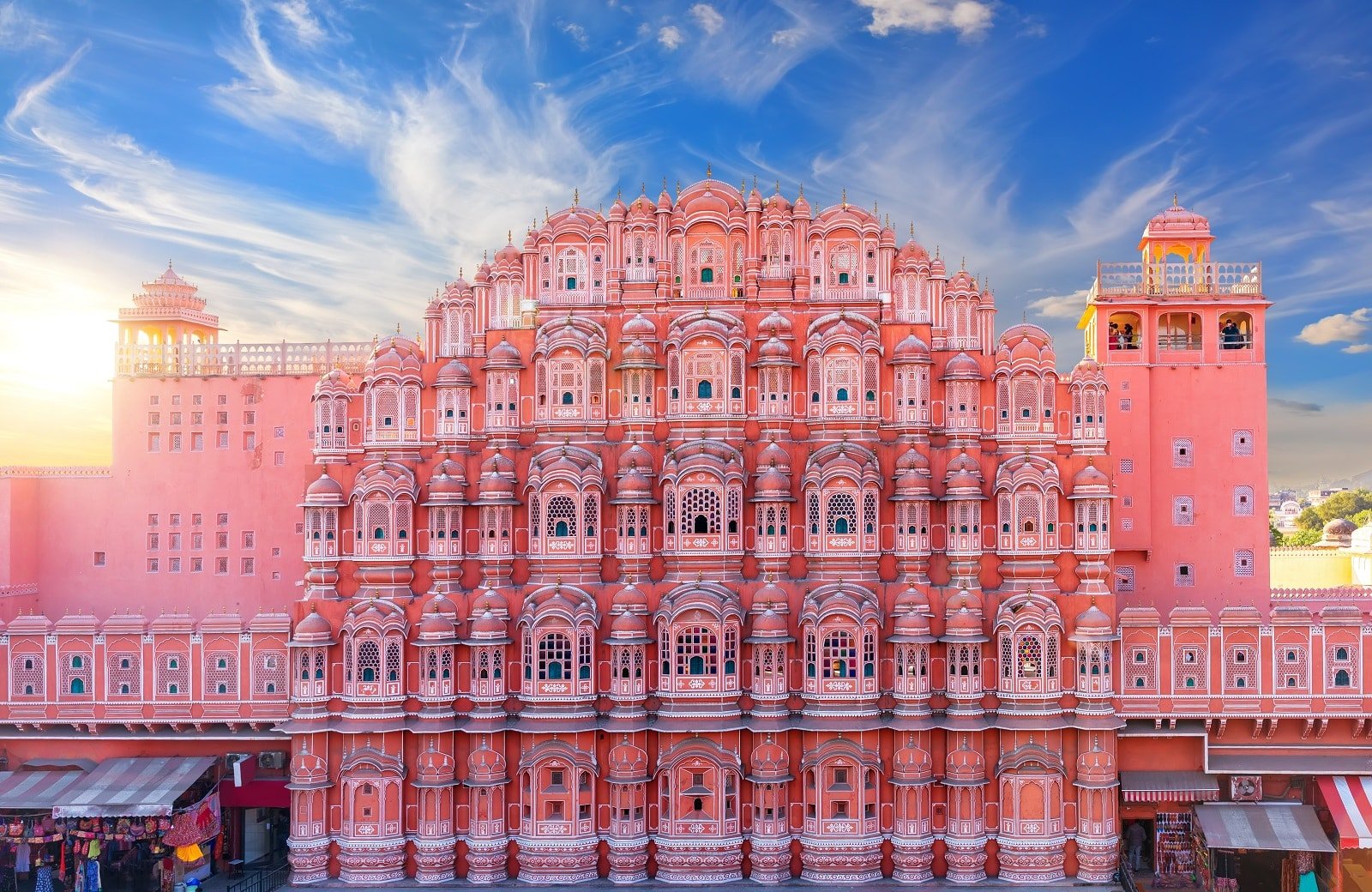
5. Jaipur, India
Celebrate your union in Jaipur, a city with regal charm and grandeur, making it perfect for a royal-themed wedding. Known as the Pink City for its distinctive colored buildings, Jaipur offers a plethora of majestic palaces and forts as venues, each telling a story of its rich history and heritage.
A wedding ceremony is a lavish celebration filled with vibrant colors, traditional music, and dance. The city’s cuisine, known for its richness and variety, will add a royal touch to your wedding feast. Opting for a horse procession can elevate your wedding to a truly regal experience. Jaipur’s architectural splendor and its cultural richness ensure that your wedding will be nothing short of spectacular.
Insider’s Tip: Book a palace hotel for a royal wedding experience.
When to Travel: October to March, avoiding the summer heat and monsoon season.
How to Get There: Fly to Jaipur International Airport, or travel by train or car from major cities like Delhi.
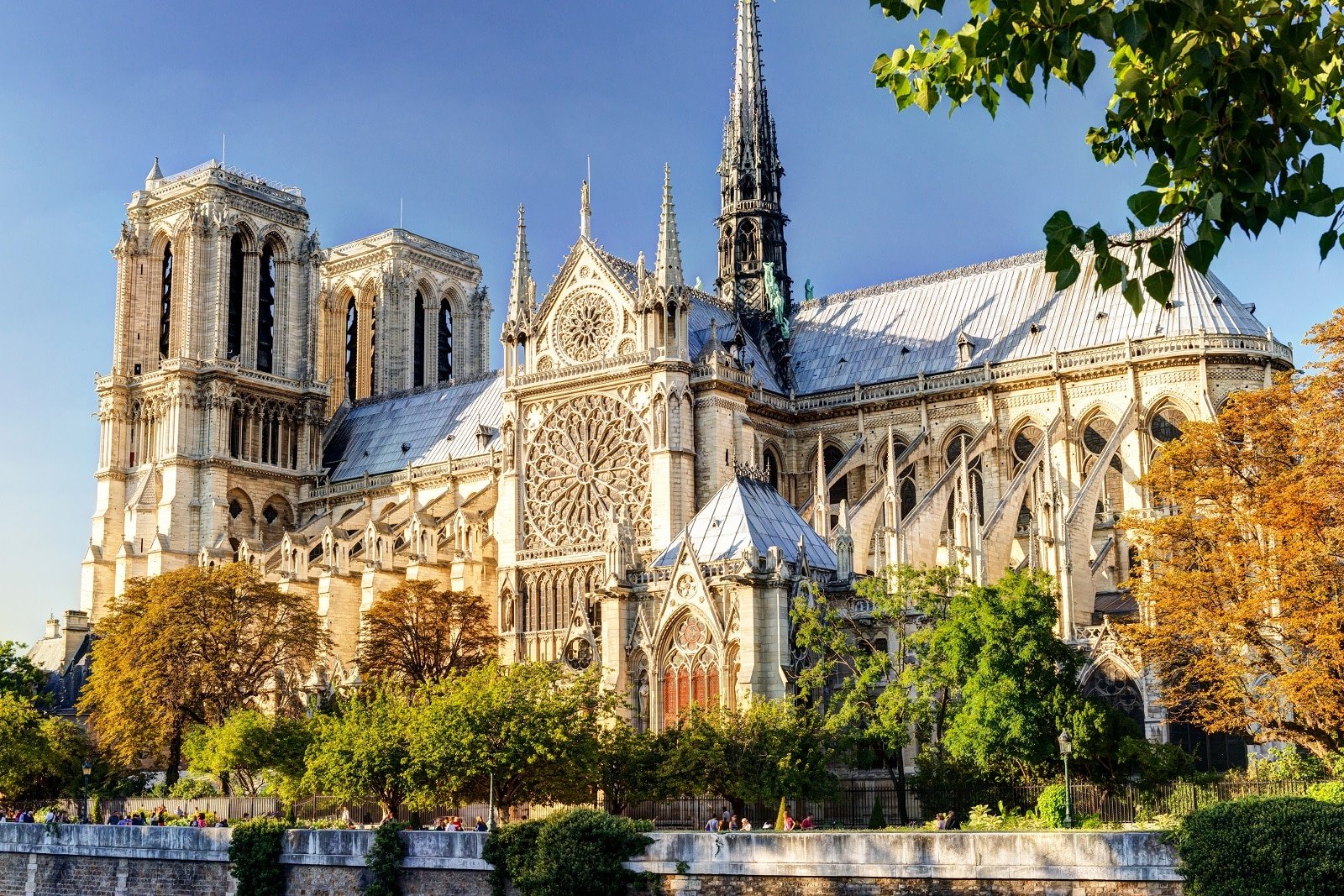
6. Paris, France
Paris, the epitome of romance and elegance, offers an unparalleled setting for your wedding. The city’s iconic landmarks, such as the Eiffel Tower, Notre Dame, and the Seine River, provide a classic Parisian backdrop for your ceremony. Luxury hotels and historic chateaus in and around Paris offer exquisite venues for your special day, blending modern amenities with timeless French charm.
Imagine a reception in a grand ballroom or a sophisticated cocktail hour in a private garden. Parisian cuisine, celebrated worldwide for its excellence, will add a gourmet touch to your celebration. The city’s atmosphere, imbued with art, fashion, and history, will envelop you and your guests, making your wedding a chic and unforgettable affair.
Insider’s Tip: Consider a boat cruise on the Seine for a unique wedding reception.
When to Travel: Spring or early autumn for mild weather and fewer tourists.
How to Get There: Fly into Charles de Gaulle or Orly Airport.
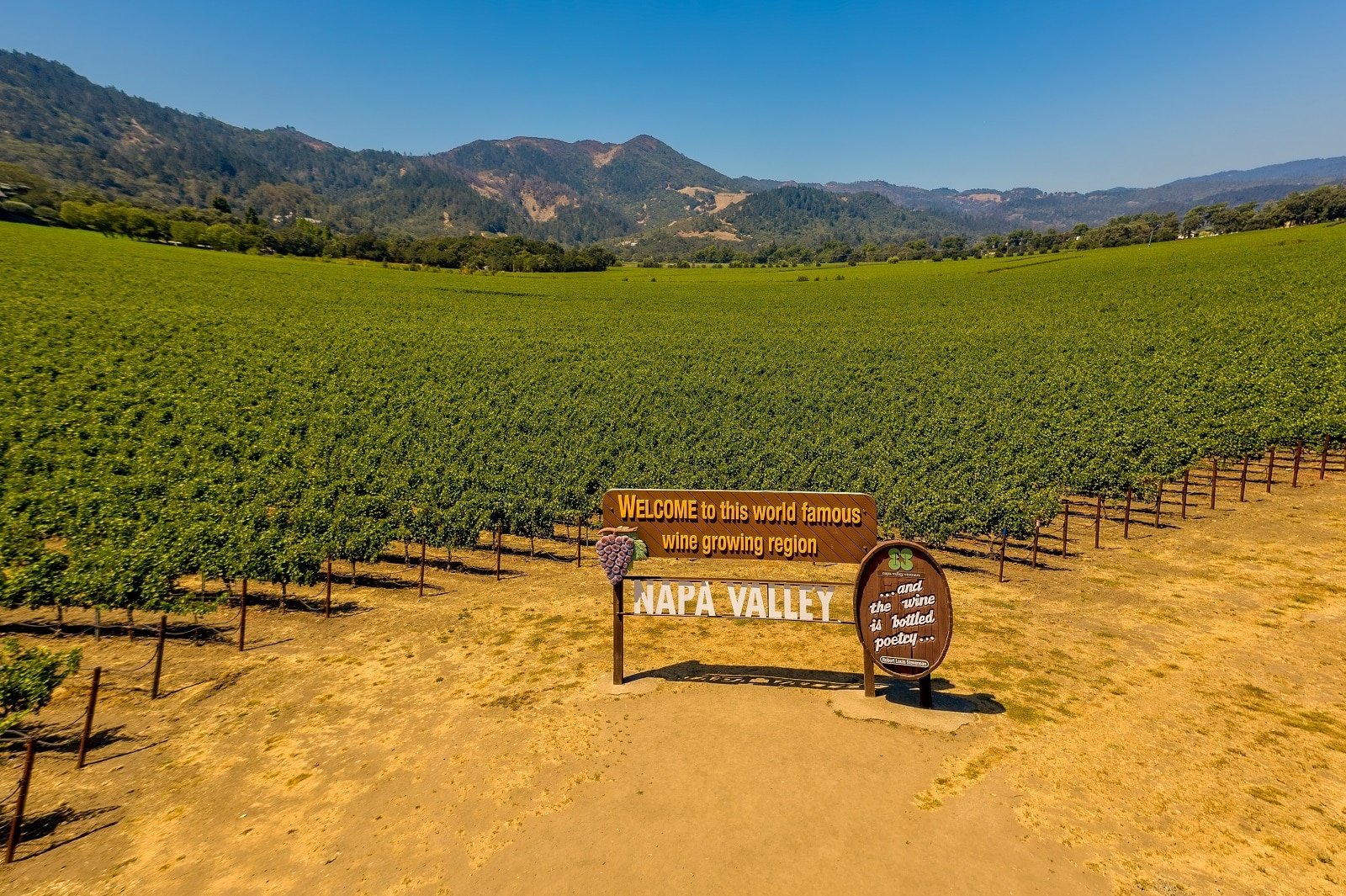
7. Napa Valley, California, USA
Napa Valley, California’s renowned wine country, presents a picturesque setting for a wedding with its rolling vineyards and elegant wineries. The valley’s natural beauty, characterized by rows of grapevines and golden hills, provides a serene and romantic backdrop. Many wineries and resorts in Napa Valley specialize in weddings, offering a blend of rustic charm and luxury.
Picture a ceremony amidst the vines and a reception in a barrel room or a stylish wine cave. The region’s acclaimed wines and farm-to-table cuisine will delight your guests, adding a gourmet touch to your celebration. Napa Valley’s tranquil yet sophisticated ambiance makes it an ideal location for couples seeking a refined yet relaxed wedding experience.
Insider’s Tip: Plan your wedding at a vineyard to incorporate wine tasting into your event.
When to Travel: Late spring to early fall for the best weather.
How to Get There: Fly to San Francisco or Oakland and drive to Napa Valley.

8. Queenstown, New Zealand
Opt for Queenstown, New Zealand, if you’re looking for a wedding destination combining breathtaking natural beauty and adventure. Known for its stunning alpine scenery, Queenstown provides a dramatic and picturesque backdrop for your special day. The region’s luxury lodges and scenic venues, overlooking pristine lakes and rugged mountains, offer a range of options for your ceremony and reception.
Queenstown boasts stunning views and is also a hub for adventure sports, offering unique experiences for you and your guests, from bungee jumping to scenic flights. The town’s vibrant atmosphere and dining options ensure that your wedding celebration will be as lively as it is beautiful.
Insider’s Tip: Choose a lakeside venue for a serene setting.
When to Travel: December to February for summer weather, or June to August for a winter wedding.
How to Get There: Fly into Queenstown Airport.
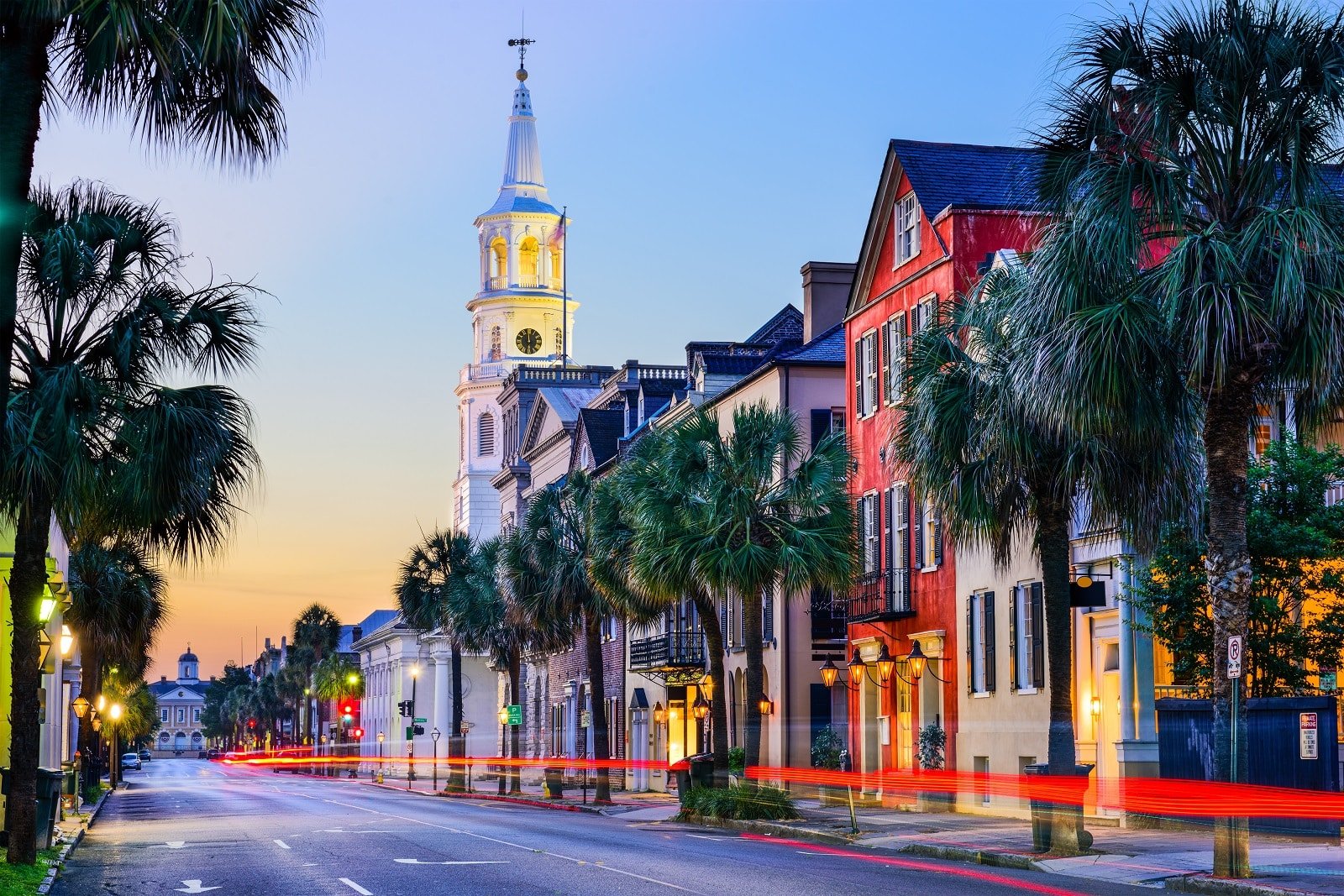
9. Charleston, South Carolina, USA
Charleston, South Carolina, is ideal for a wedding steeped in Southern charm and elegance. This historic city, known for its well-preserved architecture and cobblestone streets, offers a variety of venues, from grand plantation homes to intimate garden settings.
Charleston’s rich history and warm hospitality provide a welcoming atmosphere for your celebration. The city’s culinary scene, influenced by its coastal location and Southern roots, will offer a delightful dining experience for your guests.
Opting for a carriage ride or a boat cruise around the harbor can add a unique touch to your Charleston wedding, making it a memorable experience for everyone involved.
Insider’s Tip: A plantation venue provides a classic Charleston experience.
When to Travel: Spring and fall for mild weather and blooming gardens.
How to Get There: Fly into Charleston International Airport.
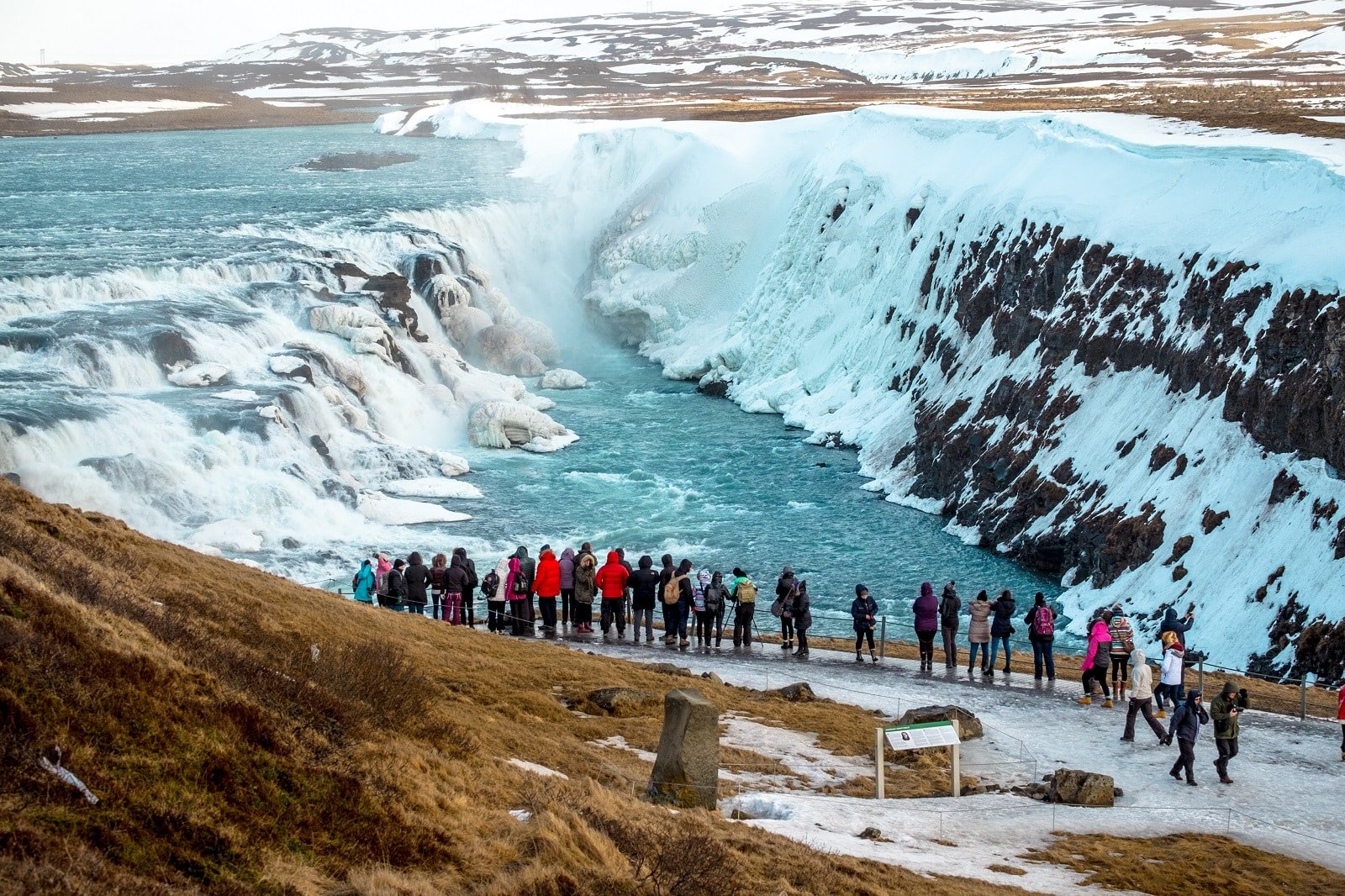
10. Iceland
Choose Iceland for a unique wedding with its extraordinary landscapes and natural phenomena. Known for its dramatic scenery, including waterfalls, glaciers, and black sand beaches, Iceland offers a unique and breathtaking backdrop for your nuptials. The country’s remote and unspoiled locations provide a sense of intimacy and adventure, ideal for couples looking for something out of the ordinary.
Icelandic summers, with their midnight sun, offer extended daylight hours for celebrations, while winters can provide the magical backdrop of the Northern Lights. A wedding in Iceland is a special event and an immersion in a land of raw, natural beauty.
Insider’s Tip: Choose a remote location for privacy and stunning natural vistas.
When to Travel: Summer for milder weather and longer days.
How to Get There: Fly into Keflavík International Airport.

11. Marrakech, Morocco
Marrakech, with its vibrant souks, palatial riads, and lush gardens, offers an exotic setting for a wedding. The city’s rich cultural heritage and stunning architecture provide a colorful and opulent backdrop. Traditional Moroccan elements, such as lanterns, textiles, and spices, can add an authentic touch to your celebration.
The local cuisine, known for its bold flavors and spices, will offer a culinary adventure for your guests. Opting for a traditional Moroccan ceremony with local music and entertainment can make your wedding a truly immersive cultural experience.
Insider’s Tip: Opt for a traditional Riad for an authentic Moroccan experience.
When to Travel: Spring and fall for comfortable temperatures.
How to Get There: Fly to Marrakech Menara Airport.
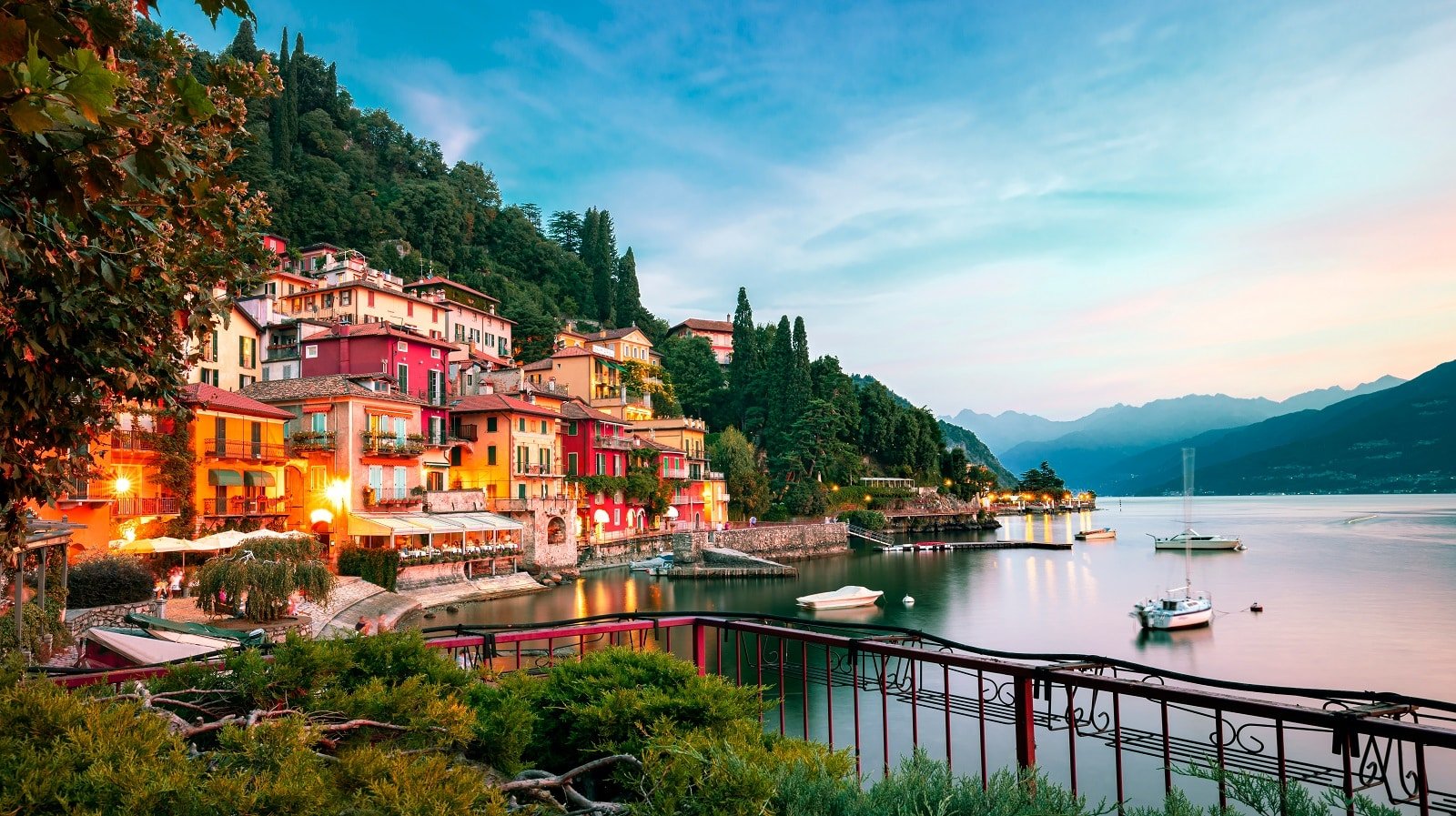
12. Lake Como, Italy
Lake Como, nestled in the foothills of the Italian Alps, offers a luxurious and romantic setting for your wedding. Lake Como is known for its stunning villas and breathtaking lake views and exudes sophistication and timeless elegance.
The area’s natural beauty and Italian charm create a serene and picturesque setting for your ceremony. Many villas and resorts along the lake provide exclusive wedding venues, offering a blend of luxury and privacy. A boat ride on the lake, with its tranquil waters and scenic views, can be a romantic addition to your wedding experience.
Insider’s Tip: Rent a villa for exclusive access and privacy.
How to Get There: Fly to Milan and drive to Lake Como.

13. The Maldives
For a truly intimate and serene wedding, consider the Maldives. This tropical paradise, known for its crystal-clear waters and overwater bungalows, offers an idyllic setting for a beachfront ceremony. The Maldives’ luxury resorts provide personalized wedding services, ensuring that your celebration is exclusive and tailored to your preferences.
The islands’ natural beauty, with their white sandy beaches and vibrant coral reefs, creates a tranquil and romantic atmosphere. A sunset ceremony, with the ocean as your backdrop, promises a picturesque and unforgettable start to your married life.
Insider’s Tip: Plan a sunset ceremony for breathtaking views.
When to Travel: December to April for dry weather.
How to Get There: Fly into Malé International Airport.
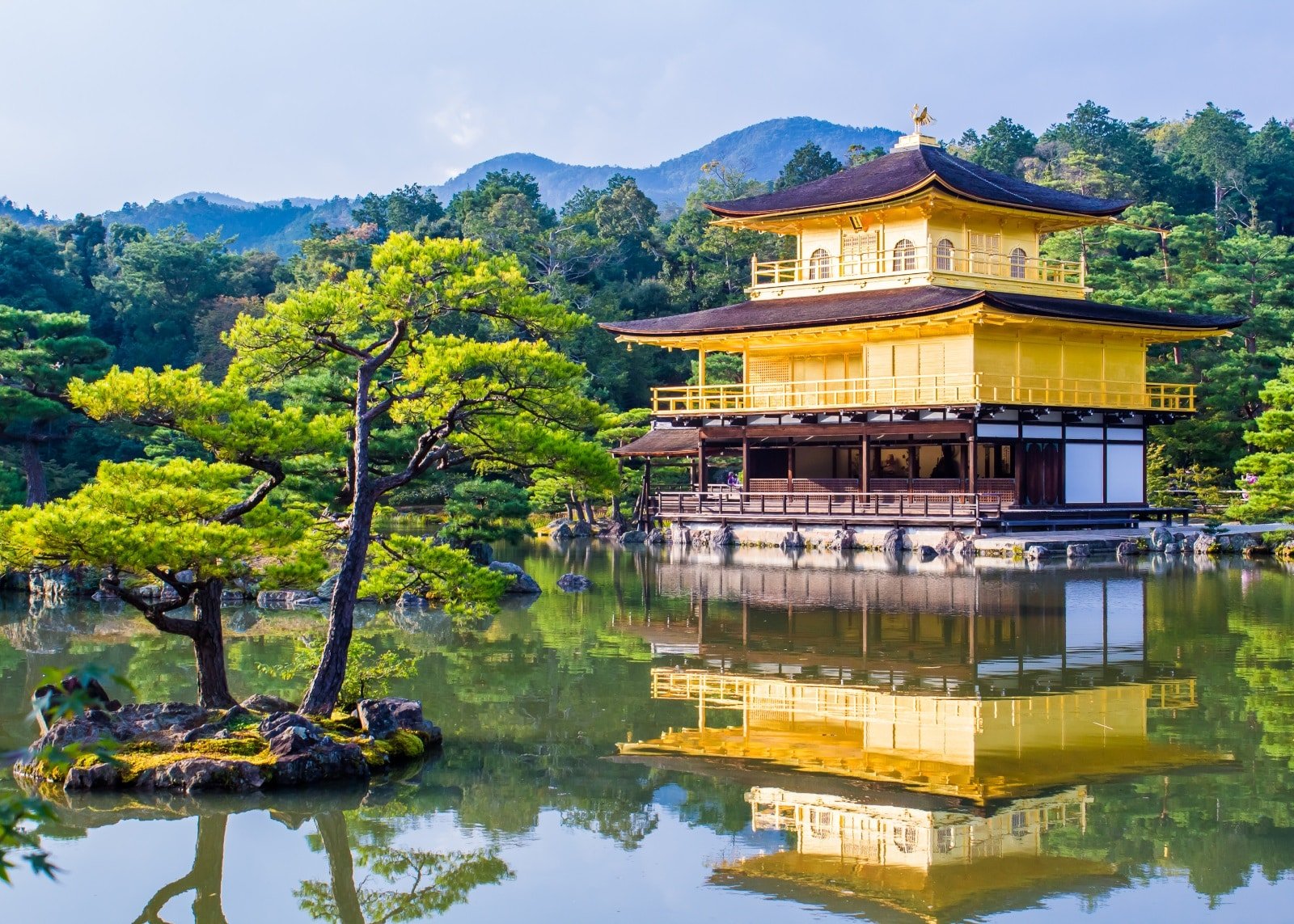
14. Kyoto, Japan
Kyoto presents a unique wedding destination with its rich cultural heritage and serene landscapes. This historical city offers a blend of traditional and contemporary venues, from ancient temples to modern hotels. A wedding in Kyoto allows you to immerse yourself in the elegance of Japanese traditions, from kimono-clad rituals to tranquil Zen gardens.
The city is adorned with stunning temples and shrines, offering a serene and culturally rich backdrop for your ceremony. Kyoto embraces visuals where every detail is steeped in meaning, from the choice of venue to the intricacies of the wedding ceremony itself.
The city’s culinary scene, renowned for its refinement and use of seasonal ingredients, adds another layer of sophistication to your wedding feast. Kyoto stands as an unparalleled choice for couples seeking a wedding that intertwines cultural depth with natural beauty.
Insider’s Tip: Incorporate a traditional tea ceremony into your wedding.
When to Travel: Spring for cherry blossoms or fall for autumn foliage.
How to Get There: Fly to Kansai International Airport and travel to Kyoto.

15. Amalfi Coast, Italy
The Amalfi Coast, with its dramatic coastal cliffs and picturesque towns, offers an enchanting setting for your wedding. This Italian destination is famed for its breathtaking scenery, where the azure sea meets colorful villages perched on steep hills. The region’s charm lies in its rustic elegance and Mediterranean allure, making it a perfect backdrop for a romantic celebration.
Venues along the Amalfi Coast range from luxurious hotels to quaint villas, each offering panoramic views of the sea and the coast’s unique landscape. The local cuisine will delight your guests, emphasizing fresh seafood and traditional Italian dishes.
The Amalfi Coast is an extraordinarily scenic location where the warmth of Italian hospitality and the beauty of nature come together to create a truly memorable wedding experience. The Amalfi Coast is an ideal choice for couples seeking a blend of natural beauty, cultural richness, and culinary excellence.
Insider’s Tip: Choose a cliffside venue for spectacular sea views.
When to Travel: Late spring to early autumn for ideal weather.
How to Get There: Fly to Naples and drive along the coast.

The Bottom Line
Your destination wedding is an opportunity to bring your dream vision to life in a setting that resonates with your personal love story. Whether you choose the romantic alleys of Paris, the serene beaches of Bali, or the historic charm of Charleston, each destination offers something uniquely enchanting.
Remember, the key to a successful destination wedding lies in careful planning and attention to detail. Choose a location that provides a beautiful backdrop and reflects your personality as a couple. As you embark on this journey, embrace the adventure and the joy of celebrating your union in a place that will forever hold a special place in your heart. Your dream wedding awaits.
More Articles Like This…
Barcelona: Discover the Top 10 Beach Clubs
2024 Global City Travel Guide – Your Passport to the World’s Top Destination Cities
Exploring Khao Yai 2024 – A Hidden Gem of Thailand
The post Ultimate Guide to Destination Weddings 2024 – Top 15 Locations and Insider Tips republished on Passing Thru with permission from The Green Voyage .
Featured Image Credit: Shutterstock / AnnaVel.
For transparency, this content was partly developed with AI assistance and carefully curated by an experienced editor to be informative and ensure accuracy.
More for You
Donald Trump Bond Rejected Due to Low Fee, Insurer Suggests
Keep this line off your resume, says ex-Disney recruiter: ‘There's zero benefit’
West End theatre company blasts racial abuse directed at Black actor starring in Romeo and Juliet
Can You Eat Potatoes with Sprouts?
15 Mistakes People Make When Living Alone That Put Their Safety in Danger
24 Old Vinyl Records That Can Be Worth a Lot Today
Judge in Trump hush money case quashes last-minute defense subpoena
Cicada Map Shows States Where Trillions of Bugs Will Emerge
This common trait is a red flag of a toxic boss, says ex-IBM CEO: 'I used to think it was a great skill'
Over 150 Jewish creatives sign open letter defending Jonathan Glazer for Oscars speech on Gaza
20 Personal Things You Should Never Share With Others
Christian Bale Transforms Into Frankenstein's Monster in First Look at The Bride
Ward Off Garden Moles With A Popular Condiment From Your Kitchen
US Reacts After China Renames Neighbor's Territory
Opinion | It Shouldn’t Take Long to Rebuild Baltimore’s Key Bridge
19 Odd Jobs That Pay Surprisingly Well
I study people with high emotional intelligence for a living—8 things they never ever do when talking to others
Retired rabbi returns £2.35m to two charities
Plant This Refreshing Herb To Naturally Repel Mice From Your Home And Garden
Ukraine Rues Missed F-16 Opportunity

IMAGES
VIDEO
COMMENTS
All you need to know to plan a visit to the Roman Forum. Where to get the best tickets, the best things to see in the Roman Forum and the Palatine Hill, practical tips. Updated June 2021. The Roman Forum is the heart of Ancient Rome and, nowadays, one of the most important archaeological sites in Rome and in the world.
1. Via Sacra. A great way to start exploring the Roman Forum is from the Via Sacra or the "Holy Road.". The Via Sacra was the main street of the Roman Forum and Ancient Rome, along which triumphal processions, religious processions, or funeral processions marched between Capitoline Hill and the Colosseum.
The Temple of the Divine Caesar in the Roman Forum is a famous monument dedicated to Julius Caesar, a pivotal figure in Rome's transition from republic to empire. The temple told the story of Caesar's life. But it also marks the spot where Caesar, assassinated on March 15, 44 B.C., was cremated and buried.
Use the Palatine Hill & Roman Forum map & this self guided tour to visit the ruins. There are over 25 popular attractions; you can also download the google map of the ruins and use it offline as your self guided tour. It's a good idea to do some planning before visiting the ruins because if you put yourself at the mercy of the tour guide, you ...
13. Via Sacra. The road running through the arch is the Via Sacra or sacred way. It was an important road as you can guess by its name. In ancient Roman times, triumphant marches were held after big victories, which happened often. These marches would travel down the Via Sacra and into the city.
Tours of the Roman Forum. If you don't know what tour to choose, but you want to have a guide tell you all you need to know about the Roman Forum, here are 2 great options: 3-hour Guided Tour to the Colosseum and the Roman Forum. Colosseum, Roman Forum, Palatine Hill & Mamertine Prison Guided Tour Where to stay close to the Roman Forum
This unique Roman adventure allows you to stand where gladiators once stood and explore the hidden corners of one of the world's most famous ancient structures. Along with this, the tour includes a comprehensive exploration of the Roman Forum and Palatine Hill, adding layers of understanding to the ancient city's life.
The Palatine Hill is one of the seven hills upon which Rome was established and, along with the Roman Forum, is one of the most ancient parts of the city. Legend has it that founding twins Romulus and Remus were discovered in a cave here, being looked after by a she-wolf. And although little remains of the twins today, the hill is still home to ...
Roman Forum location entrances. The Arch of Titus near the Colosseum, the Temple of Venus, and Via di San Gregorio are the four main entrances to the Roman Forum, located midway down Via dei Fori Imperiali (via the Palatine). Opening hours. The site is open every day: 8:30 am until 7 pm and is closed on 25 December and 1 January. Roman Forum ...
Palatine Hill is open from 10:00 - 19:15. While both the Colosseum and the Roman Forum are open 09:00 - 16:30. The last admission is an hour before closing. You should head to the Via dei Fori Imperiali entrance to enter the Roman Forum. You can choose between 5 visit routes, which vary from 30 minutes to 2.5 hours.
Few sites are so filled with a sense of history as the Roman Forum (Foro Romano), where, for many centuries, the fate of Europe was decided. Although the surviving remains give only a hint of the grandeur and splendor of the Forum in ancient times, this area, with its columns still standing tall or lying tumbled on the ground, its triumphal arches, and its remains of once-important buildings ...
Tips for Visiting the Roman Forum. Location and Getting There: The Roman Forum is located in the historic heart of Rome, near the Colosseum and Palatine Hill. To get there, take the metro to Colosseo station. Admission: Entrance to the Forum is included in the combined ticket for the Colosseum and Palatine Hill.
Roman Forum History . Building in the Forum dates back to as early as the 7th century B.C. On the northern end of the Forum near the Capitoline Hill are some of the oldest ruins of the Forum including marble remnants from the Basilica Aemilia (note that a basilica in Roman times was a site of business and money lending); the Curia, where Roman senators assembled; and the Rostra, a platform on ...
The Roman Forum is one of Rome's most important attractions. But it is a jumble of marble fragments, triumphal arches, temple ruins, and sundry other ancient architectural elements from various time periods. This run-down of some of the Forum's most important attractions runs from east to west, beginning at the Colosseum.
The Roman Forum was home to some of the oldest and most important buildings in the ancient city - what you will see today is a mass of ruins, including shrines and temples, such as the House of the Vestal Virgins. The most ancient monuments at the Roman Forum are from the first kings of Rome, dating back to the sixth century BC.
Price. Combined ticket to visit the Colosseum, the Roman Forum and the Palatine: Adults: € 16 ( US$ 17.30) European Union members (18 - 24): € 2 ( US$ 2.20) Children (ages less than 17) and seniors (over 65) members of the EU: free entrance. Colosseum, Roman Forum & Palatine Hill Tour € 50 ( US$ 54)
Read about itineraries, activities, features, travel essentials and get inspiration from the blog in the best travel guide to the Roman Forum. Tailor-made Travel. Destinations. Blog. Trips. Shop. The Roman Forum. Tailor-made Travel. Book your individual trip, stress-free with local travel experts . I WANT TO TRAVEL IN: Mar 2024. plan my trip.
Because we have just the perfect Roman Forum travel guide for you. Rome's historic center, a UNESCO World Heritage Site, is home to 3 iconic monuments - the Colosseum, the Palatine Hill, and the Roman Forum. Colosseum refers to the ancient amphitheater. Palatine Hill housed the palaces of Roman emperors and the Forum was the official center.
First you must book a tour time for the Colosseum. You must arrive on time, or they won't let you in. You can then decide to visit the Roman Forum before or after it. We went before (allow at ...
Depending on whether you visit the park before or after the Colosseum and what you want to see, you can choose different entrances. The entrances are: Via Sacra: Entrance at the Arch of Titus between the Roman Forum and the Palatine. This entrance is closest to the Colosseum. Via di San Gregorio: entrance to the Palatine.
The Roman Forum served as Rome's bustling core, a meeting place for citizens of various social classes, where business was conducted, shopping occurred, and fine food and wine were enjoyed. It was a crowded and cosmopolitan space, attracting people from around the world, including wealthy merchants, slaves, Roman nobles, and vendors.. Today, the Roman Forum, situated between Piazza Venezia and ...
The Colosseum is a famous Roman amphitheater that was built between 72 and 80 AD. The three-tired theater is the largest amphitheater ever built, and the largest (still standing) amphitheater in the entire world. It is the largest ancient structure to have survived: It stands 157 feet (48 meters) tall and measures 620 by 513 feet (189 by 156 ...
This Roman Forum and Colosseum accessible tour visits the two greatest remnants of Ancient Rome: the Colosseum towering overhead and the Roman Forum sunken below street level. The Colosseum is wheelchair friendly, and the Roman Forum, which has some obstacles, can also be visited in a wheelchair. The views and the photo opportunities are some ...
Story by Katie Hollamby. • 1mo. 1 / 14. Discover Rome - A Comprehensive 12-Step Traveler's Guide ©Provided by Passing Thru Travel. Rome, where history and modernity intertwine seamlessly ...
1. Best for a gourmet dish with the finest ingredients: Roscioli Salumeria con Cucina. Roman cuisine, with its medley of rustic flavours and artery-clogging ingredients, isn't typically associated ...
Jaycee Green Pot. Green Prairie. Faux Herbiflora Wreath. Destination weddings offer an extraordinary experience, combining the joy of a wedding with the excitement of travel. This guide explores ...